Sony Group DCRIP7 Digital Video Camera - Bluetooth User Manual users manual
Sony Corporation Digital Video Camera - Bluetooth users manual
Contents
- 1. users manual
- 2. Network operating instructions
- 3. model name explanation
users manual
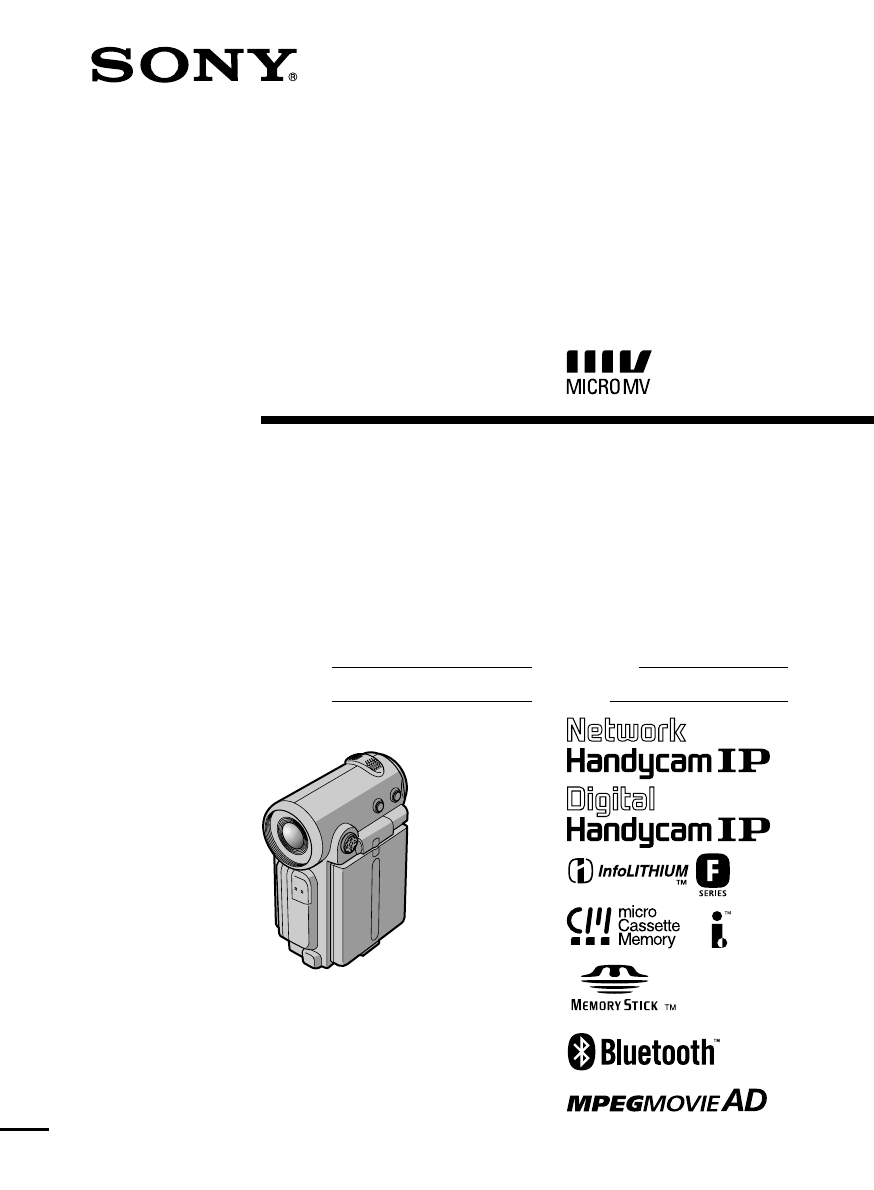
3-069-933-11 (1)
©2001 Sony Corporation
Operating Instructions
Before operating the unit, please read this manual thoroughly, and retain
it for future reference.
Owner’s Record
The model and serial numbers are located on the bottom. Record the
serial number in the space provided below. Refer to these numbers
whenever you call upon your Sony dealer regarding this product.
DCR-IP5/IP7/IP7BT
Digital
Video Camera
Recorder
Model No. Model No. AC-
Serial No. Serial No.
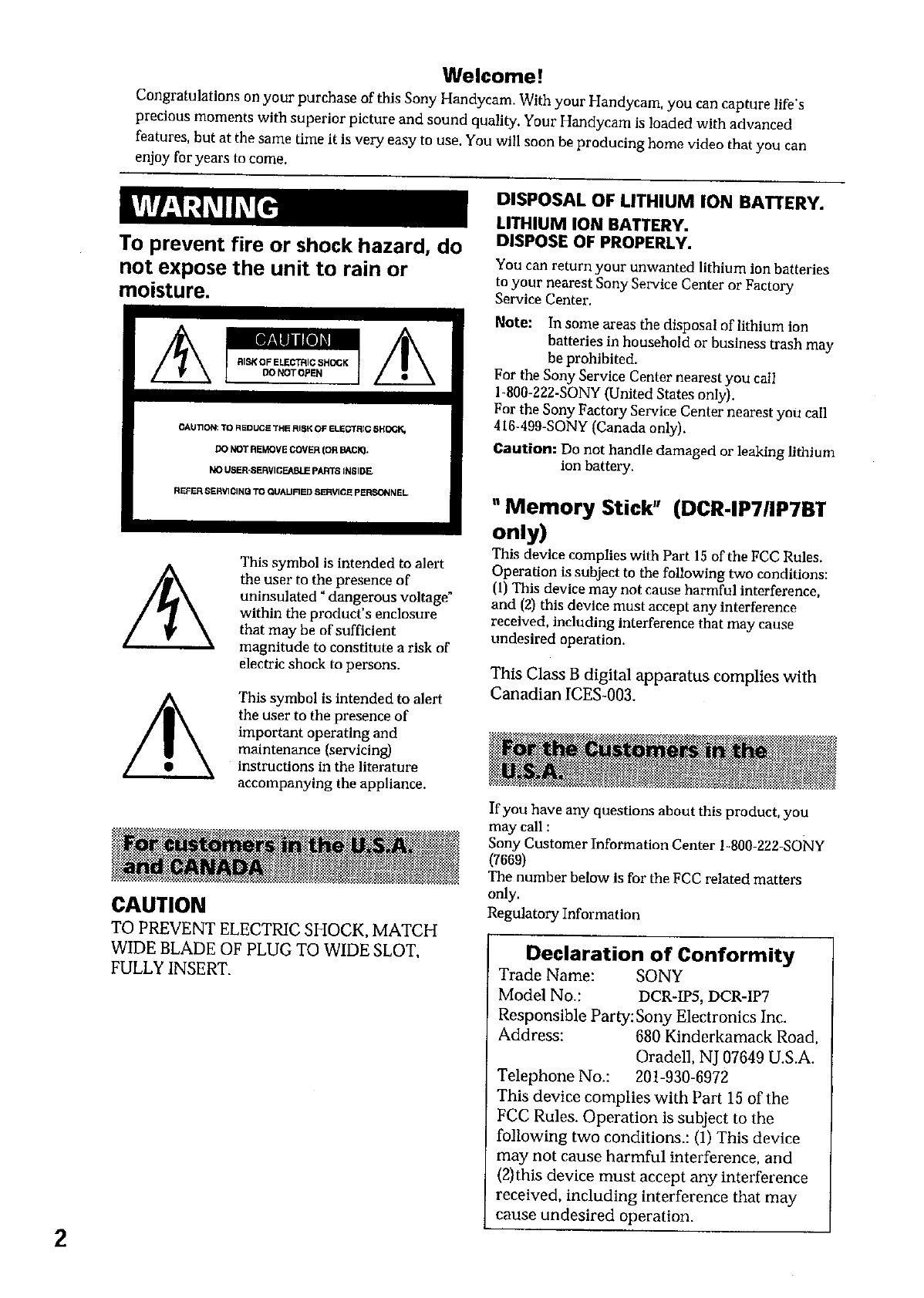
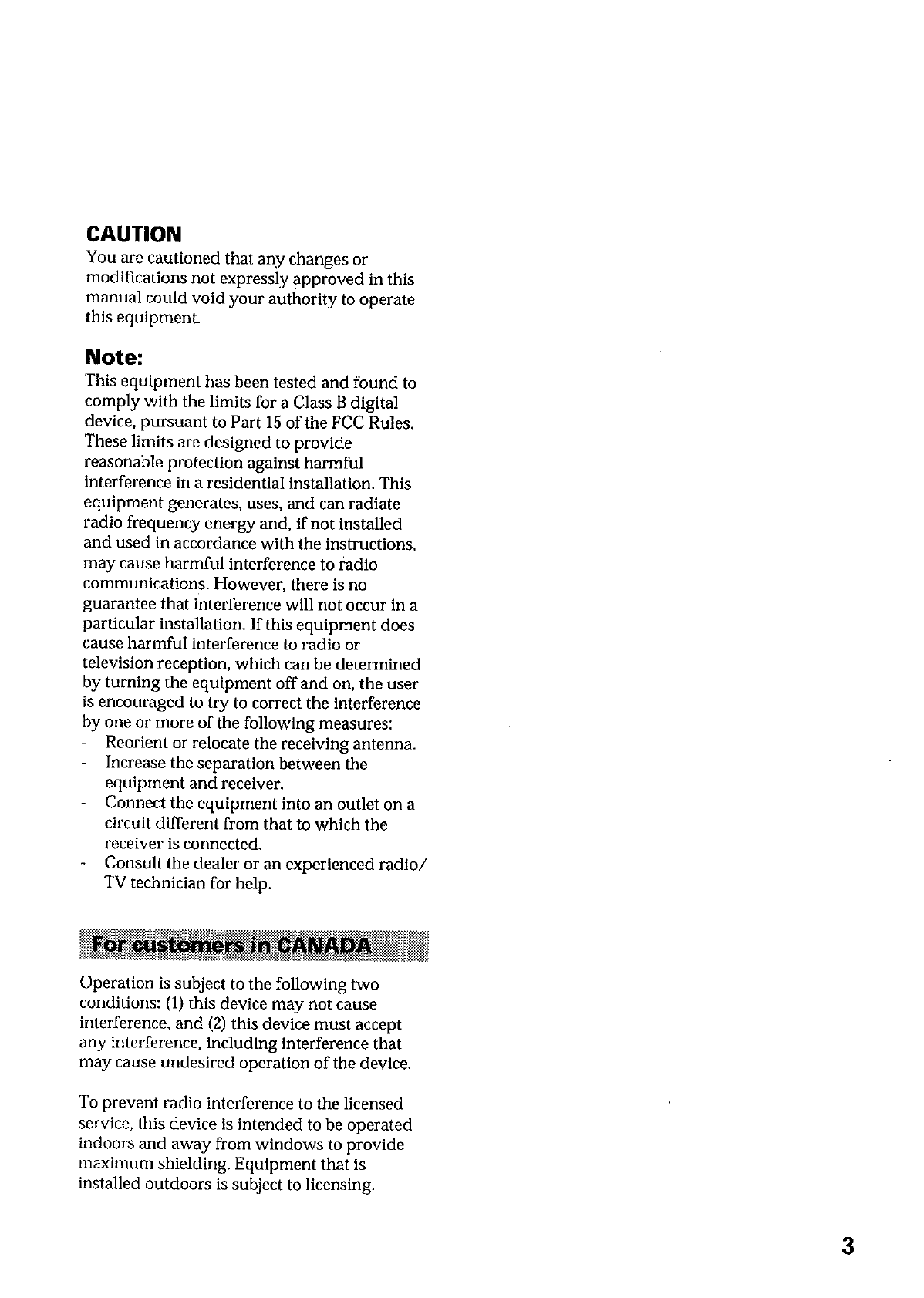
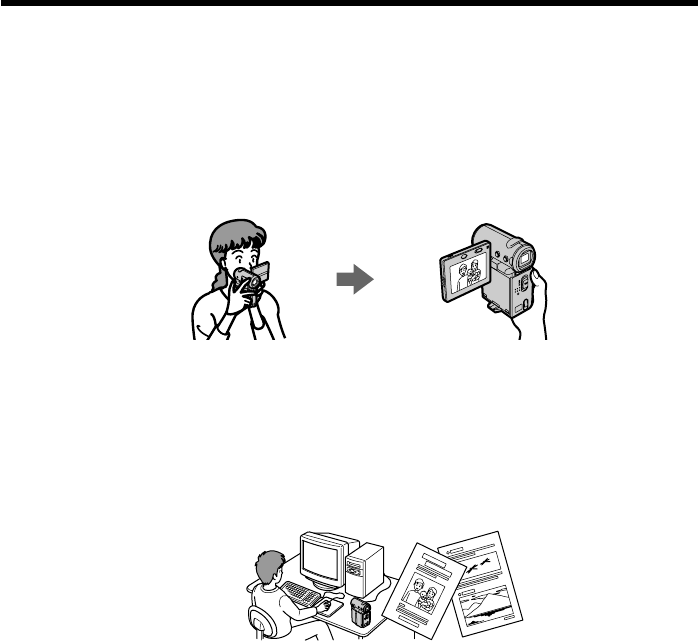
4
Main Features
Taking moving or still images, and playing them back
•Recording a picture on a tape (p. 22)
•Recording a still image on a tape (p. 41)
•Playing back a tape (p. 34)
•Recording a still image on a “Memory Stick” (p. 122) (DCR-IP7/IP7BT only)
•Recording moving pictures on a “Memory Stick” (p. 129) (DCR-IP7/IP7BT only)
•Viewing a still image recorded on a “Memory Stick” (p. 142) (DCR-IP7/IP7BT only)
•Viewing a moving picture on a “Memory Stick” (p. 145) (DCR-IP7/IP7BT only)
Capturing images on your computer
•Viewing an image recorded on a tape using your computer via the i.LINK cable (p.
XX)
•Viewing an image recorded on a “Memory Stick” using your computer via the USB
cable (p. 147) (DCR-IP7/IP7BT only)
Accessing the Internet via a Bluetooth device (DCR-IP7: not
supplied, DCR-IP7BT: supplied) (DCR-IP7/IP7BT only)
•Accessing the Internet, sending/receiving your e-mail and using the album on the
Web. For details, refer to the network function operating instructions supplied with
your camcorder.
Other uses
Functions to adjust exposure in recording mode
•Back light (p. 29)
•PROGRAM AE (p. 52)
•White balance (p. 55)
•Adjusting the exposure manually (p. 57)

Getting started
5
Functions to give an effect to your recordings
•Digital zoom (p. 105)
The default setting is set to OFF. (To zoom greater than 10×, set up the D ZOOM item
in the menu settings.)
•Fader (p. 45)
•Picture effect (p. 48)
•Digital effect (p. 49)
•Title (p. 98, 101)
•MEMORY MIX (p. 135) (DCR-IP7/IP7BT only)
Functions to give a natural appearance to your recordings
•Manual focus (p. 59)
•Landscape mode (p. 52)
Functions used after recording
•END SEARCH (p. 32)
•DATA CODE (p. 36)
•Multi-picture search (p. 72)
•Title search (p. 69)
•Date search (p. XX)
•Photo search (p. 74)
Main Features
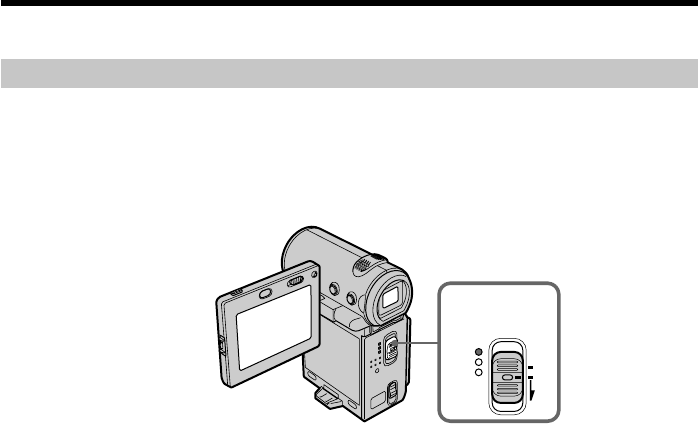
6
This section describes the basic control ways to operate the camcorder.
How to turn on the power and select the mode
To supply the power for the camcorder, see “Step 1 Preparing the power supply” on
page 18.
(1)Slide the POWER switch down while pressing the small green button, then
release your finger.
The camcorder is turned on, and then the camcorder turns to the CAMERA
mode so that the CAMERA lamp lights up.
(2)Slide the POWER switch down. Each time you slide it down, the mode
changes as follows and its mode lamp also lights up.
CAMERA To use this mode when you record on a tape.
MEMORY/NETWORK (DCR-IP7/IP7BT only)
MEMORY: To use this mode when you record on a “Memory Stick,” or
play back or edit the image in the “Memory Stick.”
NETWORK:To use this mode when you use the network function. For
details, refer to the supplied network function operating
instructions.
VCR To use this mode when you play back or edit an image recorded on a tape
or “Memory Stick” (“Memory Stick” is only for the DCR-IP7/IP7BT).
Introduction – Basic operations
1,2
MEMORY/
NETWORK
VCR
CAMERA (CHG)
POWER
OFF
ON
MODE
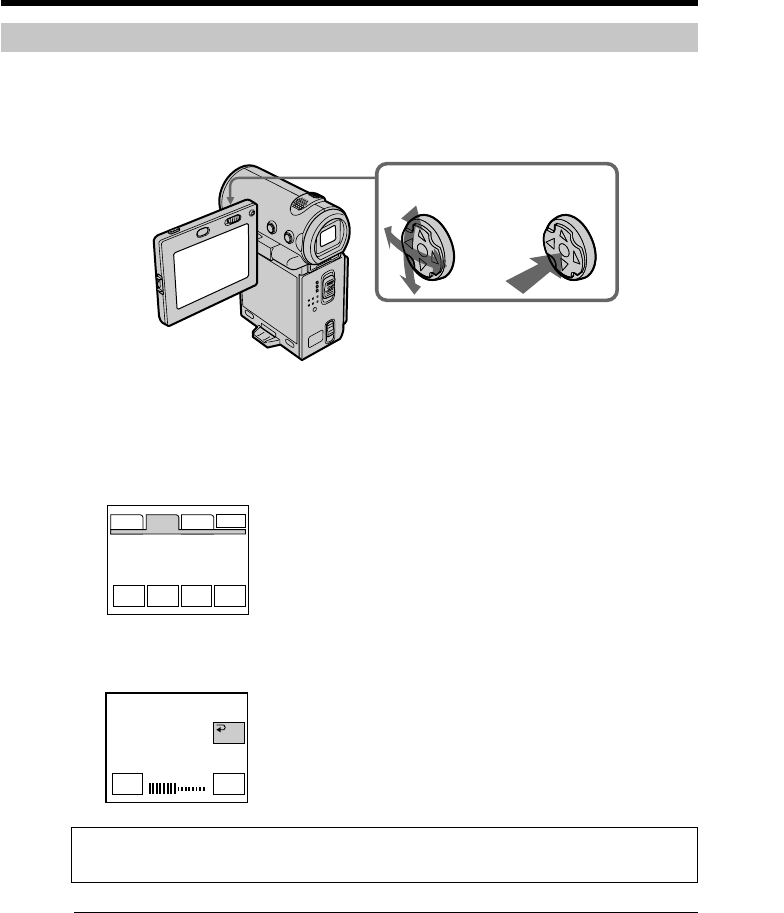
Getting started
7
12
How to use the control button
Most of the operations are carried out by the control button. Select a button displayed
on the screen using the control button, then press the center z on the control button.
(1)Press v/V/b/B on the control button repeatedly to select the desired button
displayed on the screen.
The selected button turns orange.
(2)Press the center z on the control button to enter the setting.
Repeat steps 1 and 2 to execute the function.
The procedure above is referred to as “Select [XXXX], then press the center z on the
control button ” in this operating instructions.
When the item is selected
The green bar appears above the item.
If the items are not available
The color of the items changes to gray.
Introduction – Basic operations
PAGE1 PAGE2 PAGE3
EXIT
LCD
BRT VOL END
SCH TITLE
LCD BRT
–+
OK
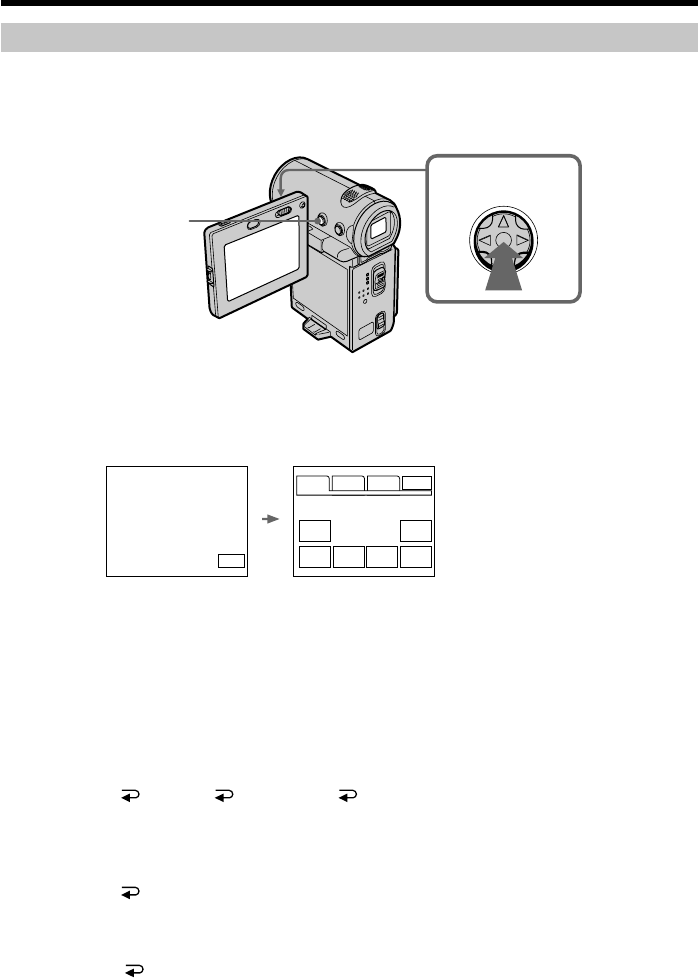
8
How to use the FN screen
If FN is not displayed on the screen, press DISPLAY or the center z on the control
button.
(1)Select FN with v/V/b/B on the control button, then press the center z. The
FN screen appears.
(2)To change the page, select PAGE1, PAGE2, or PAGE3 with v/V/b/B on the
control button, then press the center z. The PAGE1/PAGE2/PAGE3 screen
appears.
(3)Select the desired item with v/V/b/B on the control button, then press the
center z. The screen that corresponds to that button will appear, or that
function will be executed.
To return to the FN screen
Select OK, then RETURN, or END with v/V/b/B on the control button,
then press the center z. Next, select EXIT with v/V/b/B on the control button, then
press the center z.
To execute settings
Select OK with v/V/b/B on the control button, then press the center z. The
display returns to the PAGE1/PAGE2/PAGE3 screen.
To cancel settings
Select OFF or AUTO with v/V/b/B on the control button, then press the center z.
The display returns to the PAGE1/PAGE2/PAGE3 screen.
Introduction – Basic operations
1–3
DISPLAY
PAGE1 PAGE2 PAGE3
EXIT
MENU FOCUS
FADER SELF
TIMER MEM
MIX EXPO–
SURE
FN
In CAMERA mode
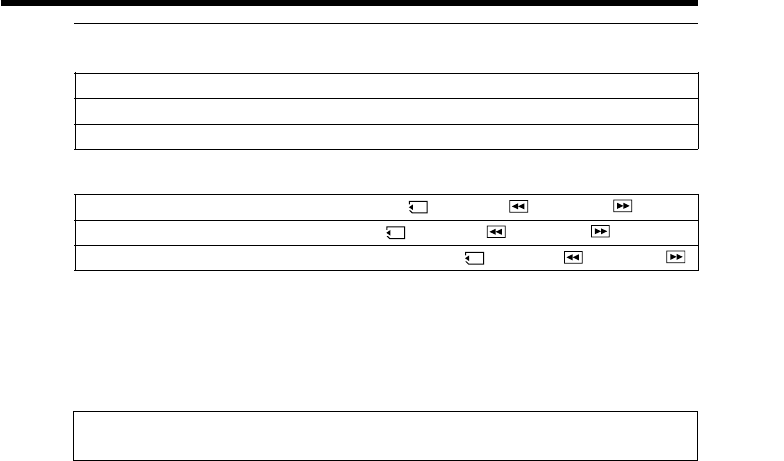
Getting started
9
The screen buttons on the PAGE1/PAGE2/PAGE3 screen
In CAMERA mode
PAGE1 MENU, FADER, SELFTIMER, MEM MIX*, EXPOSURE, FOCUS
PAGE2 LCD BRT, VOL, END SCH, TITLE
PAGE3 DIG EFFT, COUNT RESET
In VCR mode
PAGE1 MENU, VOL, TITLE, MULTI SRCH, x/ PLAY*, m *, BX *, M *
PAGE2 LCD BRT, DIG EFFT, END SCH, x/ PLAY*, m *, BX *, M *
PAGE3
DATA CODE, COUNT RESET, qREC CTRL, x/ PLAY*, m *, BX *, M *
* (DCR-IP7/IP7BT only)
See p. 115 for the MEMORY/NETWORK mode (DCR-IP7/IP7BT only).
To turn on/off the screen buttons
Press DISPALY. However, the finder can be used only in mirror mode.
A screen that the FN button is displayed is referred to as the FN screen in this
operating instructions.
Introduction – Basic operations

10
Table of contents
Main Features .......................................... 4
Introduction – Basic operations ............ 6
Table of contents ................................... 10
Quick Start Guide ................................. 12
Getting started
Using this manual ................................. 14
Checking supplied accessories............ 16
Step 1 Preparing the power supply... 18
Installing the battery pack............. 18
Charging the battery pack............. 19
Connecting to a wall outlet ........... 21
Step 2 Setting the date and time ........ 23
Step 3 Inserting a cassette ................... 26
Recording – Basics
Recording a picture............................... 28
Shooting backlit subjects
– BACK LIGHT ........................ 35
Self-timer recording ....................... 36
Checking the recording
– End search .................................... 37
Playback – Basics
Playing back a tape ............................... 38
Viewing the recording on the TV
screen – using the A/V connecting
cable.................................................. 44
Viewing the recording on the TV
– using the i.LINK cable ................ 46
Advanced Recording
Operations
Recording a still image on a tape
– Tape Photo recording ................. 47
Using the wide mode ........................... 49
Using the fader function ...................... 51
Using special effects – Picture effect .. 54
Using special effects – Digital effect... 56
Using the PROGRAM AE function .... 59
Adjusting the white balance
manually.......................................... 62
Adjusting the exposure manually ...... 64
Focusing manually................................ 65
Advanced Playback
Operations
Playing back a tape with picture
effects ............................................... 67
Playing back a tape with digital
effects ............................................... 69
Searching the scene – Multi-picture
search ............................................... 71
Searching the boundaries of recorded
tape by title – Title search ............. 75
Searching a recording by date
– Date search ................................... 77
Searching for a photo
– Photo search ................................. 79
Editing
Dubbing a tape ...................................... 81
Recording a program............................ 84
Superimposing a title ........................... 89
Making your own titles........................ 95
The MICRO cassette memory ............. 98
Customizing Your Camcorder
Changing the menu settings.............. 102
“Memory Stick” Operations
Using a “Memory Stick”
– introduction................................ 108
Recording still images on a “Memory
Stick”
– Memory Photo recording......... 118
Recording an image from a tape as
a still image ................................... 123
Recording moving pictures on
“Memory Stick”s
– MPEG movie recording............ 126
Recording a picture from a tape as a
moving picture ............................. 128
Superimposing a still image in a
“Memory Stick” on a moving
picture – MEMORY MIX............. 132
Copying still images from a tape
– Photo save .................................. 135
Viewing a still image
– Memory photo playback .......... 137
Viewing a moving picture
– MPEG movie playback ............. 140
Dubbing images recorded on the
“Memory Stick” onto the tape.... 143
Enlarging still images recorded on
“Memory Stick”s
– Memory PB ZOOM................... 145
Playing back images in a continuous
loop – SLIDE SHOW.................... 147
Preventing accidental erasure
– Image protection........................ 149
Deleting images................................... 150

Getting started
11
Table of contents
Writing a print mark
– PRINT MARK ............................ 154
Connecting with a computer
Viewing images recorded on a tape
using your computer ................... 155
Viewing images recorded on a
“Memory Stick” using your
computer........................................ 156
Network operation
Accessing to the network................... 162
Troubleshooting
Types of trouble and their solutions
......................................................... 164
Self-diagnosis display......................... 170
Warning indicators and messages.... 171
Additional Information
Usable cassettes ................................... 173
About the “InfoLITHIUM” battery
pack ................................................ 174
About i.LINK ....................................... 176
Using your camcorder abroad .......... 178
Maintenance information and
precautions .................................... 180
Specifications ....................................... 186
Quick Reference
Identifying the parts and controls .... 188
Index ..................................................... 195
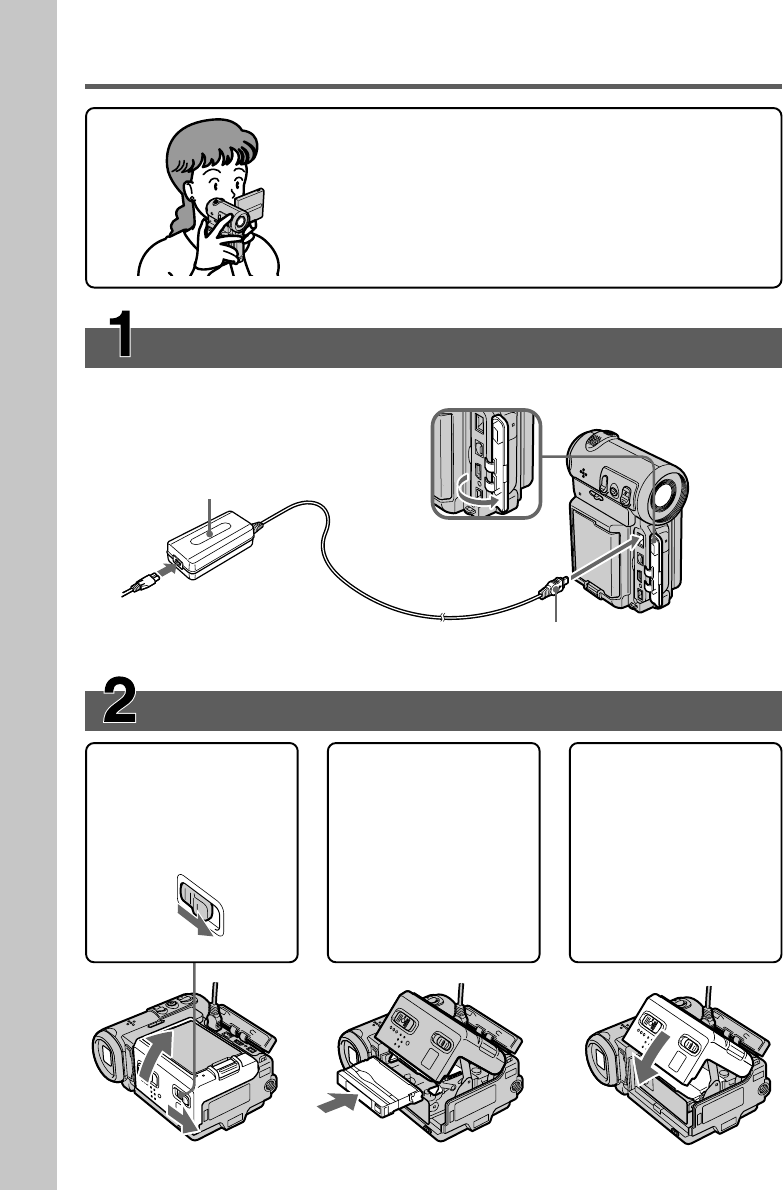
Quick Start Guide
12
Quick Start Guide
Inserting a cassette (p. 19)
Connecting the power cord (p. 16)
Use the battery pack when using your camcorder outdoors (p. 12).
This guide introduces you to the basic way of recording/
playback. See the page in parentheses “( )” for more
information.
AC power adaptor (supplied)
Connect the plug with its v
mark facing the lens side.
Open the jack
cover.
1Slide OPEN/
ZEJECT in the
direction of the
arrow and open the
lid.
2Push the middle
portion of the back
of the cassette to
insert. Insert the
cassette in a straight
line deeply into the
cassette
compartment with
the window facing
out.
3Close the cassette
compartment by
pushing down the
cassette lid halfway.
After the cassette
compartment goes
down completely,
close the lid until it
clicks.
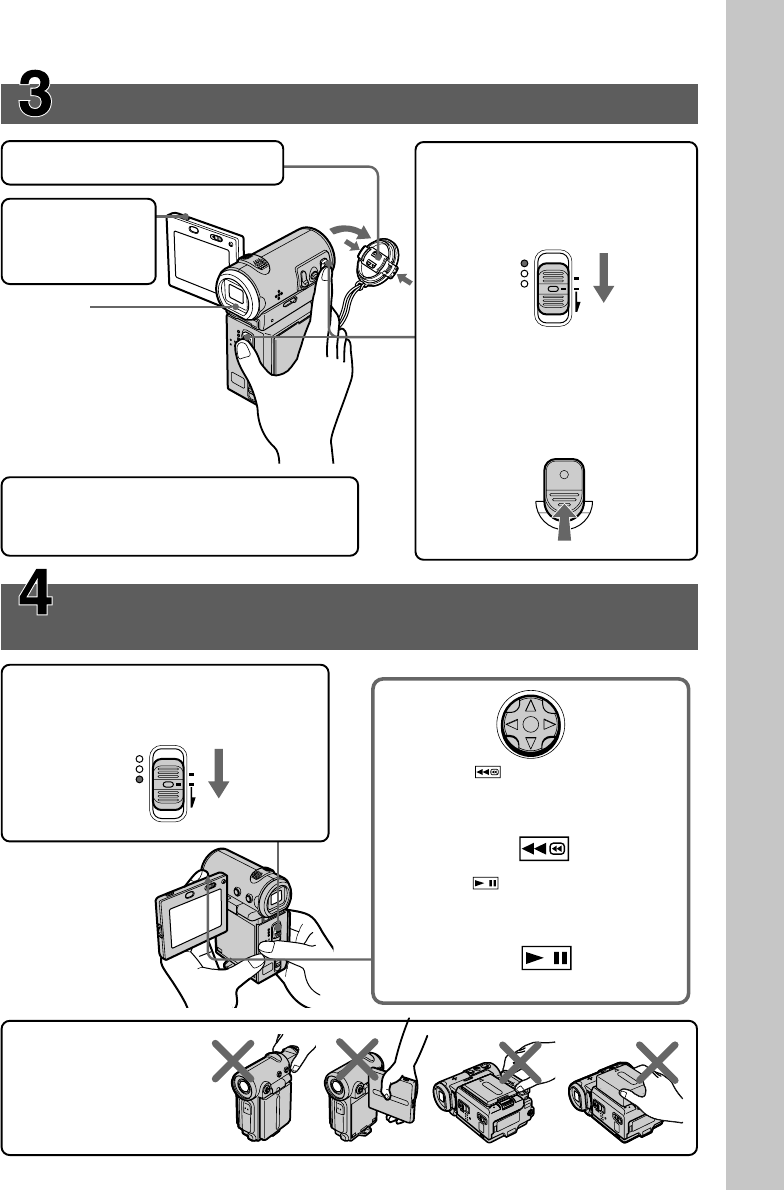
Quick Start Guide
13
Recording a picture (p. 22)
Monitoring the playback picture on the LCD
screen (p. 34)
Viewfinder
When the LCD panel
is closed, pull out the
viewfinder until it
clicks and use it to
monitor.
1Remove the lens cap.
2Press OPEN
to open the
LCD panel.
NOTE
Do not pick up your
camcorder by holding
the viewfinder, the
LCD panel, the battery
pack, or the jack cover.
2Select , then press the
center z on the control button
to rewind the tape.
3Select , then press the center
z on the control button to start
playback.
MEMORY/
NETWORK
VCR
CAMERA (CHG)
POWER
OFF
ON
MODE
START/STOP
MEMORY/
NETWORK
VCR
CAMERA (CHG)
POWER
OFF
ON
MODE
3Set the POWER switch to
CAMERA.
The CAMERA lamp lights
up.
4Press START/STOP. Your
camcorder starts recording.
To stop recording, press
START/STOP again.
1Set the POWER switch to VCR.
The VCR lamp lights up.
When you purchase your camcorder, the clock
is not set up yet. Set up the clock before
recording (p. 17).
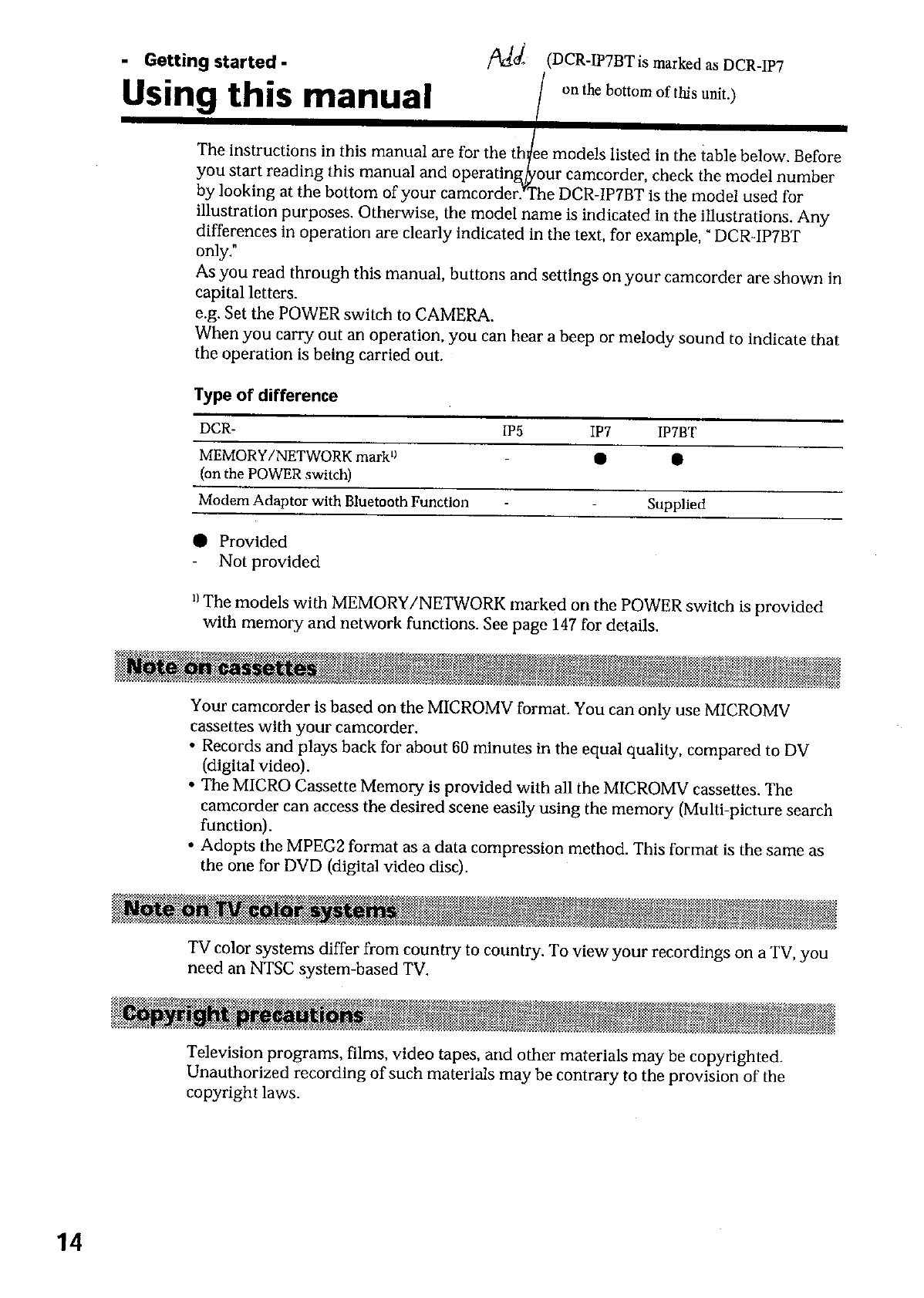
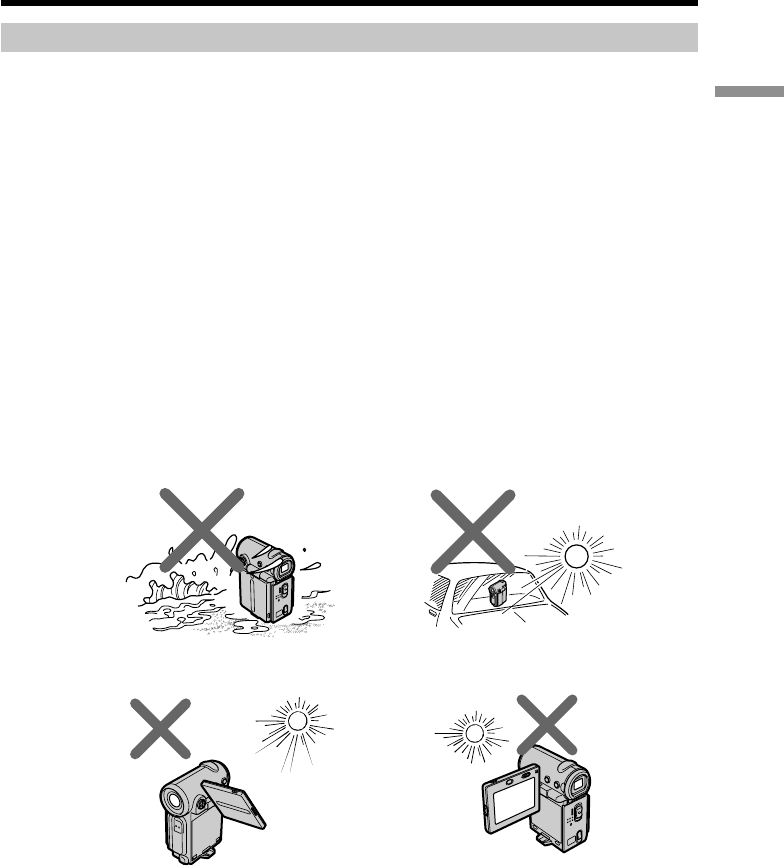
Getting started
15
Using this manual
[a][b]
[c][d]
Precautions on camcorder care
Lens and LCD screen/finder (on mounted models only)
•The LCD screen and the finder are manufactured using extremely high-precision
technology, so over 99.99% of the pixels are operational for effective use.
However, there may be some tiny black points and/or bright points (white, red,
blue or green in color) that constantly appear on the LCD screen and the finder.
These points are normal in the manufacturing process and do not affect the
recording in any way.
•Do not let your camcorder get wet. Keep your camcorder away from rain and sea
water. Letting your camcorder get wet may cause your camcorder to malfunction.
Sometimes this malfunction cannot be repaired [a].
•Never leave your camcorder exposed to temperatures above 60°C (140°F), such as in a
car parked in the sun or under direct sunlight [b].
•Be careful when placing the camcorder near a window or outdoors. Exposing the LCD
screen, the finder or the lens to direct sunlight for long periods may cause
malfunctions [c].
•Do not directly shoot the sun. Doing so might cause your camcorder to malfunction.
Take pictures of the sun in low light conditions such as dusk [d].
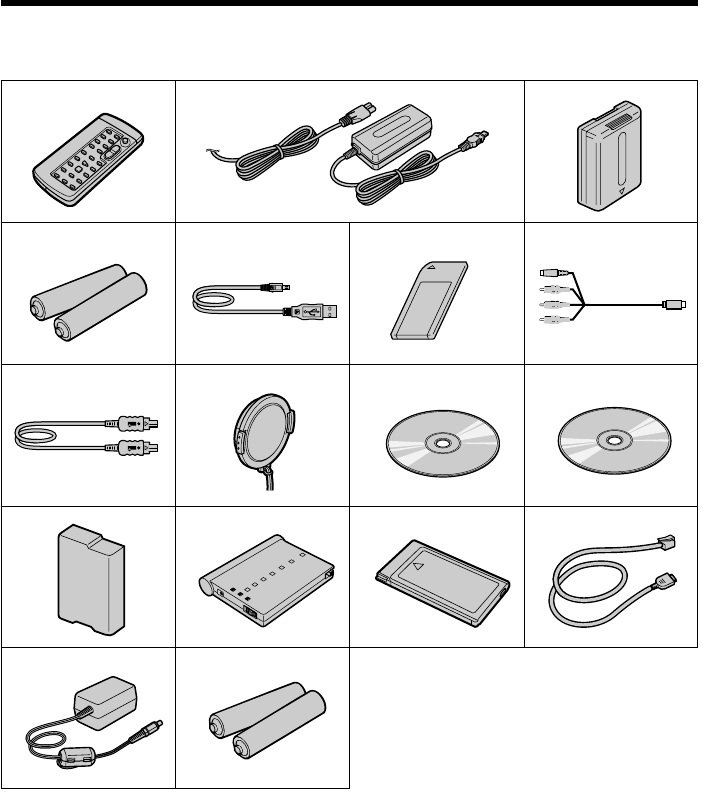
16
7
1
5
3
46
89q; qa
2
Checking supplied accessories
Make sure that the following accessories are supplied with your camcorder.
qs qd qf qg
qh qj

Getting started
17
1Wireless Remote Commander (1)
(p. 188)
2AC-L20A AC power adaptor (1), the
power cord (1) (p. 13)
3NP-FF50 battery pack (1) (p. 12, 13)
4Size AA (R6) battery for Remote
Commander (2) (p. 188)
5USB cable (1) (p. 148)
6“Memory Stick”* (1) (p. 112)
7A/V connecting cable (1) (p. 40)
8i.LINK cable (1) (p. XX)
9Lens cap (1) (p. 22)
0CD-ROM (SPVD-004 USB Driver) (1)
(p. 148)
qa CD-ROM (Movie Shaker Ver. 3. for
MICROMV) (1) (p. XX)
qs Battery terminal cover (1) (p. 12)
qd BTA-NW1 Modem Adaptor with
Bluetooth Function* (1) (p. 176)
qf MDM-5614G Exclusive modem card**
(1)
qg Exclusive modem cable** (1)
qh AC-PT1 AC power adaptor** (1)
qj Size AA alkaline dry batteries for
Modem Adaptor with Bluetooth
Function** (2)
* DCR-IP7/IP7BT only.
** DCR-IP7BT only. For details, refer to the operating instructions of the Modem
Adaptor with Bluetooth Function.
Contents of the recording cannot be compensated if recording or playback is not made due to a
malfunction of the camcorder, storage media, etc.
Checking supplied accessories
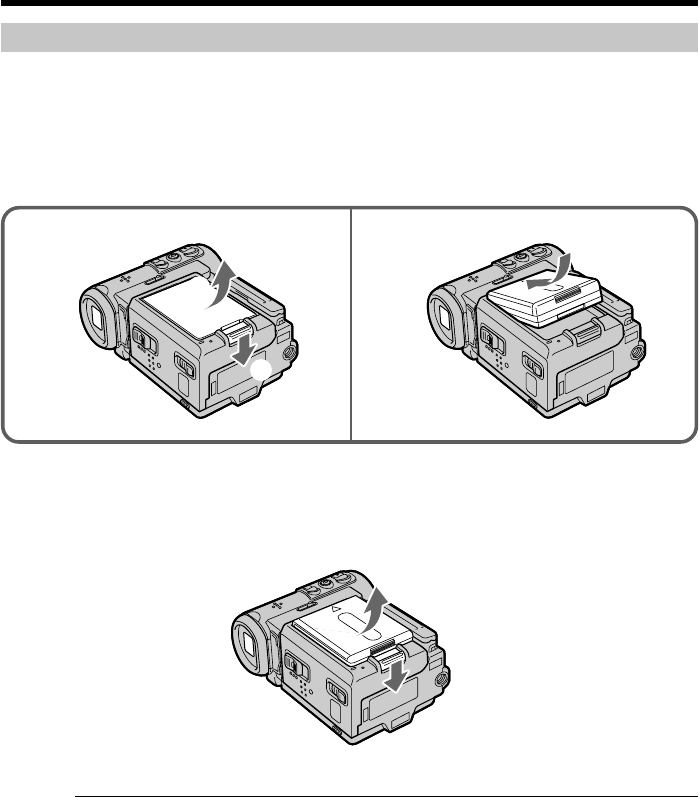
18
Installing the battery pack
We recommend that you use the battery pack when you use your camcorder outdoors.
(1)While turning down the VBATT (battery) release lever in the direction of the
arrow 1, remove the battery terminal cover in the direction of the arrow 2.
(2)Install the battery pack in the direction of the arrow until it clicks.
To remove the battery pack
The battery pack is removed in the same way as the battery terminal cover.
Note on the battery terminal cover
To protect the battery terminals, install the battery terminal cover after the battery pack
is removed.
Note on installing the battery pack
Make sure that the battery pack is properly installed. Check also the battery pack is
attached to the camcorder askew.
1 2
Step 1 Preparing the power supply
2
1
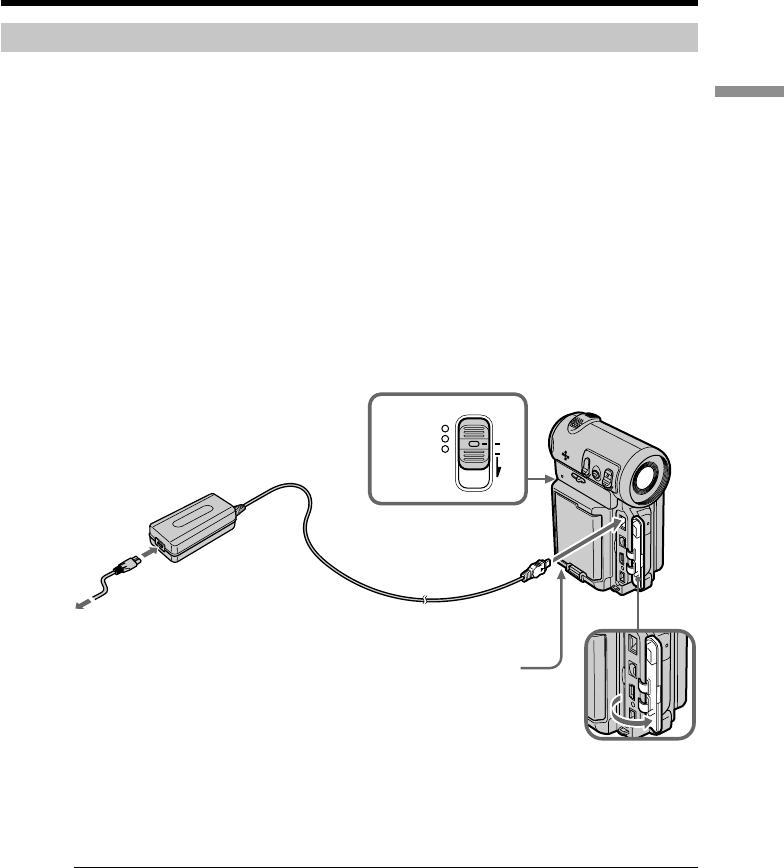
19
Getting started
2
1
4MEMORY/
NETWORK
VCR
CAMERA (CHG)
POWER
OFF
ON
MODE
Charging the battery pack
Use the battery pack after charging it for your camcorder.
Your camcorder operates only with the “InfoLITHIUM” battery pack (F series).
See page 171 for details of the “InfoLITHIUM” battery pack.
(1)Open the jack cover and connect the AC power adaptor supplied with your
camcorder to the DC IN jack with the plug’s v mark facing the lens side.
(2)Connect the power cord to the AC power adaptor.
(3)Connect the power cord to a wall outlet.
(4)Verify that the POWER switch is set to OFF (CHG).
The CHG lamp lights up when the charge begins. After the charge is
completed, the CHG lamp goes out (normal charge). To fully charge the
battery (full charge), leave the battery pack attached for about one hour after
normal charge is completed. Fully charging the battery allows you to use the
battery longer than usual.
After charging the battery pack
Disconnect the AC power adaptor from the DC IN jack on your camcorder.
Note
Prevent metallic objects from coming into contact with the metal parts of the DC plug of
the AC power adaptor. This may cause a short-circuit, damaging the AC power
adaptor.
Step 1 Preparing the power supply
CHG lamp

20
Step 1 Preparing the power supply
While charging the battery pack, the CHG lamp flashes in the following cases:
–The battery pack is not installed correctly.
–Something is wrong with the battery pack.
When you use the AC power adaptor
Place the AC power adaptor near the wall outlet. If any trouble occurs with this unit,
disconnect the plug from the wall outlet as soon as possible to cut off the power.
Charging time
Battery pack Full charge (Normal charge)
NP-FF50 (supplied) 120 (60)
NP-FF70 150 (90)
The charging time may increase if the battery’s temperature is extremely high or low
because of the ambient temperature.
Approximate minutes at 25°C (77°F) to charge an empty battery pack
Recording time
Recording with Recording with
Battery pack the viewfinder the LCD screen
Backlighting on Backlighting off
Continuous* Typical** Continuous* Typical** Continuous* Typical**
NP-FF50 80 45 65 35 80 45
(supplied)
NP-FF70 170 100 140 80 170 100
Approximate minutes when you use a fully charged battery
* Approximate continuous recording time at 25°C (77°F). The battery life will be
shorter if you use your camcorder in a cold environment.
** Approximate number of minutes for recording while you repeat recording start/
stop, zooming and turning the power on/off. The actual battery life may be shorter.
Playing time
Battery pack Playing time Playing time
on LCD screen with LCD closed
NP-FF50 (supplied) 65 80
NP-FF70 135 165
Approximate minutes when you use a fully charged battery
Approximate continuous playing time at 25°C (77°F). The battery life will be shorter if
you use your camcorder in a cold environment.
The recording or playback time with the normal charged battery pack is about 90% in
comparison with the fully charged battery pack.
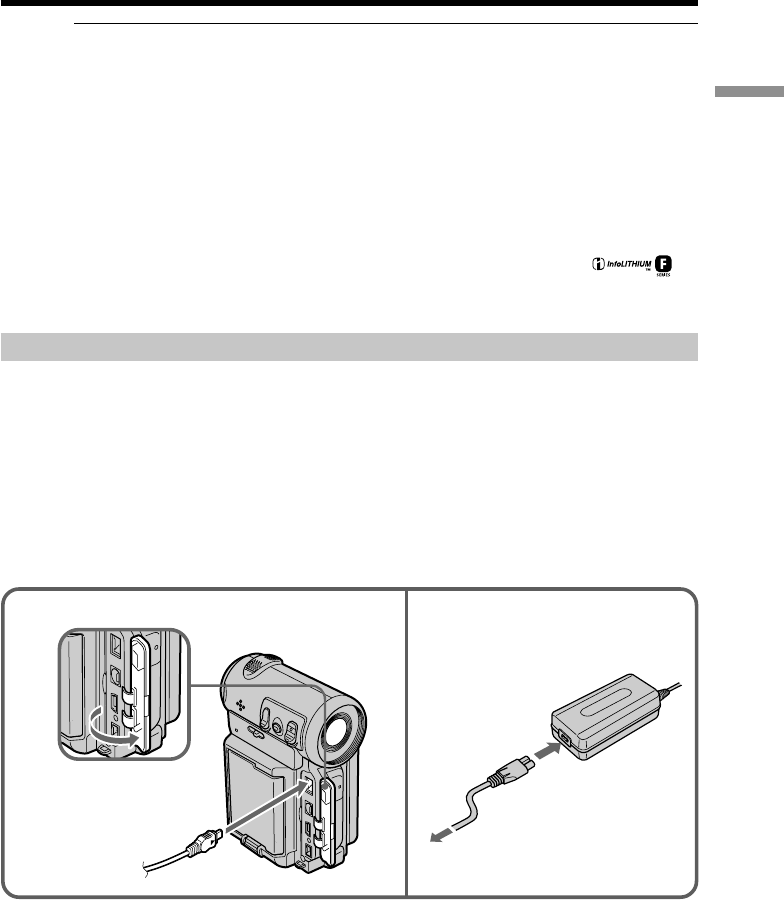
21
Getting started
If the power runs off soon although sufficient battery remaining time is indicated
Fully charge the battery pack so that the correct battery remaining time will be
indicated.
Recommended charging temperature
We recommend charging the battery pack in an ambient temperature of between 10 to
30°C (50 to 86°F).
What is ”InfoLITHIUM”?
The “InfoLITHIUM” is a lithium ion battery pack which can exchange data such as
battery consumption with compatible electronic equipment. This unit is compatible
with the “InfoLITHIUM” battery pack (F series). Your camcorder operates only with the
“InfoLITHIUM” battery. “InfoLITHIUM” F series battery packs have the
mark.
“InfoLITHIUM” is a trademark of Sony Corporation.
Connecting to a wall outlet
When you will use your camcorder for a long time, we recommend that you power it
from a wall outlet using the AC power adaptor.
(1)Open the jack cover and connect the AC power adaptor supplied with your
camcorder to the DC IN jack on your camcorder with the plug’s v mark facing
the lens side.
(2)Connect the power cord to the AC power adaptor.
(3)Connect the power cord to a wall outlet.
Step 1 Preparing the power supply
2,3
1

22
PRECAUTION
The set is not disconnected from the AC power source (house current) as long as it is
connected to a wall outlet, even if the set itself has been turned off.
Notes
•The AC power adaptor cannot supply power if the battery pack is attached to your
camcorder.
•The DC IN jack has “source priority.” This means that the battery pack cannot supply
its power when the power cord is connected to the DC IN jack, even when the power
cord is not plugged into a wall outlet.
Using a car battery
Use a Sony DC Adaptor/Charger (optional).
Step 1 Preparing the power supply
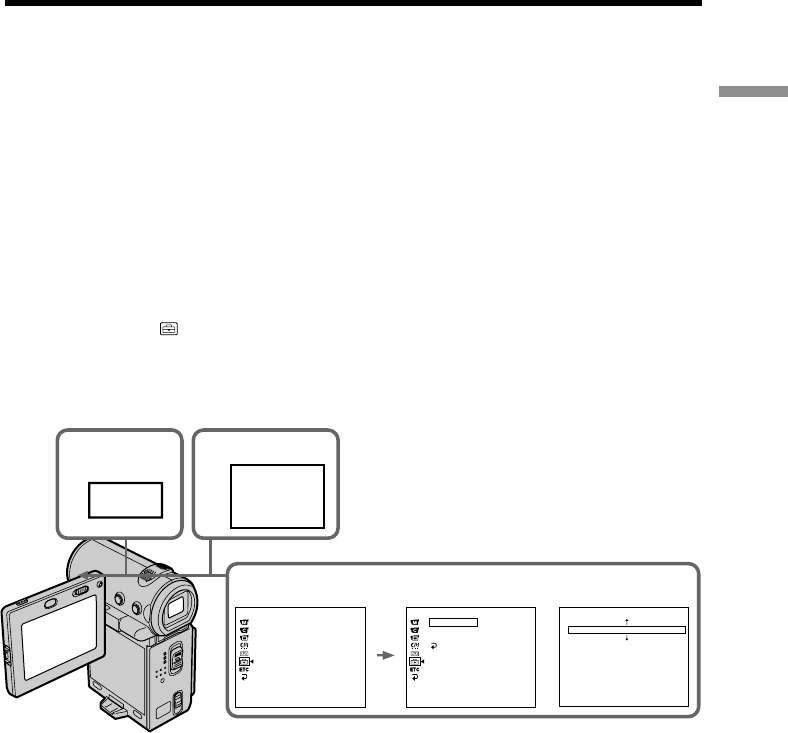
23
Getting started
Step 2 Setting the date and time
Be sure to set the date and time when you use your camcorder for the first time.
“CLOCK SET” will be displayed each time you set the POWER switch to CAMERA or
MEMORY (DCR-IP7/IP7BT only) unless you set the date and time.
If you do not use your camcorder for about 3 months, the date and time settings may be
released (bars may appear) because the built-in rechargeable battery installed in your
camcorder will have been discharged (p. 177).
First, set your area, then the daylight saving time, the year, the month, the day, the hour
and then the minute.
(1)Set the POWER switch to CAMERA or MEMORY (DCR-IP7/IP7BT only). The
CAMERA or MEMORY lamp (DCR-IP7/IP7BT only) lights up.
(2)Select FN, then press the center z on the control button. The PAGE1 screen
appears.
(3)Select MENU, then press the center z on the control button. The menu
appears.
(4)Select , then press the center z or B on the control button.
(5)Select CLOCK SET, then press the center z or B on the control button.
4
SETUP MENU
CLOCK SET
LTR SIZE
DEMO MODE
23
SETUP MENU
CLOCK SET
LTR SIZE
DEMO MODE
RETURN
FN
––:––:––
5
CLOCK SET
AREA 1
SUMMERTIME
OFF
Lisbon, London
DATE
[EXEC] : NEXT ITEM
Y M D
–––– ––– –– –– : ––
GMT +0.0
MENU
The illustration: In CAMERA mode
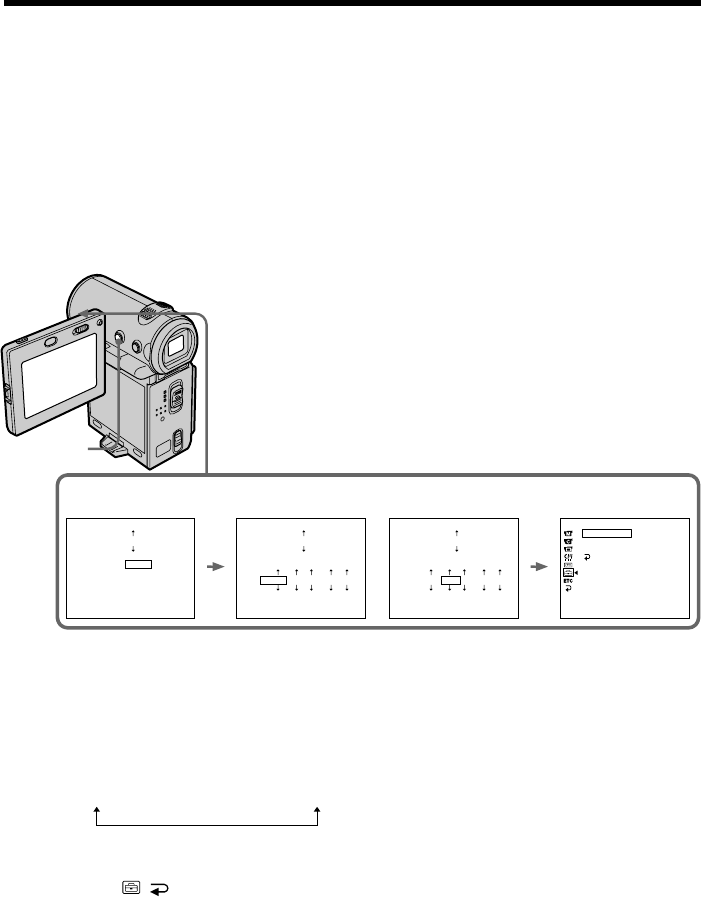
24
Step 2 Setting the date and time
(6)Select your area, then press the center z on the control button.
(7)Select whether your area is in daylight saving time or not, then press the
center z on the control button.
When your area is in daylight saving time, select ON, when not in daylight
saving time, select OFF.
(8)Select the year, then press the center z on the control button.
(9)Set the month, day and hour with the same procedure as step 8.
(10)Set the minute, and execute it by the time signal. The clock starts to move.
(11)Press DISPLAY to turn off the menu. The clock setup is completed.
The year changes as follows:
To return to the FN screen
Select , , then press the center z on the control button after step 10. The PAGE1
screen appears. Next, select EXIT, then press the center z on the control button.
SETUP MENU
CLOCK SET
LTR SIZE
DEMO MODE
RETURN
JUL 4 2001
5:30:00 PM
2001 JAN 1 12 : 00AM
CLOCK SET
AREA 26
SUMMERTIME
OFF
New York, Bogota
DATE
[EXEC] : NEXT ITEM
Y M D
GMT –5.0
6,7
11 8,10
CLOCK SET
AREA 26
SUMMERTIME
OFF
ON
New York, Bogota
DATE
[EXEC] : NEXT ITEM
Y M D
–––– ––– –– –– : ––
GTM –5.0 CLOCK SET
AREA 26
SUMMERTIME
OFF
New York, Bogota
DATE
[EXEC] : NEXT ITEM
Y M D
2001 JAN 1 12 : 00AM
GMT –5.0
The illustration: In CAMERA mode
2000 y 2001 T · · · · t 2079

25
Getting started
When using the camcorder abroad or the area where is several
time difference with your area
•You can set up the clock temporarily. For details, see “Simple setting of clock by time
difference” on page 179.
•For details on the available area of the network function, see “Using your camcorder
abroad” on page 178 (DCR-IP7/IP7BT only).
If you do not set the date and time
“– – – – – – – – –” and “– –:– –:– –” are recorded on the tape or the “Memory Stick”
(DCR-IP7/IP7BT only) as its data code.
Note on the time indicator
The internal clock of your camcorder operates on a 12-hour cycle.
–12:00 AM stands for midnight.
–12:00 PM stands for noon.
Step 2 Setting the date and time
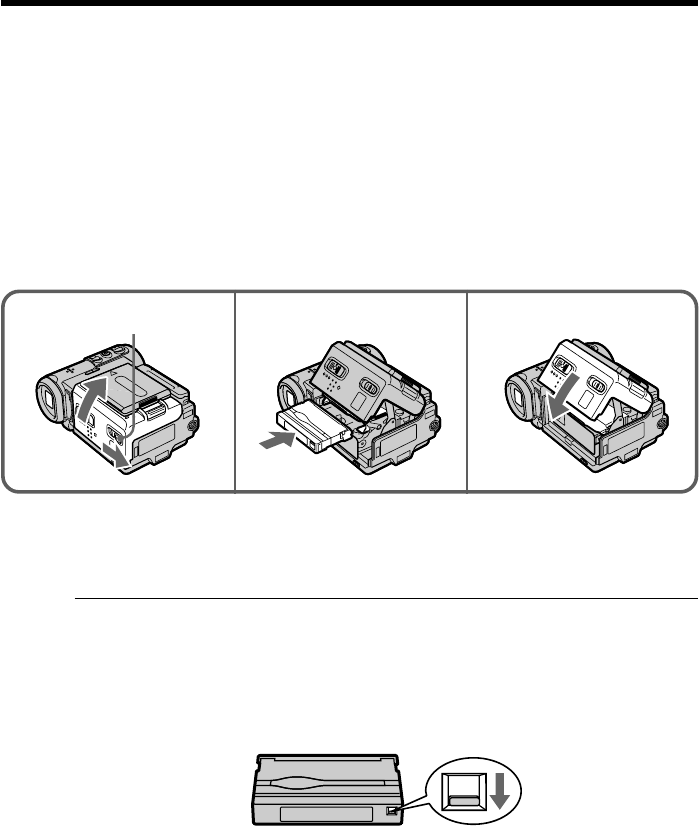
26
(1)Install the battery pack, or connect the AC power adaptor for the power supply
(p. 12 to 16).
(2)Slide OPEN/ZEJECT in the direction of the arrow and open the cassette lid.
The cassette compartment automatically lifts up and opens.
(3)Push the middle portion of the back of the cassette to insert. Insert the cassette
in a straight line deeply into the cassette compartment with the window facing
out.
(4)Close the cassette compartment by pushing down the cassette lid halfway. The
cassette compartment automatically goes down.
(5)After the cassette compartment goes down completely, close the lid until it
clicks.
To eject the cassette
Follow the procedure above, and take out the cassette in step 3.
Note
Do not press the cassette compartment down firmly. Doing so may cause a malfunction.
To prevent accidental erasure
Slide the write-protect tab on the cassette to expose the red mark.
23, 4
OPEN/ZEJECT 5
Step 3 Inserting a cassette

27
Getting started
Note on the label
These may cause a malfunction of the camcorder. Therefore, be sure not to:
•Stick any labels than the supplied one.
•Stick the label onto any positions other than the labeling position [a].
Step 3 Inserting a cassette
[a]
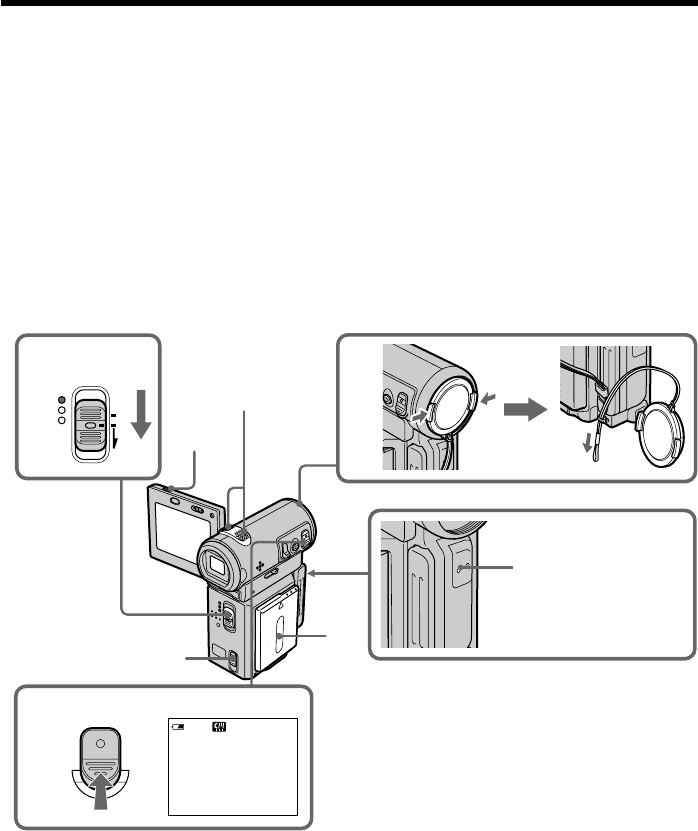
28
Your camcorder automatically focuses for you.
(1)Remove the lens cap and pull the lens cap string to fix it.
(2)Install the power source. See “Step 1 Preparing the power supply” for more
information (p. 18).
(3)Insert a cassette. See “Step 3 Inserting a cassette” for more information (p. 25).
(4)Press OPEN, then open the LCD panel.
(5)Set the POWER switch to CAMERA. The CAMERA lamp lights up and your
camcorder is set to the standby mode.
(6)Press START/STOP. The STBY indicator flashes. Then, the REC indicator
appears instead and the camcorder starts recording. The camera recording
lamp located on the front of your camcorder lights up. To stop recording, press
START/STOP again.
After recording
(1)Set the POWER switch to OFF (CHG).
(2)Close the LCD panel.
(3)Eject the cassette.
(4)Remove the power source.
6
5
2
3
4
1
40min
REC
0:00:01
START/STOP
MEMORY/
NETWORK
VCR
CAMERA (CHG)
POWER
OFF
ON
MODE
Microphone
Camera recording
lamp
— Recording – Basics —
Recording a picture
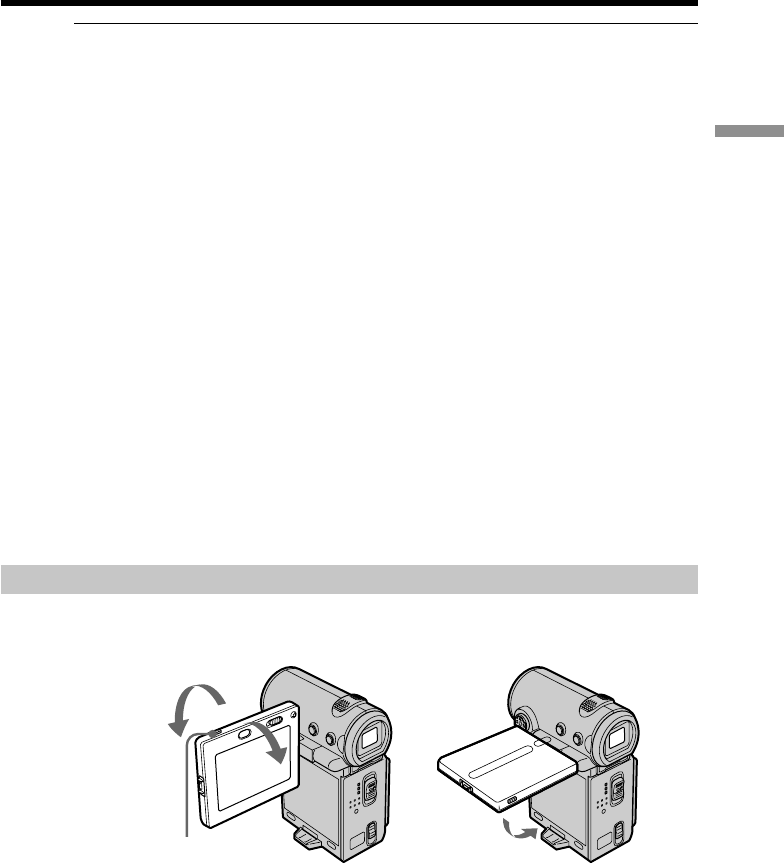
29
Recording – Basics
180°
90°
OPEN
Note
Do not touch the built-in microphone during recording.
To enable smooth transition
Transition between the last scene you recorded and the next scene is smooth as long as
you do not eject the cassette even if you turn off your camcorder.
However, check the following:
–When you change the battery pack, set the POWER switch to OFF (CHG).
If you leave your camcorder in standby mode for 5 minutes while the cassette is
inserted
Your camcorder automatically turns off. This is to save battery power and to prevent
battery and tape wear. To resume the standby mode, set the POWER switch to OFF
(CHG), and to CAMERA again. However, your camcorder does not turn off
automatically while the cassette is not inserted.
Recording data
The recording data (date/time or various settings when recorded) are not displayed
during recording. However, they are recorded automatically onto the tape. To display
the recording data, press DATA CODE on the Remote Commander during playback.
You can also use DATA CODE on the PAGE3 screen for this operation. (p. 36).
The battery usable time when you record using the LCD screen
The battery time is slightly shorter than the shooting time using the viewfinder.
If you press START/STOP twice in very short time interval
The operation may not work.
Adjusting the angle of the LCD screen
The LCD panel can be rotated as illustrated below.
When you try to close the LCD panel, set it horizontally, then swing it into the
camcorder body.
Recording a picture
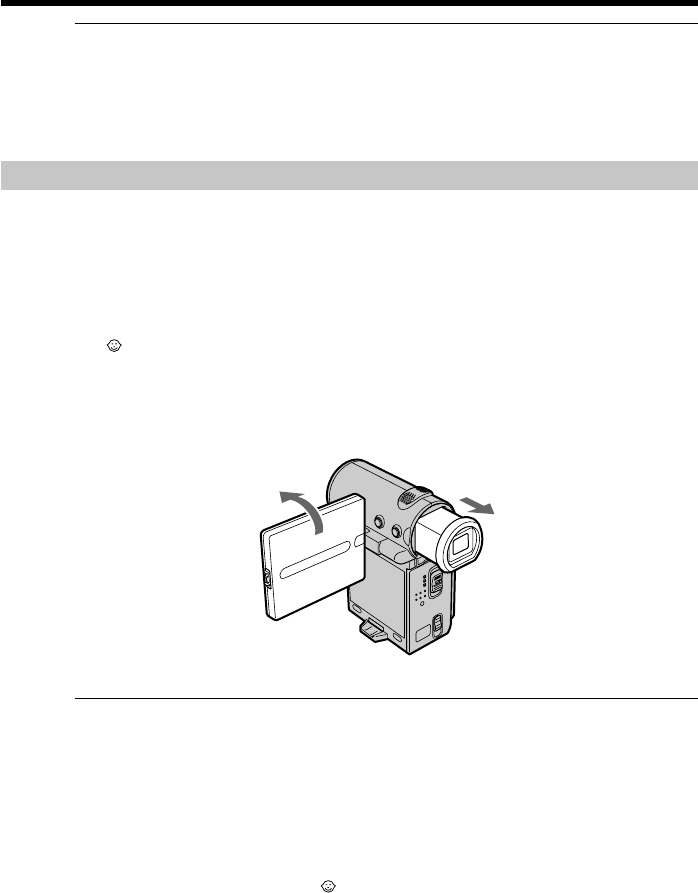
30
Recording a picture
Note
When using the LCD screen except in the mirror mode, the viewfinder automatically
turns off.
When you adjust the angle of the LCD panel
Make sure if the LCD panel is opened up to 90 degrees.
Shooting with the mirror mode
This feature allows the camera subject to view him-or herself on the LCD screen.
The subject uses this feature to check his or her own image on the LCD screen while
you look at the subject in the viewfinder.
In CAMERA or MEMORY (DCR-IP7/IP7BT only) mode.
Pull out the viewfinder, and open the LCD panel and rotate it as illustrated below.
The indicator appears in the viewfinder and on the LCD screen.
When the POWER switch is set to CAMERA, Xz appears in standby mode, and z
appears in recording mode. Some of other indicators appear mirror-reversed and others
are not displayed.
Pictures in the mirror mode
The picture on the LCD screen is a mirror-image. However, the picture will be normal
when recorded.
During recording in the mirror mode
FN appears mirror-reversed in the viewfinder.
When you press the center z on the control button when FN is displayed on the
screen
The PAGE screen appears and the indicator is not displayed.
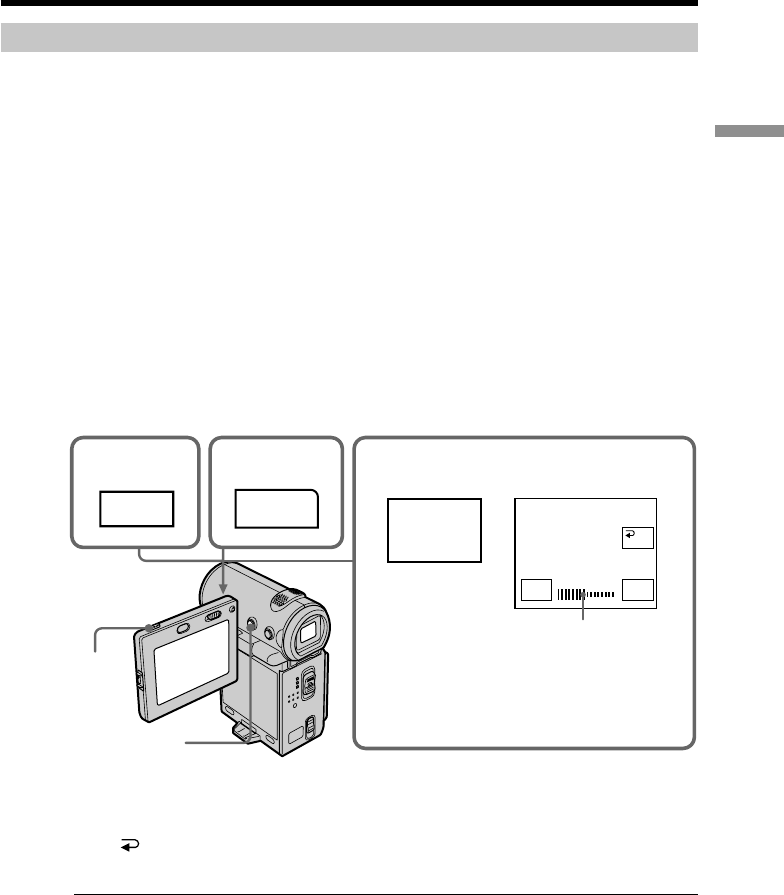
31
Recording – Basics
Adjusting the brightness of the LCD screen
When recording in bright conditions, set the LCD BACKLIGHT switch to OFF.
(1)In CAMERA, MEMORY (DCR-IP7/IP7BT only), playback, or playback pause
mode, select FN, then press the center z on the control button. The PAGE1
screen appears.
(2)Select PAGE2, then press the center z on the control button. The PAGE2
screen appears.
(3)Select LCD BRT, then press the center z on the control button. The screen for
adjusting the brightness of the LCD screen appears.
(4)Select –/+, then press the center z on the control button repeatedly to adjust
the brightness.
–: to dim
+: to brighten
You can also adjust the brightness by pressing b/B repeatedly after you select
–/+.
(5)Press DISPLAY to clear the screen buttons.
To return to the FN screen
Select OK, then press the center z on the control button after step 4. The PAGE2
screen appears. Next, select EXIT, then press the center z on the control button.
When FN is not displayed on the screen
Press DISPLAY or z so that FN is displayed. You can also use DISPLAY on the Remote
Commander.
13,4
FN
2
5
LCD
BRT
PAGE2
LCD BRT
–+
OK
Recording a picture
OPEN
LCD BRT bar
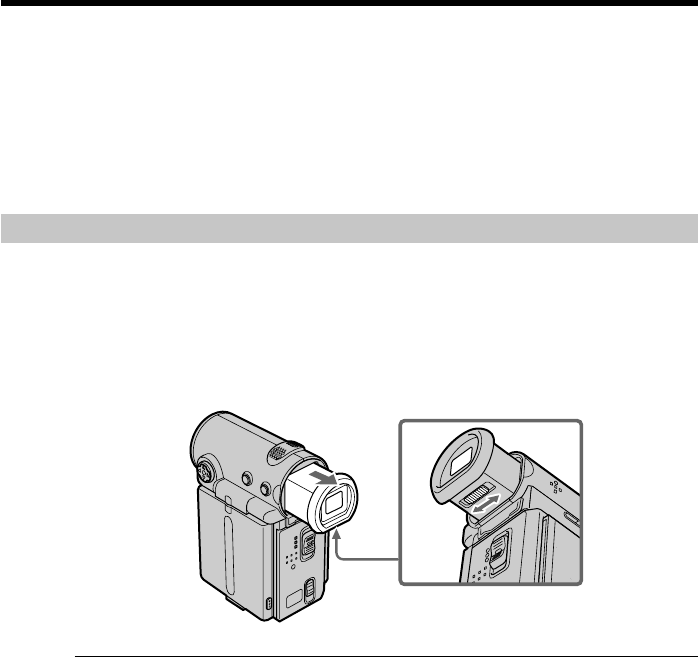
32
Recording a picture
The color of the LCD screen
You can adjust it using the LCD COLOR item in the menu settings (p. XX).
Even if you adjust LCD BRT, LCD COLOR, or the LCD screen backlight
The recorded picture will not be affected.
The setting of the LCD BACKLIGHT switch
Normally, set it to ON. When you use the camcorder in bright conditions using the
battery pack, set it to OFF. This position saves the battery power.
Adjusting the viewfinder
If you record pictures with the LCD panel closed, check the picture with the viewfinder.
Adjust the viewfinder lens to your eyesight so that the indicators in the viewfinder
come into sharp focus.
Pull out the viewfinder and move the viewfinder lens adjustment lever.
Viewfinder backlight
You can change the brightness of the backlight when using the battery pack. Set up the
VF B.L. item in the menu settings (p. 105).
Even if you adjust the viewfinder backlight
The recorded picture will not be affected.
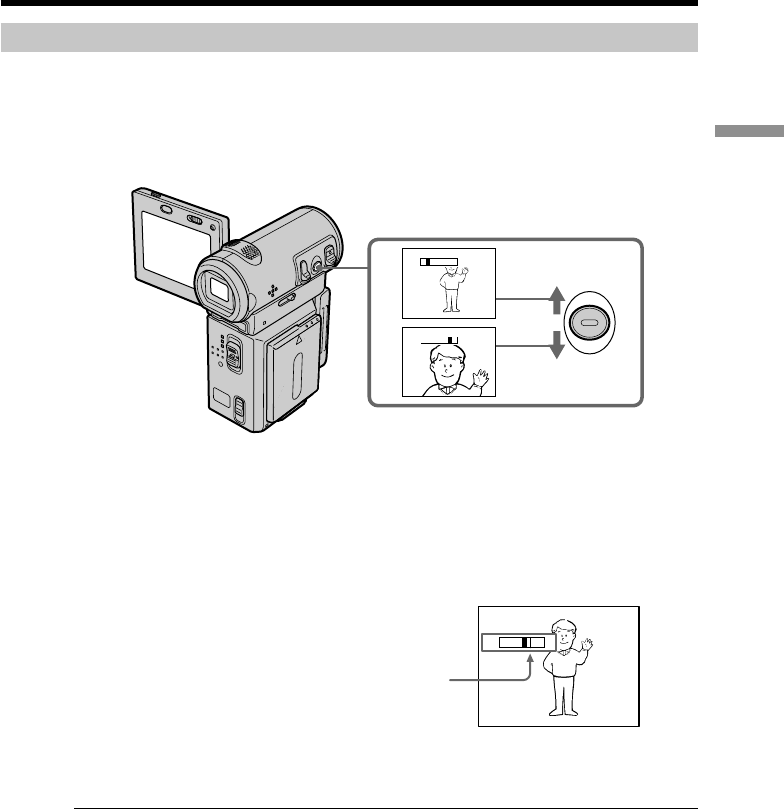
33
Recording – Basics
Recording a picture
Using the zoom feature
Push up or down ZOOM slightly for a slower zoom. Push it firmly for a faster zoom.
Using the zoom function sparingly results in better-looking recordings.
“T” side: for telephoto (subject appears closer)
“W” side: for wide-angle (subject appears farther away)
To use zoom greater than 10×
Zoom greater than 10× is performed digitally. To activate digital zoom, set D ZOOM to
20× or 120× in the menu settings. The digital zoom function is set to OFF as a default
setting (p. 105).
Note
During optical-zooming, the SteadyShot function does not work when the zoom
position is set to the “W”-end side.
When you shoot close to a subject
If you cannot get a sharp focus, push up ZOOM toward the “W” side until the focus is
sharp. You can shoot a subject that is at least about 80 cm (about 2 feet 5/8 inch) away
from the lens surface in the telephoto position, or about 1 cm (about 1/2 inch) away in
the wide-angle position.
W
T
T
W
T
W
T
W
The right side of the bar shows the digital
zooming zone.
The digital zooming zone appears when you
set D ZOOM to 20× or 120× in the menu
settings (p. 105)
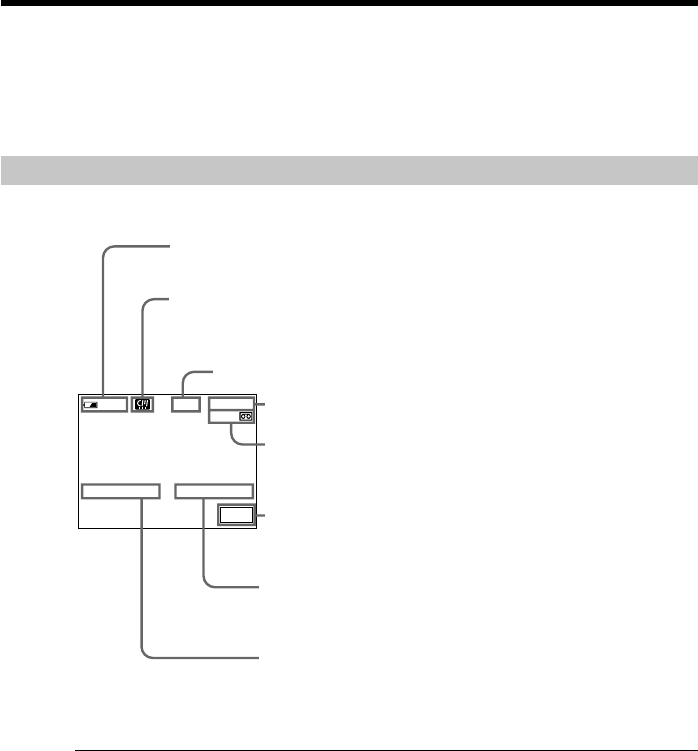
34
Notes on digital zoom
•Digital zoom is up to 20× or 120×.
•The picture quality deteriorates as you push down ZOOM toward the “T” side.
When the POWER switch is set to MEMORY (DCR-IP7/IP7BT only)
You cannot use the digital zoom.
The indicators displayed in recording mode
The indicators are not recorded on the tape.
Remaining battery time indicator
The remaining battery time indicator roughly indicates the recording time. The
indicator may not be correct, depending on the conditions in which you are recording.
When you close the LCD panel and open it again, it takes about 1 minute for the correct
remaining battery time in minutes to be displayed.
Tape counter
The tape counter can be reset using COUNT RESET on the PAGE3 screen through the
FN screen (p. XX).
Remaining tape indicator
The indicator may not be displayed accurately depending on the tape.
0:00:01
45min
40
min
REC
FN
JUL 4 2001 12 : 05 : 56 AM
Recording a picture
MICRO cassette memory indicator
Remaining battery time indicator
STBY/REC indicator
Remaining tape indicator
This appears soon after you insert a cassette.
Tape counter indicator
FN button
Select this button to display the operation buttons on the
screen.
Time indicator
The time is displayed about 5 seconds after the power is
turned on.
Date indicator
The date is displayed about 5 seconds after the power is
turned on.
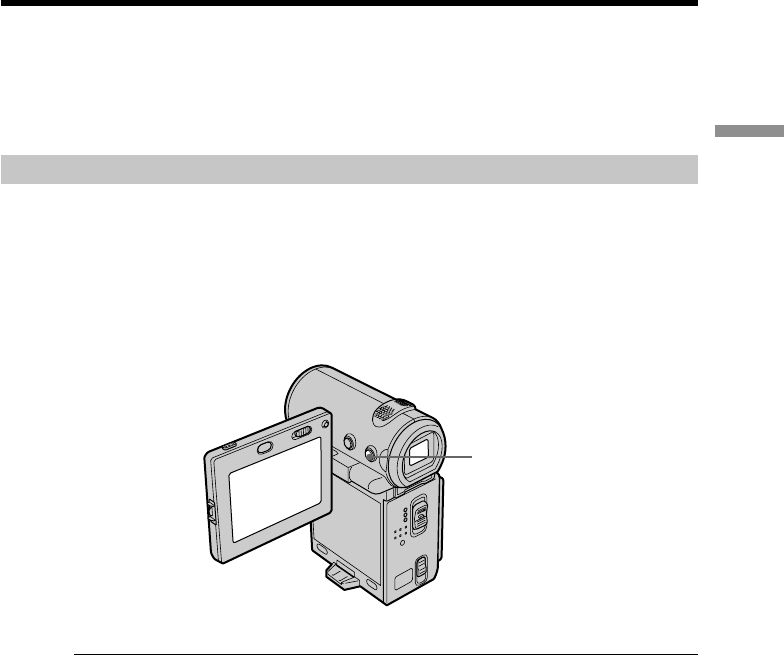
35
Recording – Basics
Recording a picture
Recording data
The recording data (date/time or various settings when recorded) are not displayed
during recording. However, they are recorded automatically onto the tape. To display
the recording data, press DATA CODE on the Remote Commander during playback.
You can also use DATA CODE on the PAGE3 screen through the FN screen for this
operation (p. 36).
Shooting backlit subjects – BACK LIGHT
When you shoot a subject with the light source behind the subject or a subject with a
light background, use the backlight function.
Press BACK LIGHT in CAMERA or MEMORY (DCR-IP7/IP7BT only) mode.
The . indicator appears on the screen.
To cancel, press BACK LIGHT again.
When the backlight function is activated
The backlight function will be canceled when you set EXPOSURE to MANUAL on the
PAGE1 screen through the FN screen.
While the FN screen is displayed
The backlight function is deactivated.
BACK LIGHT
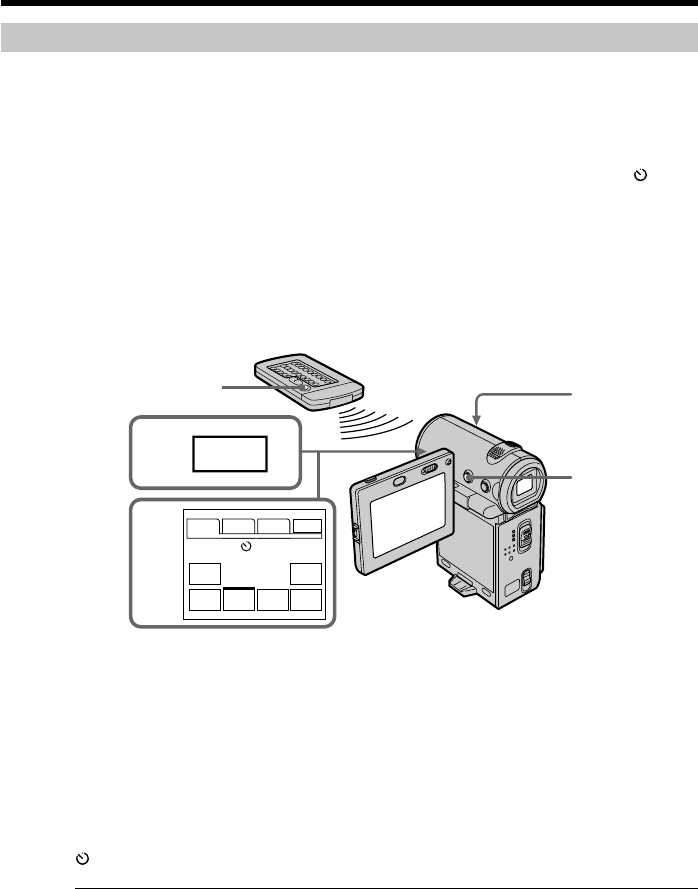
36
Self-timer recording
Recording with the self-timer starts in 10 seconds automatically. You can also use the
Remote Commander for this operation.
(1) In standby mode, select FN, then press the center z on the control button. The
PAGE1 screen appears.
(2) Select SELF TIMER, then press the center z on the control button. The (self-
timer) indicator appears.
(3) Press DISPLAY to turn off the screen buttons.
(4) Press START/STOP.
Self-timer starts counting down from 10 with a beep sound. In the last 2
seconds of the countdown, the beep sound gets faster, then recording starts
automatically.
To stop the count down
Press START/STOP. To restart the countdown, press START/STOP again.
To record still images on a tape using the self-timer
Press PHOTO in step 4 (p. 41).
To cancel the self-timer recording
Select SELFTIMER, then press the center z on the control button in standby mode. The
(self-timer) indicator disappears from the screen.
Note
The self-timer recording mode is automatically canceled when:
–The self-timer recording is finished.
–The POWER switch is set to OFF (CHG) or VCR.
When the POWER switch is set to MEMORY (DCR-IP7/IP7BT only)
You can also record a still image on the “Memory Stick” with the self-timer (p. 125).
Recording a picture
1
23
4
FN
PAGE1 PAGE2 PAGE3
EXIT
MENU FOCUS
FADER SELF
TIMER MEM
MIX EXPO–
SURE
START/STOP
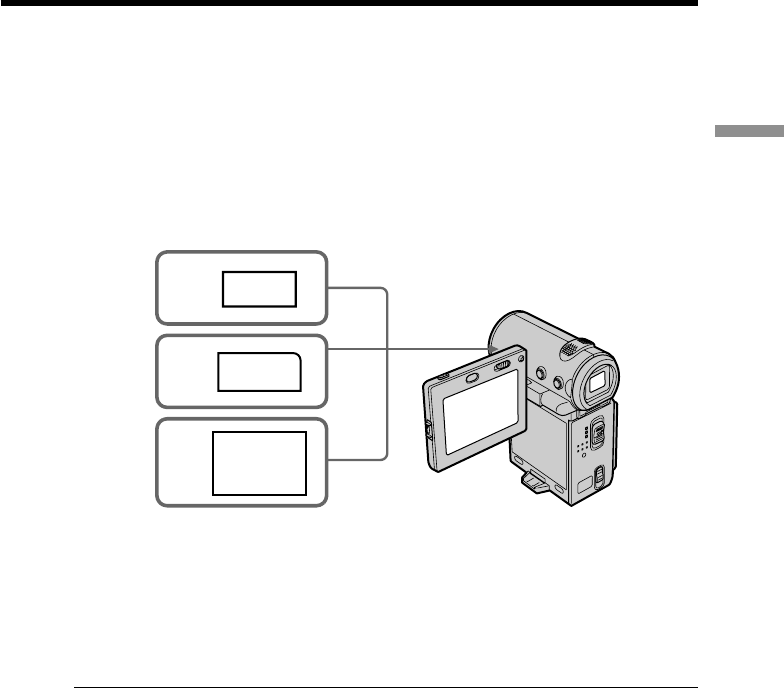
37
Recording – Basics
Checking the recording – End search
You can go to the end of the last recorded point.
(1)In standby mode, select FN, then press the center z on the control button. The
PAGE1 screen appears.
(2)Select PAGE2, then press the center z on the control button. The PAGE2
screen appears.
(3)Select END SCH, then press the center z on the control button.
The last 5 seconds of the recorded section are played back and your camcorder
returns to the standby mode. You can monitor the sound from the speaker.
To return to the FN screen
Select EXIT, then press the center z on the control button.
To stop searching
Select END SCH, then press the center z on the control button again.
Note
Even if you remove the cassette, the end search function works.
1FN
2
3
END
SCH
PAGE2
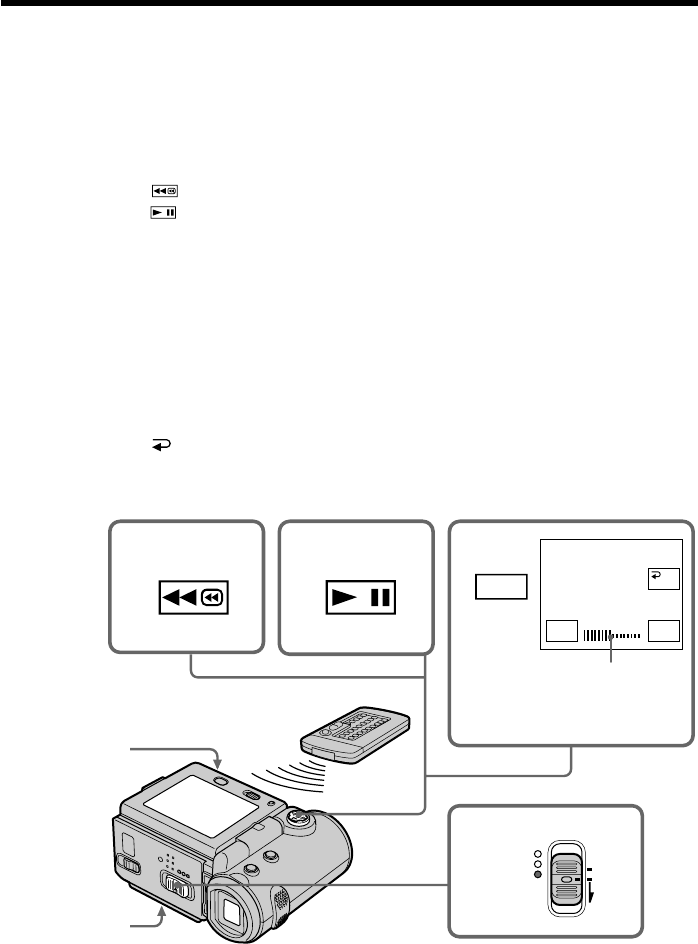
38
You can monitor the playback picture on the LCD screen. If you close the LCD panel,
you can monitor the playback picture in the viewfinder. You can also control playback
using the Remote Commander supplied with your camcorder.
(1)Install the power source and insert the recorded tape.
(2)Press OPEN to open the LCD panel.
(3)Set the POWER switch to VCR. The camcorder turns on and the VCR lamp
lights up.
(4)Select , then press the center z on the control button to rewind the tape.
(5)Select , then press the center z on the control button to start playback.
(6)Adjust the volume following the procedure below.
1Select FN, then press the center z on the control button. The PAGE1 screen
appears.
2Select VOL, then press the center z on the control button. The screen for
adjusting the volume appears.
3Select –/+, then press the center z on the control button repeatedly to adjust
the volume.
–: to turn down the volume
+: to turn up the volume
You can adjust the volume by pressing b/B repeatedly after you select –/+.
(7)Select OK, then press the center z on the control button. The PAGE1 screen
appears.
MEMORY/
NETWORK
VCR
CAMERA (CHG)
POWER
OFF
ON
MODE
5
4
3
6
1
2
VOL
–+
OK
FN
VOL bar
— Playback – Basics —
Playing back a tape
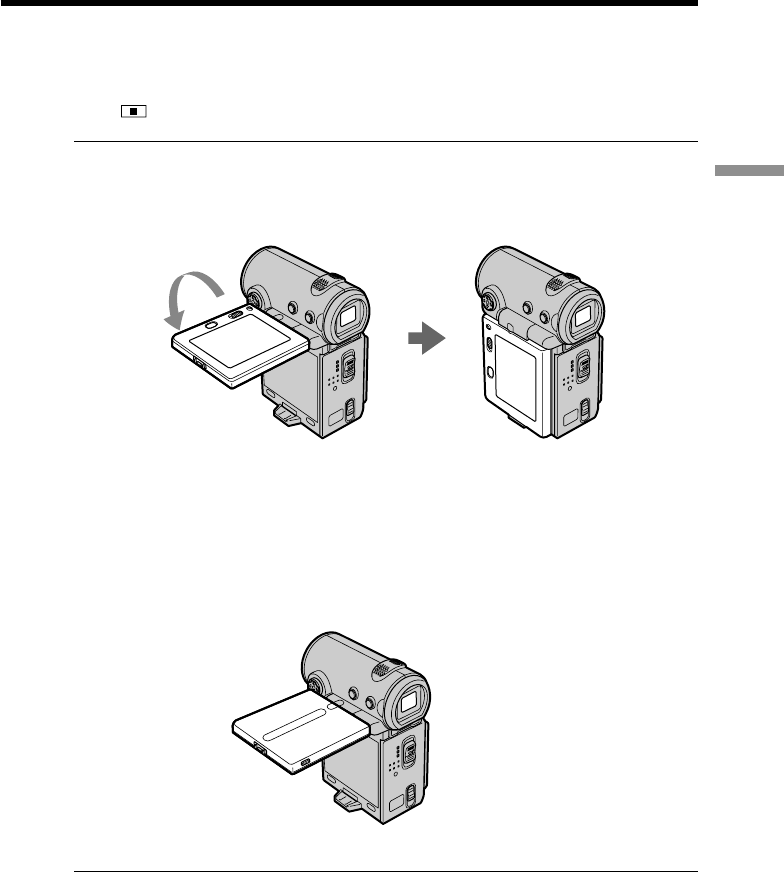
39
Playback – Basics
Playing back a tape
To return to the FN screen
Select EXIT, then press the center z on the control button.
To stop playback
Select , then press the center z on the control button.
When monitoring on the LCD screen
You can turn the LCD panel over and move it back to the camcorder body with the
LCD screen facing out.
If you leave the power on for a long time
Your camcorder gets warm. However, this is not a malfunction.
When you open or close the LCD panel
Open or close the LCD panel after the position of the LCD panel is as illustrated below.
Note
Be careful not to touch the VBATT lever while you are playing back a tape. The battery
pack may be accidentally become detached from the camcorder.
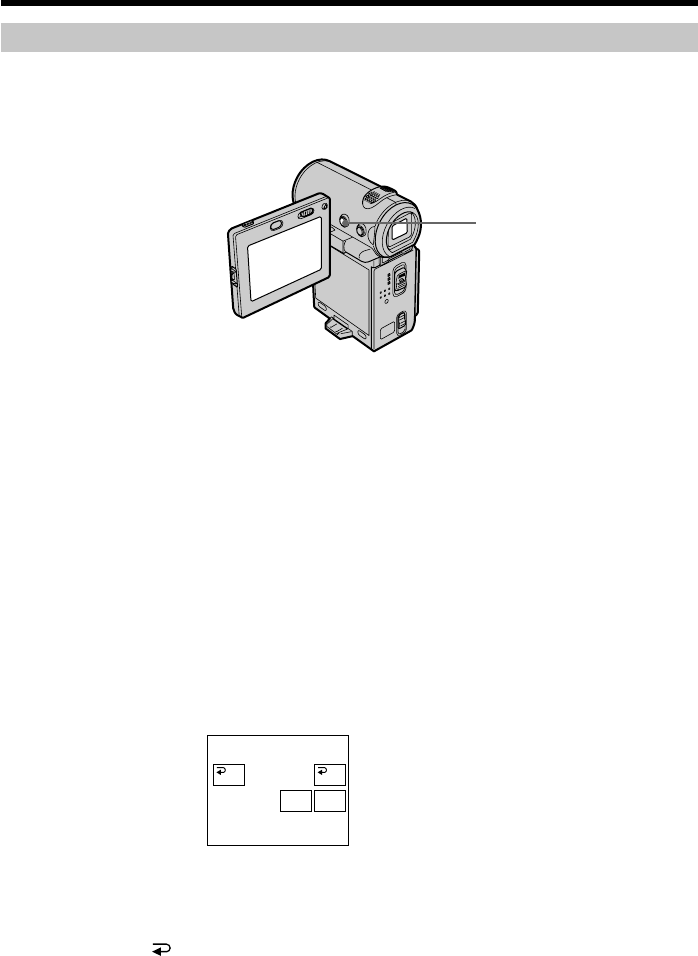
40
DATACODE
CAM
DATA DATE
DATA
OFF OK
To display the screen indicators – Display function
Press DISPLAY on your camcorder or on the Remote Commander. The indicators being
displayed disappear from the screen. To display the indicators, press DISPLAY again.
Using the data code function
Your camcorder automatically records not only images on the tape but also the
recording data (date/time and various settings when recorded) (Data code).
Follow the steps below to display the data code using the camcorder or the Remote
Commander.
When using the camcorder
To display the data code
(1)In playback or playback pause mode, select FN, then press the center z on the
control button. The PAGE1 screen appears.
(2)Select PAGE3, then press the center z on the control button. The PAGE3
screen appears.
(3)Select DATA CODE, then press the center z on the control button. The DATA
CODE screen appears.
(4)Select CAM DATA or DATE DATA, then press the center z on the control
button. The top of the selected button is indicated with the green bar.
(5)Select OK, then press the center z on the control button.
(6)Select EXIT, then press the center z on the control button.
Playing back a tape
DISPLAY
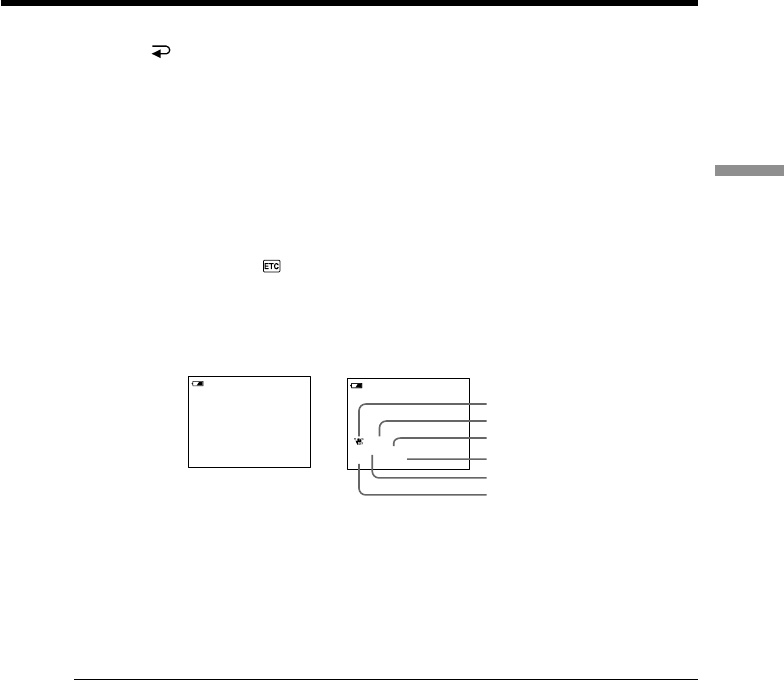
41
Playback – Basics
Playing back a tape
Date/time Various settings
To clear the data code display
(1)Select OFF, then press the center z on the control button in step 4.
(2)Select EXIT, then press the center z on the control button. The data code
disappears from the screen.
When using the Remote Commander
Press DATA CODE on the Remote Commander in playback or playback pause mode.
The display changes as follows:
date/time t various settings (SteadyShot OFF, exposure, white balance, gain, shutter
speed, aperture value) t no indicator
To not display various settings while operating with the Remote Commander
Set DATA CODE through to DATE in the menu settings (p. 105).
The display changes as follows each time you press DATA CODE on the Remote
Commander: date/time y no indicator
[a]SteadyShot OFF indicator
[b]Exposure mode indicator
[c]White balance indicator
[d]Gain indicator
[e]Shutter speed indicator
[f]Aperture value indicator
Various settings
Various settings is your camcorder’s information when you recorded. In recording
mode, the various settings are not displayed.
When you use the data code function, bars
(-- -- --) appear if:
–A blank portion of the tape is being played back.
–The tape is unreadable due to tape damage or noise.
–The tape was recorded by a camcorder without the date and time set.
–In various playback modes.
Data code
When you connect your camcorder to the TV, the data code also appears on the TV
screen.
JUL 4 2001
12:05:56 PM
40min
0:00:23
60 AWB
F1.8 9dB
AUTO
40min
0:00:23 [a]
[b]
[c]
[d]
[e]
[f]
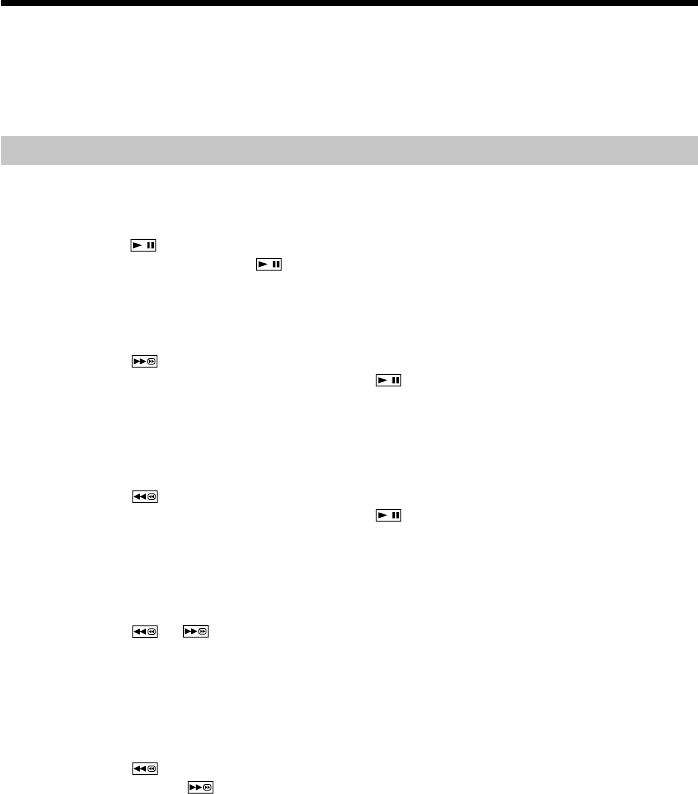
42
Playing back a tape
Remaining battery time indicator during playback
The indicator shows the approximate continuous playback time. The indicator may not
be correct, depending on the conditions in which you are playing back. When you close
the LCD panel and open it again, it takes about 1 minute to display the correct
remaining battery time.
Various playback modes
To operate the video control buttons, set the POWER switch to VCR.
To view a still image (playback pause)
•Select , then press the center z on the control button during playback. To resume
normal playback, select , then press the center z on the control button again.
•Press PAUSE on the Remote Commander during playback. To resume normal
playback, press PAUSE again.
To advance the tape
•Select , then press the center z on the control button when the tape is not played
back. To resume normal playback, select , then press the center z on the control
button.
•Press FF on the Remote Commander when the tape is not played back. To resume
normal playback, press PLAY.
To rewind the tape
•Select , then press the center z on the control button when the tape is not played
back. To resume normal playback, select , then press the center z on the control
button.
•Press REW on the Remote Commander when the tape is not played back. To resume
normal playback, press PLAY.
To locate a scene monitoring the picture (picture search)
•Select or , then keep pressing the center z on the control button during
playback. To resume normal playback, release the button.
•Keep pressing REW or FF on the Remote Commander during playback. To resume
normal playback, release the button.
To monitor the high-speed picture while advancing or
rewinding the tape (skip scan)
•Select , then keep pressing the center z on the control button while rewinding the
tape, or select , then keep pressing z while advancing the tape. To resume
rewinding or advancing, release the button.
•Keep pressing REW on the Remote Commander while rewinding the tape, or keep
pressing FF on the Remote Commander while advancing the tape. To resume
rewinding or advancing, release the button.
To view the picture at slow speed (slow playback)
Press SLOW on the Remote Commander during playback. To pause playback, press
PAUSE on the Remote Commander. To resume normal playback, press PLAY on the
Remote Commander.
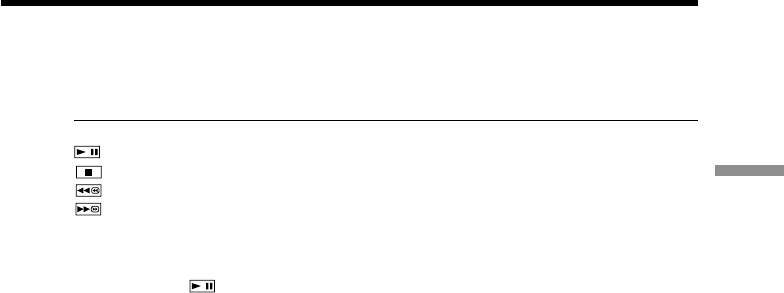
43
Playback – Basics
Playing back a tape
To search the last scene recorded (END SEARCH)
Select END SCH on the PAGE2 screen through the FN screen, then press the center z
on the control button when the tape is not played back. The camcorder plays back the
last 5 seconds of the recorded section, then stops the playback.
Video control buttons of the camcorder
To play back or pause a tape
To stop a tape
To rewind a tape
To fastforward a tape
When the playback pause mode lasts for 5 minutes
The playback pause will be released, then the camcorder stops the playback. To resume
playback, select , then press the center z on the control button or press PLAY on the
Remote Commander.
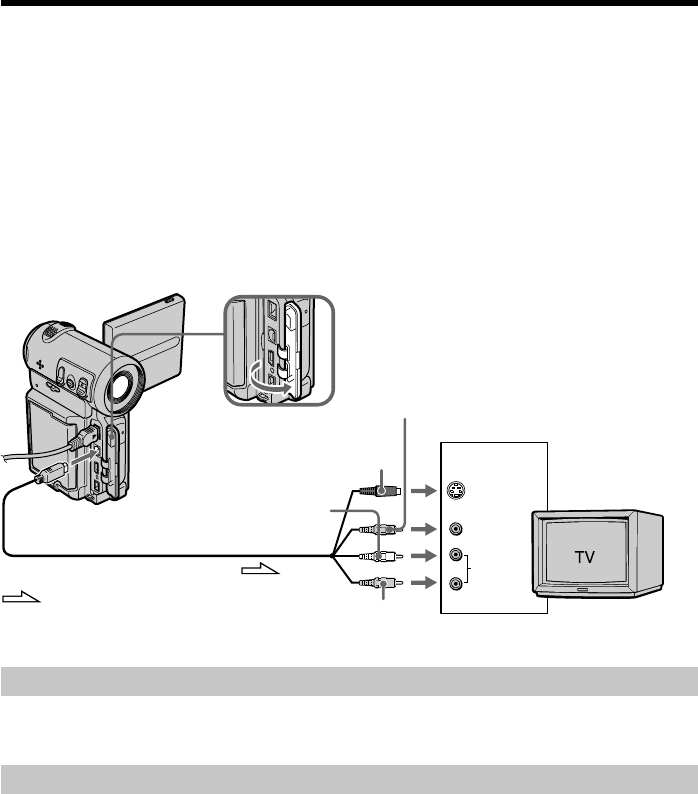
44
S VIDEO
VIDEO
AUDIO
IN
Yellow
Red
White
: Signal flow
Viewing the recording on the TV screen
– using the A/V connecting cable
Connect your camcorder to your TV with the A/V connecting cable supplied with your
camcorder to watch the playback picture on the TV screen. You can operate the video
control buttons in the same way as when you monitor playback pictures on the
camcorder screen. When monitoring the playback picture on the TV screen, we
recommend that you power your camcorder from a wall outlet using the AC power
adaptor (p. 16). Also, refer to the operating instructions of your TV.
Open the jack cover. Connect your camcorder to the TV using the A/V connecting
cable. Then, set the TV/VCR selector on the TV to VCR.
The supplied A/V connecting cable is equipped with the S video plug and the video
plug. Use either the S video plug or the video plug depending on the TV. Do not
connect both of the plugs to the TV.
If your TV is already connected to a VCR
Connect your camcorder to the LINE IN input on the VCR using the A/V connecting
cable supplied with your camcorder. Set the input selector on the VCR to LINE.
If your TV or VCR is a monaural type
Connect either the yellow or the black plug of the A/V connecting cable to the video or
S video input jack and the white or red plug to the audio input jack on the VCR or the
TV. If you connect the white plug, the sound is L (left) signal. If you connect the red
plug, the sound is R (right) signal.
Black
A/V
S VIDEO or VIDEO

45
Playback – Basics
Viewing the recording on the TV screen – using the A/V connecting
cable
If your TV has an S video jack
Connect using the S video plug to faithfully obtain original pictures. With this
connection, you do not need to connect the yellow (video) plug of the A/V connecting
cable. Connect the S video plug to the S video jack on the TV or VCR. This connection
produces higher quality MICROMV format pictures.
To display the screen indicators on the TV screen
Set DISPLAY through to V-OUT/LCD in the menu settings (p. 105), then press
DISPLAY. To turn off the screen indicators, press DISPLAY again.
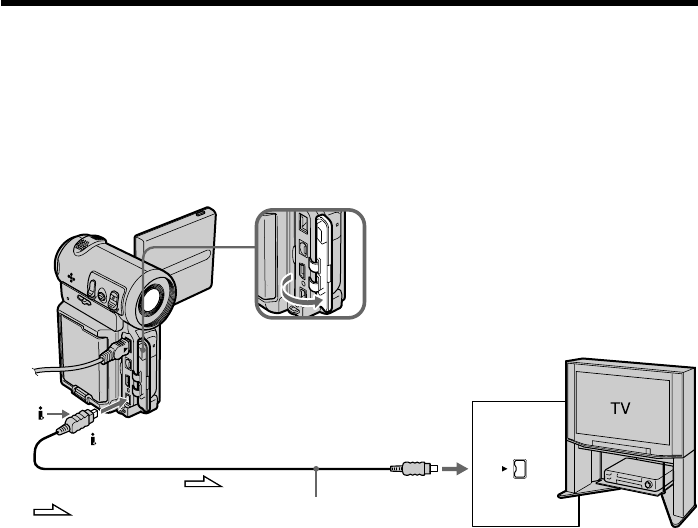
46
Viewing the recording on the TV
– using the i.LINK cable
The i.LINK (MICROMV) jack is equipped with the camcorder. Using the supplied
i.LINK cable, you can view a recorded picture on the TV connected with the camcorder.
The available TVs that can be connected using the i.LINK cable are as follows: KD-
28HD750, KD-32HD750, KD-36HD750, etc. These models are for future available
products in autumn in 2001.
IN
: Signal flow
MICROMV
(supplied)
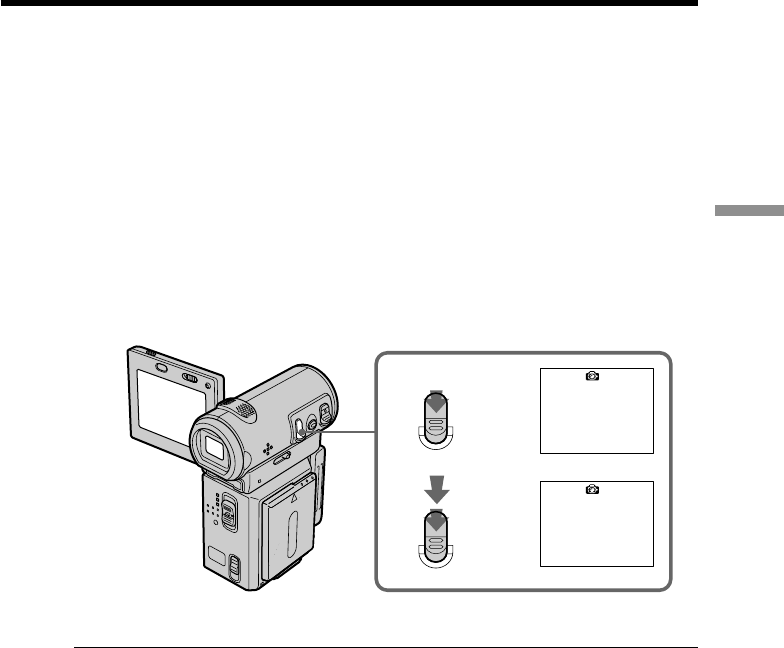
47
Advanced Recording Operations
— Advanced Recording Operations —
Recording a still image on a tape – Tape Photo recording
You can record a still image onto a tape. This mode is useful when you want to print a
image using a video printer (optional). You can record about 510 images on a 60-minute
cassette.
Besides the operation described here, your camcorder can record still images on a
“Memory Stick” (DCR-IP7/IP7BT only) (p. 122).
(1)In standby mode, keep pressing PHOTO lightly until a still image appears. The
CAPTURE indicator appears. Recording does not start yet.
To change the still image, release PHOTO, select a still image again, and then
press and hold PHOTO lightly.
(2)Press PHOTO deeper.
The still image on the screen is recorded for about 7 seconds. The sound
during those 7 seconds is also recorded.
The still image is displayed on the screen until the recording is completed.
Notes
•You cannot make a tape photo recording during normal CAMERA recording.
•During tape photo recording, you cannot change the mode or setting.
•When recording a still image, do not shake your camcorder. The image may fluctuate.
•The tape photo recording function does not work during following operations:
–Fader
–Digital effect
If you record a moving subject with the tape photo recording function
When you play back the still image using other equipment, the image may fluctuate.
To use the tape photo recording function using the Remote Commander
Press PHOTO on the Remote Commander. Your camcorder immediately records an
image on the screen.
To record clear and less fluctuated still images (DCR-IP7/IP7BT only)
We recommend that you record on a “Memory Stick.”
1
•••••••
2
CAPTURE
PHOTO
PHOTO
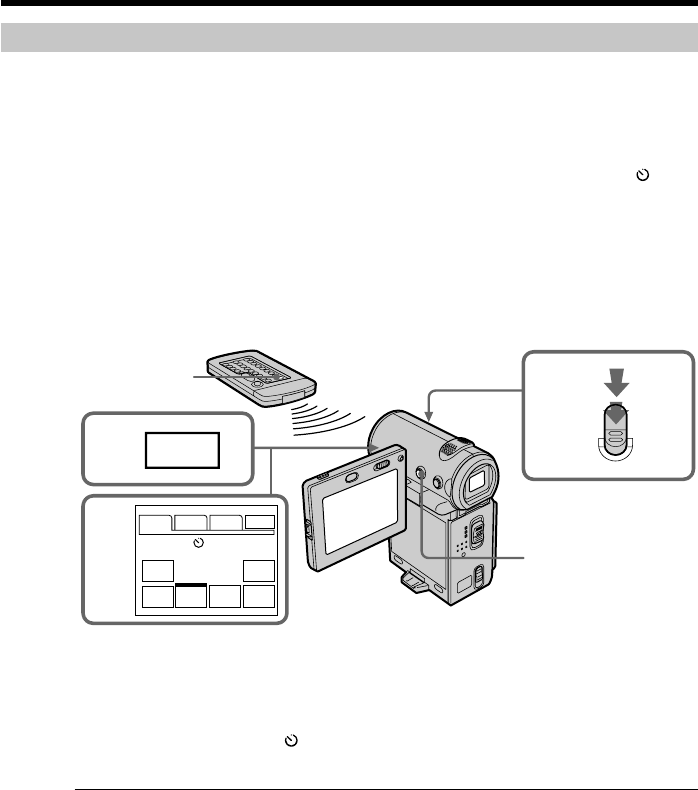
48
Self-timer recording
You can make a tape photo recording with the self-timer. You can also use the Remote
Commander for this operation.
(1)In standby mode, select FN, then press the center z on the control button. The
PAGE1 screen appears.
(2)Select SELF TIMER, then press the center z on the control button. The (self-
timer) indicator appears on the screen.
(3)Press DISPLAY to turn off the screen buttons.
(4)Press PHOTO firmly.
Self-timer starts counting down from 10 with a beep sound. In the last 2
seconds of the countdown, the beep sound gets faster, then the recording starts
automatically.
To cancel the self-timer recording
Select SELF TIMER on the PAGE1 screen again, then press the center z on the control
button in standby mode. The (self-timer) indicator disappears from the screen. You
cannot cancel the self-timer recording using the Remote Commander.
Note
The self-timer recording mode is automatically canceled when:
–The self-timer recording is finished.
–The POWER switch is set to OFF (CHG) or VCR.
1
2
4
3
FN
PHOTO
PAGE1 PAGE2 PAGE3
EXIT
MENU FOCUS
FADER SELF
TIMER MEM
MIX EXPO–
SURE
Recording a still image on a tape – Tape Photo recording
PHOTO
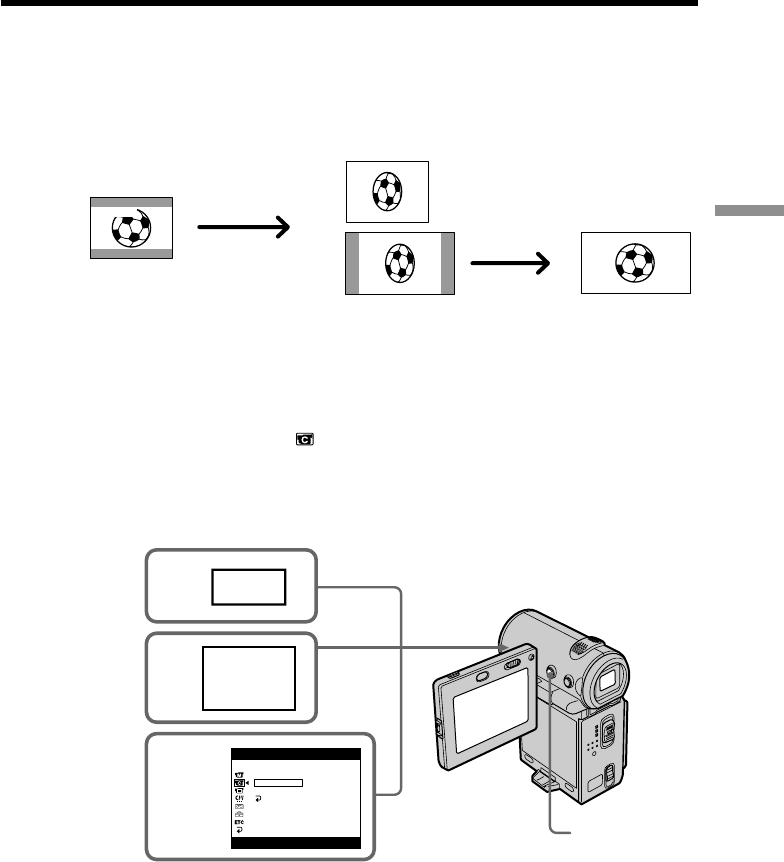
49
Advanced Recording Operations
Using the wide mode
You can record a 16:9 wide picture to watch on the 16:9 wide-screen TV (16:9WIDE).
Black bands appear on the screen during recording in 16:9WIDE mode [a]. The picture
during playing back on a normal TV [b] or a wide -screen TV [c] are compressed in the
widthwise direction. If you set the screen mode of the wide-screen TV to the full mode,
you can watch pictures of normal images [d].
(1)In standby mode, select FN, then press the center z on the control button. The
PAGE1 screen appears.
(2)Select MENU, then press the center z on the control button. The menu
appears.
(3)Select 16:9WIDE through , then press the center z or B on the control
button.
(4)Select ON, then press the center z on the control button.
(5)Press DISPLAY to turn off the menu.
To cancel the wide mode
Set 16:9WIDE to OFF in the menu settings.
[a]
[c]
[b]
[d]
16:9
WIDE
1FN
2
3,4
5
MENU
CAMERA SET
D ZOOM
16:9 WIDE
STEADY SHOT
RETURN
ON

50
To return to the FN screen
Select RETURN, , then press the center z on the control button. The PAGE1
screen appears. Next, select EXIT, then press the center z on the control button.
In wide mode, you cannot select the following functions:
–Old movie
–Bounce
During recording
You cannot select or cancel the wide mode. When you cancel the wide mode, set your
camcorder to the standby mode and then set 16:9WIDE to OFF in the menu settings.
Connection for a TV
Pictures recorded in 16:9WIDE mode automatically appear on the TV screen at full size
when:
–You connect your camcorder to a TV that is compatible with the video ID (ID-1/ID-2)
system.
–You connect your camcorder to the S video jack on the TV.
ID-1 system
The ID-1 system sends aspect ratio information (16:9, 4:3, or letter box) with video
signals. If you connect a TV compatible with the ID-1 system, the screen size is
automatically selected.
ID-2 system
The ID-2 system sends a copyright protection signal with ID-1 signals inserted between
video signals when you connect your camcorder to other equipment using the A/V
connecting cable.
Using the wide mode
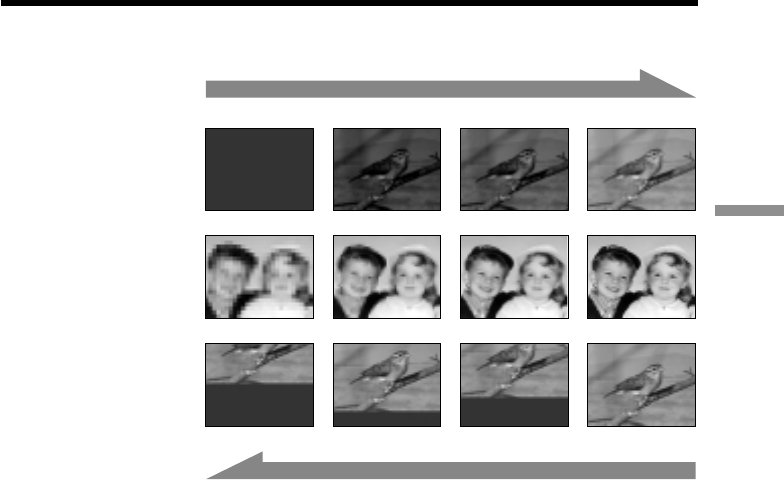
51
Advanced Recording Operations
[a]
RECSTBY
RECSTBY
[b]
You can fade in or out to give your recording a professional appearance.
MONOTONE
When fading in, the picture gradually changes from black-and-white to color.
When fading out, the picture gradually changes from color to black-and-white.
1) You can use the bounce function when D ZOOM is set to OFF in the menu settings.
2) Fade in only.
NORM. FADER
(fader)
MOSC. FADER
(mosaic)
Using the fader function
BOUNCE1) 2)
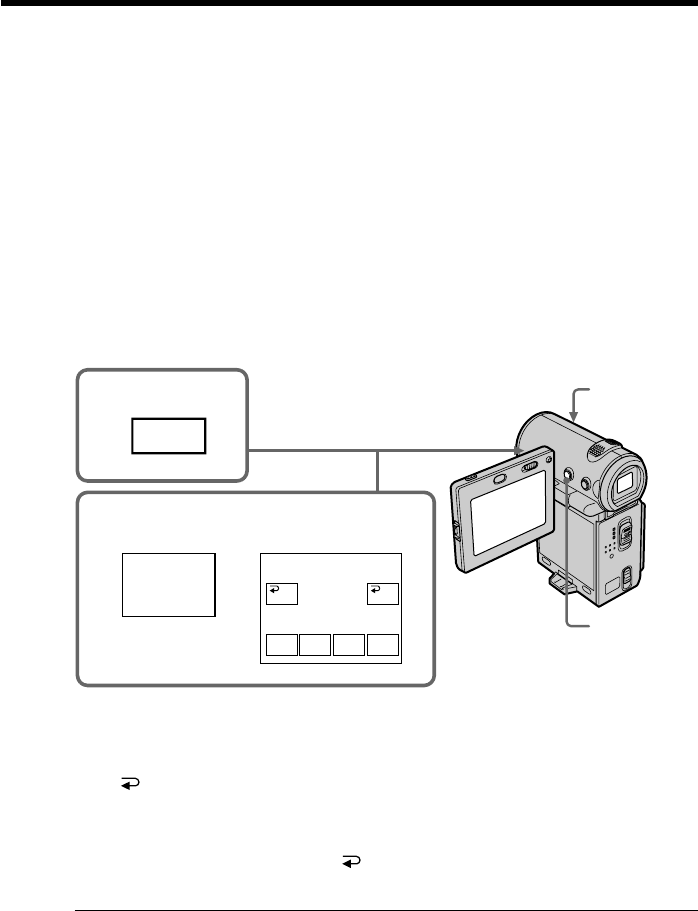
52
Using the fader function
(1) When fading in [a]
In standby mode, select FN, then press the center z on the control button. The
PAGE1 screen appears.
When fading out [b]
During recording, select FN, then press the center z on the control button. The
PAGE1 screen appears.
(2)Select FADER, then press the center z on the control button. The FADER
screen for selecting the fader mode appears.
(3)Select the desired fader mode, then press the center z on the control button.
The top of the selected button is indicated with the green bar.
(4)Press DISPLAY to turn off the screen buttons.
(5)Press START/STOP. The fader indicator flashes, then lights up. After the fade
in/out is carried out, your camcorder automatically returns to the normal
mode.
To return to the FN screen
Select OK, then press the center z on the control button after step 3. The PAGE1
screen appears. Next, select EXIT, then press the center z on the control button.
To cancel the fader function
Before pressing START/STOP, select OFF, then press the center z on the control
button.
Note
You cannot use the following functions while using the fader function, and vice versa.
–Digital effect
–Tape Photo recording
1
4
FN
FADER
OFF OK
NORM.
FADER MONO–
TONE
BOUN–
CE
MOSC.
FADER
2,3
FADER
5

53
Advanced Recording Operations
While using the bounce mode, you cannot use the following functions:
–Exposure
–Focus
–Zoom
–Picture effect
Note on the bounce mode
You cannot select the bounce mode in the following mode or functions:
–D ZOOM is set to 20× or 120× in the menu settings
–Wide mode
–Picture effect
–PROGRAM AE
When the POWER switch is set to MEMORY (DCR-IP7/IP7BT only)
You cannot use the fader function.
Using the fader function
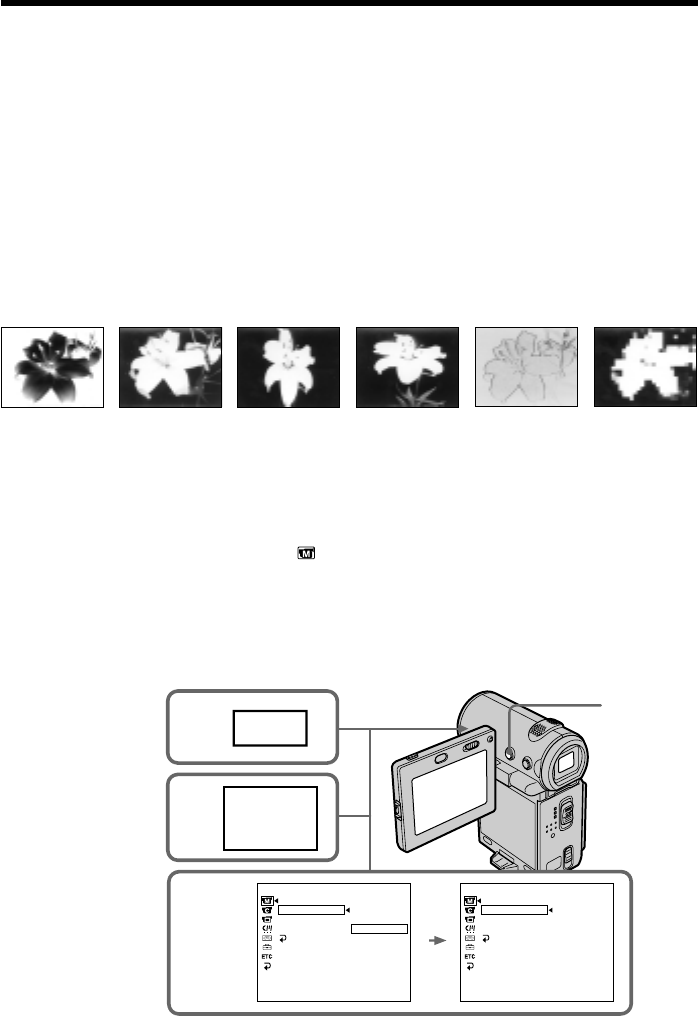
54
Using special effects – Picture effect
You can digitally process images to obtain special effects like those in films or on the
TV.
NEG. ART [a] : The color and brightness of the picture are reversed.
SEPIA : The picture is sepia.
B&W : The picture is monochrome (black-and-white).
SOLARIZE [b] : The light intensity is clearer, and the picture looks like an illustration.
SLIM [c] : The picture expands vertically.
STRETCH [d] : The picture expands horizontally.
PASTEL [e] : The contrast of the picture is emphasized, and the picture looks like an
animated cartoon.
MOSAIC [f] : The picture is mosaic.
(1)In CAMERA mode, select FN, then press the center z on the control button.
The PAGE1 screen appears.
(2)Select MENU, then press the center z on the control button. The menu
appears.
(3)Select P EFFECT through , then press the center z or B on the control
button.
(4)Select the desired picture effect mode, then press the center z on the control
button.
(5)Press DISPLAY to turn off the menu.
[a] [b] [c] [d] [e] [f]
3,4
MANUAL SET
PROGRAM AE
P EFFECT
WHT BAL
AUTO SHTR
RETURN
OFF
NEG. ART
SEPIA
B&W
SOLARIZE
SLIM
STRETCH
PASTEL
MOSAIC
15
FN
2
MENU
MANUAL SET
PROGRAM AE
P EFFECT
WHT BAL
AUTO SHTR
RETURN
NEG. ART

55
Advanced Recording Operations
To return to the FN screen
Select RETURN, , then press the center z on the control button after step 4. The
PAGE1 screen appears. Next, select EXIT, then press the center z on the control button.
To turn the picture effect function off
Set P EFFECT to OFF in the menu settings.
While using the picture effect function
You cannot select the old movie mode with the digital effect function.
When you set the POWER switch to OFF (CHG)
The picture effect will be automatically canceled.
Using special effects – Picture effect
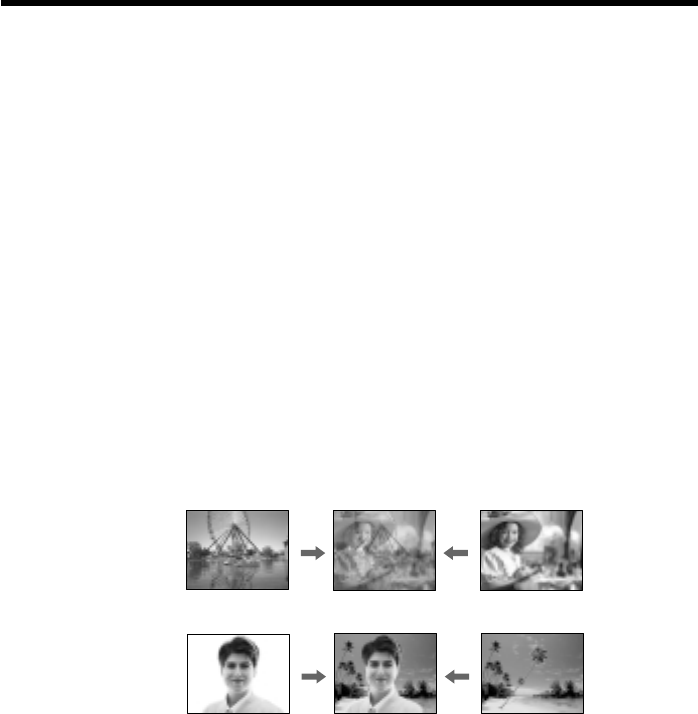
56
STILL
LUMI.
Still image Moving picture
Still image Moving picture
Using special effects – Digital effect
You can add special effects to recorded pictures using the various digital functions. The
sound is recorded normally.
STILL
You can record a still image so that it is superimposed on a moving picture.
FLASH (FLASH MOTION)
You can record still image successively at constant intervals.
LUMI. (LUMINANCEKEY)
You can swap a brighter area in a still image with a moving picture.
TRAIL
You can record a picture so that an incidental image like a trail is left.
SLOW SHTR (SLOW SHUTTER)
You can slow down the shutter speed. The slow shutter mode is good for recording
dark pictures more brightly.
OLD MOVIE
You can add an old movie type atmosphere to pictures. Your camcorder automatically
sets the wide mode to ON, picture effect to SEPIA, and the appropriate shutter speed.
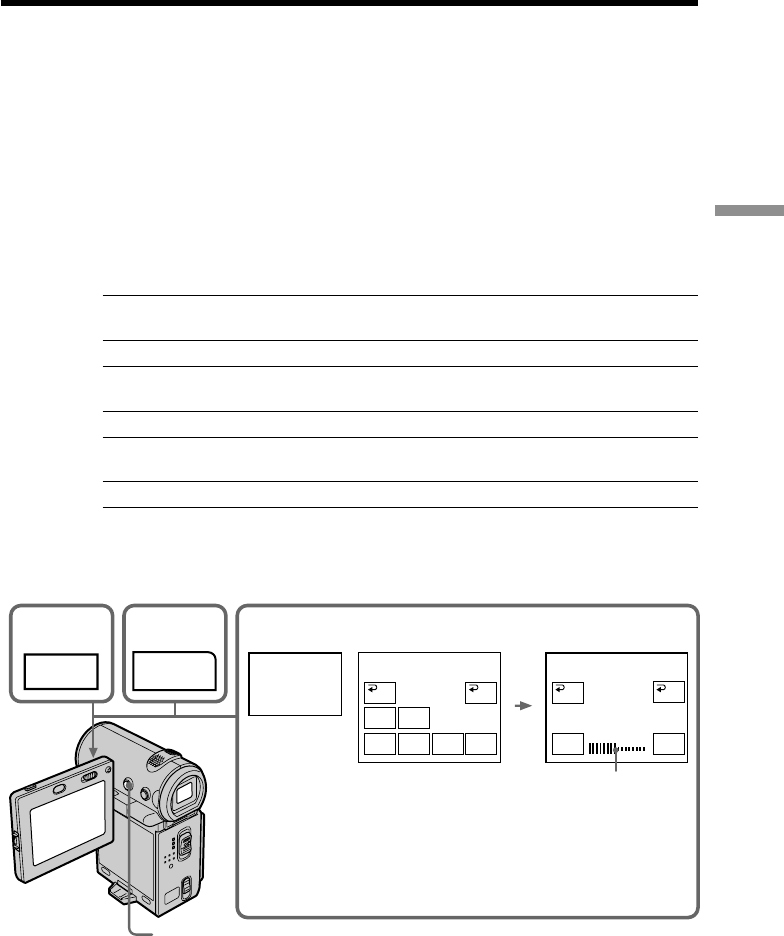
57
Advanced Recording Operations
3–5
LUMI.
–+
OK
OFF
DIG
EFFT
DIG EFFT DIG EFFT
STILL
SLOW
SHTR OLD
MOVIE
OFF OK
LUMI.FLASH TRAIL
1
FN
2
6
PAGE3
Using special effects – Digital effect
The bar appears when selecting the
STILL, FLASH, LUMI., or TRAIL mode.
(1)In CAMERA mode, select FN, then press the center z on the control button.
The PAGE1 screen appears.
(2)Select PAGE3, then press the center z on the control button. The PAGE3
screen appears.
(3)Select DIG EFFT, then press the center z on the control button. The DIG EFFT
screen for selecting the desired digital effect mode appears.
(4)Select the desired digital effect mode, then press the center z on the control
button. In STILL and LUMI. modes, the still image is stored in memory.
(5)Select –/+, then press the center z on the control button repeatedly to adjust
the effect. You can also adjust the effect by pressing b/B repeatedly after you
select –/+.
Items to be adjusted
STILL The rate of the still image you want to superimpose on the moving
picture
FLASH The interval of flash motion
LUMI. The color scheme of the area in the still image which is to be swapped
with a moving picture
TRAIL The vanishing time of the incidental image
SLOW SHTR Shutter speed. The larger the shutter speed number, the slower the
shutter speed.
OLD MOVIE No adjustment necessary
(6)Press DISPLAY to turn off the screen buttons.
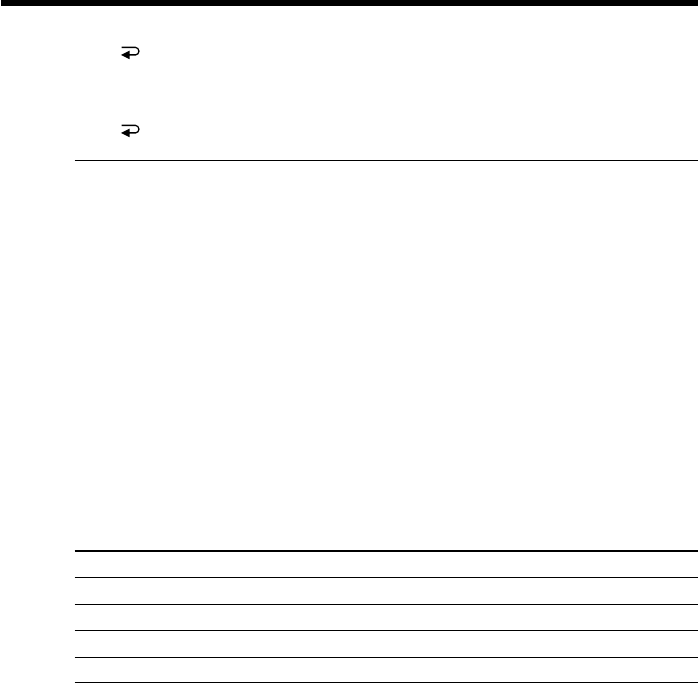
58
Using special effects – Digital effect
To return to the FN screen
Select OK, then press the center z on the control button after step 5. The PAGE3
screen appears. Next, select EXIT, then press the center z on the control button.
To cancel the digital effect
Select OFF, then press the center z on the control button in step 3.
Notes
•The following functions do not work during digital effect:
–Fader
–Low lux mode of PROGRAM AE (The indicator flashes)
•The PROGRAM AE function does not work in slow shutter mode.
•The following functions do not work in old movie mode:
–Wide mode
–Picture effect
–PROGRAM AE
When recording in slow shutter or old movie mode
The SteadyShot function does not work.
When you set the POWER switch to OFF (CHG)
The digital effect will be automatically canceled.
When recording in slow shutter mode
Auto focus may not be effective. Focus manually using a tripod.
Shutter speed
Shutter speed number Shutter speed
SLOW SHTR 1 1/30
SLOW SHTR 2 1/15
SLOW SHTR 3 1/8
SLOW SHTR 4 1/4
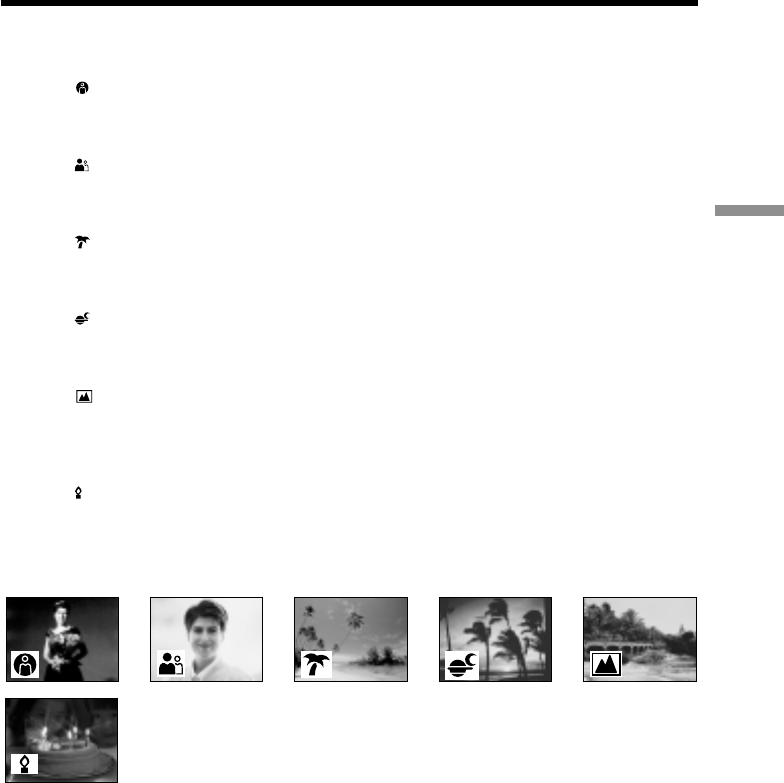
59
Advanced Recording Operations
Using the PROGRAM AE function
You can use the PROGRAM AE (Auto Exposure) function to suit your specific shooting
requirements.
Spotlight
This mode prevents people’s faces, for example, from appearing excessively white
when shooting subjects lit by strong light in a theater.
Soft portrait
This mode brings out the subject while creating a soft background for subjects such as
people or flowers.
Beach & ski
This mode prevents people’s faces from appearing dark in strong light or reflected light,
such as at a beach in midsummer or on a ski slope.
Sunset & moon
This mode allows you to maintain atmosphere when you are recording sunsets, general
night views, and neon signs.
Landscape
This mode is for when you are recording distant subjects such as mountains and
prevents your camcorder from focusing on glass or metal mesh in windows when you
are recording a subject behind glass or a screen.
Low lux
This mode makes subjects brighter in insufficient light.
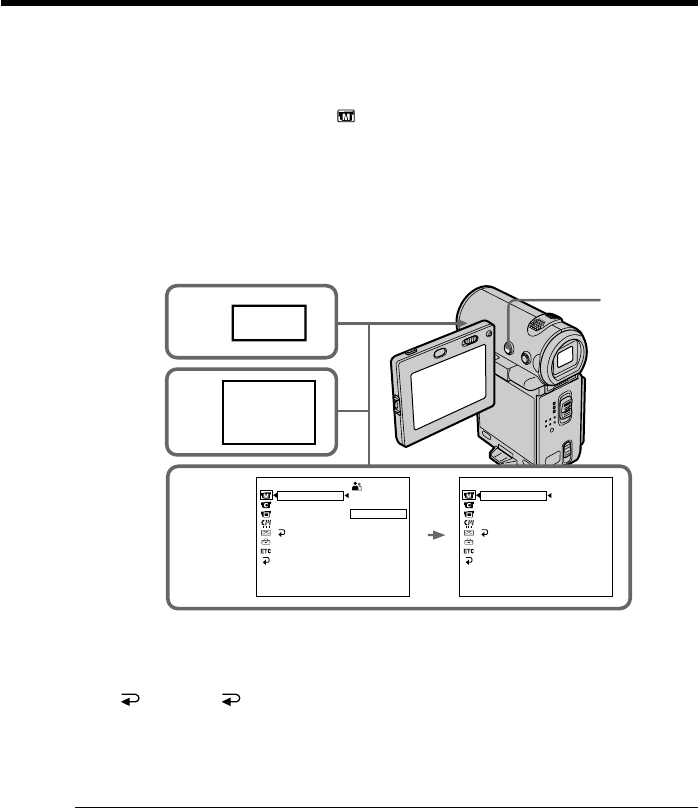
60
Using the PROGRAM AE function
(1)In standby or MEMORY (DCR-IP7/IP7BT only) mode, select FN, then press
the center z on the control button. The PAGE1 screen appears.
(2)Select MENU, then press the center z on the control button. The menu
appears.
(3)Select PROGRAM AE through , then press the center z or B on the control
button.
(4)Select a desired PROGRAM AE mode, then press the center z on the control
button.
(5)Press DISPLAY to turn off the menu. The PROGRAM AE mode indicator
appears at the lower-left corner on the screen.
To return to the FN screen
Select RETURN, , then press the center z on the control button after step 4. The
PAGE1 screen appears. Next, select EXIT, then press the center z on the control button.
To turn the PROGRAM AE function off
Set PROGRAM AE to AUTO in the menu settings in step 4.
Notes
•Because your camcorder is set to focus only on subjects in the middle to far distance,
you cannot take close-ups in the following modes:
–Spotlight
–Beach & ski
•Your camcorder is set to focus only on distant subjects in the following modes:
–Sunset & moon
–Landscape
3,4
1FN
2
MENU
MANUAL SET
PROGRAM AE
P EFFECT
WHT BAL
AUTO SHTR
RETURN
AUTO
SPOTLIGHT
PORTRAIT
BEACH&SKI
SUNSETMOON
LANDSCAPE
LOW LUX
MANUAL SET
PROGRAM AE
P EFFECT
WHT BAL
AUTO SHTR
RETURN
SPOTLIGHT
5

61
Advanced Recording Operations
Using the PROGRAM AE function
•The following functions do not work in PROGRAM AE mode:
–Slow shutter
–Old movie
–Bounce
•The digital effect function does not work in low lux mode:
•While shooting in MEMORY mode, the low lux mode does not work .(The indicator
flashes.) (DCR-IP7/IP7BT only)
•The SteadyShot function does not work in low lux mode.
When WHT BAL is set to AUTO in the menu settings
The white balance is adjusted even if the PROGRAM AE function is selected.
If you are recording under a discharge tube such as a fluorescent lamp, sodium
lamp or mercury lamp
Flickering or changes in color may occur in soft portrait mode. If this happens, turn the
PROGRAM AE function off.
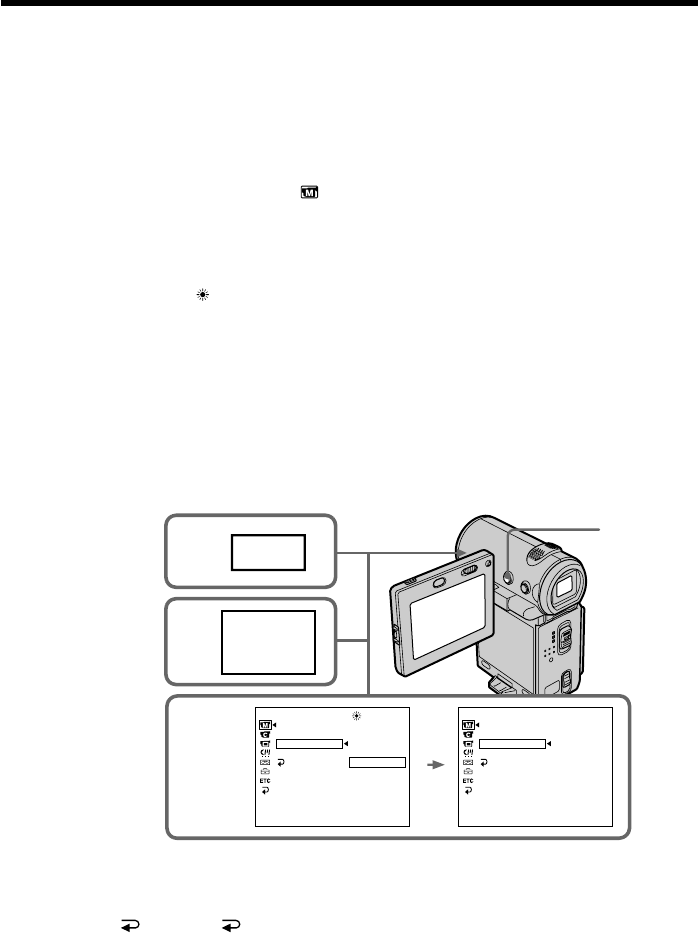
62
Adjusting the white balance manually
You can manually adjust and set the white balance. This adjustment makes white
subjects look white and allows more natural color balance. Normally white balance is
automatically adjusted.
(1)In CAMERA or MEMORY (DCR-IP7/IP7BT only) mode, select FN, then press
the center z on the control button. The PAGE1 screen appears.
(2)Select MENU, then press the center z on the control button. The menu
appears.
(3)Select WHT BAL through , then press the center z or B on the control
button.
(4)Select the desired white balance mode, then press the center z on the control
button.
HOLD (HOLD) : Recording a single-colored subject or background
OUTDOOR ( ) :
•Recording a sunset/sunrise, just after sunset, just before sunrise, neon signs, or
fireworks
•Under a color matching fluorescent lamp
INDOOR (n) :
•When lighting condition changes quickly
•In too bright places such as photography studios
•Under sodium lamps or mercury lamps
(5)Press DISPLAY to turn off the menu.
To return to the FN screen
Select RETURN, , then press the center z on the control button after step 4. The
PAGE1 screen appears. Next, select EXIT, then press the center z on the control button.
3,4
1FN
2
MENU
MANUAL SET
PROGRAM AE
P EFFECT
WHT BAL
AUTO SHTR
RETURN
AUTO
HOLD
OUTDOOR
INDOOR
MANUAL SET
PROGRAM AE
P EFFECT
WHT BAL
AUTO SHTR
RETURN
HOLD
5

63
Advanced Recording Operations
Adjusting the white balance manually
To return to the automatic white balance mode
Set WHT BAL to AUTO in the menu settings (p. 105).
If the picture is being taken in a studio lit by TV lighting
We recommend that you use the n indoor mode.
When you record under fluorescent lighting
Use the automatic white balance or hold mode.
Your camcorder may not adjust the white balance correctly in n indoor mode.
In automatic white balance mode
Point your camcorder at the white subject for about 10 seconds after setting the POWER
switch to CAMERA to get better adjustment when:
–You detach the battery for replacement.
–You bring your camcorder from the interior of a house holding the exposure, and vice
versa.
In hold white balance mode
Set the white balance to AUTO and reset to HOLD after few seconds when:
–You change the PROGRAM AE mode.
–You bring your camcorder from the interior of a house, and vice versa.
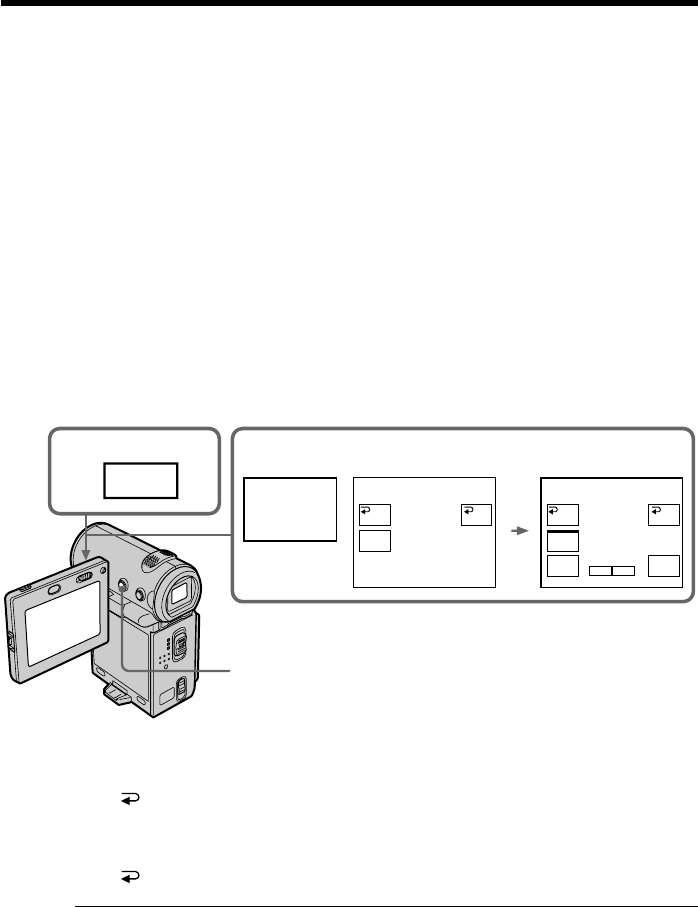
64
Adjusting the exposure manually
You can adjust and set the exposure. Normally exposure is automatically adjusted.
Adjust the exposure manually in the following cases:
–To make a fine exposure adjustment
–To shoot the bright subject and dark background
–To record dark pictures (e.g. night scenes) faithfully
(1)In CAMERA or MEMORY mode, select FN, then press the center z on the
control button. The PAGE1 screen appears.
(2)Select EXPOSURE, then press the center z on the control button. The
EXPOSURE screen for adjusting the exposure appears.
(3)Select MANUAL, then press the center z on the control button.
(4)Select –/+, then press the center z on the control button repeatedly to adjust
the exposure.
–: to dim
+ : to brighten
You can also adjust the exposure by pressing b/B repeatedly after you select
–/+.
(5)Press DISPLAY to turn off the screen buttons.
To return to the FN screen
Select OK, then press the center z on the control button after step 4. The PAGE1
screen appears. Next, select EXIT, then press the center z on the control button.
To return to the automatic exposure mode
Select AUTO, then press the center z on the control button in step 4.
Note
When you adjust the exposure manually, the backlight function does not work.
Your camcorder automatically returns to the automatic exposure mode:
–If you change the PROGRAM AE mode.
1
5
2–4
FN
EXPO–
SURE
MANU–
AL
AUTO AUTO
EXPOSURE
OK
–+
MANU–
AL
EXPOSURE
–+
OK
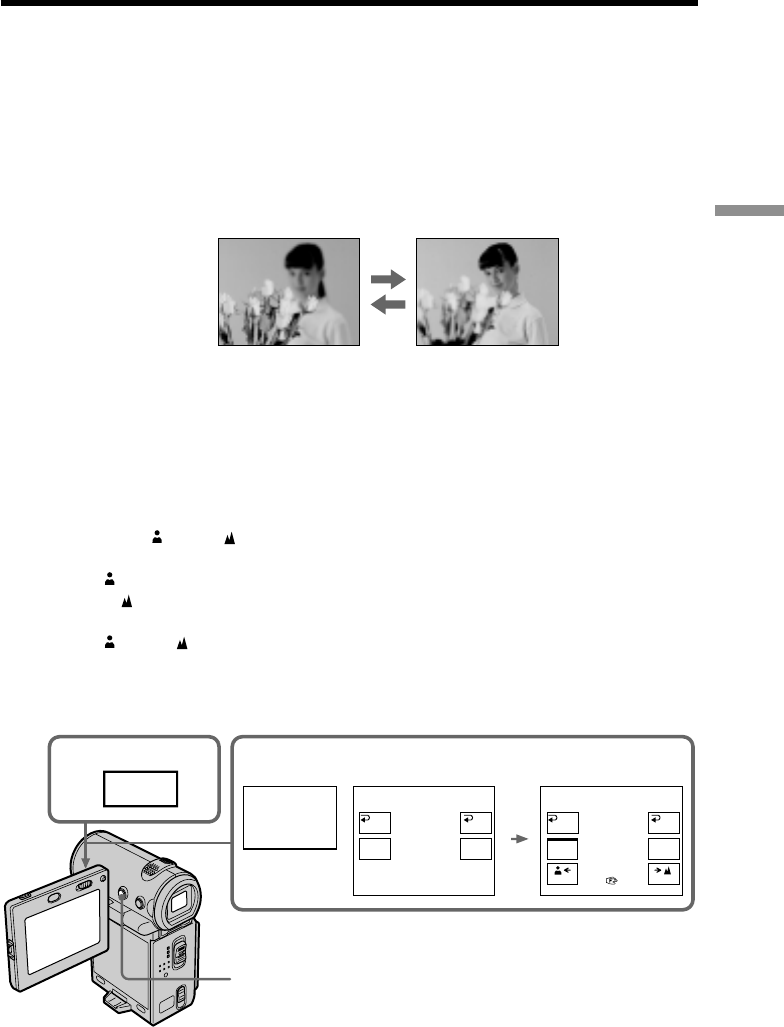
65
Advanced Recording Operations
12–4
FN
FOCUS
MANU–
AL INFI–
NITY
AUTO AUTO
OK
MANU–
AL
OK
FOCUS
INFI–
NITY
FOCUS
5
Focusing manually
You can gain better results by manually adjusting the focus in the following cases.
Normally, focus is automatically adjusted.
•The autofocus mode is not effective when shooting
–subjects through glass coated with water droplets
–horizontal stripes
–subjects with little contrast with backgrounds such as walls and sky
•When you want to change the focus point from a subject in the foreground to a subject
in the background
•Shooting a stationary subject when using a tripod
(1)In CAMERA or MEMORY (DCR-IP7/IP7BT only) mode, select FN, then press
the center z on the control button. The PAGE1 screen appears.
(2)Select FOCUS, then press the center z on the control button. The FOCUS
screen for adjusting the focus appears.
(3)Select MANUAL, then press the center z on the control button. The top of the
selected button is indicated with the green bar and the 9 indicator appears.
(4)Select C or c , then press the center z on the control button repeatedly to
adjust the focus.
C : To move focus point closer
c : To move focus point further away
You can also adjust the focus by pressing b/B repeatedly after you select
C or c .
(5)Press DISPLAY to turn off the screen buttons.
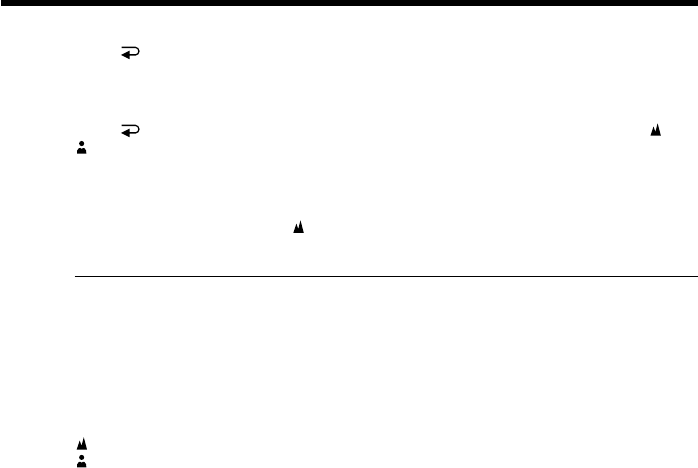
66
To return to the FN screen
Select OK, then press the center z on the control button after step 4. The PAGE1
screen appears. Next, select EXIT, then press the center z on the control button.
To return to the autofocus mode
Select AUTO, then press the center z on the control button in step 4. The 9, or
indicator is turned off, and the camcorder returns to the autofocus mode.
To record distant subjects
In step 4, select INFINITY, then press the center z on the control button. The focus is
set to infinity position and the indicator appears. Use this mode when your
camcorder focuses on near objects even though you are trying to shoot a distant object.
To focus precisely
It is easier to focus on the subject if you adjust the zoom to shoot at the “W” (wide-
angle) after focusing at the “T” (telephoto) position.
When you shoot close to the subject
Focus at the end of the “W” (wide-angle) position.
9 changes as follows:
when recording a distant subject.
when the subject is too close to focus on.
Focusing manually
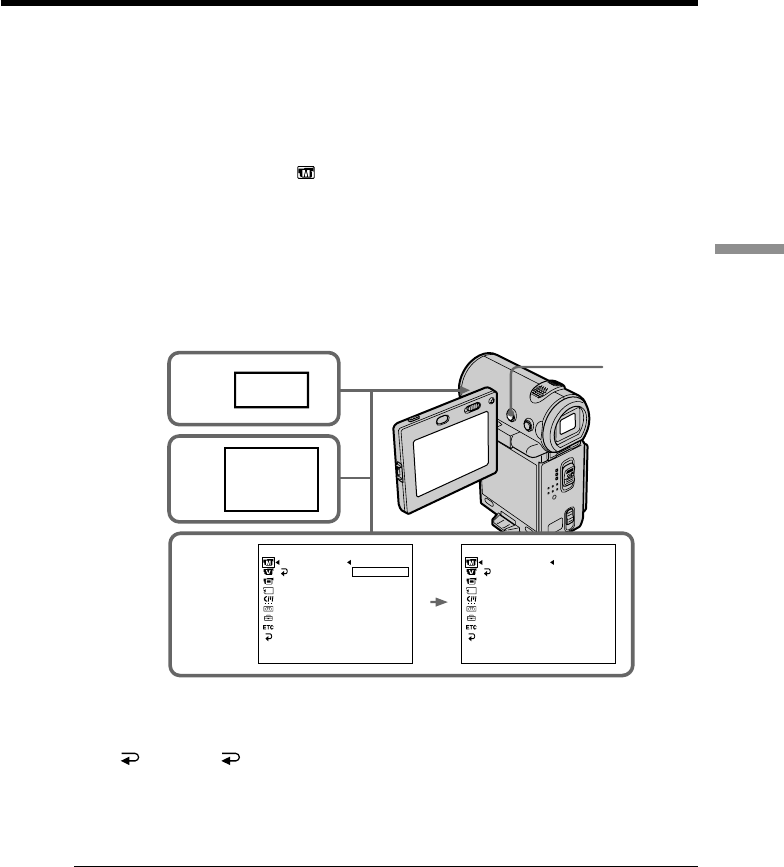
67
Advanced Playback Operations
— Advanced Playback Operations —
Playing back a tape with picture effects
During playback, you can process a scene using the picture effect function: NEG.ART,
SEPIA, B&W, and SOLARIZE.
(1)In playback or playback pause mode, select FN, then press the center z on the
control button. The PAGE1 screen appears.
(2)Select MENU, then press the center z on the control button. The menu
appears.
(3)Select P EFFECT through , then press the center z or B on the control
button.
(4)Select the desired picture effect mode, then press the center z on the control
button.
See page 48 for details on each picture effect mode.
(5)Press DISPLAY to turn off the menu. Pressing DISPLAY again displays the
video control buttons.
To return to the FN screen
Select RETURN, , then press the center z on the control button after step 4. The
PAGE1 screen appears. Next, select EXIT, then press the center z on the control button.
To cancel the picture effect function
Set P EFFECT to OFF in the menu settings in step 4.
Notes
•You cannot process externally input scenes using the picture effect function.
•You cannot record images on the tape inserted in your camcorder when you have
processed the image using the picture effect function. However, you can record
images on a “Memory Stick” (DCR-IP7/IP7BT only) (p. 126, 131), or on a VCR using
your camcorder as a player.
3,4
MANUAL SET STBY
P EFFECT
RETURN OFF
NEG. ART
SEPIA
B&W
SOLARIZE
1FN
2
MENU
MANUAL SET STBY
P EFFECT
RETURN SEPIA
5

68
Pictures processed by the picture effect function
Pictures processed by the picture effect function are not output through the i.LINK
(MICROMV) jack.
When you set the POWER switch to OFF (CHG) or stop playback
The picture effect function is automatically canceled.
Playing back a tape with picture effects
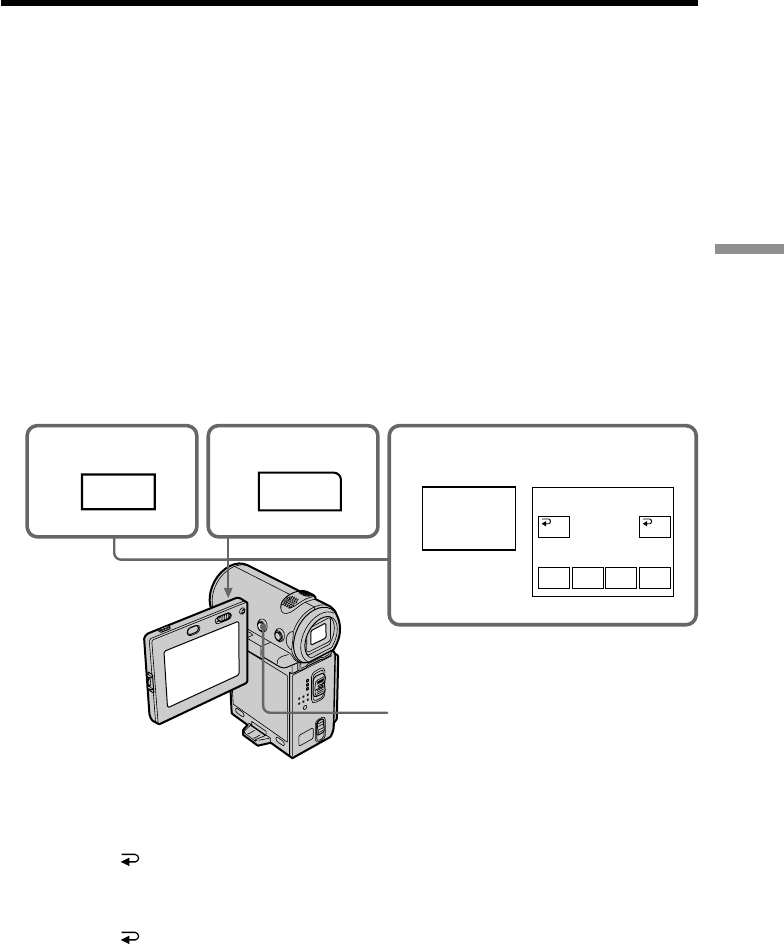
69
Advanced Playback Operations
Playing back a tape with digital effects
During playback, you can process a scene using the digital effect function: STILL,
FLASH, LUMI., and TRAIL.
(1)In playback or playback pause mode, select FN, then press the center z on the
control button. The PAGE1 screen appears.
(2)Select PAGE2, then press the center z on the control button. The PAGE2
screen appears.
(3)Select DIG EFFT, then press the center z on the control button. The DIG EFFT
screen for selecting the desired digital effect mode appears.
(4)Select the desired digital effect mode, then press the center z on the control
button.
In STILL or LUMI. mode, when the mode is selected, the picture being
displayed is stored in memory as a still image.
(5)Select –/+, then press the center z on the control button repeatedly to adjust
the effect. See page 49 for details on each digital effect mode.
(6)Press DISPLAY to turn off the screen buttons. Pressing DISPLAY again
displays the video control buttons.
To return to the FN screen
Select OK, then press the center z on the control button after step 5. The PAGE2
screen appears. Next, select EXIT, then press the center z on the control button.
To cancel the digital effect function
Select OFF, then press the center z on the control button in step 4 or 5.
2
6
3–5
1FN
DIG
EFFT
OKOFF
STILL FLASH LUMI. TRAIL
DIG EFFT
PAGE2

70
Notes
•You cannot process externally input scenes using the digital effect function.
•You cannot record images on the tape inserted in your camcorder when you have
processed the image using the digital effect function. However, you can record images
on a “Memory Stick” (DCR-IP7/IP7BT only) (p. 126, 131), or on a VCR using your
camcorder as a player.
Pictures processed by the digital effect function
Pictures processed by the digital effect function are not output through the i.LINK
(MICROMV) jack.
When you set the POWER switch to OFF (CHG) or stop playback
The digital effect function is automatically canceled.
Playing back a tape with digital effects
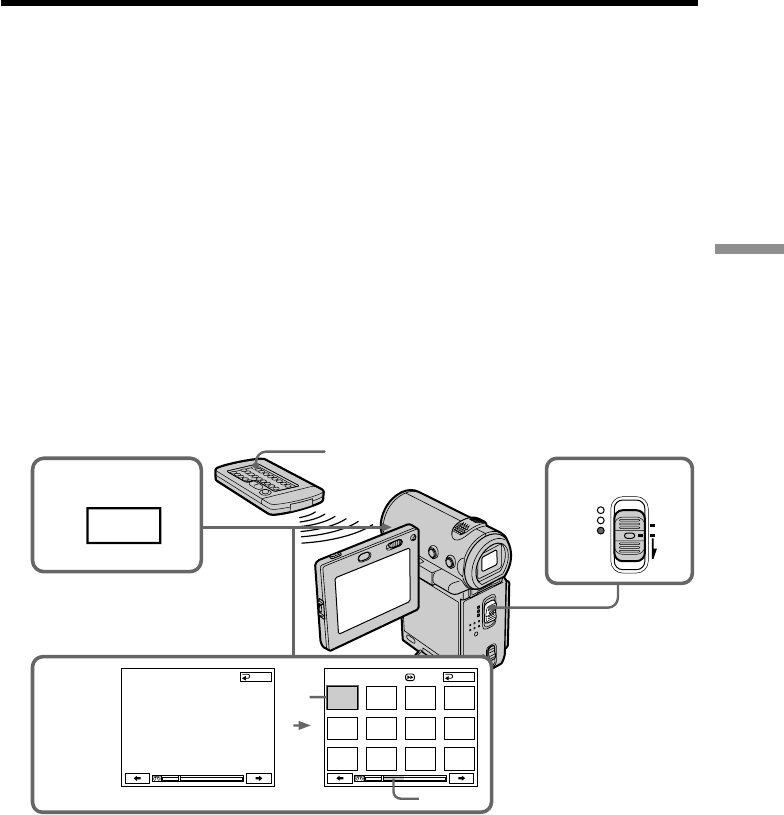
71
Advanced Playback Operations
Searching the scene – Multi-picture
search
Using the multi-picture search function, you can display the thumbnails of all the top
scenes of moving pictures and still images recorded in the tape onto the index screen.
The recording date and title of each image or scene are also indicated. Select the
thumbnail you want to play back, then press the center z on the control button, the
camcorder starts searching the image or scene and play it back automatically. You can
also control this function using the Remote Commander.
(1)Set the POWER switch to VCR.
(2)Select FN, then press the center z on the control button. The PAGE1 screen
appears.
(3)Select MULTI SRCH, then press the center z on the control button. The
MULTISRCH screen appears.
(4)Select </,, then press the center z on the control button. The camcorder
starts scanning toward the selected direction. When you select ,, the
thumbnails are displayed from the upper-left window, and when you select
<, they are displayed from the lower-right window. After the scanning is
completed, the upper-left window turns black and the thumbnails will be
displayed on the index screen.
[a]The picture being fast-forwarded or rewinded
[b]The blue portion indicates the range of a scanning to display thumbnails
1
3,4
2FN
MULTI SRCH END
SELECT
DIRECTION
MEMORY/
NETWORK
VCR
CAMERA (CHG)
POWER
OFF
ON
MODE
MULTI SRCH END
[a]
[b]
MULTI SRCH
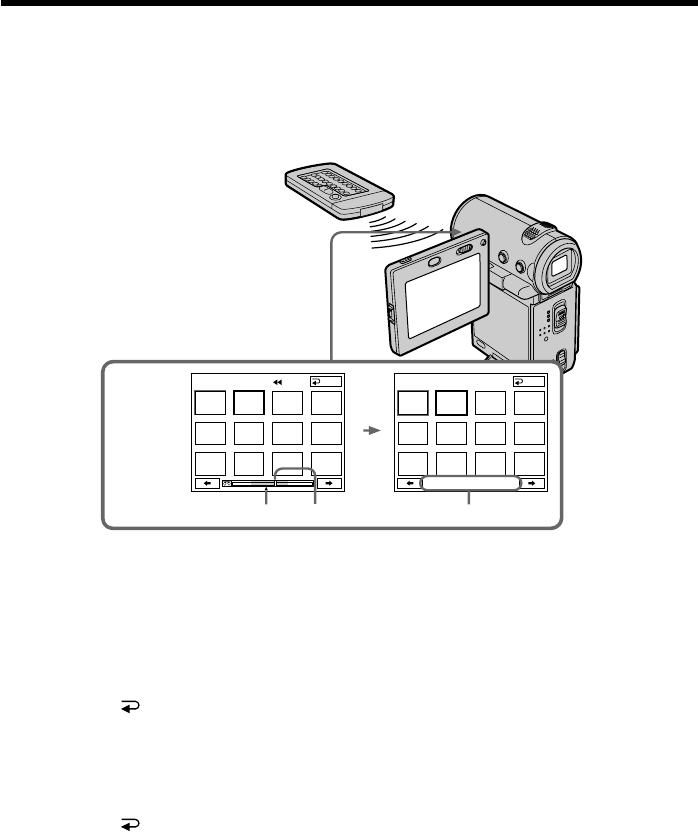
72
(5)Select the thumbnail you want to play back, then press the center z on the
control button. The camcorder starts searching the image or scene and play it
back automatically. The blue portion of the bar indicates the scanning range
and the white portion of the bar indicates the recorded portion.
[c]Actual point you are trying to search for (yellow v mark)
[d]Present point on the tape (yellow bar)
[e]Title/date (The title turns to the date indication after 5 seconds.)
To return to the MULTISRCH screen from playback
Select RETURN, then press the center z on the control button.
To stop searching
Press STOP on the Remote Commander.
To end the multi-picture search function
Select END, then press the center z on the control button.
To end the multi-picture search function from the playback
screen
Select EXIT, then press the center z on the control button.
Searching the scene – Multi-picture search
5
MULTI SRCH END MULTI SRCH
JUL 4 2001 12:05:56AM
END
[c] [d] [e]
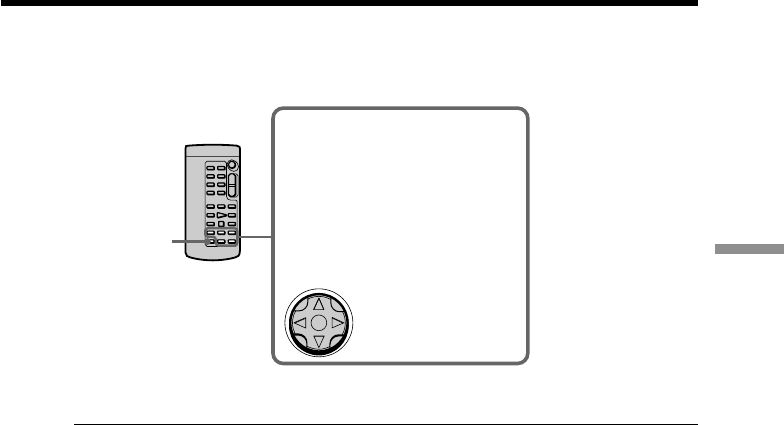
73
Advanced Playback Operations
When controlling from the Remote Commander
You can use the MULTI SRCH and X/x/C/c/DECISION buttons.
If the tape has a blank portion between recorded portions
The multi-picture search function may not work correctly.
The number of thumbnails stored in one cassette
About 400 thumbnails can be stored.
The number of thumbnails that can be searched in one scanning
This is up to 11.
When you press MULTI SRCH on the Remote Commander
The MULTISRCH screen appears.
During searching
The other functions of this camcorder do not work.
The thumbnail images displayed on the MULTISRCH screen
You cannot modify these thumbnail images.
When you use the multi-picture search function with the digital effect activated
The digital effect will be canceled.
Some of 11 thumbnails may not be displayed in the following cases:
•The recorded images and scenes are less than 11 on the searched portion.
•When scanning the tape recorded over the previous recordings.
•When you have erased all the MICRO cassette memory of the tape (p. XX).
Searching the scene – Multi-picture search
MULTI SRCH
X/x/C/c/DECISION buttons
These buttons function the
same as the control button on
the camcorder.
The control button

74
Notes
•Thumbnails may not be displayed depending on the tape condition. This is not a
malfunction.
•Noise may appear on the thumbnails. However, this have no effect on the recorded
images.
When you select < or ,, then press the center z on the control button during
scanning
The next 11 thumbnails will be scanned.
Even if a first thumbnail is not displayed before the scanning is completed
You can play back the image or scene.
Searching the scene – Multi-picture search
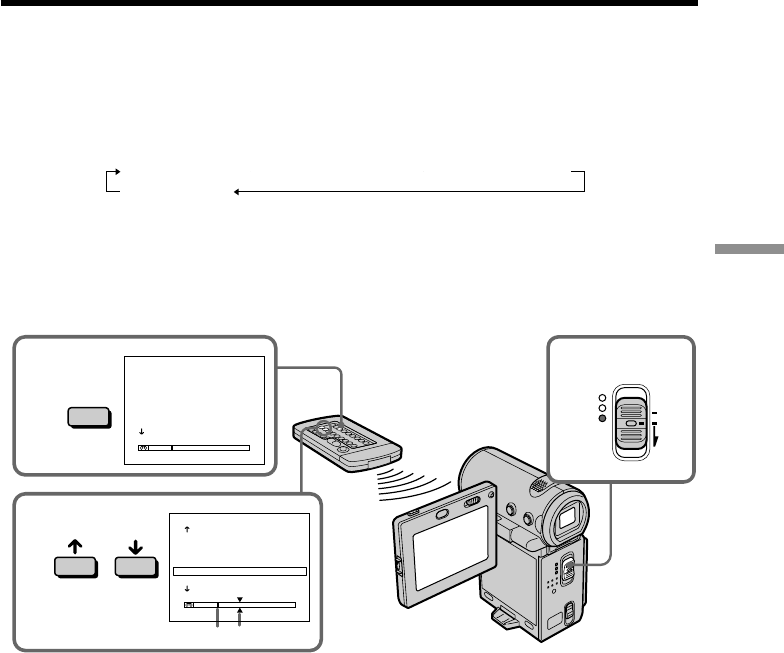
75
Advanced Playback Operations
Searching the boundaries of recorded
tape by title – Title search
You can search for the boundaries of recorded tape by title. You can only use this
function with the Remote Commander.
(1)Set the POWER switch to VCR.
(2)Press SEARCH MODE on the Remote Commander repeatedly until the TITLE
SEARCH indicator appears.
The indicator changes as follows:
TITLE SEARCH t DATE SEARCH t PHOTO SEARCH
(no indicator)
(3)Press X or x on the Remote Commander to select the title you want to
playback. Your camcorder automatically starts playback of the scene having
the title that you selected.
[a]Actual point you are trying to search for
[b]Present point on the tape
To stop searching
Press STOP on the Remote Commander.
1
3
2SEARCH
MODE
TITLE SEARCH
1 HELLO!
2 CONGRATULATIONS!
3 HAPPY NEW YEAR!
4 PRESENT
5 GOOD MORNING
6 WEDDING
TITLE SEARCH
3 HAPPY NEW YEAR!
4 PRESENT
5 GOOD MORNING
6 WEDDING
7 NIGHT
8 BASEBALL
[b][a]
MEMORY/
NETWORK
VCR
CAMERA (CHG)
POWER
OFF
ON
MODE
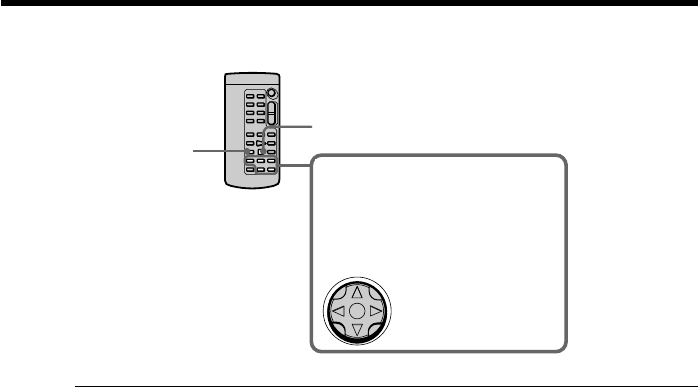
76
When controlling from the Remote Commander
If the tape has a blank portion between recorded portions
The title search function may not work correctly.
To superimpose a title
See page 98.
Searching the boundaries of recorded tape by title – Title search
X/x/C/c/DECISION buttons
These buttons function the same
as the control button on the
camcorder.
SEARCH MODE STOP
The control button
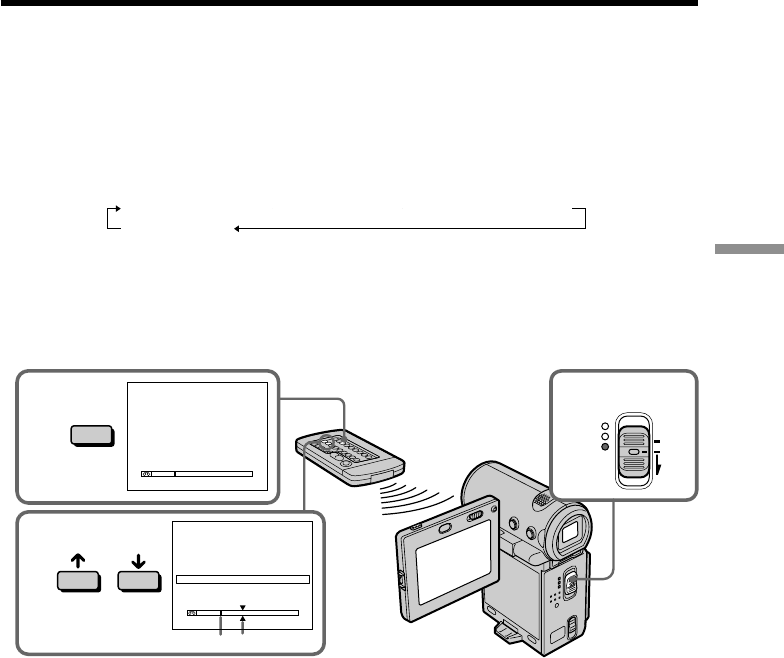
77
Advanced Playback Operations
Searching a recording by date
– Date search
You can automatically search for the point where the recording date changes and start
playback from that point. You can only use this function with the Remote Commander.
Use this function to check where recording dates change or to edit the tape at each
recording date.
(1)Set the POWER switch to VCR.
(2)Press SEARCH MODE on the Remote Commander repeatedly until the DATE
SEARCH indicator appears.
The indicator changes as follows:
TITLE SEARCH t DATE SEARCH t PHOTO SEARCH
(no indicator)
(3)Press X or x on the Remote Commander to select the date you want to
playback. Your camcorder automatically starts playback at the beginning of
the selected date.
[a]Actual point you are trying to search for
[b]Present point on the tape
To stop searching
Press STOP on the Remote Commander.
1
3
2SEARCH
MODE
[b][a]
DATE SEARCH
1 SEP / 5 / 01
2 SEP / 6 / 01
3 DEC / 24 / 01
4 JAN / 1 / 02
5 FEB / 11 / 02
6 APR / 29 / 02
DATE SEARCH
1 SEP / 5 / 01
2 SEP / 6 / 01
3 DEC / 24 / 01
4 JAN / 1 / 02
5 FEB / 11 / 02
6 APR / 29 / 02
MEMORY/
NETWORK
VCR
CAMERA (CHG)
POWER
OFF
ON
MODE
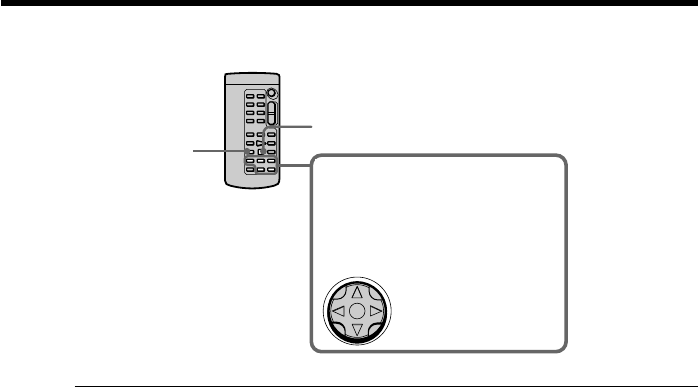
78
When controlling from the Remote Commander
If the tape has a blank portion between recorded portions
The date search function may not work correctly.
Cassette memory
The tape cassette memory can hold 20 recording date data.
Searching a recording by date – Date search
X/x/C/c/DECISION buttons
These buttons function the same
as the control button on the
camcorder.
SEARCH MODE STOP
The control button
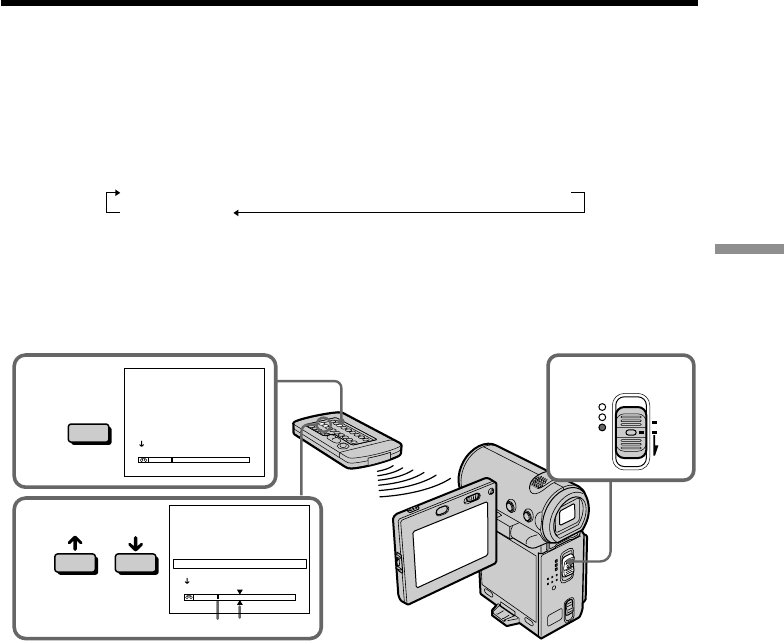
79
Advanced Playback Operations
Searching for a photo – Photo search
You can search for a still image you have recorded on a tape.
You can only use this function with the Remote Commander. Use this function to check
or edit still images.
(1)Set the POWER switch to VCR.
(2)Press SEARCH MODE on the Remote Commander repeatedly until the
PHOTO SEARCH indicator appears.
The indicator changes as follows:
TITLE SEARCH t DATE SEARCH t PHOTO SEARCH
(no indicator)
(3)Press X or x on the Remote Commander to select the date you want to
playback. Your camcorder automatically starts playback of the photo having
the date that you selected.
[a]Actual point you are trying to search for
[b]Present point on the tape
To stop searching
Press STOP on the Remote Commander.
1
3
2SEARCH
MODE
[b][a]
PHOTO SEARCH
1 SEP / 5 / 01
1
7
:
30
2 SEP / 6 / 01 8
:
50
3 DEC / 24 / 01
1
0
:
30
4 JAN / 1 / 02 23
:
25
5 FEB / 11 / 02
1
6
:
11
6 APR / 29 / 02
1
3
:
45
PHOTO SEARCH
1 SEP / 5 / 01
1
7
:
30
2 SEP / 6 / 01 8
:
50
3 DEC / 24 / 01
1
0
:
30
4 JAN / 1 / 02 23
:
25
5 FEB / 11 / 02
1
6
:
11
6 APR / 29 / 02
1
3
:
45
MEMORY/
NETWORK
VCR
CAMERA (CHG)
POWER
OFF
ON
MODE
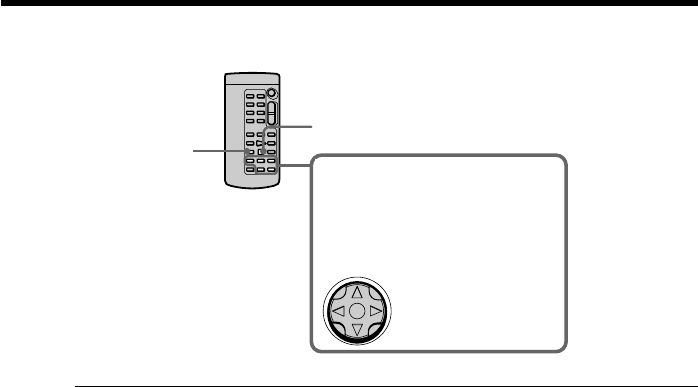
80
Searching for a photo – Photo search
When controlling from the Remote Commander
If the tape has a blank portion between recorded portions
The photo search function may not work correctly.
The available number of photos that can be searched
The available number is up to approximate 400 photos. However, if a moving picture is
recorded between the still images, the searchable number decreases.
X/x/C/c/DECISION buttons
These buttons function the same
as the control button on the
camcorder.
SEARCH MODE STOP
The control button
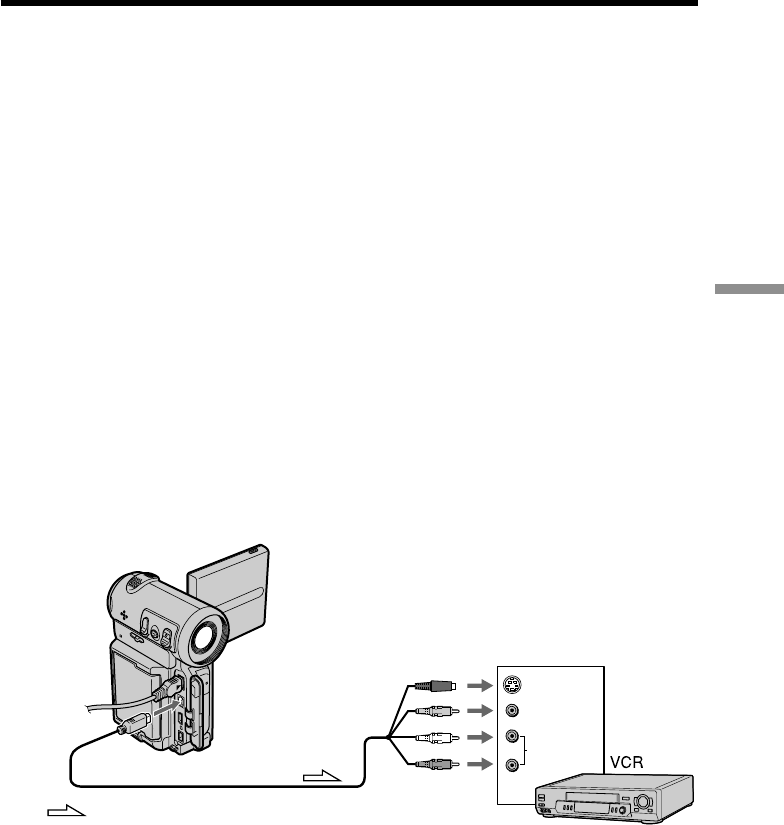
81
Editing
VIDEO
AUDIO
IN
S VIDEO
– Using the A/V connecting cable
You can dub or edit on the VCR connected to your camcorder using your camcorder as
a player. Connect your camcorder to the VCR using the A/V connecting cable supplied
with your camcorder. The supplied A/V connecting cable is equipped with the S video
plug and the video plug. Use either the S video plug or the video plug depending on
the recorder. Do not connect both of the plugs to the recorder.
Before operation
•Set DISPLAY to LCD in the menu settings. (The default setting is LCD.)
•Press the following buttons to turn off the indicators so that they will not be
superimposed on the edited tape:
On your camcorder: DISPLAY
On the Remote Commander: DISPLAY, DATA CODE, SEARCH MODE
•Set DATA CODE on the PAGE3 screen to OFF.
(1)Insert a blank tape (or the tape you want to record over) into the VCR, and
insert the recorded tape into your camcorder.
(2)Prepare the VCR for recording: connect the A/V connecting cable, then set the
input selector to LINE.
Refer to the operating instructions of the VCR.
(3)Set the POWER switch to VCR.
(4)Play back the recorded tape on your camcorder.
(5)Start recording on the VCR.
Refer to the operating instructions of your VCR.
When you have finished dubbing a tape
Stop the recording on the VCR, and stop the playback on the camcorder.
: Signal flow
— Editing —
Dubbing a tape
A/V
AUDIO
S VIDEO or VIDEO
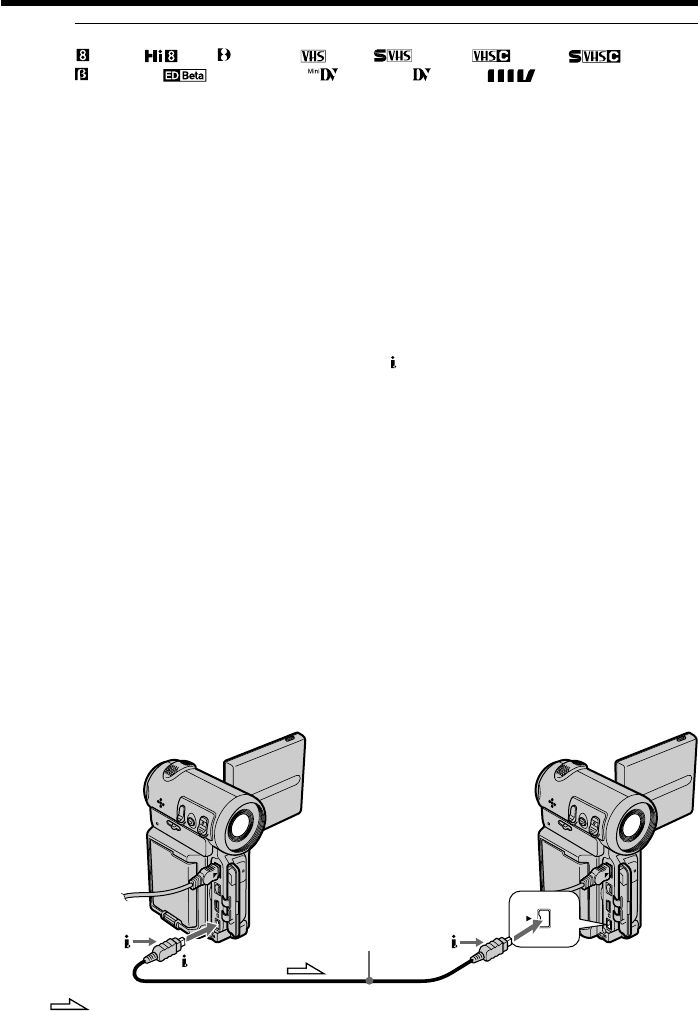
82
You can edit on VCRs that support the following systems
8 mm, Hi8, Digital8, VHS, S-VHS, VHSC, S-VHSC,
Betamax, ED Betamax, mini DV, DV, or MICROMV
If your VCR is a monaural type
Connect the yellow or black plug of the A/V connecting cable to the video or S video
input jack on the VCR, and the white or red plug to the audio input jack on the VCR.
When the white plug is connected, the left channel audio is output, and when the red
plug is connected, the right channel audio is output.
If your VCR has an S video jack
Connect using the S video plug to faithfully obtain original pictures. With this
connection, you do not need to connect the yellow (video) plug of the A/V connecting
cable. Connect the S video plug to the S video jack of the VCR. This connection
produces higher quality MICROMV format pictures.
– Using the i.LINK cable
Simply connect the supplied i.LINK cable to i.LINK (MICROMV) jack of your
camcorder and to the i.LINK (MICROMV) jack of the MICROMV products. With
digital-to-digital connection, video and audio signals are transmitted in digital form for
high-quality editing. You cannot dub the titles, displayed indicators, the contents of
cassette memory, or letters on the “Memory Stick” index screen (DCR-IP7/IP7BT only).
(You cannot connect the camcorder with a DV product.)
(1)Insert a blank tape (or the tape you want to record over) into the recorder, and
insert the recorded tape into your camcorder.
(2) Prepare the recorder for recording.
Set the input selector to LINE if it is provided. Refer to the operating
instructions of the recorder.
(3)Set the POWER switch to VCR.
(4)Play back the recorded tape on your camcorder.
(5)Start recording on the recorder.
Dubbing a tape
MICROMV
: Signal flow
(supplied)
MPEG2

83
Editing
When you have finished dubbing a tape
Stop the recording on the recorder, and stop the playback on the camcorder.
You can connect only one recorder using the i.LINK cable
See page 172 for more information about i.LINK.
The following functions do not work during digital editing:
–Picture effect
–Digital effect
Note on playback pause pictures
•The recorded picture becomes rough when recorded through the i.LINK (MICROMV)
jack.
•The picture may jitter when you play back the tape on other video devices.
•There may be a time-lag when you play back the tape on other video devices.
Dubbing a tape
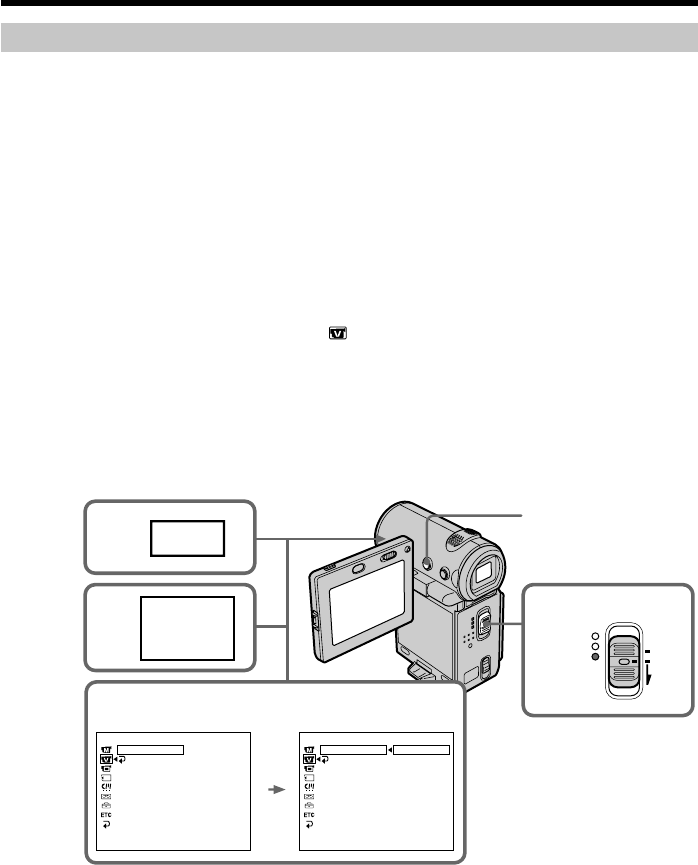
84
4,5
26
FN
3
MENU
1
VCR SET
VIDEOINPUT
RETURN VIDEO VCR SET
VIDEOINPUT
RETURN VIDEO
S VIDEO
MEMORY/
NETWORK
VCR
CAMERA (CHG)
POWER
OFF
ON
MODE
Recording a program
When using the A/V connecting cable
You can record or edit a program from another VCR that has video/audio outputs. Use
your camcorder as a recorder.
1Switching the video input jack of the A/V connecting cable
The supplied A/V connecting cable is equipped with the S video plug and the video
plug. You have to select either of the jacks in the menu settings. The default setting is
VIDEO. If the setup is not necessary, go to “2 Making a recording” on page XX.
(1)Set the POWER switch to VCR.
(2)Select FN, then press the center z on the control button. The PAGE1 screen
appears.
(3)Select MENU, then press the center z on the control button. The menu
appears.
(4)Select VIDEOINPUT through , then press the center z or B on the control
button.
(5)Select VIDEO or S VIDEO, then press the center z on the control button.
(6)Press DISPLAY to turn off the menu. Pressing DISPLAY again displays the
video control buttons.
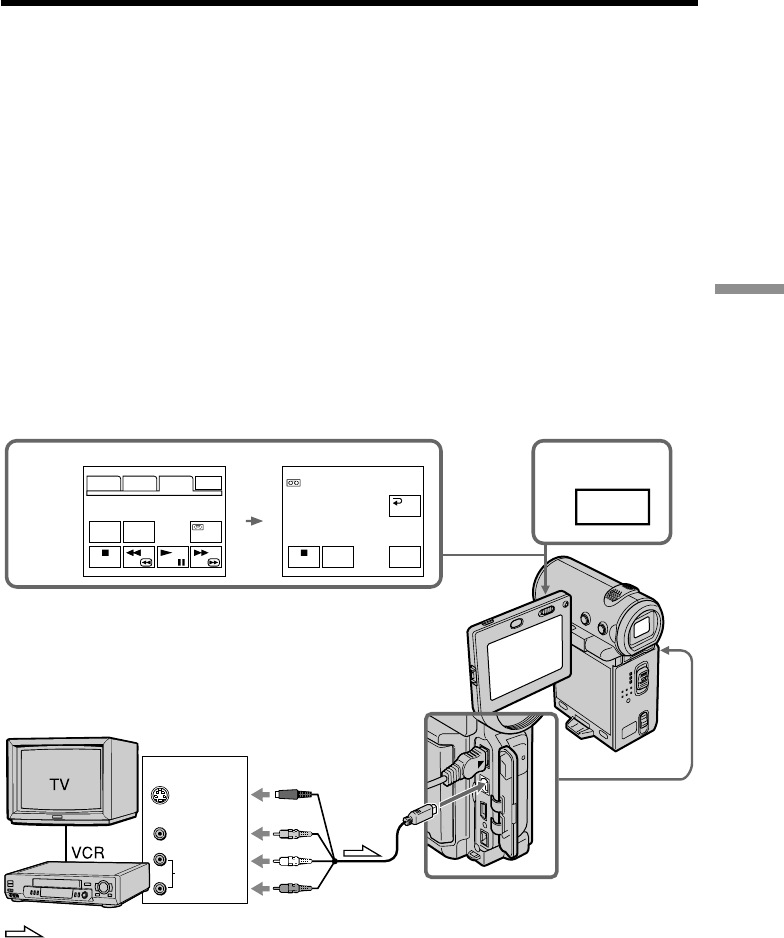
85
Editing
2Making a recording
Before operation
Set DISPLAY to LCD in the menu settings (The default setting is LCD.) (p. XX).
(1)Insert a blank tape (or the tape you want to record over) into your camcorder
and insert the recorded tape into the VCR.
(2)Set the POWER switch to VCR.
(3)Select FN, then press the center z on the control button. The PAGE1 screen
appears.
(4)Select PAGE3, then press the center z on the control button. The PAGE3
screen appears.
(5)Select q REC CTRL, then press the center z on the control button, and select
REC PAUSE, then press the center z on the control button.
(6)Press N on the VCR to start playback. The picture from the VCR appears on
the screen on your camcorder.
(7)Select REC START, then press the center z on the control button at the scene
where you want to start recording from. The recording starts.
4,5 3 FN
PAGE1 PAGE2 PAGE3 EXIT
DATA
CODE COUNT
RESET REC
CTRL
REC
PAUSE
REC CTRL
RET.
S VIDEO
VIDEO
AUDIO
OUT
REC
START
: Signal flow
Recording a program
A/V
S VIDEO or VIDEO

86
Recording a program
When you have finished dubbing a tape
Select , then press the center z on the control button on your camcorder and stop
the playback of the VCR.
If your VCR is a monaural type
Connect the yellow plug of the A/V connecting cable to the video output jack and the
white or red plug to the audio output jack on the VCR. When the white plug is
connected, the left channel audio is output, and when the red plug is connected, the
right channel audio is output.
If your VCR has an S video jack
Connect using the S video plug to faithfully obtain original pictures. With this
connection, you do not need to connect the yellow (video) plug of the A/V connecting
cable. Connect the S video plug to the S video jack of the VCR. This connection
produces higher quality MICROMV format pictures.
Note (DCR-IP7/IP7BT only)
When you press MEMORY PLAY on the Remote Commander in step 5, an image
recorded on the “Memory Stick” is displayed. If you select REC START, then press the
center z on the control button, the image will be recorded on the tape. To stop memory
playback, press MEMORY PLAY on the Remote Commander again.
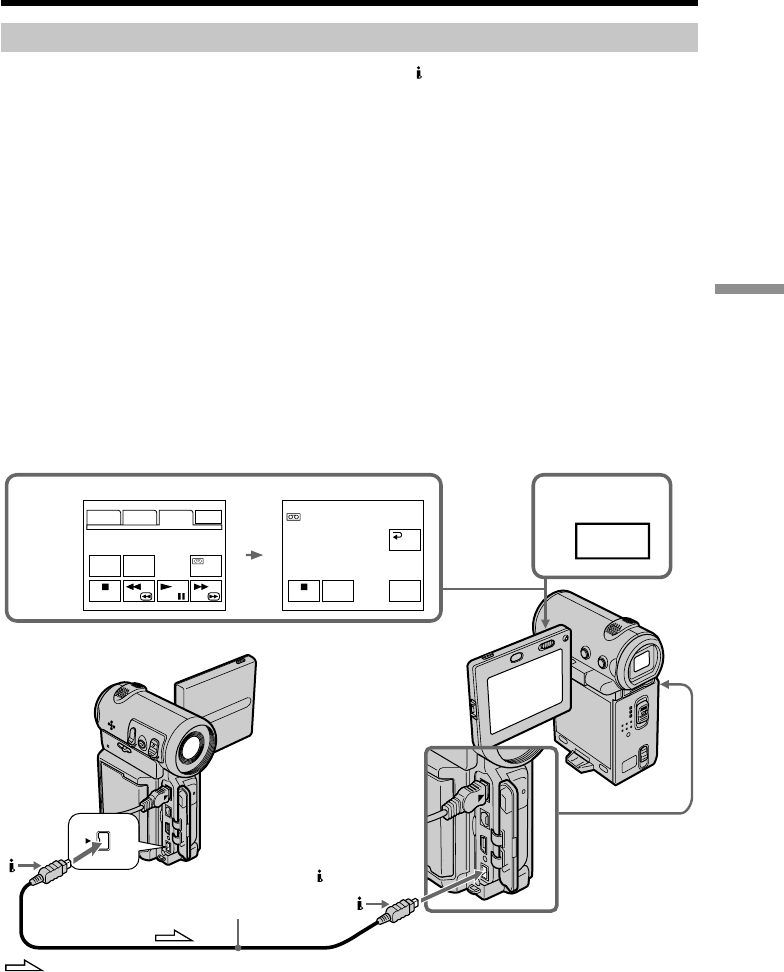
87
Editing
4,5 3FN
PAGE1 PAGE2 PAGE3 EXIT
DATA
CODE COUNT
RESET REC
CTRL
REC
PAUSE
REC CTRL
RET.
REC
START
Recording a program
When using the i.LINK cable
Simply connect the supplied i.LINK cable to the i.LINK (MICROMV) jack of your
camcorder and to the i.LINK (MICROMV) jack of the MICROMV products. With
digital-to-digital connection, video and audio signals are transmitted in digital form for
high-quality editing. (You cannot connect the camcorder with a DV product.)
(1)Insert a blank tape (or the tape you want to record over) into your camcorder,
and insert the recorded tape into the player.
(2)Set the POWER switch to VCR.
(3)Select FN, then press the center z on the control button. The PAGE1 screen
appears.
(4)Select PAGE3, then press the center z on the control button. The PAGE3
screen appears.
(5)Select q REC CTRL, then press the center z on the control button, and select
REC PAUSE, then press the center z on the control button.
(6)Press N on the player to start playback. The picture from the player appears
on the screen on your camcorder.
(7)Select REC START, then press the center z on the control button at the scene
where you want to start recording from.
: Signal flow
(supplied)
MICROMV
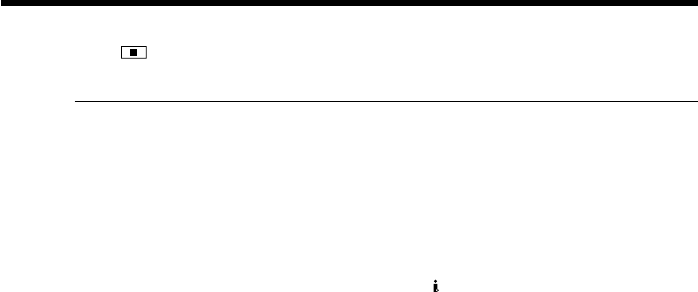
88
Recording a program
When you have finished dubbing a tape
Select , then press the center z on the control button and stop the playback of the
player.
Notes
•When an unavailable picture (such as, recorded with the DV format) is input, the
message “INPUT ERROR” appears.
•You can connect only one recorder using the i.LINK cable.
When you dub a picture in digital form
The color of the display may be uneven. However, this does not affect the dubbed
picture.
If you record a playback pause picture with the i.LINK (MICROMV) jack
The recorded picture becomes rough. And when you play back the picture using your
camcorder, the picture may jitter.
Note
First, make the player to start playback or turn to the playback pause mode before the
camcorder starts recording or turns to the recording pause mode. If no signal is input
into the camcorder, the message “xxx xxx” appears and the camcorder cannot start
recording.
Before recording
Make sure if the MPEG IN indicator appears on the screen. The MPEG IN indicator may
appear on both equipment.
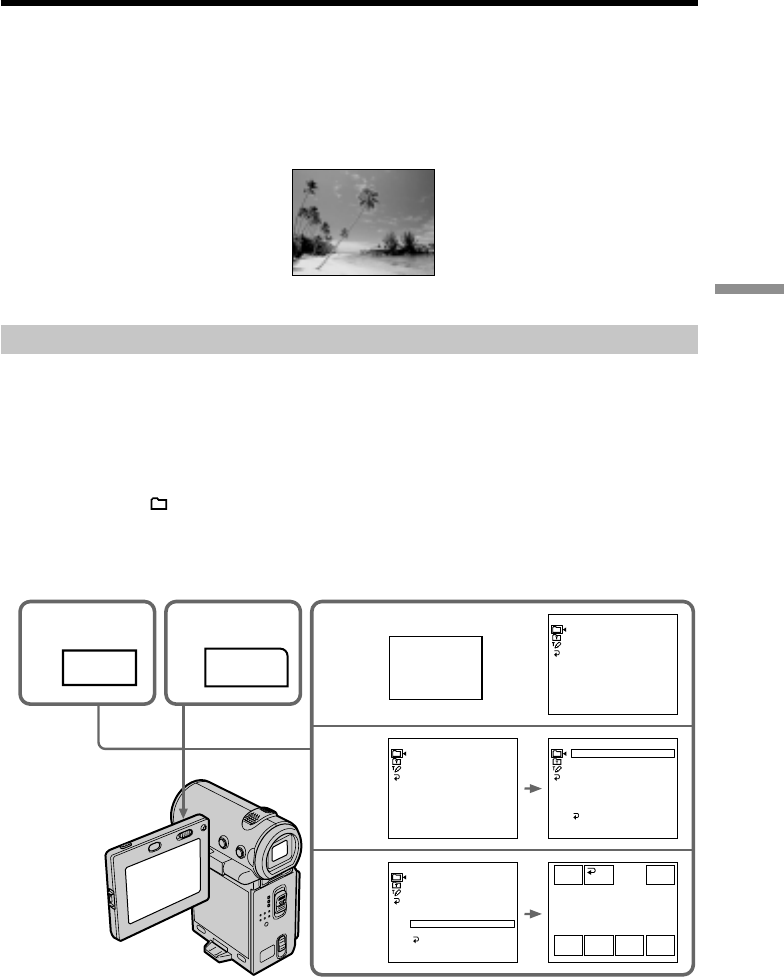
89
Editing
Superimposing a title
You can superimpose the title for 5 seconds from the recording start point (Index titler
function). When you play back the tape, the title is displayed for about 5 seconds from
the point where you superimposed it.
You can select one of eight preset titles and two custom titles (p. 101). You can also
select the color, size and position of titles.
Superimposing a title on starting a recording
(1)In standby mode, select FN, then press the center z on the control button. The
PAGE1 screen appears.
(2)Select PAGE2, then press the center z on the control button. The PAGE2
screen appears.
(3)Select TITLE, then press the center z on the control button. The title menu
appears.
(4)Select , then press the center z or B on the control button.
(5)Select the desired title, then press the center z on the control button. The
selected title appears on the screen.
VACATION
3
4
5
TITLE
PRESET TITLE
HELLO!
HAPPY BIRTHDAY
HAPPY HOLIDAYS
CONGRATULATIONS!
OUR SWEET BABY
WEDDING
VACATION
THE END
VACATION
COLOR
RET.
POS rSIZE
TITLE
OK EXIT
POS R
PRESET TITLE
HELLO!
HAPPY BIRTHDAY
HAPPY HOLIDAYS
CONGRATULATIONS!
OUR SWEET BABY
WEDDING
VACATION
THE END
RETURN
PRESET TITLE
HELLO!
HAPPY BIRTHDAY
HAPPY HOLIDAYS
CONGRATULATIONS!
OUR SWEET BABY
WEDDING
VACATION
THE END
PRESET TITLE
HELLO!
HAPPY BIRTHDAY
HAPPY HOLIDAYS
CONGRATULATIONS!
OUR SWEET BABY
WEDDING
VACATION
THE END
RETURN
1FN 2
PAGE2
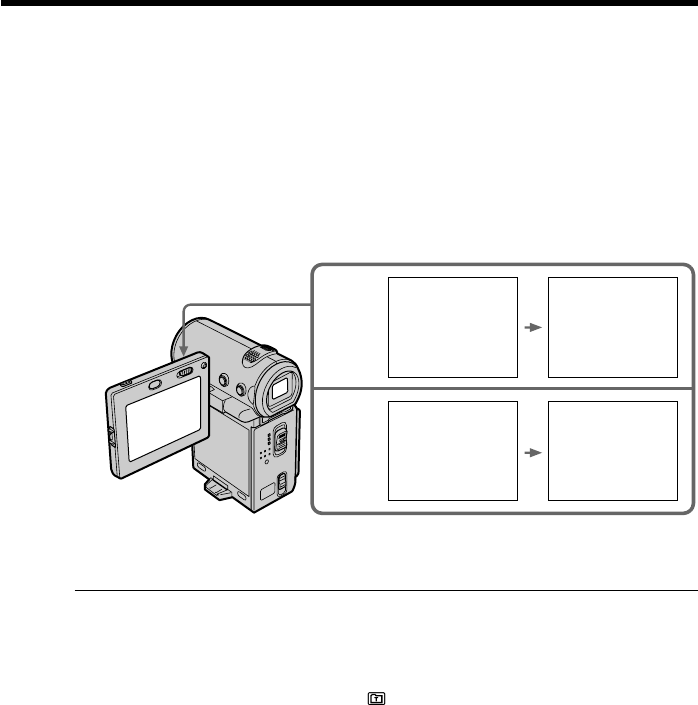
90
Superimposing a title
(6)If necessary, change the color, size, or position by selecting COLOR, SIZE, POS
r or POS R, then press the center z on the control button repeatedly.
(7)Select TITLE OK, then press the center z on the control button. The ?? screen
appears.
(8)Select SAVE TITLE, then press the center z on the control button.
The “TITLE” indicator appears. And when you press START/STOP to start
recording, “TITLE SAVE” appears on the screen for about 5 seconds and the
title is set.
If you set the write-protect tab to lock
You cannot superimpose the title. Slide the write-protect tab to release the write
protection.
To use the custom title
If you want to use the custom title, select in step 4 (p. XX).
If the tape has a blank portion
You cannot superimpose a title on the blank portion.
If the tape has a blank portion in the middle of the recorded portions
The title may not be displayed correctly.
To not display title during playback
Set TITLE DSPL to OFF in the menu settings (p. 105).
6,7
8

91
Editing
Superimposing a title
Title setting
•The title color changes as follows:
WHITE t YELLOW t VIOLET t RED t CYAN t GREEN t BLUE
•The title size changes as follows:
SMALL y LARGE
You cannot input 13 characters or more in LARGE size. If you input more than 12
characters, the title size returns to SMALL even you select LARGE.
•If you select the title size “SMALL”, you have nine choices for the title position.
If you select the title size “LARGE”, you have eight choices for the title position.
The number of titles recordable on one cassette
This is up to 20 characters when each title consists of five characters.
When 20 titles were already superimposed
The message “ TITLE FULL” appears. Erase unnecessary titles.
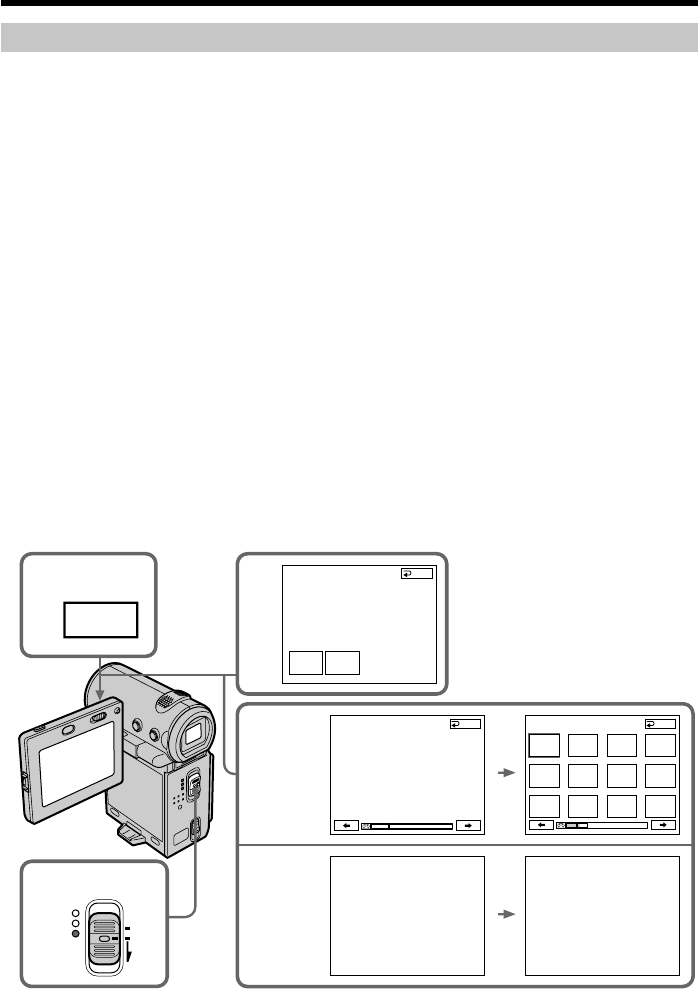
92
Superimposing a title on the recorded tape
The title is recorded for about 5 seconds from the recording start point.
(1)Set the POWER switch to VCR.
(2)Select FN, then press the center z on the control button. The PAGE1 screen
appears.
(3)Select TITLE, then press the center z on the control button. The TITLE screen
appears.
(4)Select INPUT TITLE, then press the center z on the control button. The INPUT
TITLE screen appears.
(5)Select </,, then press the center z on the control button. The camcorder
starts scanning toward the selected direction. When you select ,, the
thumbnails are displayed from the upper-left window, and when you select
<, they are displayed from the lower-right window. After the scanning is
completed, the thumbnails are displayed on the index screen.
(6)Select the thumbnail you want to superimpose a title, then press the center z
on the control button. The title menu appears.
(7)Perform steps 4 to 6 in “Superimposing a title on starting a recording” on page
XX.
(8)Select SAVE TITLE, then press the center z on the control button.
The “TITLE SAVE” indicator appears on the screen for about 5 seconds and
the title is set.
Superimposing a title
2FN 3
INPUT
TITLE TITLE
SET
TITLE
1
MEMORY/
NETWORK
VCR
CAMERA (CHG)
POWER
OFF
ON
MODE
4,5
6–8
INPUT TITLE END
SELECT
DIRECTION
INPUT TITLE END
END

93
Editing
Superimposing a title
To use the custom title
If you want to use the custom title, select in step 6 (p. 84).
Notes
•Thumbnails may not be displayed depending on the tape condition. This is not a
malfunction.
•Noise may appear on the thumbnails. However, this have no effect on the recorded
images.
•You cannot execute TITLE SAVE until the playback picture is displayed in step 8.
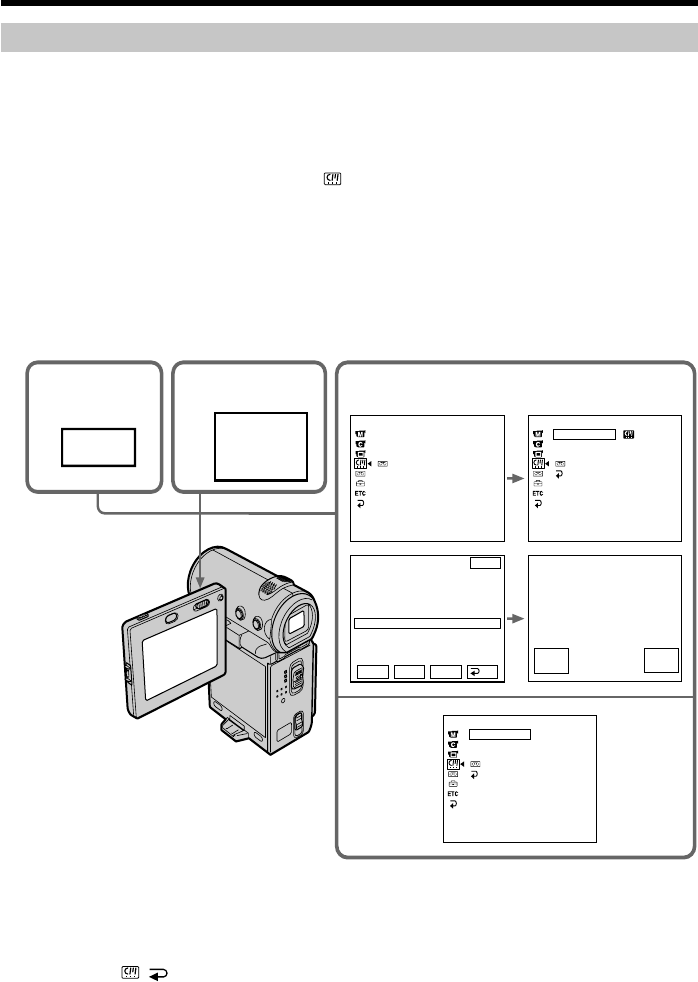
94
Erasing a title
(1)Set the POWER switch to CAMERA or VCR.
(2)Select FN, then press the center z on the control button. The PAGE1 screen
appears.
(3)Select MENU, then press the center z on the control button. The menu
appears.
(4)Select TITLEERASE through , then press the center z or B on the control
button. The TITLE ERASE screen appears.
(5)Select the title you want to erase, then press the center z on the control button.
The message “ERASE OK?” appears.
(6)Make sure the title is the one you want to erase, and select OK, then press the
center z on the control button. The message “ERASING” flashes during
erasing. After the erasing is completed, the message “COMPLETE” appears.
Illustration: In CAMERA mode
To return to the FN screen
Select , , then press the center z on the control button after step 6. Next, select
EXIT, then press the center z on the control button.
To cancel erasing
Select CANCEL, then press the center z on the control button in step 5.
Superimposing a title
4,5
6
2
FN
3
CM SET
T
I
TLEERASE
TAPE T
I
TLE
ERASE ALL
INFODSPL
T
I
TLE ERASE
1 HELLO
!
2 CONGRATULAT
I
ONS
!
3 HAPPY NEW YEAR
!
4 PRESENT
5 GOOD MORN
I
NG
6 WEDD
I
NG
T
I
TLE ERASE
4
PRESENT
EXIT
END
EXEC
Rr
ERASE OK?
OK CAN–
CEL
CM SET
T
I
TLEERASE
TAPE T
I
TLE
ERASE ALL
INFODSPL
RETURN
CM SET
T
I
TLEERASE
TAPE T
I
TLE
ERASE ALL
INFODSPL
RETURN
COMPETE
MENU
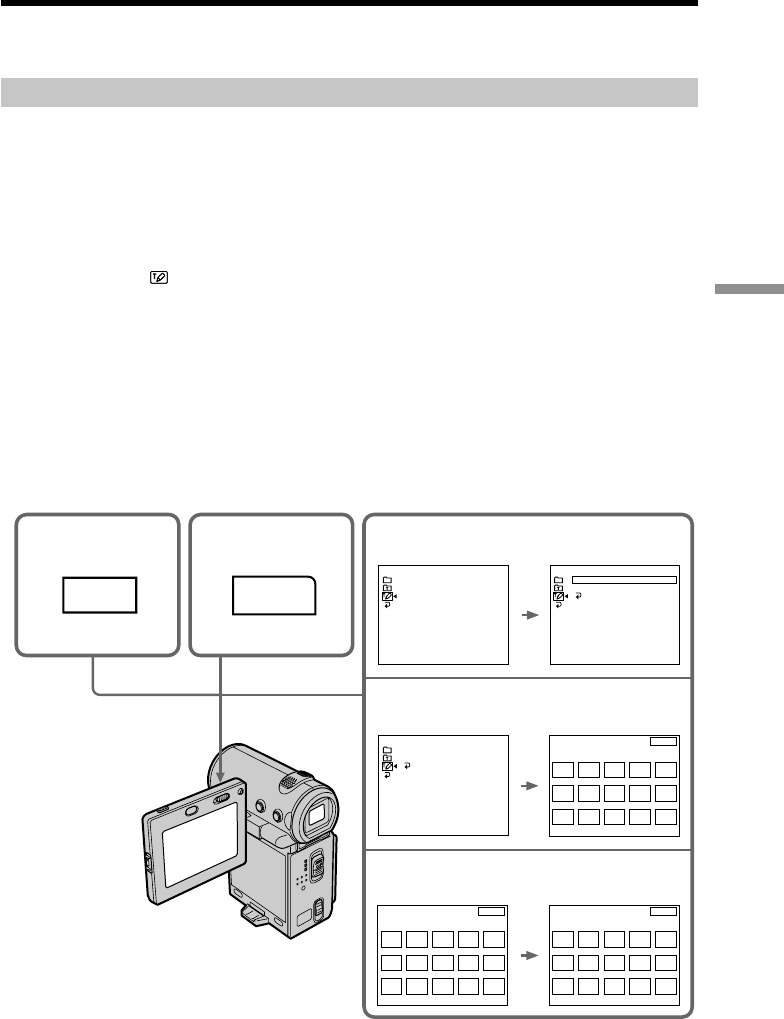
95
Editing
Making your own titles
You can make up to two titles and store them in the memory of your camcorder. Each
title can have up to 20 characters.
Making a title in CAMERA mode
(1)Set the POWER switch to CAMERA.
(2)Select FN, then press the center z on the control button. The PAGE1 screen
appears.
(3)Select PAGE2, then press the center z on the control button. The PAGE2
screen appears.
(4)Select TITLE, then press the center z on the control button. The TITLE SET
screen appears.
(5)Select , then press the center z or B on the control button.
(6)Select CUSTOM1 SET or CUSTOM2 SET, then press the center z on the
control button.
(7)Select the desired character button and press z repeatedly to select the desired
character on the button.
(8)Select another character button, then press the center z on the control button.
The cursor moves to the next character. Repeat the same procedure as step 6
and 7 to complete your title.
(9)Select SET, then press the center z on the control button. The title is stored in
memory.
3
6
5
7–9
TITLE SET
CUSTOM1 SET
CUSTOM2 SET
TITLE SET
CUSTOM1 SET
CUSTOM2 SET
RETURN
TITLE SET
CUSTOM1 SET
CUSTOM2 SET
RETURN
2
FN
&?
!
ABC DEF
T t
678
90
123
45
MNO
J
KLGH
I
SET
’ . ,
/
–
WXY
Z
TUVPQR
S
[
____________________
]
EXIT
TITLE SET
&?
!
ABC DEF
T t
678
90
123
45
MNO
J
KLGH
I
SET
’ . ,
/
–
WXY
Z
TUVPQR
S
[
PARTY
_______________
]
EXIT
TITLE SET
&?
!
ABC DEF
T t
678
90
123
45
MNO
J
KLGH
I
SET
’ . ,
/
–
WXY
Z
TUVPQR
S
[
PAR
_________________
]
EXIT
TITLE SET
PAGE2

96
Making your own titles
To return to the FN screen
Select , then press the center z on the control button after step 9. The PAGE2 screen
appears. Next, select EXIT, then press the center z on the control button.
To change the title you have stored
In step 5, select CUSTOM1 SET or CUSTOM2 SET, depending on which title you want
to change, then press the center z on the control button and then enter a new title as
desired.
If you take 5 minutes or longer to enter characters in standby mode while a
cassette is in your camcorder
The power automatically goes off. The characters you have entered remain stored in
memory. Set the POWER switch to OFF (CHG) once and then to CAMERA again, then
complete your title.
We recommend setting the POWER switch to VCR or removing the cassette so that
your camcorder is not automatically turned off while you are entering title characters.
To erase the title
Select C, then press the center z on the control button. The last character is erased.
To enter a space
Select c, then press the center z on the control button.
To enter the same character on the same button in succession
Select c, then press the center z on the control button to move the cursor to the next
position, and enter the character.
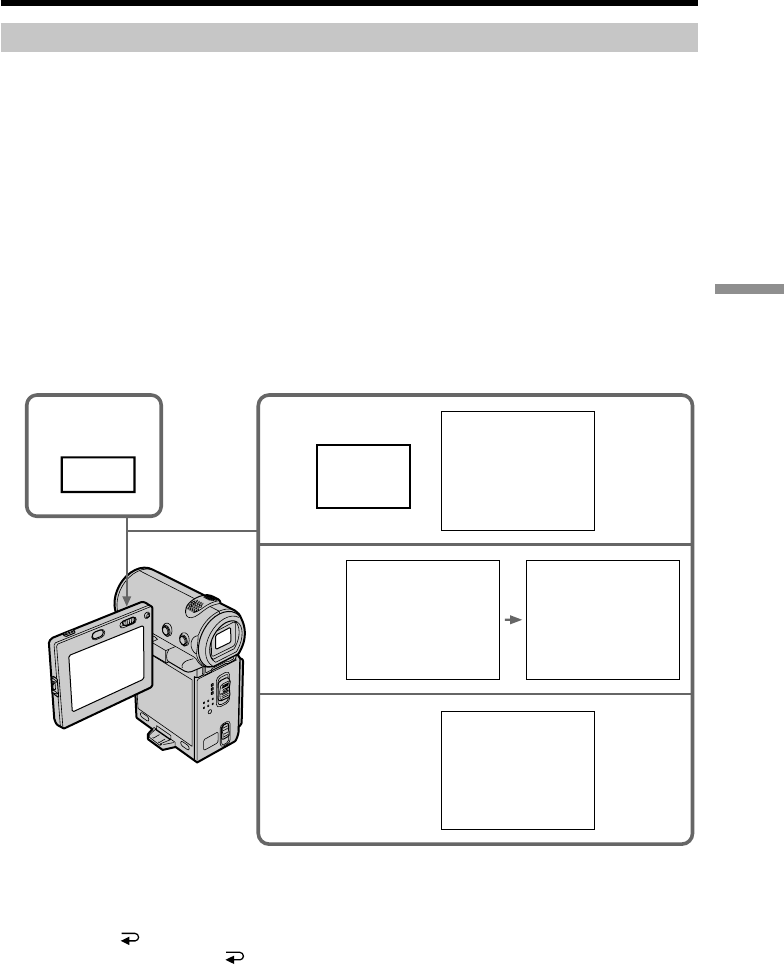
97
Editing
Making a title in VCR mode
(1)Set the POWER switch to VCR.
(2)Select FN, then press the center z on the control button. The PAGE1 screen
appears.
(3)Select TITLE, then press the center z on the control button. The TITLE screen
appears.
(4)Select TITLE SET, then press the center z on the control button. The TITLE
SET screen appears.
(5)Select CUSTOM1 SET or CUSTOM2 SET, then press the center z on the
control button.
(6)Perform the procedure as steps 7 to 8 in “Making a title in CAMERA mode” on
page XX.
(7)Select SET, then press the center z on the control button. The title is stored in
memory.
To return to the FN screen
Select RETURN, then press the center z on the control button. The TITLE screen
appears. Next, select END, then press the center z on the control button. Last, select
EXIT, then press the center z on the control button.
4–6
7
3
2
FN
TITLE
Making your own titles

98
The MICROMV cassette automatically records recording conditions and date. You can
also label a cassette. The label can consist of up to 16 characters and is stored in the
cassette memory. When you insert the labeled cassette and set the POWER switch to
CAMERA or VCR, the label is displayed for about 5 seconds.
The cassette information
[a]Unique number of each cassette. The camcorder automatically assign this number.
[b]Cassette title set by the TAPE TITLE item in the menu settings (Cassette label).
[c]First-recorded date in this cassette.
[d]Last-recorded date in this cassette.
[e]Recorded area is indicated with the white bar.
The MICRO cassette memory
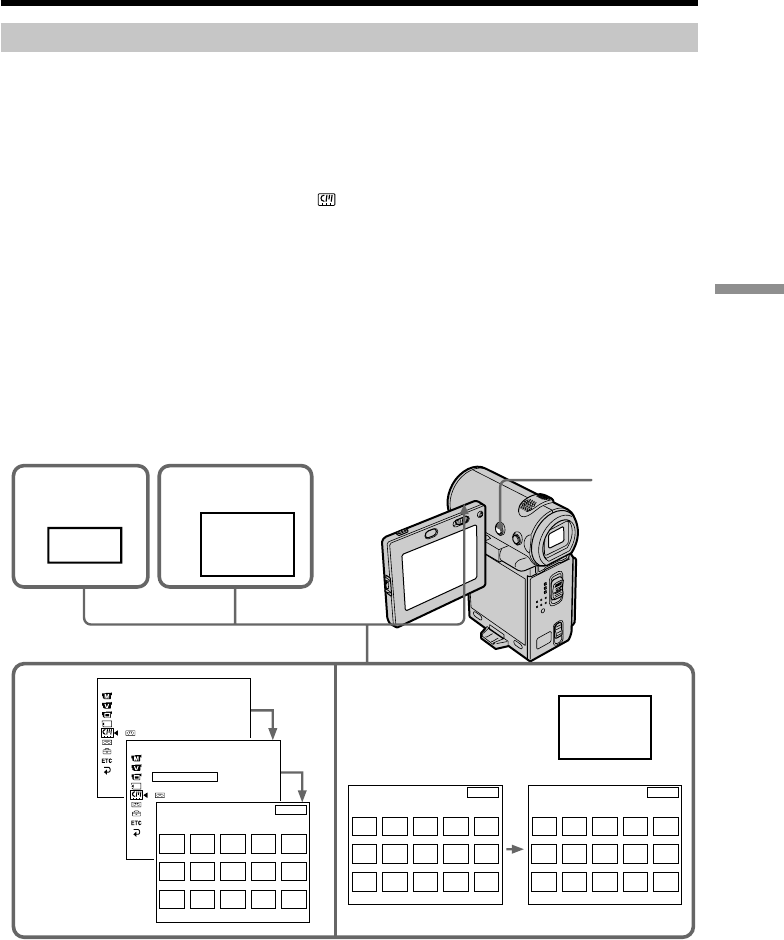
99
Editing
Labeling a cassette
(1)Insert the cassette you want to label.
(2)Set the POWER switch to CAMERA or VCR.
(3)Select FN, then press the center z on the control button. The PAGE1 screen
appears.
(4)Select MENU, then press the center z on the control button. The menu
appears.
(5)Select TAPE TITLE through , then press the center z or B on the control
button.
(6)Select the desired character button and press the center z on the control
button repeatedly to select the desired character on the button .
(7)Select another character button, then press the center z on the control button.
The cursor moves to the next character. Repeat the same procedure as step 6
and 7 to complete the label.
(8)Select SET, then press the center z on the control button. The label is stored in
memory.
(9)Press DISPLAY to turn off the menu.
5
3
FN
4
MENU
SET
CM SET
T
I
TLEERASE
T
I
TLE DSPL
TAPE T
I
TLE
ERASE ALL
INFODSPL
6–8
&?
!
ABC DEF
T t
678
90
123
45
MNO
J
KLGH
I
SET
’ . ,
/
–
WXY
Z
TUVPQR
S
[
GRADU
_______________
]
EXIT
TAPE TITLE
&?
!
ABC DEF
T t
678
90
123
45
MNO
J
KLGH
I
SET
’ . ,
/
–
WXY
Z
TUVPQR
S
[
GRADUATION
__________
]
EXIT
TAPE TITLE
CM SET
–––––––––
T
I
TLEERASE
T
I
TLE DSPL
TAPE T
I
TLE
ERASE ALL
INFODSPL
&?
!
ABC DEF
T t
678
90
123
45
MNO
J
KLGH
I
SET
’ . ,
/
–
WXY
Z
TUVPQR
S
[
____________________
]
EXIT
TAPE TITLE
9
The MICRO cassette memory

100
To return to the FN screen
Select , , then press the center z on the control button after step 8. The PAGE1
screen appears. Next, select EXIT, then press the center z on the control button.
To erase the label you have made
Select C, then press the center z on the control button in step 6. The last character is
erased.
To change the label you have made
Insert the cassette you want to change the label, and operate in the same way to make a
new label.
If you set the write-protect tab of the tape to lock
You cannot label the tape. Slide the write-protect tab to release the write protection.
Note on a recorded area
A blank portion between the recorded areas is also indicated as a recorded area.
Note on cassette information
You can turn off the cassette information using the q INFODSPL item in the menu
settings.
To erase the title
Select C, then press the center z on the control button. The last character is erased.
To enter a space
Select c, then press the center z on the control button.
To enter the same character on the same button in succession
Select c, then press the center z on the control button to move the cursor to the next
position, and enter the character.
The MICRO cassette memory
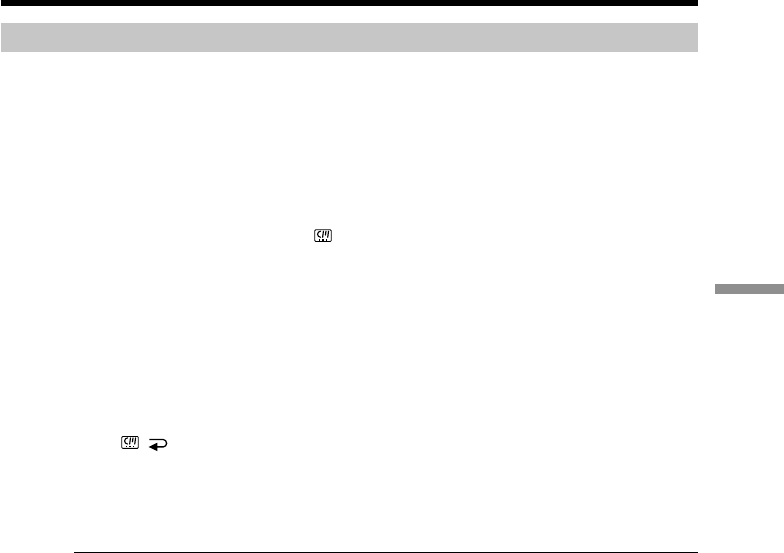
101
Editing
Deleting all the data in the MICRO cassette memory
You can delete all the data (cassette title, date, photo, thumbnail, and cassette
information) in MICRO cassette memory at once.
(1)Set the POWER switch to CAMERA or VCR.
(2)Select FN, then press the center z on the control button. The PAGE1 screen
appears.
(3)Select MENU, then press the center z on the control button. The menu
appears.
(4)Select ERASE ALL through , then press the center z or B on the control
button.
(5)Select ERASE OK?, then press the center z on the control button.
(6)Select OK, then press the center z on the control button.
(7)Select EXECUTE, then press the center z on the control button. The message
“ERASING” appears on the screen. Once deleting is completed, the message
“COMPLETE” appears.
(8)Press DISPLAY to turn off the screen indicators.
To return to the FN screen
Select , , then press the center z on the control button after step 7. The PAGE1
screen appears. Next, select EXIT, then press the center z on the control button.
To cancel deleting
Select RETURN in step 5 or 6, then press the center z on the control button.
Note
Once delete all the data in the MICRO cassette memory, the following operations do not
work:
–Multi-picture search
–Title search
–Date search
–Photo search
Note on ID number
This number cannot be deleted.
The MICRO cassette memory
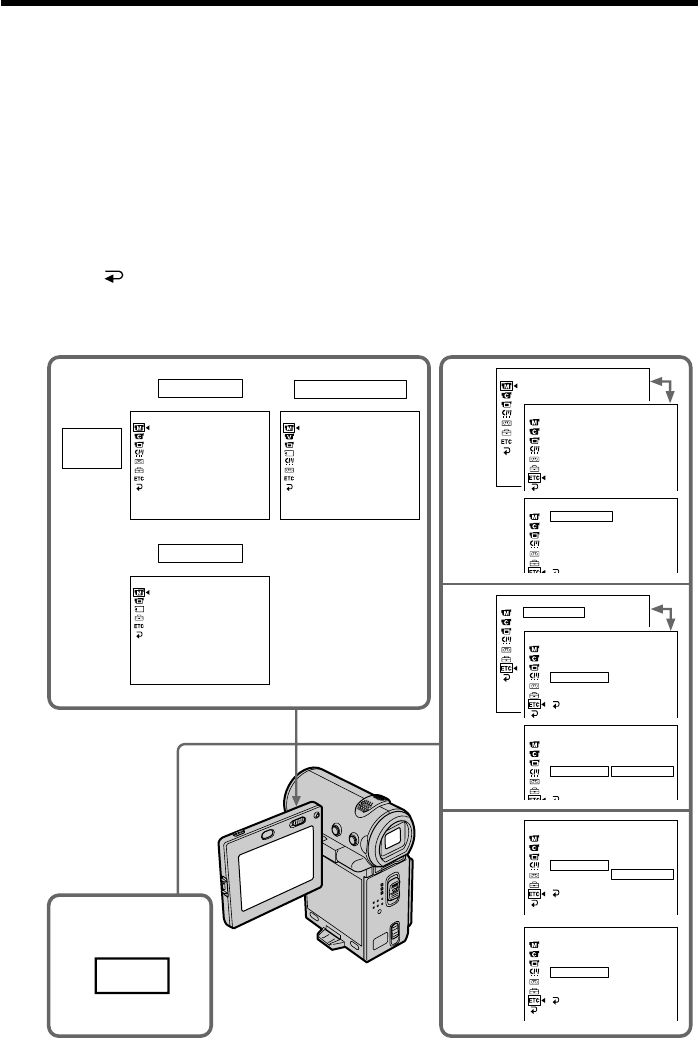
102
— Customizing Your Camcorder —
Changing the menu settings
To change the mode settings in the menu settings, select the menu items with the
control button. The default settings can be partially changed. First, select the icon, then
the menu item, and then the mode.
(1)In standby, MEMORY (DCR-IP7/IP7BT only) or VCR mode, select FN, then
press the center z on the control button. The PAGE1 screen appears.
(2)Select MENU, then press the center z on the control button. The menu
appears.
(3)Select the desired icon, then press the center z or B on the control button.
(4)Select the desired item, then press the center z or B on the control button.
(5)Select the desired setting, then press the center z on the control button.
(6)Repeat steps 3 to 5 if you want to change other items. To return to step 3, select
RETURN, then press the center z on the control button.
For details, see “Selecting the mode setting of each item” (p. 106).
1
FN
2
CAMERA
3
4
5
MANUAL SET
PROGRAM AE
P EFFECT
WHT BAL
AUTO SHTR
VCR
MANUAL SET
P EFFECT
MEMORY
MANUAL SET
PROGRAM AE
WHT BAL
MANUAL SET
PROGRAM AE
P EFFECT
OTHERS
AREA SET
SUMMERTIME
BEEP
RETURN
OTHERS
AREA SET
SUMMERTIME
BEEP
COMMANDER
DISPLAY
REC LAMP
RETURN
ON
OFF
AREA 26
GMT–5.0
New York
Bogota
JUL 4 2001
5:30:00 PM
MENU
OTHERS
AREA SET
SUMMERTIME
BEEP
COMMANDER
DISPLAY
REC LAMP
OTHERS
AREA SET
SUMMERTIME
BEEP
COMMANDER
DISPLAY
REC LAMP
RETURN
ON
OTHERS
AREA SET
SUMMERTIME
BEEP
COMMANDER
DISPLAY
REC LAMP
RETURN
AREA 26
GMT–5.0
New York
Bogota
OTHERS
AREA SET
SUMMERTIME
BEEP
COMMANDER
DISPLAY
REC LAMP
RETURN
ON
OFF
OTHERS
AREA SET
SUMMERTIME
BEEP
COMMANDER
DISPLAY
REC LAMP
RETURN
OFF
(DCR-IP7/IP7BT
only)
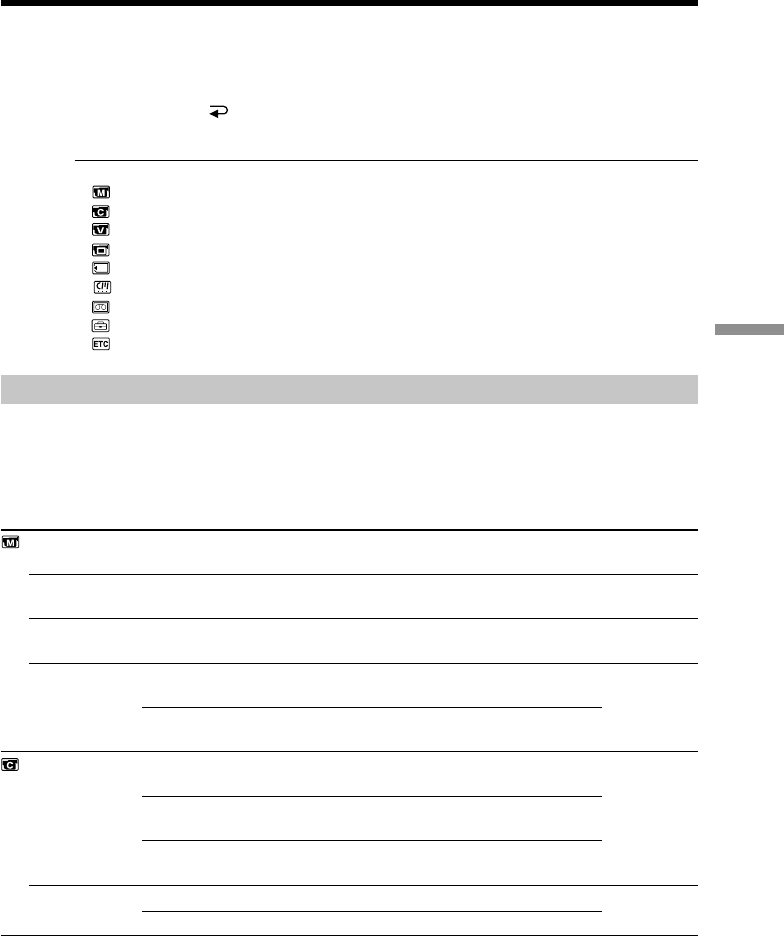
Customizing Your Camcorder
103
Changing the menu settings
To turn off the menu
After step 5, press DISPLAY to turn off the menu.
To return to the FN screen
After step 5, select , then press the center z on the control button. The PAGE1 screen
appears. Next, select EXIT, then press the center z on the control button.
Menu items are displayed as the following icons:
MANUAL SET
CAMERA SET
VCR SET
LCD/VF SET
MEMORY SET (DCR-IP7/IP7BT only)
CM SET
TAPE SET
SETUP MENU
OTHERS
Selecting the mode setting of each item z is the default setting.
Menu items differ depending on the position of the POWER switch.
The screen shows only the items you can operate at the moment. The MEMORY
position of the POWER switch is only for the DCR-IP7/IP7BT.
Icon/item
PROGRAM AE
P EFFECT
WHT BAL
AUTO SHTR
D ZOOM
16:9WIDE
Mode
——
——
——
zON
OFF
zOFF
20×
120×
zOFF
ON
Meaning
To suit your specific shooting requirement
(p. 52).
To add special effects like those in films or on
the TV to images (p. 48).
To adjust the white balance (p. 55).
To automatically activate the electronic shutter
when shooting in bright conditions.
To deactivate the electronic shutter even when
shooting in bright conditions.
To deactivate the digital zoom. Up to 10× zoom
is carried out.
To activate the digital zoom. More than 10× to
20× zoom is performed digitally (p. 27).
To activate the digital zoom. More than 10× to
120× zoom is performed digitally (p. 27).
—
To record a 16:9 wide picture (p. 44).
POWER
switch
CAMERA
MEMORY
CAMERA
VCR
CAMERA
MEMORY
CAMERA
CAMERA
CAMERA
(continued on the following page)
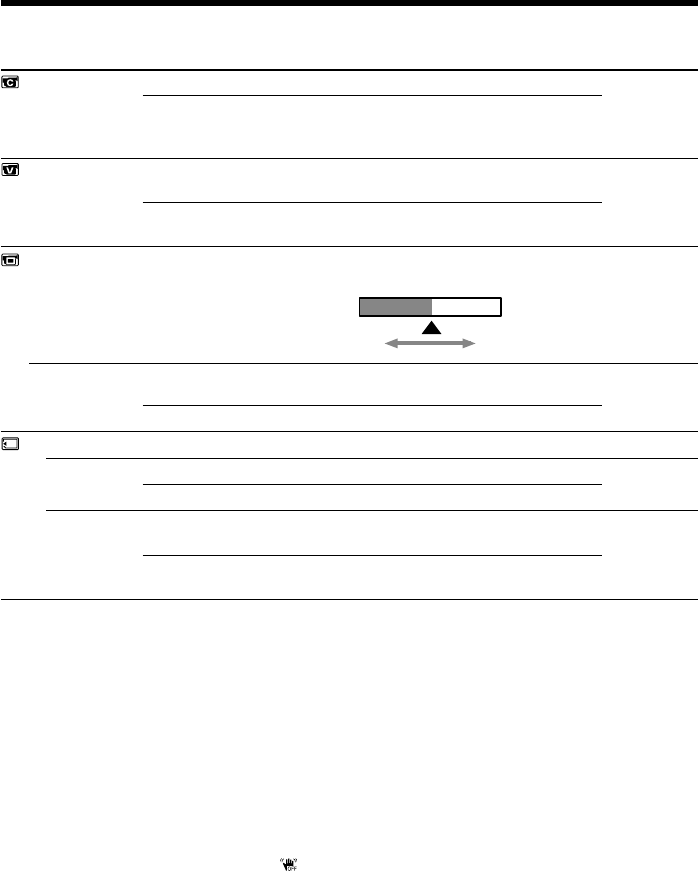
104
Icon/item
STEADYSHOT
VIDEOINPUT
LCD COLOR
VF B.L.
*STILL SET
PIC MODE
QUALITY
Meaning
To compensate for camera-shake.
To cancel the SteadyShot function. Natural
pictures are produced when shooting a
stationary object with a tripod.
To use the video plug of the A/V connecting
cable when recording from a player.
To use the S video plug of the A/V connecting
cable when recording from a player.
To adjust the color on the LCD screen with
b/B.
To set the brightness on the viewfinder screen to
normal.
To brighten the viewfinder screen.
To not record continuously.
To record nine images continuously (p. 124).
To record still images in the fine image quality
mode.
To record still images in the standard image
quality mode.
Changing the menu settings
Low intensity high intensity
Mode
zON
OFF
zVIDEO
S VIDEO
——
zBRT NORMAL
BRIGHT
zSINGLE
MULTI SCRN
zFINE
STANDARD
POWER
switch
CAMERA
VCR
CAMERA
MEMORY
VCR
CAMERA
MEMORY
VCR
MEMORY
MEMORY
VCR
* DCR-IP7/IP7BT only
Notes on the SteadyShot function
The SteadyShot function may not work properly in the following cases:
•When the camera shake is excessive.
•When shooting in dark conditions.
•When the contrast of the subject and its background is low.
•When the subject is in vertical stripes.
•When shooting a moving subject.
•When attaching a conversion lens (optional).
If you cancel the SteadyShot function
The SteadyShot off indicator appears. Your camcorder prevents excessive
compensation for camera-shake.
Notes on VF B.L.
When you select “BRIGHT,” the battery life is reduced by about 10 percent during
recording.
When you use the power source other than the battery pack
VF B.L. is automatically set to BRIGHT.
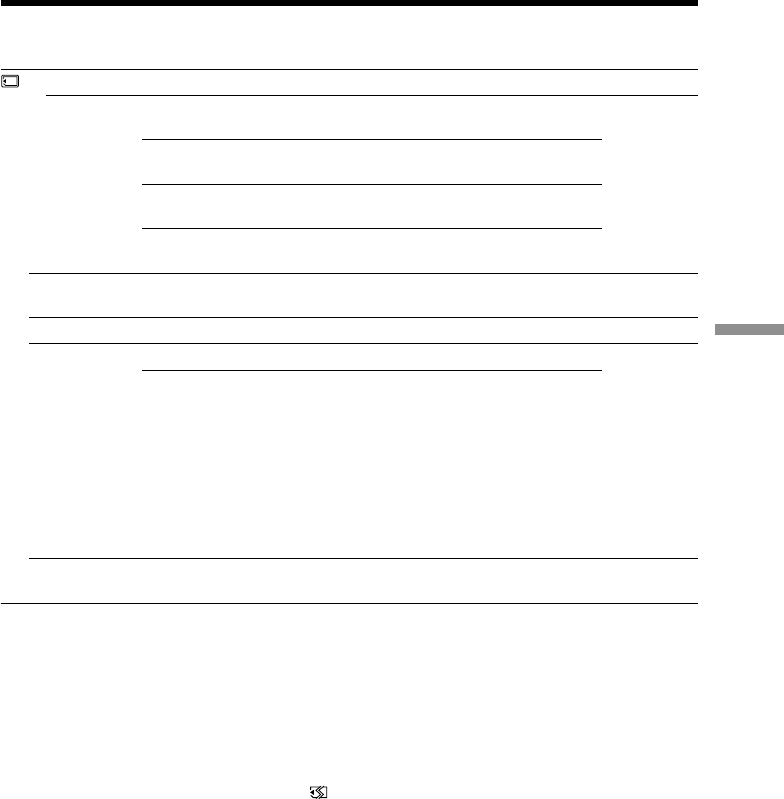
Customizing Your Camcorder
105
Changing the menu settings
Icon/item
*MOVIE SET
MOVIEMODE
SLIDE SHOW
DELETE ALL
FORMAT
PHOTO SAVE
Mode
zSUPER FINE
FINE
STANDARD
LIGHTMODE
——
——
zRETURN
OK
——
Meaning
To record moving pictures in the super fine
image quality.
To record moving pictures in the fine image
quality.
To record moving pictures in the standard
image quality.
To record moving pictures for e-mail
attachment.
To play back images in a continuous loop
(p. 154).
To delete all the unprotected images (p. 158).
To cancel formatting.
To format the inserted “Memory Stick.”
1. Select FORMAT, then press the center z on
the control button.
2. Select OK, then press the center z on the
control button.
3. After “EXECUTE” appears, select EXECUTE,
then press the center z on the control button.
“FORMATTING” flashes during formatting.
“COMPLETE” appears when formatting is
finished.
To duplicate still images on the tape onto the
“Memory Stick” (p. 140).
POWER
switch
MEMORY
VCR
MEMORY
MEMORY
MEMORY
VCR
* DCR-IP7/IP7BT only
Notes on formatting (DCR-IP7/IP7BT only)
•The “Memory Stick” supplied with your camcorder has been formatted at factory.
Formatting with your camcorder is not required.
•Do not slide the POWER switch or press any button while “FORMATTING” is
displayed.
•You cannot format the “Memory Stick” if its write-protect switch is set to LOCK.
•Format the “Memory Stick” if “ FORMAT ERROR” appears.
Formatting erases all information on the “Memory Stick” (DCR-IP7/IP7BT only)
Check the contents of the “Memory Stick” before formatting.
• Formatting erases sample images on the “Memory Stick.”
• Formatting erases the protected image data on the “Memory Stick.”
(continued on the following page)
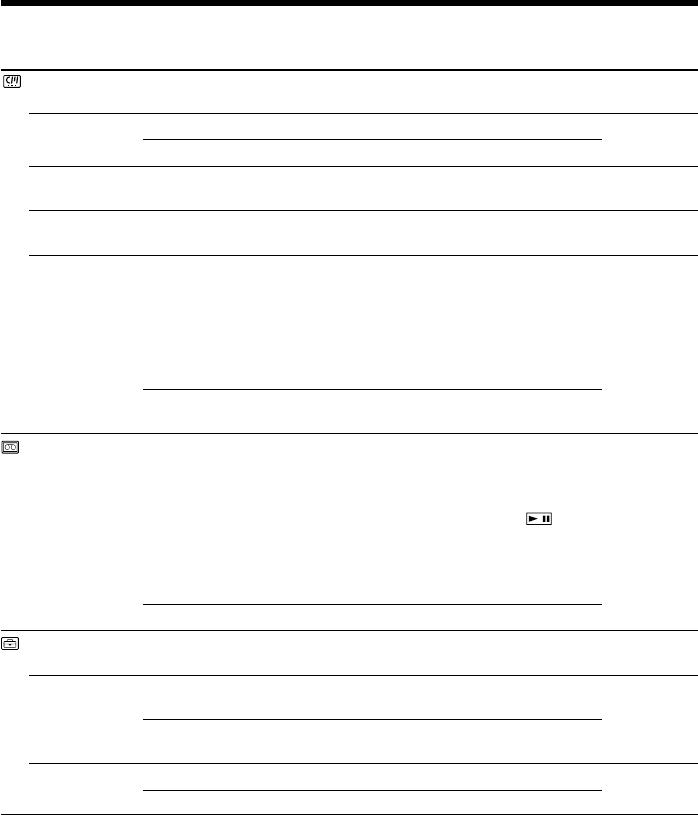
106
Changing the menu settings
Icon/item
TITLEERASE
TITLE DSPL
TAPE TITLE
ERASE ALL
q INFODSPL
qREMAIN
CLOCK SET
LTR SIZE
DEMO MODE
Mode
——
zON
OFF
——
——
zON
OFF
zAUTO
ON
——
zNORMAL
2×
zON
OFF
Meaning
To erase the superimposed title (p. 102).
To display the superimposed title.
To not display the title.
To label a cassette (p. 103)
To erase all the data in the MICRO cassette
memory (p. 104).
To display its cassette information of the tape.
This is displayed for 5 seconds in the following
cases: (p. XX).
•When turning on the power with a cassette
inserted or inserting a cassette.
•When entering the VCR mode using the
POWER switch.
To not display its cassette information of the
tape.
To display the remaining tape bar:
•for about 8 seconds after your camcorder is
turned on or a cassette is inserted, and
calculates the remaining amount of tape.
•for about 8 seconds after you select and
pressing the center z on the control button or
DISPLAY is pressed to display the screen
indicators.
•During fast-forwarding or rewinding the tape.
To always display the remaining tape indicator.
To set the date or time (p. 17).
To display the selected menu item in normal
size.
To display the selected menu item at twice the
normal size.
To make the demonstration appear.
To cancel the demonstration mode.
POWER
switch
CAMERA
VCR
VCR
CAMERA
VCR
CAMERA
VCR
CAMERA
VCR
CAMERA
VCR
CAMERA
MEMORY
CAMERA
MEMORY
VCR
CAMERA
Notes on DEMO MODE
•You cannot select DEMO MODE when a cassette is inserted in your camcorder.
•DEMO MODE is set to STBY (Standby) at the default setting and the demonstration
starts about 10 minutes after you have set the POWER switch to CAMERA without a
cassette inserted.
To cancel the demonstration, insert a cassette, set the POWER switch to the positions
other than CAMERA, or set DEMO MODE to OFF. To set to STBY (Standby) again,
leave the DEMO MODE to ON in the menu settings, set the POWER switch to OFF
(CHG), and slide the POWER switch to CAMERA.

Customizing Your Camcorder
107
Changing the menu settings
Icon/item
DATA CODE*
AREA SET
DLS
BEEP
COMMANDER
DISPLAY
REC LAMP
Mode
zDATE/CAM
DATE
——
zOFF
ON
zMELODY
NORMAL
OFF
zON
OFF
zLCD
V-OUT/LCD
zON
OFF
Meaning
To display date, time and various settings
during playback.
To display date and time during playback.
To set your area, now using the camcorder,
temporarily (p. XX).
To select when your area is not in daylight
saving time.
To set when your area is in daylight saving time.
To output the melody when you start/stop
recording or when an unusual condition occurs
on your camcorder.
To output the beep instead of the melody.
To cancel the melody and beep sound.
To activate the Remote Commander supplied
with your camcorder.
To deactivate the Remote Commander to avoid
remote control misoperation caused by other
VCR’s remote control.
To show the indicators on the LCD screen and
viewfinder.
To show the indicators on the TV screen, LCD
screen and viewfinder.
To light up the camera recording lamp at the
front of your camcorder.
To turn the camera recording lamp off so that
the subject is not aware of your recording.
POWER
switch
MEMORY
VCR
CAMERA
MEMORY
CAMERA
MEMORY
CAMERA
MEMORY
VCR
CAMERA
MEMORY
VCR
CAMERA
MEMORY
VCR
CAMERA
MEMORY
* Using the Remote Commander only
Note
If you press DISPLAY with “DISPLAY” set to “V-OUT/LCD” in the menu settings, the
picture from the TV or VCR will not appear on the screen even when your camcorder is
connected to outputs on the TV or VCR.
Even if the power source is detached from the camcorder
The menu items setting will be retained even if you remove the power source.
When recording a close subject
When REC LAMP is set to ON, the red camera recording lamp on the front of the
camcorder may reflect on the subject if it is too close. In this case, we recommend you
set REC LAMP to OFF.
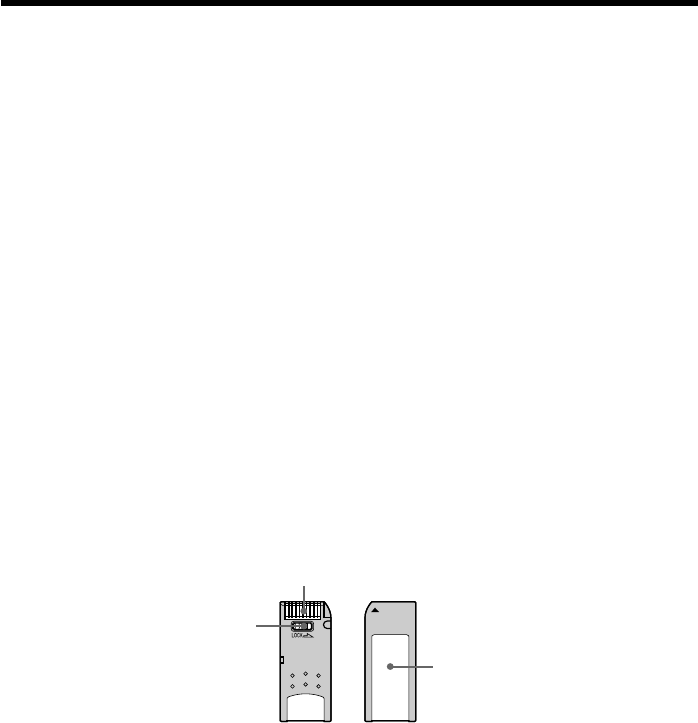
108
– DCR-IP7/IP7BT only
You can record an image onto the “Memory Stick” and easily play it back on your
camcorder. The following functions are also available using the “Memory Stick.”
•To capture the image recorded on the tape using the “Memory Stick.”
•To duplicate the image recorded on the “Memory Stick” onto the tape.
•To duplicate the image to your computer via the supplied USB cable.
•To delete an image, protect an image, and write the print mark.
On file format
Still image (JPEG)
Your camcorder compresses image data in the JPEG format (file extension .jpg).
Moving picture (MPEG)
Your camcorder compresses picture data in the MPEG format (file extension .mpg).
Typical image data file name
Still image
100-0001: This file name appears on the screen of your camcorder.
Dsc00001.jpg: This file name appears on the display of your computer.
Moving picture
MOV10001: This file name appears on the screen of your camcorder.
Mov10001.mpg: This file name appears on the display of your computer.
Using a “Memory Stick”
•You cannot record or erase images when the write-protect switch on the “Memory
Stick” is set to LOCK.
•The position and shape of the write protect switch may be different depending on the
model.
•We recommend backing up important data.
•Image data may be damaged in the following cases:
–If you remove the “Memory Stick,” turn the power off or detach the battery for
replacement when the access lamp is flashing.
–If you use “Memory Stick”s near magnets or magnetic fields such as those of
speakers and televisions.
Terminal
Write-protect
switch Labeling position
— “Memory Stick” Operations —
Using a “Memory Stick” – introduction

109
“Memory Stick” Operations
Using a “Memory Stick” – introduction
•Prevent metallic objects or your finger from coming into contact with the metal parts
of the connecting section.
•Stick its label on the labeling position.
•Do not bend, drop or apply strong shock to “Memory Stick”s.
•Do not disassemble or modify “Memory Stick”s.
•Do not let “Memory Stick”s get wet.
•Do not use or keep “Memory Stick”s in locations that are:
–Extremely hot such as in a car parked in the sun or under the scorching sun.
–Under direct sunlight.
–Very humid or subject to corrosive gases.
•When you carry or store a “Memory Stick,” put it in its case.
“Memory Stick”s formatted by a computer
“Memory Stick”s formatted by Windows OS or Macintosh computers do not have a
guaranteed compatibility with this camcorder.
Notes on image data compatibility
•Image data files recorded on “Memory Stick”s by your camcorder conform with the
Design rule for Camera File system universal standard established by the JEITA
(Japan Electronics and Information Technology Industries Association).
On your camcorder, you cannot play back still images recorded on other equipment
(DCR-TRV890E/TRV900/TRV900E or DSC-D700/D770) that does not conform to this
universal standard. (These models are not sold in some areas.)
•If you cannot use the “Memory Stick” that is used with other equipment, format it
with this camcorder (p. 109). However, formatting erases all information on the
“Memory Stick.”
“Memory Stick” and are trademarks of Sony Corporation.
•Windows and Windows Media are either registered trademarks or trademarks of
Microsoft Corporation in the United States and/or other countries.
•Macintosh and Mac OS, QuickTime are trademarks of Apple Computer, Inc.
•The Bluetooth trademarks are owned by their proprietor and used by Sony
Corporation under license.
•All other product names mentioned herein may be the trademarks or registered
trademarks of their respective companies.
Furthermore, “” and “” are not mentioned in each case in this manual.
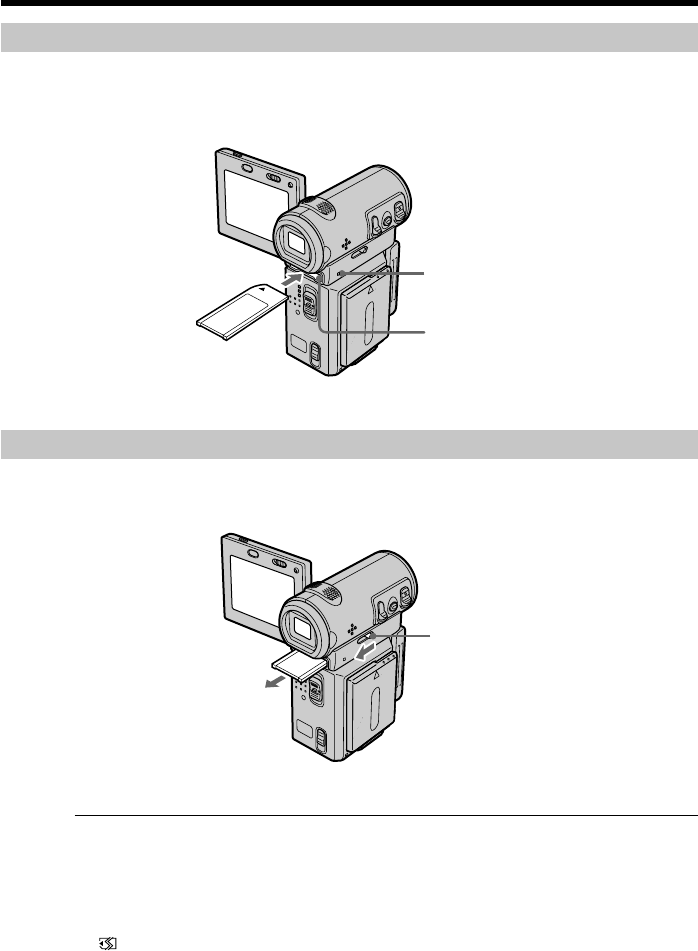
110
Inserting a “Memory Stick”
Insert a “Memory Stick” in the “Memory Stick” slot as far as it can go with the v mark
facing up as illustrated.
Ejecting the “Memory Stick”
Slide the MEMORY EJECT lever in the direction of the arrow.
While the access lamp is lit or flashing
Do not shake or strike your camcorder because your camcorder is reading the data from
the “Memory Stick” or recording the data on the “Memory Stick.” Do not turn the
power off , eject a “Memory Stick” or remove the battery pack. Otherwise, the image
data breakdown may occur.
If “ MEMORYSTICK ERROR” is displayed
Remove the “Memory Stick,” then insert it again. If the message is indicated, the
“Memory Stick” may be corrupted. Use another “Memory Stick.”
Using a “Memory Stick” – introduction
“Memory Stick” slot
Access lamp
MEMORY EJECT
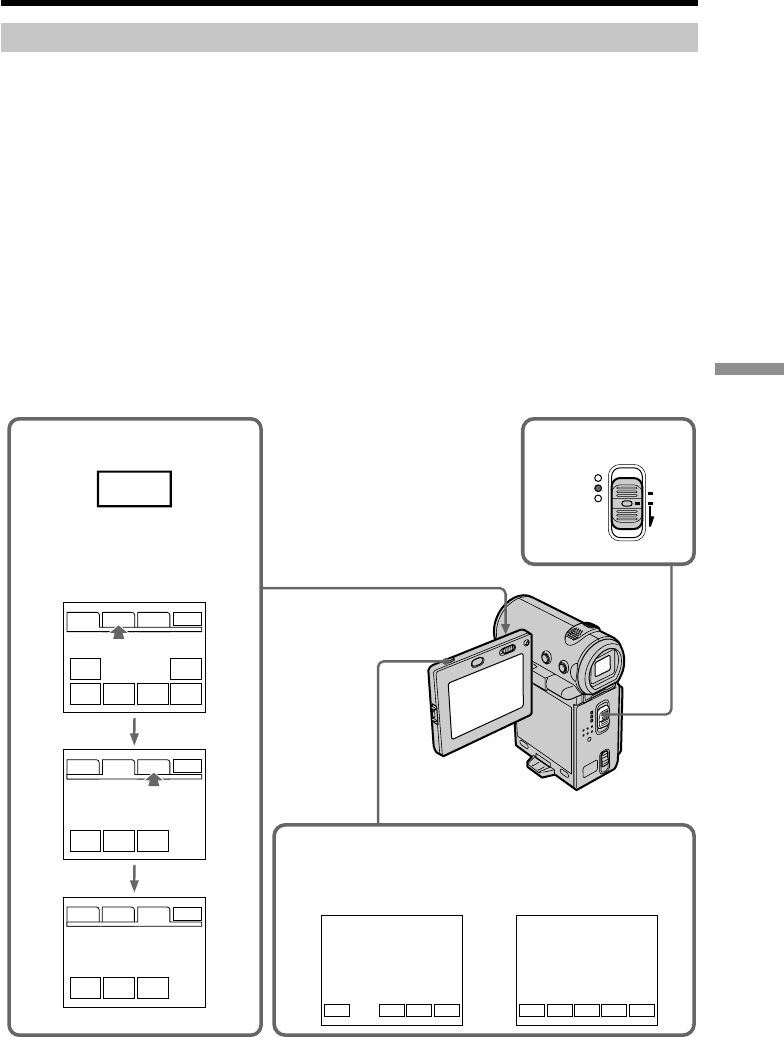
111
“Memory Stick” Operations
FN 1
3–6
2
FNINDEXPLAY FNINDEXCAM
SELF
TIMER PLAY INDEX EXPO–
SURE
FOCUSMENU
LCD
BRT PLAY INDEX
PLAY INDEX
NETWORK
+–
PAGE1 PAGE2 PAGE3
PAGE1 PAGE2 PAGE3
VOL
PAGE1 PAGE2 PAGE3
EXIT
EXIT
EXIT
MEMORY/
NETWORK
VCR
CAMERA (CHG)
POWER
OFF
ON
MODE
Using a “Memory Stick” – introduction
Using a button displayed on the screen
Your camcorder has operation buttons on the screen. Use the control button to operate
the buttons on the screen.
(1)Set the POWER switch to MEMORY.
(2)Press OPEN to open the LCD panel. Operation buttons appear on the LCD
screen. You can switch the memory playback/memory camera mode by
selecting PLAY/CAM.
(3)Select FN, then press the center z on the control button. The PAGE1 screen
appears. Operation buttons appear on the screen.
(4)Select PAGE2, then press the center z on the control button. The PAGE2
screen appears. Operation buttons appear on the screen.
(5)Select PAGE3, then press the center z on the control button. The PAGE3
screen appears. Operation buttons appear on the screen.
(6)Select a desired operation item, then press the center z on the control button.
Refer to relevant pages for each function.
In memory camera
mode
In memory camera
mode
In memory playback
mode (still image)
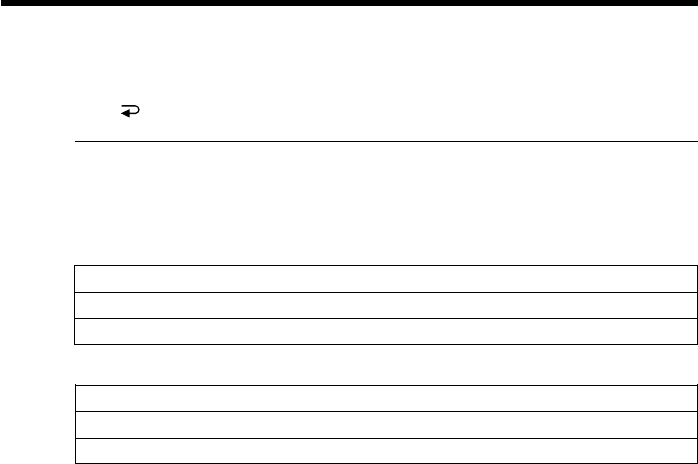
112
To return to the FN screen
Select EXIT, then press the center z on the control button.
To execute settings
Select OK, then press the center z on the control button.
If the item is not available
The color of the item changes to gray.
Select FN, then press the center z on the control button to display the following
buttons:
In memory camera mode
PAGE1 MENU, SELF TIMER, PLAY, INDEX, EXPOSURE, FOCUS
PAGE2 LCD BRT, PLAY, INDEX
PAGE3 VOL, PLAY, INDEX
In memory playback mode
PAGE1 MENU, CAM, INDEX, DELETE, +, –
PAGE2 LCD BRT, CAM, INDEX, PB ZOOM, +, –
PAGE3 DATA CODE, CAM, INDEX, +, –
Using a “Memory Stick” – introduction
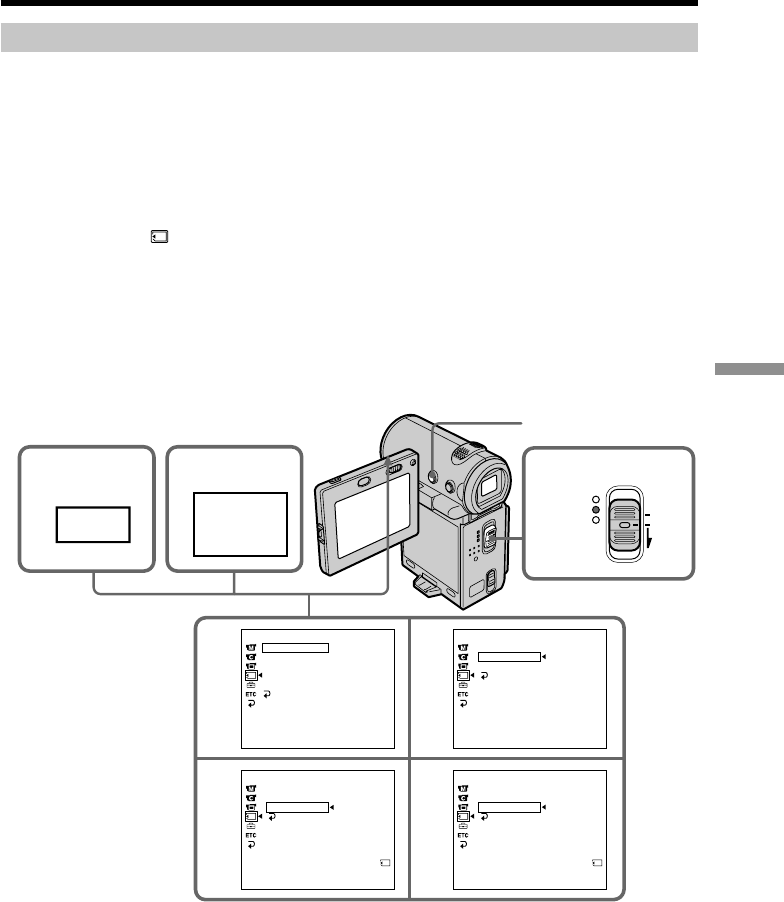
113
“Memory Stick” Operations
Using a “Memory Stick” – introduction
Selecting the still image quality mode
You can select the image quality mode for still image recording. The default setting is
FINE.
(1)Set the POWER switch to MEMORY.
(2)Select FN, then press the center z on the control button. The PAGE1 screen
appears.
(3)Select MENU, then press the center z on the control button. The menu
appears.
(4)Select , then press the center z or B on the control button.
(5)Select STILL SET, then press the center z or B on the control button.
(6)Select QUALITY, then press the center z or B on the control button.
(7)Select the desired image quality mode, then press the center z on the control
button.
(8)Press DISPLAY to turn off the menu.
2
FN
3
4
MEMORY SET
STILL SET
MOVIE SET
SLIDE SHOW
DELETE ALL
FORMAT
RETURN
5
MEMORY SET
STILL SET
PIC MODE
QUALITY
RETURN
SINGLE
6
MEMORY SET
STILL SET
PIC MODE
QUALITY
RETURN
7
MEMORY SET
STILL SET
PIC MODE
QUALITY
RETURN STANDARD
REMAIN
8
FINE
REMAIN
5
1
8
MENU
MEMORY/
NETWORK
VCR
CAMERA (CHG)
POWER
OFF
ON
MODE
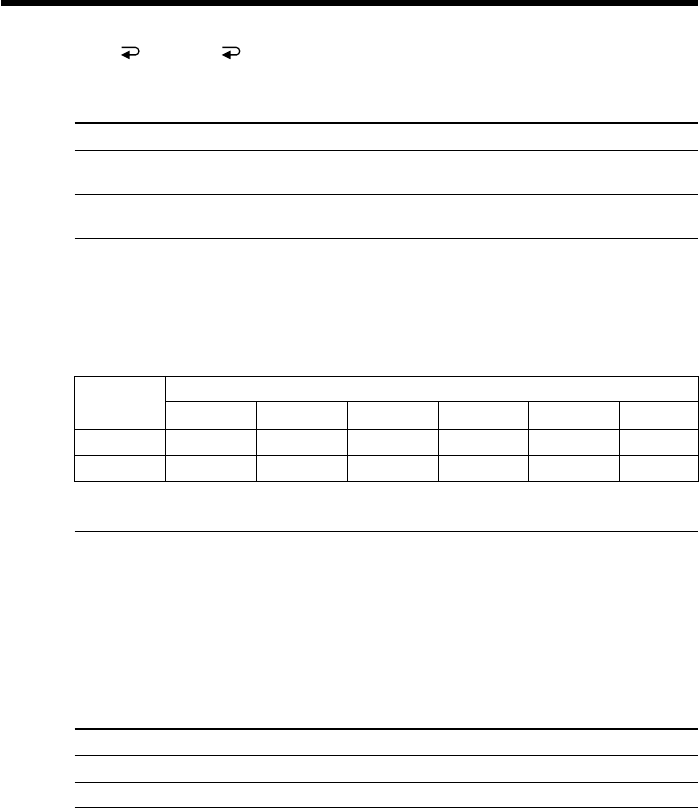
114
Using a “Memory Stick” – introduction
To return to the FN screen
Select RETURN, , then press the center z on the control button after step 7. The
PAGE1 screen appears. Next, select EXIT, then press the center z on the control button.
Image quality settings
Setting Meaning
FINE Use this mode when you want to record high quality images.
(Indicator: FINE) The image is compressed to about 1/6.
STANDARD This is the standard image quality. The image is compressed
(Indicator: STD) to about 1/10.
Approximate number of still images you can record on a
“Memory Stick”
The number of images you can record varies depending on which image quality mode
you select. The table below indicates the recordable numbers when using the “Memory
Stick” formatted with this camcorder.
Quality “Memory Stick”
128 MB* 64 MB* 32 MB* 16 MB* 8 MB* 4 MB
FINE 1310 images 650 images 325 images 160 images 80 images 39 images
STANDARD
1970 images 980 images 485 images 240 images 120 images 58 images
* Optional
Note
In some cases, changing the image quality mode may not affect the image quality,
depending on the types of images you are shooting.
Differences in image quality mode
Recorded images are compressed in the JPEG format before being stored in memory.
The memory capacity allotted to each image varies depending on the selected image
quality mode. Details are shown in the table below. (The image size is 640 × 480,
regardless of image quality mode. The data size before compression is about 600 KB.)
Image quality mode Memory capacity
FINE (FINE) About 100 KB
STANDARD (STD) About 60 KB
Image quality mode indicator
The image quality mode indicator is not displayed during playback.
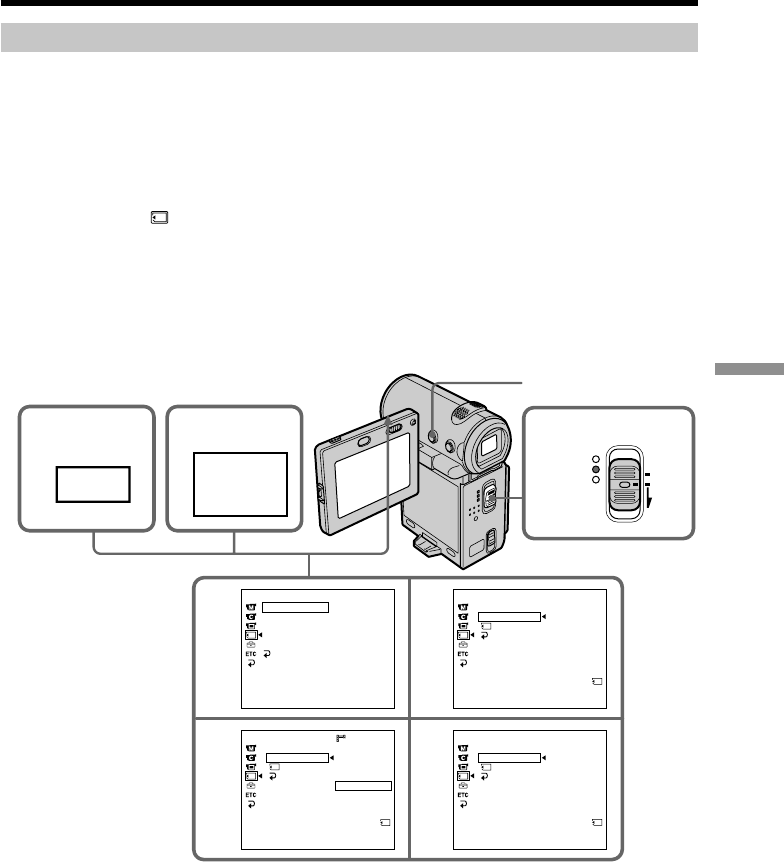
115
“Memory Stick” Operations
Using a “Memory Stick” – introduction
Setting the moving picture quality mode
You can select the moving picture quality mode. The default setting is SUPER FINE.
(1)Set the POWER switch to MEMORY.
(2)Select FN, then press the center z on the control button. The PAGE1 screen
appears.
(3)Select MENU, then press the center z on the control button. The menu
appears.
(4)Select , then press the center z or B on the control button.
(5)Select MOVIE SET, then press the center z or B on the control button.
(6)Select MOVIEMODE, then press the center z or B on the control button.
(7)Select the desired movie mode, then press the center z on the control button.
(8)Press DISPLAY to turn off the menu.
2
FN
3
4
MEMORY SET
STILL SET
MOVIE SET
SLIDE SHOW
DELETE ALL
FORMAT
RETURN
5
MEMORY SET
MOVIE SET
MOVIEMODE
REMAIN
RETURN
LIGHTMODE
REMAIN
18sec
6
MEMORY SET
MOVIE SET
MOVIEMODE
REMAIN
RETURN
7
1
MENU
MEMORY SET
MOVIE SET
MOVIEMODE
REMAIN
RETURN
SUPER FINE
REMAIN
8sec
SUPER FINE
FINE
STANDARD
LIGHTMODE
REMAIN
18sec
LIGHT
MEMORY/
NETWORK
VCR
CAMERA (CHG)
POWER
OFF
ON
MODE
8
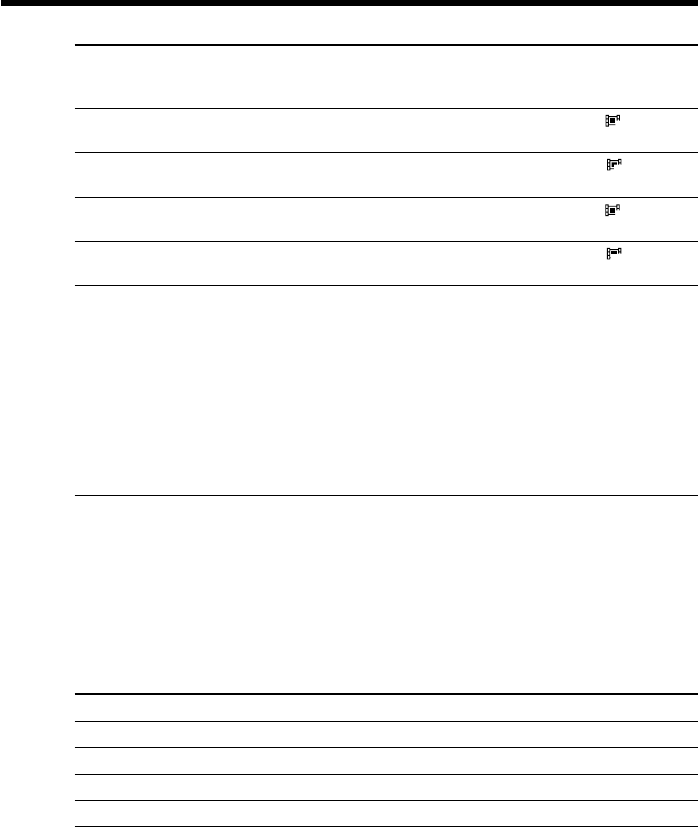
116
Using a “Memory Stick” – introduction
Image quality settings
Setting
SUPER FINE
(Indicator: SFN)
FINE
(Indicator: FINE)
STANDARD
(Indicator: STD)
LIGHTMODE
(Indicator: LIGHT)
SUPER FINE: You can record a moving pictures in most highly quality. This mode is
suitable when you will modify the pictures using your computer. SUPER FINE is the
default setting of the camcorder.
FINE: You can record a moving picture for longer time than the SUPER FINE mode, the
quality, however, slightly declines.
STANDARD: You can record a moving picture for longer time than the FINE mode, the
image size, however, is smaller one.
LIGHTMODE: Since the file size is small, this mode is suitable for e-mail transmission.
The image quality, however, declines.
Note on frame mode
A moving picture consists of continuous still images. Frame rate indicates the number
of images played back for a second. The more the number increases, the more the
moving picture becomes natural in movement.
Note on transmission rate
The higher the transmission rate, the more the moving picture becomes natural in
movement.
Maximum recording time of moving pictures
Image quality mode Maximum recording time
SUPER FINE 45 s
FINE 1 min 10 s
STANDARD 2 min 20 s
LIGHTMODE 4 min 40 s
Meaning
Records 352 × 240 moving
pictures.
Records 352 × 240 moving
pictures.
Records 144 × 96 moving
pictures.
Records 144 × 96 moving
pictures.
Frame
rate
30 fps
30 fps
10 fps
10 fps
Transmission
rate (image
and audio)
1200 Kbps
750 Kbps
400 Kbps
200 Kbps
Indicator
(during
playback)
SFN
FINE
STD
LIGHT
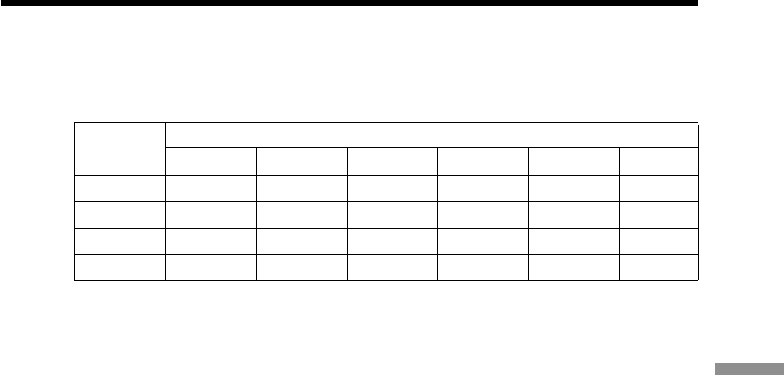
117
“Memory Stick” Operations
Using a “Memory Stick” – introduction
Approximate time of moving pictures you can record on a
“Memory Stick”
The table below indicates the recordable time when using the “Memory Stick”
formatted with this camcorder.
Quality “Memory Stick”
128 MB* 64 MB* 32 MB* 16 MB* 8 MB* 4 MB
SUPER FINE
13 min 6 min 3 min 1 min 45 s 20 s
FINE 20 min 10 min 5 min 2 min 1 min 35 s
STANDARD
41 min 20 min 10 min 5 min 2 min 1 min
LIGHTMODE
82 min 41 min 20 min 10 min 5 min 2 min
* Optional
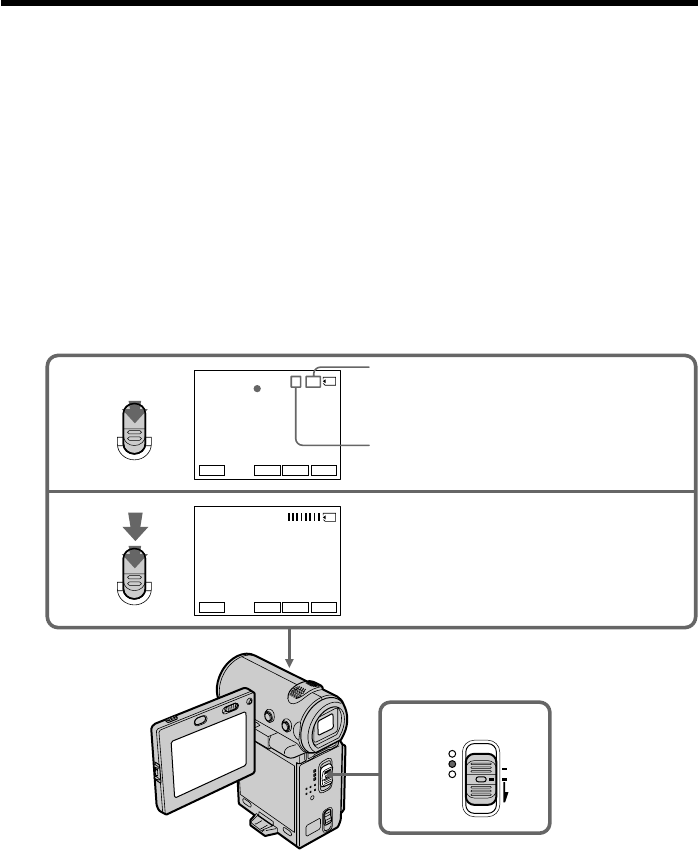
118
3
2
FINE
FINE
FN
INDEXPLAY
FN
INDEXPLAY
NETWORK
NETWORK
1 / 12
MEMORY/
NETWORK
VCR
CAMERA (CHG)
POWER
OFF
ON
MODE
1
PHOTO
PHOTO
Approximate number of images
recordable on the “Memory Stick.”
Number of recorded images.
Recording still images on a “Memory
Stick” – Memory Photo recording
– DCR-IP7/IP7BT only
You can record still images on a “Memory Stick.” You can also record nine still images
continuously. (MULTI SCRN)
Before operation
Insert the “Memory Stick” into your camcorder.
(1)Set the POWER switch to MEMORY.
(2)Keep pressing PHOTO lightly. The green z mark stops flashing, then lights
up. The brightness of the image and focus are adjusted, being targeted for the
middle of the image and are fixed. Recording does not start yet.
(3)Press PHOTO deeper. The image displayed on the screen will be recorded on
the “Memory Stick.” Recording is complete when the bar scroll indicator
disappears.

119
“Memory Stick” Operations
Recording still images on a “Memory Stick”
– Memory Photo recording
When the POWER switch is set to MEMORY
The following functions do not work:
–Wide mode
–Digital zoom
–SteadyShot function
–Fader
–Picture effect
–Digital effect
–Title
–Low lux mode of PROGRAM AE (The indicator flashes.)
While you are recording a still image
You can neither turn off the power nor press PHOTO.
When you press PHOTO on the Remote Commander
Your camcorder immediately records the image displayed on the screen when you
press the button.
When recording a still image in step 2
The image momentarily flickers. This is not a malfunction.
Recording data
The recording data (date/time or various settings when recorded) are not displayed
while recording. However, they are automatically recorded onto the “Memory Stick.”
To display the recording data, press DATA CODE on the Remote Commander. When
using the camcorder for this operation, select CAM DATA or DATE DATA, then press
the center z on the control button, through DATA CODE on the PAGE3 screen (p. 36).
The number of still images recordable on the “Memory Stick”
It varies according to the image quality mode and the complexity of the subject.
Recording images continuously
You can record still images continuously. Select the multi screen mode described below
before recording.
Multi screen mode
Your camcorder shoots nine still images at about 0.5 sec intervals and displays the
images on a single page divided into 9 boxes. ( Indicator: )
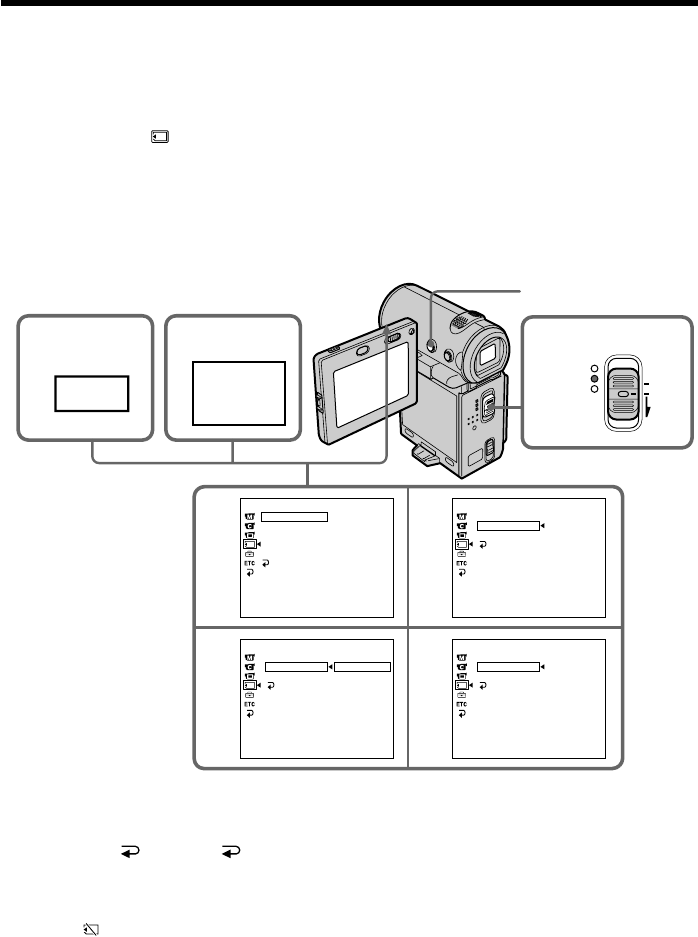
120
Recording still images on a “Memory Stick”
– Memory Photo recording
(1)Set the POWER switch to MEMORY.
(2)Select FN, then press the center z on the control button. The PAGE1 screen
appears.
(3)Select MENU, then press the center z on the control button. The menu
appears.
(4)Select , then press the center z or B on the control button.
(5)Select STILL SET, then press the center z or B on the control button.
(6)Select PIC MODE, then press the center z or B on the control button.
(7)Select MULTI SCRN, then press the center z on the control button.
(8)Press DISPLAY to turn off the menu.
To return to the FN screen
Select RETURN, , then press the center z on the control button after step 7. The
PAGE1 screen appears. Next, select EXIT, then press the center z on the control button.
If the capacity of the “Memory Stick” becomes full
“ FULL” appears on the screen, and you cannot record still images on this “Memory
Stick.”
2
FN
3
4MEMORY SET
STILL SET
MOVIE SET
SLIDE SHOW
DELETE ALL
FORMAT
RETURN
5MEMORY SET
STILL SET
PIC MODE
QUALITY
RETURN
SINGLE
6MEMORY SET
STILL SET
PIC MODE
QUALITY
RETURN 7MEMORY SET
STILL SET
PIC MODE
QUALITY
RETURN
MULTI SCRNSINGLE
MULTI SCRN
1
MENU
8
MEMORY/
NETWORK
VCR
CAMERA (CHG)
POWER
OFF
ON
MODE
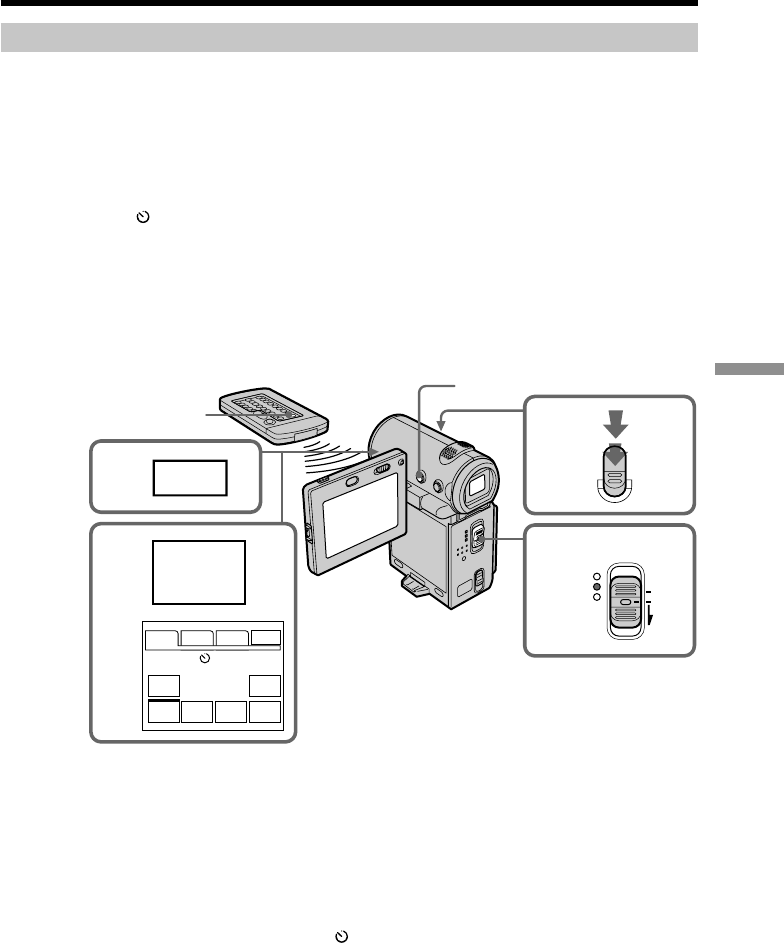
121
“Memory Stick” Operations
5
4
PHOTO
1
2FN
3
MEMORY/
NETWORK
VCR
CAMERA (CHG)
POWER
OFF
ON
MODE
PAGE1 PAGE2 PAGE3
EXIT
MENU FOCUS
SELF
TIMER PLAY INDEX EXPO–
SURE
SELF
TIMER
Recording still images on a “Memory Stick”
– Memory Photo recording
Self-timer memory photo recording
You can record images on a “Memory Stick” with the self-timer. You can also use the
Remote Commander for this operation.
(1)Set the POWER switch to MEMORY.
(2)Select FN, then press the center z on the control button. The PAGE1 screen
appears.
(3)Select SELF TIMER, then press the center z on the control button.
The (self-timer) indicator appears on the screen.
(4)Press DISPLAY to turn off the screen buttons.
(5)Press PHOTO firmly.
Self-timer starts counting down from 10 with a beep sound. In the last 2
seconds of the countdown, the beep sound gets faster, then recording starts
automatically.
To record moving pictures on a “Memory Stick” with the self-
timer
Press START/STOP in step 5. To stop the recording, press START/STOP again.
To cancel the self-timer recording
Select SELF TIMER on the PAGE1 screen, then press the center z on the control button
before the shutter is fired so that the (self-timer) indicator disappears from the
screen. You cannot cancel the self-timer recording using the Remote Commander.
PHOTO

122
Recording still images on a “Memory Stick”
– Memory Photo recording
Note
The self-timer recording mode is automatically canceled when:
–The self-timer recording is finished.
–The POWER switch is set to OFF (CHG) or VCR.
To check the image to be recorded
You can check the image by pressing PHOTO on the camcorder lightly, then press it
deeper to start the self-timer recording.
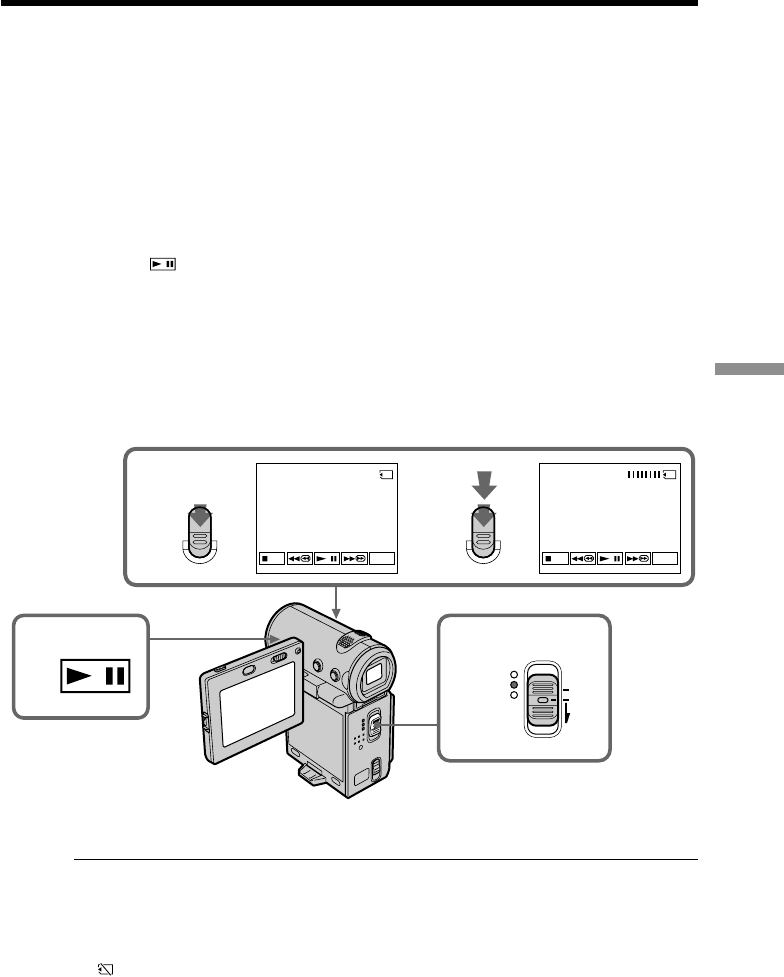
123
“Memory Stick” Operations
Recording an image from a tape as a still
image
– DCR-IP7/IP7BT only
Your camcorder can read moving picture data recorded on a tape and record it on a
“Memory Stick” as a still image.
Your camcorder can also take in moving picture data through the input jack and record
it as a still image on a “Memory Stick.”
Before operation
•Insert the recorded tape into your camcorder.
•Insert the “Memory Stick” into your camcorder.
(1)Set the POWER switch to VCR.
(2)Select , then press the center z on the control button. The picture recorded
on the tape is played back.
(3)Keep pressing PHOTO lightly until the picture from the tape freezes.
“CAPTURE” appears on the screen. Recording does not start yet.
(4)Press PHOTO deeper. The image displayed on the screen will be recorded on
the “Memory Stick.” Recording is complete when the bar scroll indicator
disappears.
When the access lamp is lit or flashing
Do not shake or strike the camcorder. As well do not turn the power off , eject the
“Memory Stick” or remove the battery pack. Otherwise, the image data breakdown may
occur.
If “ ” appears on the screen
The inserted “Memory Stick” is incompatible with your camcorder because its format
does not conform with your camcorder. Check the format of the “Memory Stick.”
2
34
1 / 40
CAPTURE
FN FN
FINE FINE
PHOTO PHOTO
1
MEMORY/
NETWORK
VCR
CAMERA (CHG)
POWER
OFF
ON
MODE
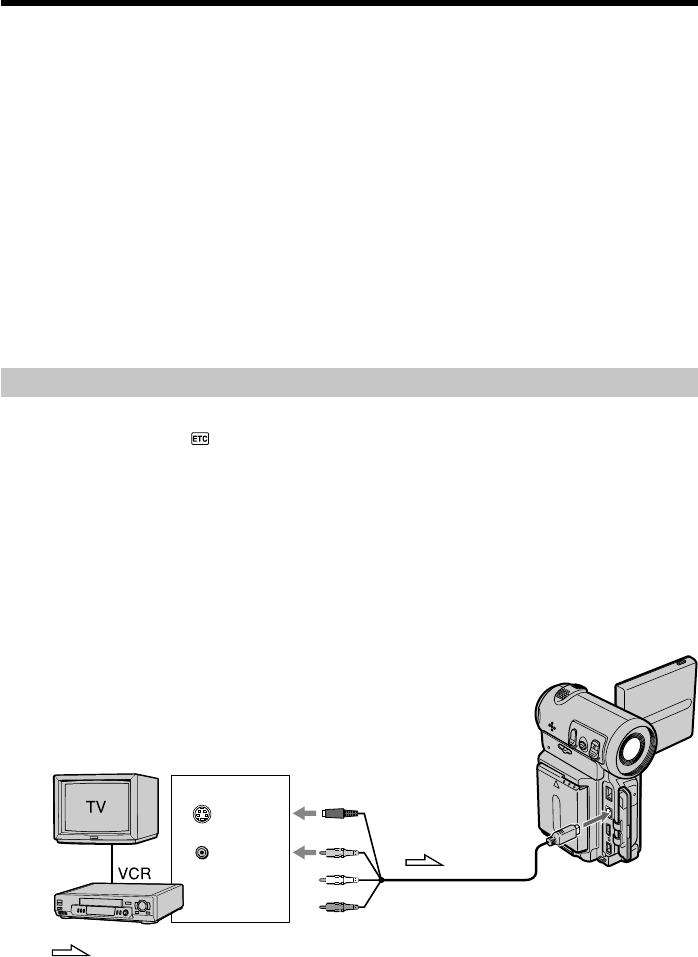
124
If you press PHOTO lightly in the playback mode
Your camcorder stops momentarily.
Sound recorded on the tape
You cannot record the audio from the tape.
Titles which have already been recorded on tapes
You cannot record the titles on “Memory Stick”s. The title does not appear while you
are recording a still image with PHOTO.
Recording date/time
The date/time when it is recorded on the “Memory Stick” is recorded. Various settings
are not recorded.
When you press PHOTO on the Remote Commander
Your camcorder immediately records the image that is on the screen when you press
the button.
Recording a still image from other equipment
Before operation
Set DISPLAY in to LCD in the menu settings (p. 105). (The default setting is LCD.)
(1)Set the POWER switch to VCR.
(2)When using the A/V connecting cable, set VIDEOINPUT to the appropriate
position depending on the player (p. XX).
(3)Play back the recorded tape.
The image of the other equipment is displayed on the screen.
(4)Follow the steps 3 and 4 on page 126.
Using the A/V connecting cable
Connect the yellow or black plug of the A/V connecting cable to the video or S video
jack on the VCR.
S VIDEO
VIDEO
OUT
Recording an image from a tape as a still image
: Signal flow
A/V
S VIDEO or VIDEO
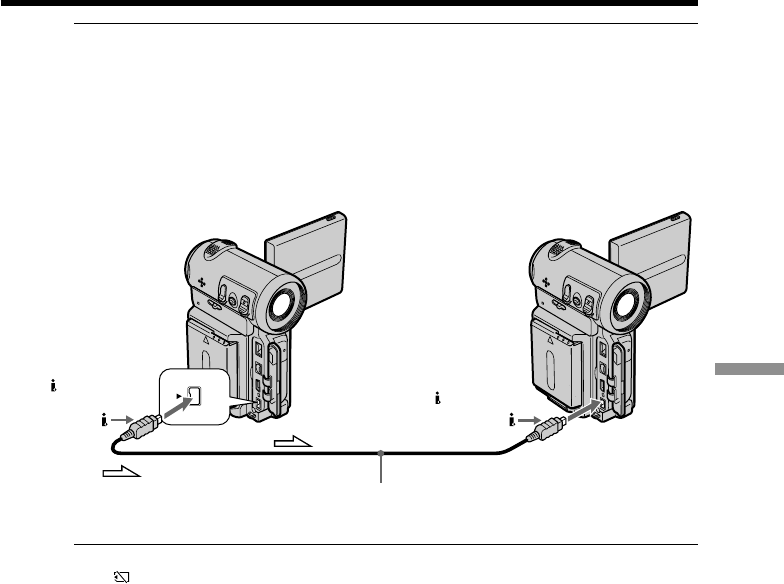
125
“Memory Stick” Operations
If your VCR has an S VIDEO jack
Connect using the S video plug to faithfully obtain original pictures. With this
connection, you do not need to connect the yellow (video) plug of the A/V connecting
cable. Connect the S video plug to the S video jack of the VCR. This connection
produces higher quality MICROMV format pictures.
Using the i.LINK cable
Note
The “ ” flashes in the following instances. If this happens, eject and insert “Memory
Stick” again, and record distortion-free images.
–When recording on a tape in a poor recording state, for example, on a tape that has
been repeatedly used for dubbing.
Recording an image from a tape as a still image
: Signal flow (supplied)
MICROMV
MICROMV
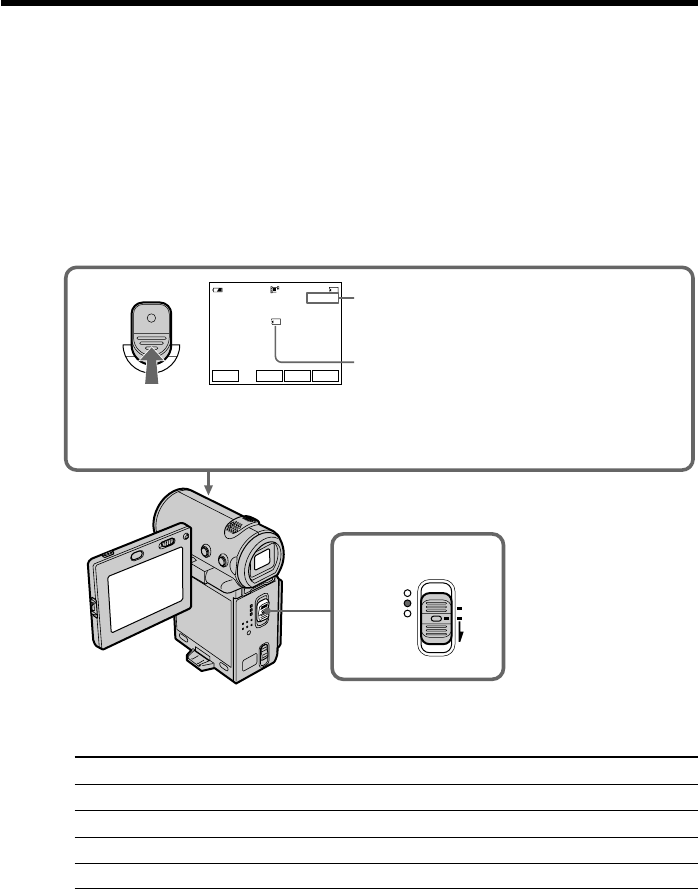
126
2
STD
40
REC
0:03
[45 ]
min
SEC
BBB
FN
INDEXPLAY
NETWORK
START/STOP
1
MEMORY/
NETWORK
VCR
CAMERA (CHG)
POWER
OFF
ON
MODE
Recordable time on the “Memory Stick.”
This indicator is displayed for 5 seconds after
pressing START/STOP. This indicator is not
recorded.
Recording moving pictures on “Memory
Stick”s – MPEG movie recording
– DCR-IP7/IP7BT only
You can record moving pictures with sound on “Memory Stick”s.
Before operation
Insert the “Memory Stick” into your camcorder.
(1)Set the POWER switch to MEMORY.
(2)Press START/STOP. Your camcorder starts recording. The camera recording
lamp located on the front of your camcorder lights up.
The recordable time of a MPEG movie
Quality mode recordable time
SUPER FINE Approx. 45 s
FINE Approx. 1 min 10 s
STANDARD Approx. 2 min 20 s
LIGHTMODE Approx. 4 min 40 s
To stop recording
Press START/STOP.

127
“Memory Stick” Operations
Recording moving pictures on “Memory Stick”s – MPEG movie
recording
Note
Sound is recorded in monaural.
When the POWER switch is set to MEMORY
The following functions do not work:
–Wide mode
–Digital zoom
–SteadyShot function
–Fader
–Picture effect
–Digital effect
–Title
–Low lux of PROGRAM AE (The indicator flashes.)
Recording date/time
The date/time are not displayed while recording. However, they are automatically
recorded onto the “Memory Stick.”
To display the recording date/time, press DATA CODE on the Remote Commander
during playback. Various settings cannot be recorded.
During recording on a “Memory Stick”
Do not eject the cassette tape from your camcorder. During ejecting the tape, sound is
not recorded on the “Memory Stick.”
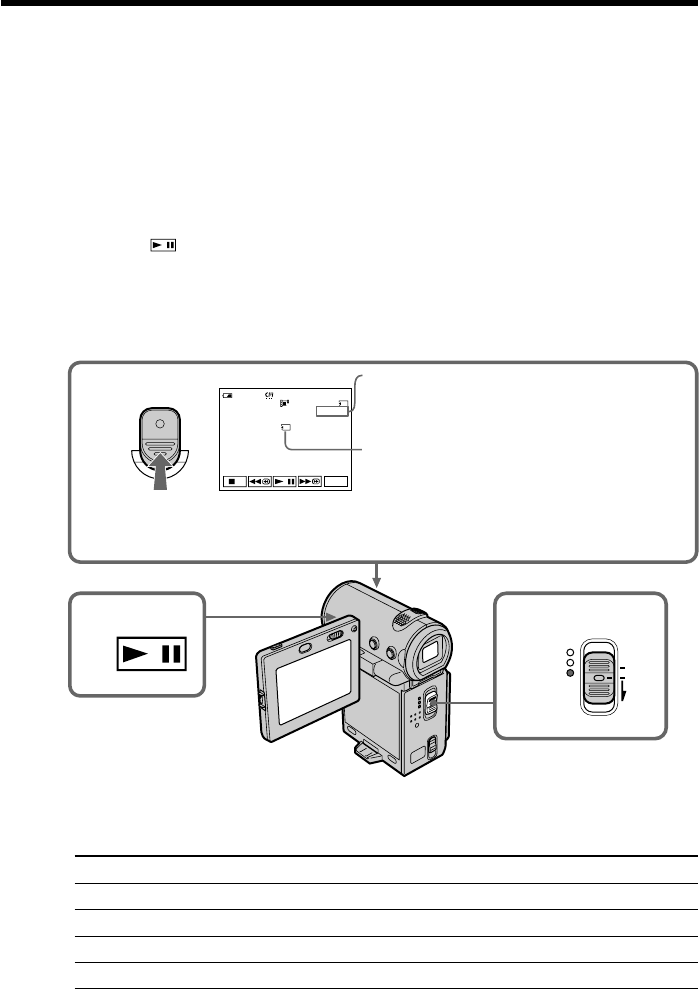
128
3
STD
40
REC
[15 ]
0:03
0:15:42
min
SEC
BBB
N
FN
21
START/STOP
MEMORY/
NETWORK
VCR
CAMERA (CHG)
POWER
OFF
ON
MODE
This indicator is displayed for 5 seconds after
pressing START/STOP. This indicator is not
recorded.
Recordable time on the “Memory Stick.”
Recording a picture from a tape as a
moving picture
– DCR-IP7/IP7BT only
Your camcorder can read moving picture data recorded on a tape and record it as a
moving picture on a “Memory Stick.” Your camcorder can also take in moving picture
data through the input jack and record it as a moving picture on a “Memory Stick.”
Before operation
•Insert the recorded tape into your camcorder.
•Insert the “Memory Stick” into your camcorder.
(1)Set the POWER switch to VCR.
(2)Select , then press the center z on the control button. The picture recorded
on the tape is played back.
(3)Press START/STOP at the scene where you want to start recording from. Your
camcorder starts recording.
The recordable time of a MPEG movie
Quality mode recordable time
SUPER FINE Maximum 45 s
FINE Maximum 1 min 10 s
STANDARD Maximum 2 min 20 s
LIGHTMODE Maximum 4 min 40 s

129
“Memory Stick” Operations
Recording a picture from a tape as a moving picture
To stop recording
Press START/STOP.
Note
Sound recorded in stereo is converted to monaural sound when recording from tapes.
When the access lamp is lit or flashing
Do not shake or strike the camcorder. As well do not turn the power off, eject the
“Memory Stick” or remove the battery pack. Otherwise, the image data breakdown may
occur.
Titles have already recorded on tapes
You cannot record the titles on “Memory Stick”s. The title does not appear while you
are recording a moving picture.
The data code recorded on the tape
This is not recorded on the “Memory Stick.” The camcorder records the new date and
time when the recording on the “Memory Stick” is made.
During recording
The video control buttons do not work.
Recording a moving picture from other equipment
Before operation
Set DISPLAY to LCD in the menu settings. (The default setting is LCD.)
(1)Set the POWER switch to VCR.
(2)When using the A/V connecting cable, set VIDEOINPUT to the appropriate
position depending on the player.
(3)Play back the recorded tape.
The image of the other equipment is displayed on the screen.
(4)Follow the procedure on page 131 from the steps 3 on wards at the point
where you want to start recording.
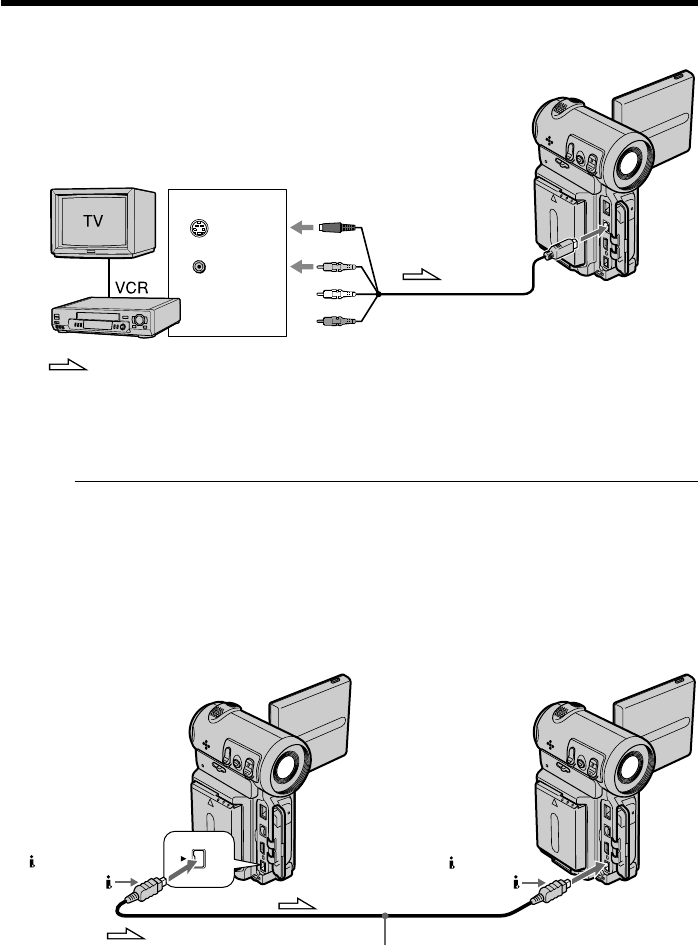
130
: Signal flow (supplied)
MICROMV
MICROMV
S VIDEO
VIDEO
OUT
: Signal flow
A/V
Using the A/V connecting cable
Connect the yellow or black plug of the A/V connecting cable to the video or S video
jack or the black plug of it to the S video jack on the VCR.
If your VCR has an S video jack
Connect using the S video plug to faithfully obtain original pictures. With this
connection, you do not need to connect the yellow (video) plug of the A/V connecting
cable. Connect the S video plug to the S video jack of the VCR. This connection
produces higher quality MICROMV format pictures.
Using the i.LINK cable
Recording a picture from a tape as a moving picture

131
“Memory Stick” Operations
Recording a picture from a tape as a moving picture
Note
The “ ” flashes in the following instances. If this happens, eject and insert “Memory
Stick” again, and record distortion-free images.
–When recording on a tape in a poor recording state, for example, on a tape that has
been repeatedly used for dubbing.
During recording on the “Memory Stick”
Do not eject the cassette tape from your camcorder. During ejecting the tape, sound is
not recorded on the “Memory Stick.”
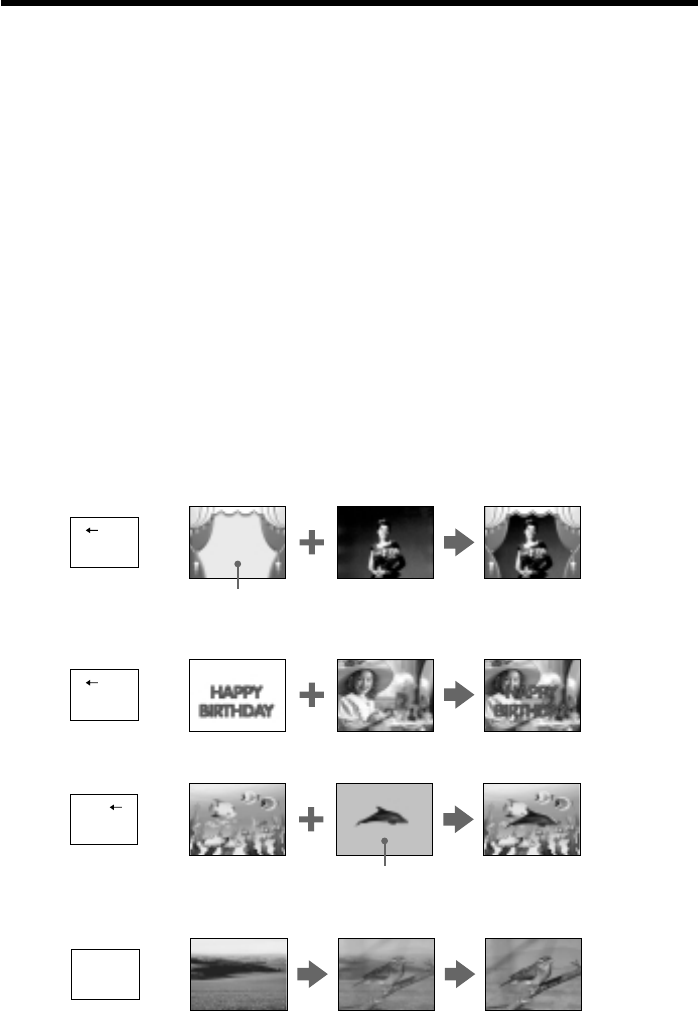
132
– DCR-IP7/IP7BT only
You can superimpose a still image you have recorded on a “Memory Stick” on top of
the moving picture you are recording.
You can record the superimposed images on a tape. However, you cannot record onto
any “Memory Stick.”
M. CHROM (Memory chromakey)
You can swap a blue area of a still image such as an illustration or a frame with a
moving picture.
M. LUMI (Memory luminancekey)
You can swap a brighter area of a still image such as a handwritten illustration or title
with a moving picture. Record a title on a “Memory Stick” before a trip or event for
convenience.
C. CHROM (Camera chromakey)
You can superimpose a moving picture on top of a still image such as an image which
can be used as background. Shoot the subject against a blue background. The blue area
of the moving picture will be swapped with a still image.
M.OVERLAP* (Memory overlap)
You can make a moving picture fade in on top of a still image.
* The superimposed image using Memory overlap function can be recorded on tapes
only.
C A M M
C H R O M
M C A M
C H R O M
M. CHROM Still image Moving picture
Blue
M. OVERLAP* Still image Moving picture
C. CHROM Still image Moving picture
Blue
M. LUMI Still image Moving picture
Superimposing a still image in a “Memory
Stick” on a moving picture – MEMORY MIX
M C A M
L U M I
O V E R –
L A P
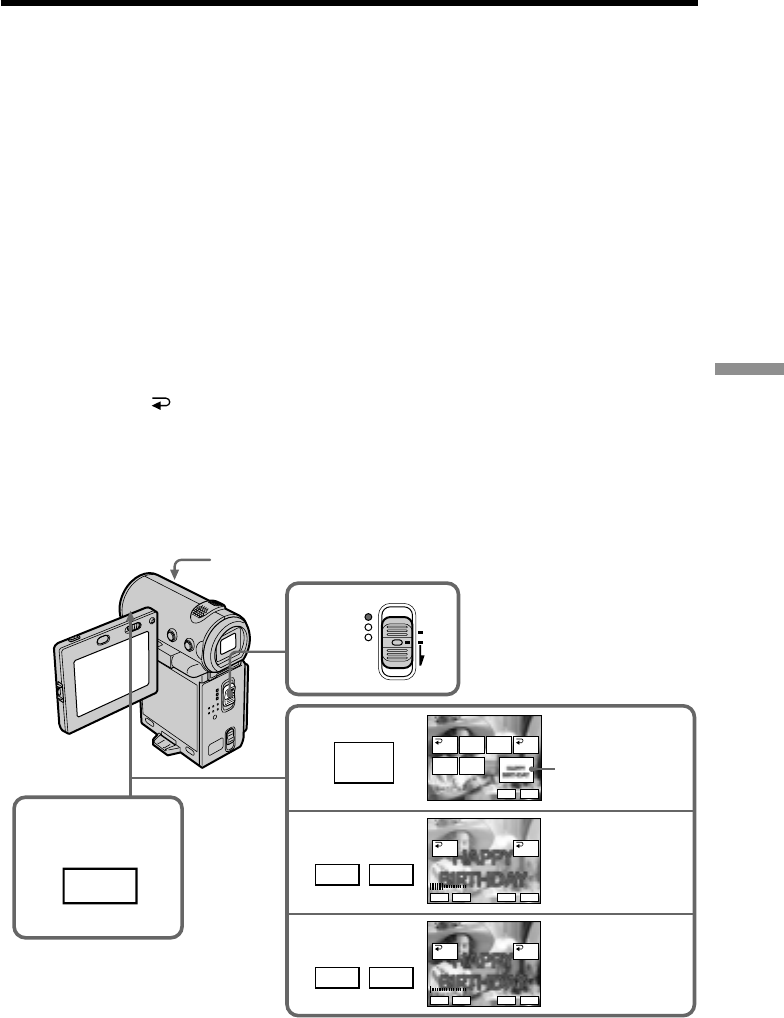
133
“Memory Stick” Operations
2
3
4,5
6
FN
MEM
M
I
X
+–
+–
1
9
100–0001
+–
MEM MIX
MCCAM
LUMI OVER–
LAP
OFF OK
MCCAM
CHROM
CAMCM
CHROM
M. LUMI
100–0001
+–
MEM MIX
OFF OK
+–
M. LUMI
100–0001
+–
MEM MIX
OFF OK
+–
MEMORY/
NETWORK
VCR
CAMERA (CHG)
POWER
OFF
ON
MODE
Superimposing a still image in a “Memory Stick” on a moving
picture – MEMORY MIX
Before operation
•Insert the tape for recording into your camcorder.
•Insert the “Memory Stick” recorded with still images into your camcorder.
(1)Set the POWER switch to CAMERA.
(2)In standby mode, select FN, then press the center z on the control button. The
PAGE1 screen appears.
(3)Select MEM MIX, then press the center z on the control button. The last
recorded or last composed image appears on the lower part of the screen as a
thumbnail image.
(4)Select –/+ on the lower-right corner of the screen, then press the center z on
the control button to select the still image which you want to superimpose.
–: to see the previous image
+: to see the next image
(5)Select a desired mode, then press the center z on the control button. The still
image is superimposed on the moving picture.
(6)Select –/+ on the lower-left corner of the screen, then press the center z on the
control button to adjust the effect.
(7)Select OK, then press the center z on the control button. The PAGE1 screen
appears.
(8)Select EXIT, then press the center z on the control button. The FN screen
appears.
(9)Press START/STOP to start recording.
Still image
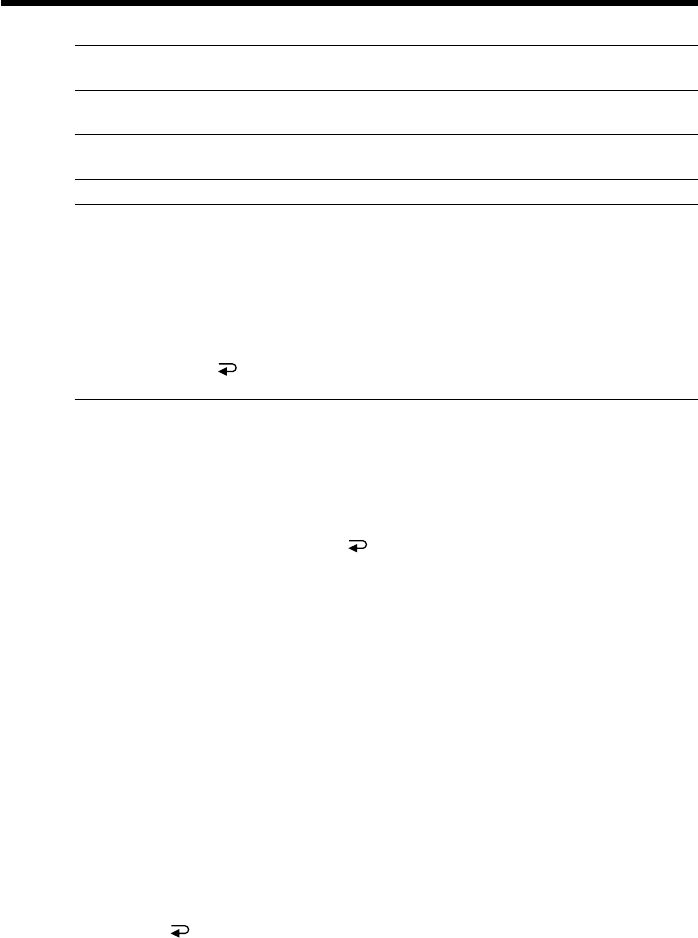
134
Superimposing a still image in a “Memory Stick” on a moving
picture – MEMORY MIX
Items to adjust
M. CHROM The color (blue) scheme of the area in the still image which is to be swapped
with a moving picture
M. LUMI The color (bright) scheme of the area in the still image which is to be
swapped with a moving picture
C. CHROM The color (blue) scheme of the area in the moving picture which is to be
swapped with a still image
M.OVERLAP No adjustment necessary
The fewer bars there are on the screen, the stronger the effect.
To change the still image to be superimposed
Before step 7, select –/+ on the lower-right corner, then press the center z on the
control button.
To cancel MEMORY MIX
Before step 7, select OFF, then press the center z on the control button.
Notes
•You cannot make a memory mix function using a moving image. If you select a
moving file, the black thumbnail image appears.
•When you try to mix a moving file image recorded on a “Memory Stick,” the message
“@ NOT REC” appears and you cannot mix the moving file image onto the tape.
•When the overlapping still image has a large amount of white, the thumbnail image of
the picture may not be clear.
•You cannot reselect the mode. Select OFF, then press the center z on the control
button again to return to PAGE1.
The “Memory Stick” supplied with your camcorder stores 20 images
–For M. CHROM: 18 images (such as a frame) 100-0001~100-0018
–For C. CHROM: two images (such as a background) 100-0019~100-0020
Sample images
Sample images stored in the “Memory Stick” supplied with your camcorder are
protected (p. 155).
Image data modified with a computer or shot with other equipment
You may not be able to play them back with your camcorder.
To record a still image without any effect on a tape
Select –/+ on the lower-left corner, then press the center z on the control button to
increase the bars to maximum in the M. LUMI mode in step 6.
Note on M.OVERLAP
Once you select M.OVERLAP, you cannot reselect a still image. If you select another
image, select OFF, then press the center z on the control button to release
M.OVERLAP before step 7 and select another image.
When you press PHOTO button in step 9
You can record a still images on the tape.
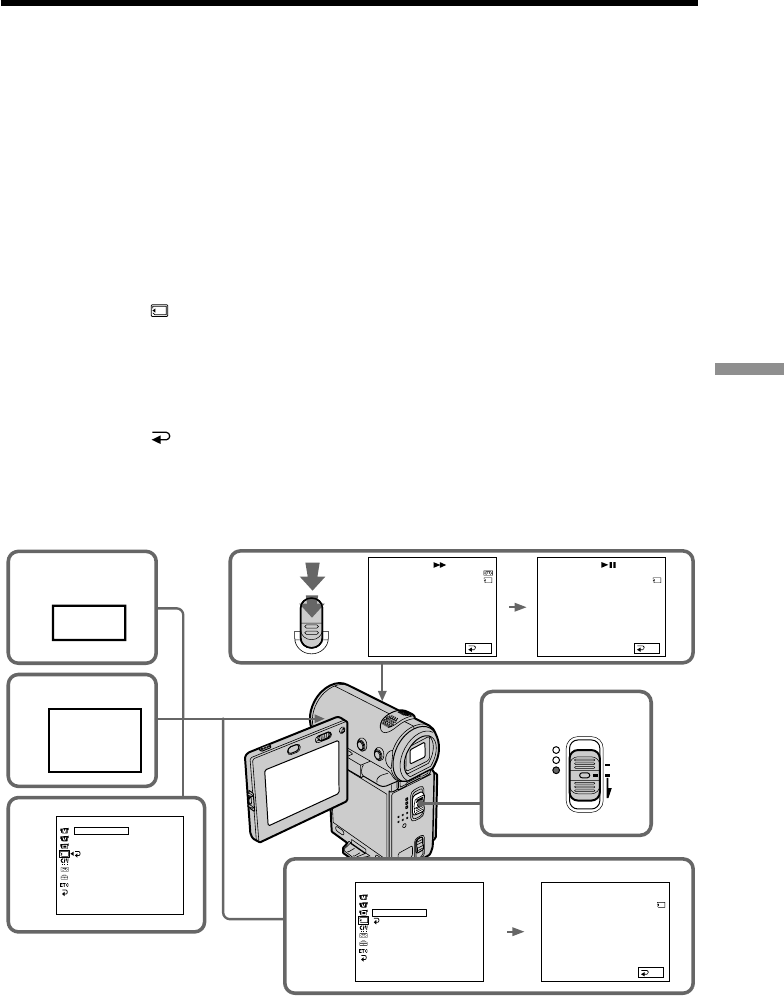
135
“Memory Stick” Operations
Copying still images from a tape
– Photo save
– DCR-IP7/IP7BT only
Using the search function, you can automatically take in only still images from tapes
and record them on a “Memory Stick” in sequence.
Before operation
•Insert the recorded tape into your camcorder and rewind the tape.
•Insert the “Memory Stick” into your camcorder.
(1)Set the POWER switch to VCR.
(2)Select FN, then press the center z on the control button. The PAGE1 screen
appears.
(3)Select MENU, then press the center z on the control button. The menu
appears.
(4)Select , then press the center z or B on the control button.
(5)Select PHOTO SAVE, then press the center z or B on the control button.
“PHOTO BUTTON” appears on the screen.
(6)Press PHOTO firmly. The still image from the tape is recorded on a “Memory
Stick.” The number of still images copied is displayed. “END” is displayed
when copying is completed.
(7)Select END, then press the center z on the control button. The PAGE1
screen appears.
(8)Select EXIT, then press the center z on the control button. The FN screen
appears.
-
2
5
4
6
FN
31
MENU
PHOTO SAVE 0 : 00 : 00
0 / 40
34min
F
I
NE
SAV
I
NG
0
PHOTO SAVE 0 : 30 : 00
4 / 40
F
I
NE
END
4
PHOTO SAVE 0 : 00 : 00
0 / 40
F
I
NE
PHOTO BUTTON
END
MEMORY SET
STILL SET
MOVIE SET
PHOTO SAVE
RETURN READY
END END
PHOTO
MEMORY SET
STILL SET
MOVIE SET
PHOTO SAVE
RETURN
MEMORY/
NETWORK
VCR
CAMERA (CHG)
POWER
OFF
ON
MODE

136
Copying still images from a tape – Photo save
To stop or end copying
Select END, then press the center z on the control button in step 5.
When the memory of the “Memory Stick” is full
“MEMORY FULL” appears on the screen, and the copying stops. Select END, then
press the center z on the control button, insert another “Memory Stick” and repeat the
procedure from step 2.
When the access lamp is lit or flashing
Do not shake or strike your camcorder. As well do not turn the power off, eject the
“Memory Stick” or remove the battery pack. Otherwise, the image data breakdown may
occur.
If the write-protect switch on the “Memory Stick” is set to LOCK
“NOT READY” appears when you select the item in the menu settings.
When you change the “Memory Stick” in the middle of copying
Your camcorder resumes copying from the last image recorded on the previous
“Memory Stick.”
Note
The message “NOT READY” appears when you select PHOTO SAVE in the following
cases:
•Any images are not recorded on the tape.
•Images are recorded before the actual position.
In such cases, do the tape photo recording or rewind the tape, then select PHOTO
SAVE.
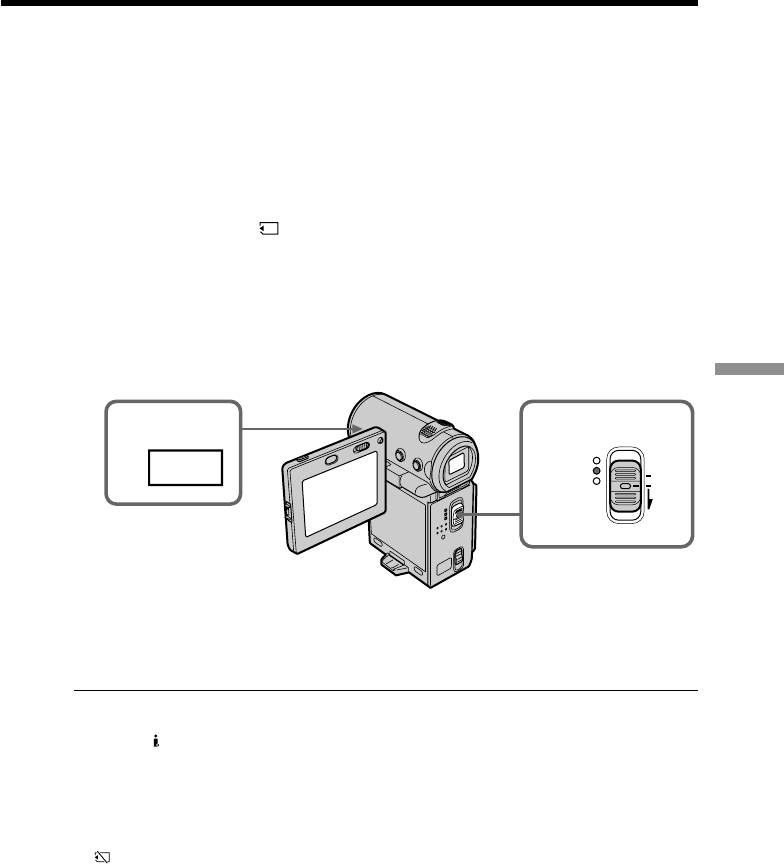
137
“Memory Stick” Operations
Viewing a still image
– Memory photo playback
– DCR-IP7/IP7BT only
You can play back still images recorded on a “Memory Stick.” You can also play back
six images including moving pictures in order at a time by selecting the index screen.
Before operation
Insert the “Memory Stick” into your camcorder.
(1)Set the POWER switch to MEMORY or VCR.
(2)In MEMORY mode, select PLAY, then press the center z on the control button.
In VCR mode, select PB, then press the center z on the control button.
The last recorded image is displayed.
(3)Select –/+, then press the center z on the control button to select the desired
still image.
–: to see the previous image
+: to see the next image
To stop memory photo playback
Select CAM or VCR, then press the center z on the control button.
Note
Playback images recorded on the “Memory Stick” are not output:
•From the i.LINK (MICROMV) jack.
•From the A/V jack if the i.LINK cable is plugged in the camcorder.
Notes on the file name
•The directory number may not be displayed and only the file name may be displayed
if the structure of the directory does not conform to the DCF standard.
•“ - DIRECTORY ERROR” may appear on the screen if the structure of the
directory does not conform to the DCF standard. While this message appears, you can
play back images but cannot record them on the “Memory Stick.”
•The file name flashes on the screen if the file is corrupted or the file is unreadable.
2
PLAY
1
MEMORY/
NETWORK
VCR
CAMERA (CHG)
POWER
OFF
ON
MODE
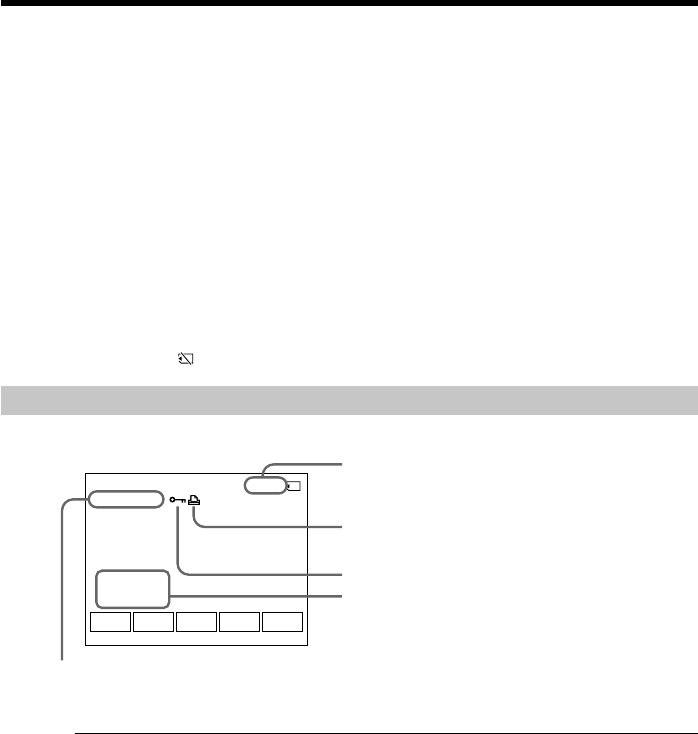
138
Viewing a still image – Memory photo playback
Data Directory Number/File Number
Image number/Total number of recorded images
Protect indicator
Print mark
Recording data
To play back recorded images on a TV screen
•Connect your camcorder to the TV with the A/V connecting cable supplied with your
camcorder before the operation.
•When operating memory photo playback on the TV or on the LCD screen, the image
quality may appear to have deteriorated. This is not a malfunction. The image data is
as good as ever.
•Turn the audio volume of the TV down before operation, or noise (howling) may be
output from the TV speakers.
Image data modified with a computer or shot with other equipment
You may not be able to play them back with your camcorder.
Still image
You can also select still images from the PAGE1/PAGE2/PAGE3 screen by selecting
–/+.
When no image is recorded on the “Memory Stick”
The message “ NO FILE” appears.
Screen indicators during still image playback
Recording data
To display the recording data (date/time or various settings when recorded), select
CAM DATA or DATE DATA, then press the center z on the control button through
DATA CODE on the PAGE3 screen, then press the center z on the control button
during playback. You can also use the Remote Commander for this operation (p. 36).
To turn off the screen indicators
Press DISPLAY.
6 / 40
MEMORY PLAY
100–0006
JUL 4 2001
12:05:56 AM
FNINDEXCAM
+–
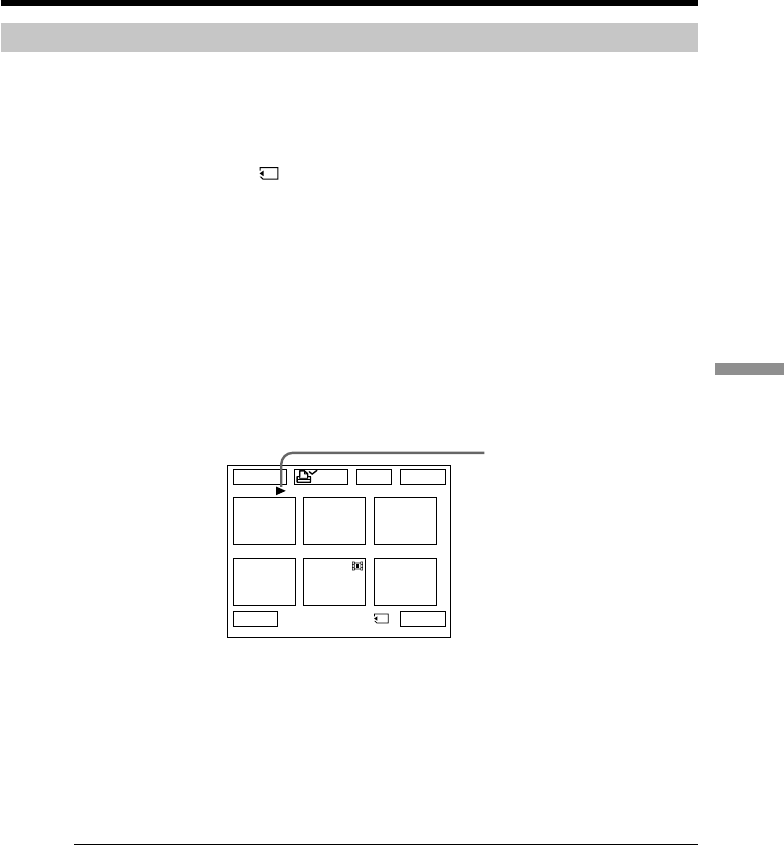
139
“Memory Stick” Operations
Playing back six recorded images at a time (index screen)
You can play back six recorded images at a time. This function is especially useful when
searching for a particular image.
(1)Set the POWER switch to MEMORY or VCR.
(2)In MEMORY mode, go to step 3.
In VCR mode, select PB, then press the center z on the control button.
(3)Select INDEX, then press the center z on the control button to display the
index screen.
An orange B mark appears above the image that is displayed before changing
to the index screen mode.
Selecting the B mark makes the color of the B mark to orange from green. However, the
B mark remains green when you use –/+ or C/c on the Remote Commander.
T: to display the previous six images
t: to display the following six images
You can also use –/+ or C/c on the Remote Commander instead.
To return to the FN screen
Select EXIT, then press the center z on the control button.
To return to the normal playback screen (single screen)
Move the B mark to the image you want to display, then press the center z on the
control button. When you use the Remote Commander, move the B mark to the image
you want to display, then press PLAY.
Note
When displaying the index screen, the number appears above each image. This
indicates the order in which images are recorded on the “Memory Stick.” These
numbers are different from the data file names (p. 112).
Image data modified with a computer or shot with other equipment
These files may not be displayed on the index screen.
Viewing a still image – Memory photo playback
B mark
1 / 40
123
456
EXITDEL
MARK
-
MARK
T t
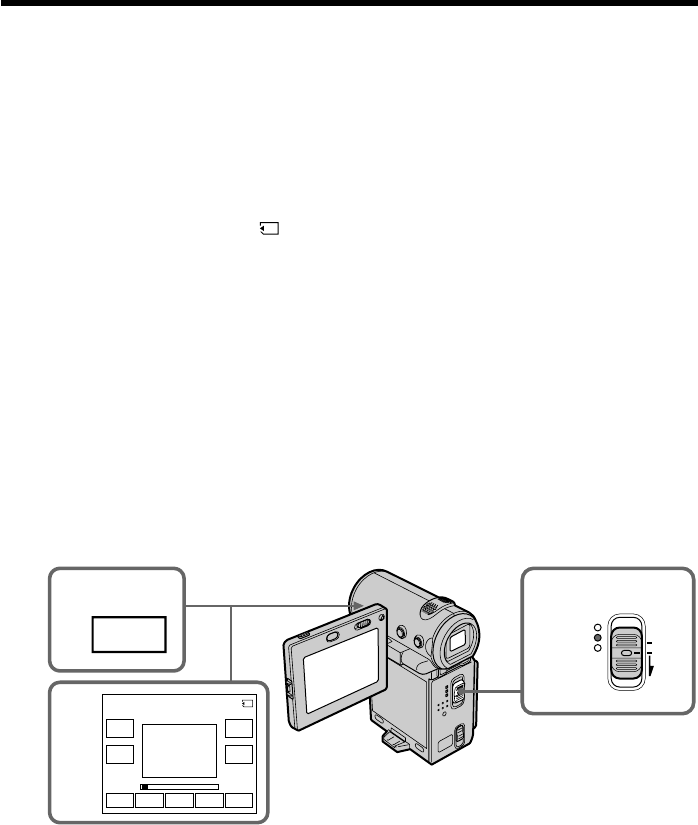
140
Viewing a moving picture
– MPEG movie playback
– DCR-IP7/IP7BT only
You can play back moving pictures recorded on a “Memory Stick.” You can also play
back six images including still images in order at a time by selecting the index screen.
Before operation
Insert the “Memory Stick” into your camcorder.
(1)Set the POWER switch to MEMORY or VCR.
(2)In MEMORY mode, select PLAY, then press the center z on the control button.
In VCR mode, select PB, then press the center z on the control button.
The last recorded image is displayed.
(3)Select +/–, then press the center z on the control button to select the desired
moving picture. To see the previous picture, select –, then press the center z
on the control button. To see the next picture, select +, then press the center z
on the control button.
(4)Select MPEG N X, then press the center z on the control button. Playback
starts.
(5)Select VOL –/VOL +, then press the center z on the control button repeatedly
to adjust the volume.
– : To turn down the volume.
+ : To turn up the volume.
You can adjust the volume by pressing b/B repeatedly after you select VOL –
/VOL +.
To pause playback
Select MPEG N X, then press the center z on the control button. Press again to start
playback.
2
PLAY
1
FN
VOL
+
MPEG SCRN
SIZE
N X
VOL
–
–– –
–– –
INDEXCAM
+–
MOV
00001
MEMORY PL AY
1/20
5
MEMORY/
NETWORK
VCR
CAMERA (CHG)
POWER
OFF
ON
MODE
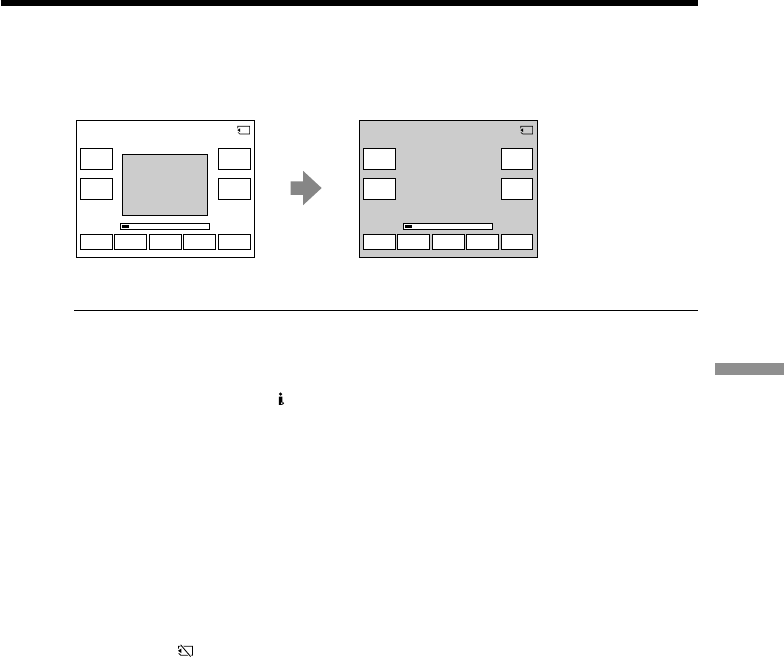
141
“Memory Stick” Operations
Viewing a moving picture – MPEG movie playback
To change the screen size
Select SCRN SIZE, then press the center z on the control button. The screen size
changes as follows:
Note
The MPEG movie recorded with the camcorder:
•Is MPEG MOVIE AD.
•Cannot be played back on other digital still camera and digital video camera recorder.
•Cannot be output from the i.LINK (MICROMV) jack.
To play back recorded images on a TV screen
•Connect your camcorder to the TV with the A/V connecting cable supplied with your
camcorder before operation.
•Turn the audio volume of the TV down before operation, or noise (howling) may be
output from the TV speakers.
Image data modified with a computer or shot with other equipment
You may not be able to play them back with your camcorder and the volume cannot be
adjusted.
When no image is recorded on the “Memory Stick”
The message “ NO FILE” appears.
Moving picture
You can select moving pictures from the PAGE1/PAGE2/PAGE3 screen by selecting
–/+.
Notes on the screen size
•The picture may not be displayed at the middle of the screen depending on the movie.
•Even if you switch the screen size, the picture may not be displayed on full-screen size
depending on the movie.
FN
VOL
+
MPEG SCRN
SIZE
N X
VOL
–
INDEXCAM
+–
MOV
10001
MEMORY P LAY
1/20
FN
VOL
+
MPEG SCRN
SIZE
N X
VOL
–
INDEXCAM
+–
MOV
10001
MEMORY P LAY
1/20
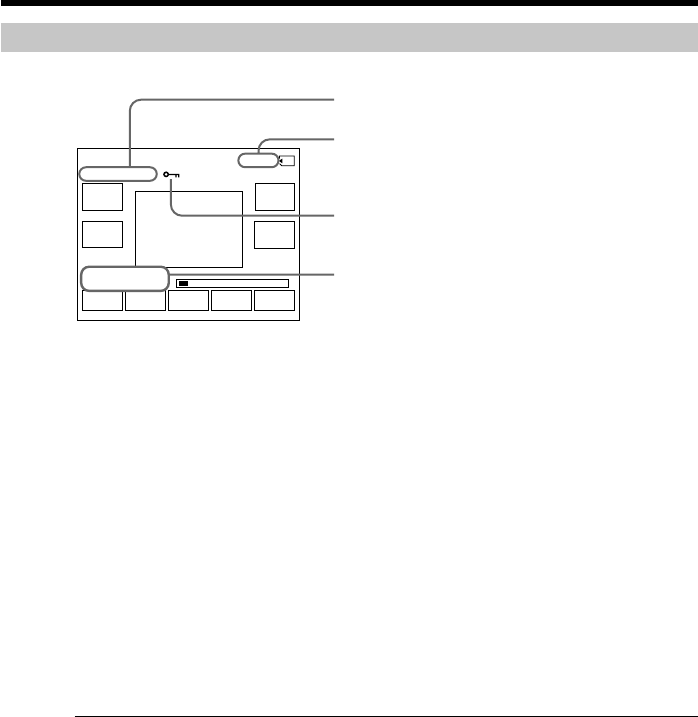
142
Screen indicators during moving picture playback
Recommended computer environment
Recommended Windows environment
OS: Microsoft Windows 95, Windows 98, or Windows NT 3.51 or later standard
installation is required.
However, operation is not assured if the above environment is an upgraded OS
* MPEG files cannot be handled on Widows 3.1.
Application: InternetExplorer 4.0 or later (This application comes equipped with
Windows 98 or later), or Windows Media Player (Active Movie Player)
must be installed.
Recommended Macintosh environment
CPU:PowerPC
OS: Mac OS 7.6.1 or later
Application: QuickTime 3.0 or later
* For details on system requirement for QuickTime, refer to the Web site of Apple
Computer, Inc.
Recording date/time
To display the recording date/time, press DATA CODE on the Remote Commander
during playback. Various settings are not displayed. You can also use DATA CODE on
the PAGE3 screen for this operation (p. 36).
To turn off the screen indicators
Press DISPLAY.
Picture number/Total number of recorded
pictures
Data directory number/File number
Protect indicator
Recording date/time. (Various settings are
displayed as “– – –”.)
FN
VOL
+
MPEG SCRN
SIZE
N X
VOL
–
INDEXCAM
+–
JUL 4 2001
12:05:56
MOV
00001
0:01
1/20
Viewing a moving picture – MPEG movie playback
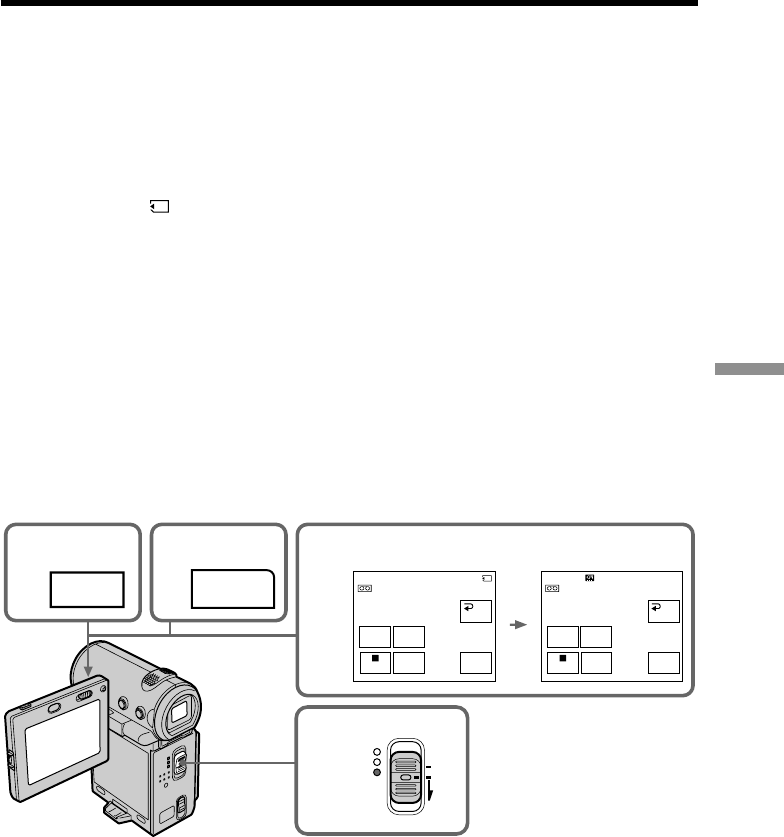
143
“Memory Stick” Operations
Dubbing images recorded on the
“Memory Stick” onto the tape
You can dub a still image or title recorded on a “Memory Stick” to a tape. You can also
use the Remote Commander.
Before operation
•Insert the tape to be recorded into your camcorder.
•Insert the “Memory Stick” into your camcorder.
(1)Set the POWER switch to VCR.
(2)Locate the desired recording start point of the tape, then stop the tape.
(3)Select PB, then press the center z on the control button. Next, select the still
image you want to dub by selecting –/+.
(4)Select FN, then press the center z on the control button. The PAGE1 screen
appears.
(5)Select PAGE3, then press the center z on the control button. The PAGE3
screen appears.
(6)Select q REC CTRL, then press the center z on the control button. The q
REC CTRL appears.
(7)Select REC START, then press the center z on the control button. The
camcorder starts the dubbing. To pause the dubbing, select REC PAUSE, then
press the center z on the control button.
(8)When you try to dub another image, select –/+, then press the center z on the
control button and carry out step 7.
6,7
100–0102
–+
4FN 5
PAGE3
1MEMORY/
NETWORK
VCR
CAMERA (CHG)
POWER
OFF
ON
MODE
REC
PAUSE
REC CTRL
102/102
MEMORY PLAY
RET.
REC
START
100–0102
–+
REC
PAUSE
REC CTRL
0:00:07
MEMORY PLAY
RET.
REC
START
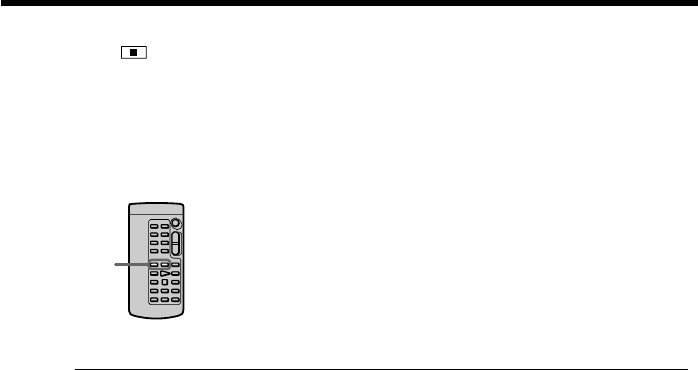
144
To stop dubbing
Select , then press the center z on the control button, or press the stop button on
the Remote Commander.
When using the Remote Commander
Press the REC buttons on the Remote Commander simultaneously after step 3. The
camcorder starts dubbing.
Notes
•You cannot dub MPEG movie files to the tape.
•You cannot dub the index screen to the tape.
Image files modified with a computer or shot with other equipment
You may not be able to dub the images.
REC
Dubbing images recorded on the “Memory Stick” onto the tape
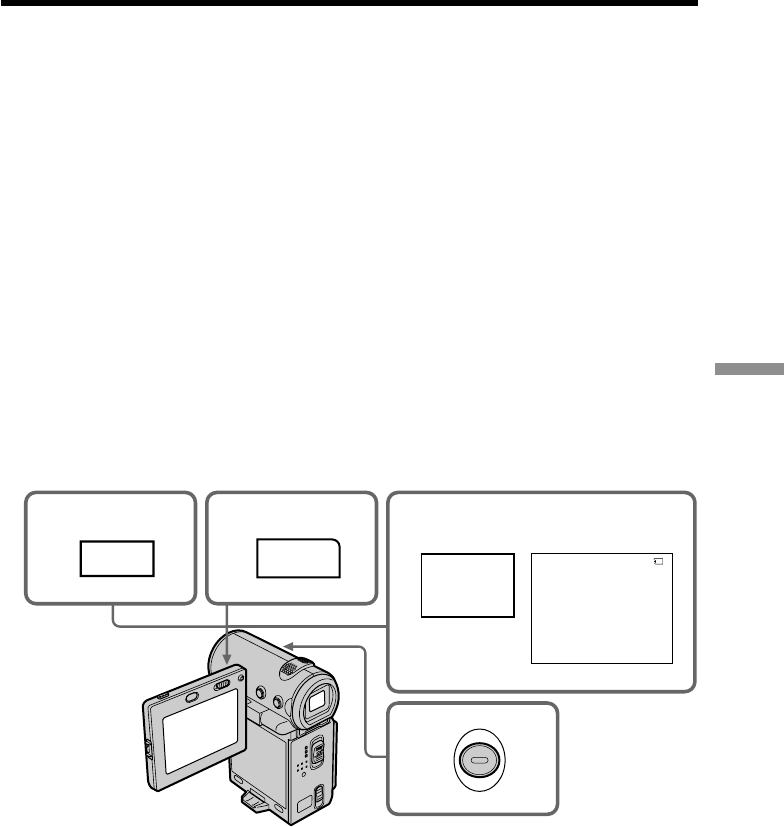
145
“Memory Stick” Operations
Enlarging still images recorded on
“Memory Stick”s – Memory PB ZOOM
– DCR-IP7/IP7BT only
You can enlarge still images recorded on a “Memory Stick.”
Before operation
Insert the “Memory Stick” into your camcorder.
(1)In memory playback mode, select FN, then press the center z on the control
button. The PAGE1 screen appears.
(2)Select PAGE2, then press the center z on the control button. The PAGE2
screen appears.
(3)Select PB ZOOM, then press the center z on the control button. The PB ZOOM
screen appears.
(4)Push down ZOOM to enlarge the image. The zoom scaling can be selected
from 2×, 3×, 4×, and 5×.
(5)Move the enlarged area.
v: To view the upper portion of the original image.
V: To view the lower portion of the original image.
b: To view the left portion of the original image.
B: To view the left portion of the original image.
To cancel the Memory PB ZOOM function
Press the center z on the control button.
MEMORY PLAY
3/14
PB ZOOM
[EXEC]:END 100–0003
2
4
3,5
1FN
PB
ZOOM
PAGE2
W
T

146
Note
You cannot record the images on the “Memory Stick,” which are enlarged by the
Memory PB ZOOM function. Record the images on the VCR using your camcorder as a
player.
Pictures in the Memory PB ZOOM mode
Pictures are not output through the i.LINK (MICROMV) jack.
In Memory PB ZOOM mode
If you press DISPLAY, the indicators on the Memory PB ZOOM screen disappears.
The edges of an enlarged image
The edges of the enlarged image cannot be displayed at the center of the screen.
MPEG movie files recorded on “Memory Stick”s
The PB ZOOM function does not work.
Enlarging still images recorded on “Memory Stick”s – Memory PB
ZOOM
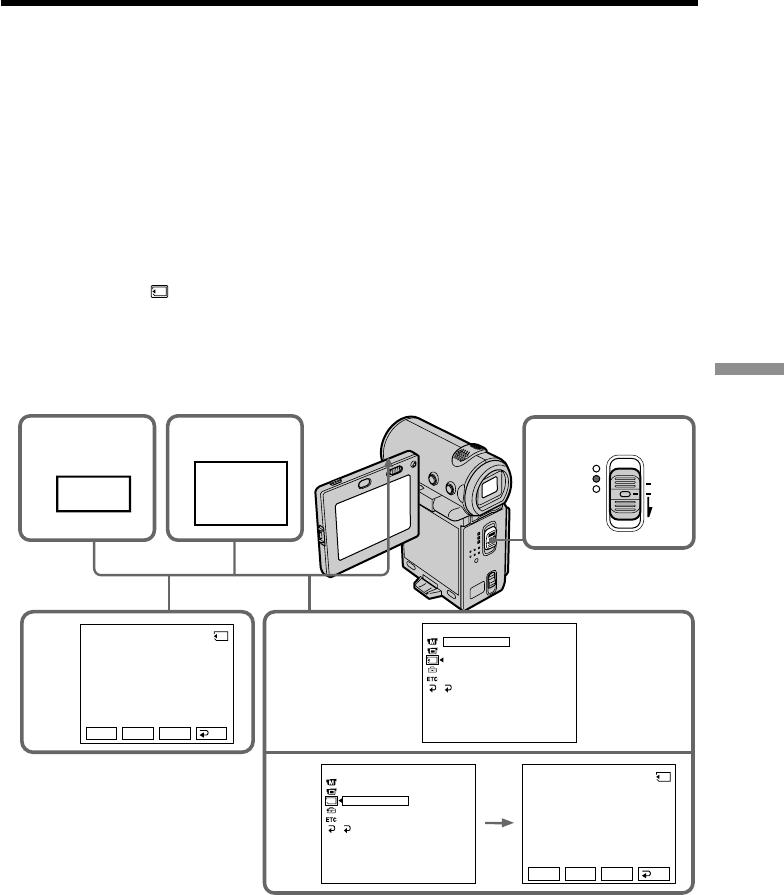
147
“Memory Stick” Operations
Playing back images in a continuous loop
– SLIDE SHOW
– DCR-IP7/IP7BT only
You can automatically play back images in sequence. This function is useful especially
when checking recorded images or during a presentation.
Before operation
Insert the “Memory Stick” into your camcorder.
(1)Set the POWER switch to MEMORY.
(2)Select FN, then press the center z on the control button. The PAGE1 screen
appears.
(3)Select MENU, then press the center z on the control button. The menu
appears.
(4)Select , then press the center z or B on the control button.
(5)Select SLIDE SHOW, then press the center z or B on the control button.
(6)Select START, then press the center z on the control button. Your camcorder
plays back the images recorded on the “Memory Stick” in sequence.
2
FN
3
4MEMORY SET
STILL SET
MOVIE SET
SLIDE SHOW
DELETE ALL
FORMAT
RETURN
1
MENU
5MEMORY SET
STILL SET
MOVIE SET
SLIDE SHOW
DELETE ALL
FORMAT
RETURN
READY
61 / 6
SL
I
DE SHOW
100–00001
+–
PAUSE
END
1 / 6
SL
I
DE SHOW
100–00001
+–
START
END
MEMORY/
NETWORK
VCR
CAMERA (CHG)
POWER
OFF
ON
MODE
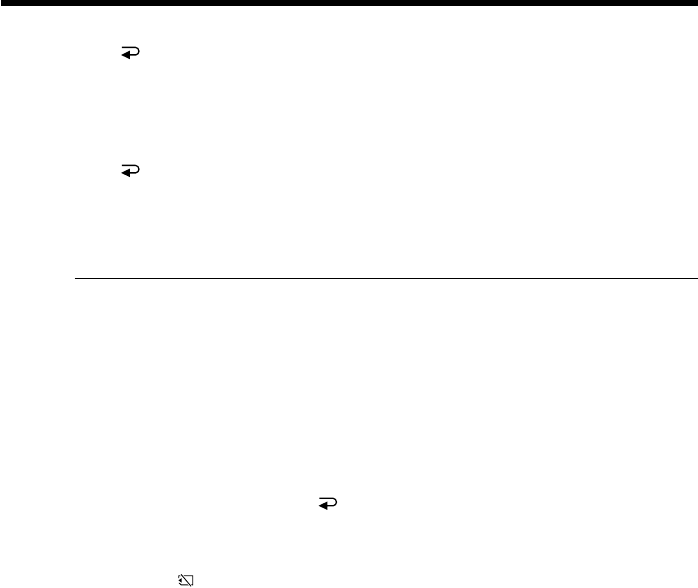
148
To stop the slide show
Select END, then press the center z on the control button.
To pause during a slide show
Select PAUSE, then press the center z on the control button.
To return to the FN screen
Select END, then press the center z on the control button. The PAGE1 screen
appears. Next, select EXIT, then press the center z on the control button.
To start the slide show from a particular image
Select the desired image by selecting and executing –/+ before step 5.
To view the recorded images on the TV screen
Connect your camcorder to a TV with the A/V connecting cable supplied with your
camcorder before operation.
If you change the “Memory Stick” during operation
The slide show does not operate. If you change the “Memory Stick,” carry out the
procedure from the beginning.
To play the slide show with the screen indicators turned off
After step 5, press DISPLAY to turn off the screen indicators. You can start/pause the
slide show using MEMORY PLAY on the Remote Commander. To end the slide show,
press DISPLAY again, next, select END, then press the center z on the control
button.
When there is no images on the “Memory Stick”
The message “ NO FILE” appears.
Playing back images in a continuous loop – SLIDE SHOW
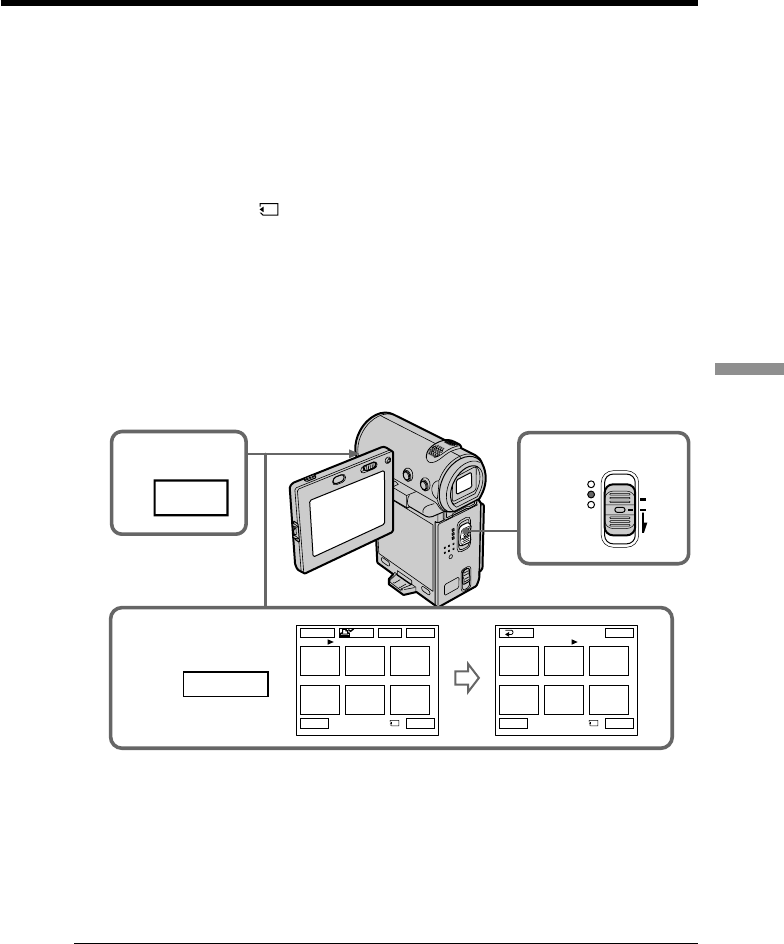
149
“Memory Stick” Operations
Preventing accidental erasure
– Image protection
– DCR-IP7/IP7BT only
To prevent accidental erasure of important images, you can protect selected images.
Before operation
Insert the “Memory Stick” into your camcorder.
(1)Set the POWER switch to MEMORY or VCR.
(2)In MEMORY mode, go to step 3.
In VCR mode, select PB, then press the center z on the control button.
(3)Select INDEX, then press the center z on the control button. The index screen
appears.
(4)Select - MARK, then press the center z on the control button. The screen for
protecting the image appears.
(5)Select the image you want to protect, then press the center z on the control
button. The “-” mark appears on the protected image.
(6)Repeat step 5 to select other images.
To return to the FN screen
Select EXIT, then press the center z on the control button.
To cancel image protection
Select the image you want to cancel image protection, then press the center z on the
control button in step 5 again. The “-” mark disappears.
Note
Formatting erases all information on the “Memory Stick,” including the protected
image data. Check the contents of the “Memory Stick” before formatting.
If the write-protect switch on the “Memory Stick” is set to LOCK
You cannot carry out image protection.
1
3
INDEX
4–6123
456
EXIT
RET.
-
MARK
1 / 40
123
456
EXITDEL
MARK
-
MARK
T t
-
2 / 40
Tt
-
MARK
MEMORY/
NETWORK
VCR
CAMERA (CHG)
POWER
OFF
ON
MODE
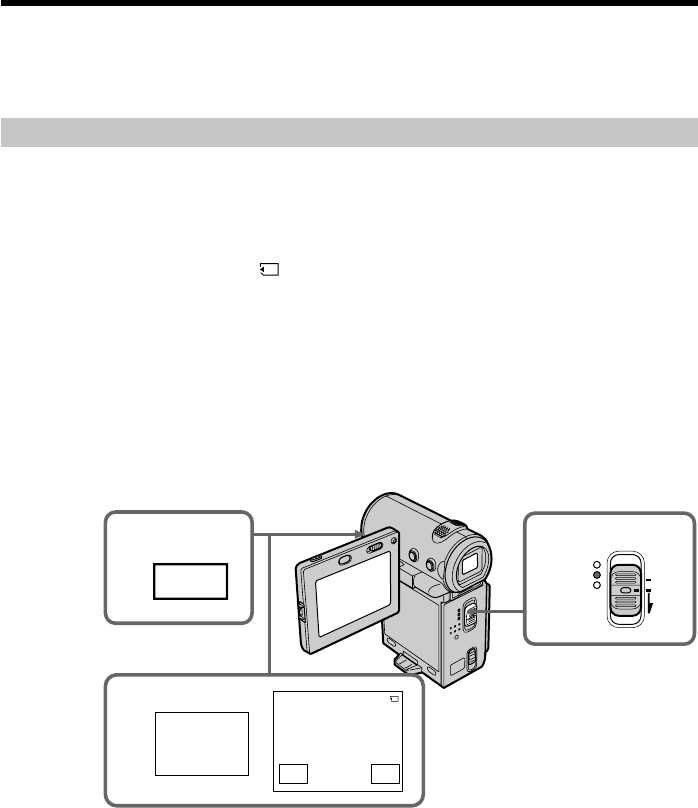
150
Deleting images
– DCR-IP7/IP7BT only
You can delete images stored in a “Memory Stick.” You can delete all images or selected
images.
Deleting selected images
Before operation
Insert the “Memory Stick” into your camcorder.
(1)Set the POWER switch to MEMORY or VCR.
(2)In MEMORY mode, select PLAY, then press the center z on the control button.
In VCR mode, select PB, then press the center z on the control button.
Select –/+, then press the center z on the control button to select the image
you want to delete.
(3)Select FN, then press the center z on the control button. The PAGE1 screen
appears.
(4)Select DELETE, then press the center z on the control button. “DELETE?”
appears on the screen.
(5)Select OK, then press the center z on the control button. The selected image is
deleted.
To return to the FN screen
Select EXIT, then press the center z on the control button after step 5.
To cancel deleting an image
Select CANCEL, then press the center z on the control button in step 5.
4
DELE–
TE
DELETE
100–00010 3 / 40
DELETE?
OK CAN–
CEL
3FN 1
MEMORY/
NETWORK
VCR
CAMERA (CHG)
POWER
OFF
ON
MODE
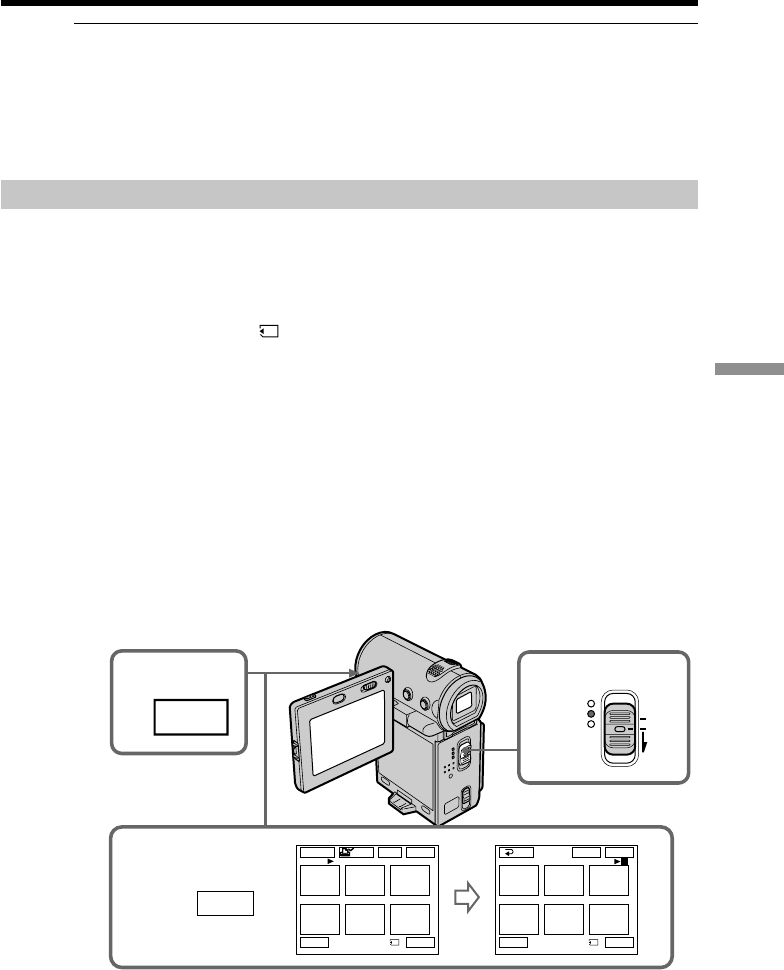
151
“Memory Stick” Operations
Deleting images
Notes
•When you delete a protected image, first cancel the image protection.
•Once you delete an image, you cannot restore it. Check the images before deleting
them.
If the write-protect switch on the “Memory Stick” is set to LOCK
You cannot delete images.
Deleting selected images on the index screen
Before operation
Insert the “Memory Stick” into your camcorder.
(1)Set the POWER switch to MEMORY or VCR.
(2)In MEMORY mode, go to step 3.
In VCR mode, select PB, then press the center z on the control button.
(3)Select INDEX, then press the center z on the control button.
The index screen appears.
(4)Select DEL, then press the center z on the control button. The DEL screen
appears.
(5)Move the B mark to the image you want to delete, then press the center z on
the control button. The number of the selected image is highlighted.
(6)Repeat step 5 to select other image.
(7)After selecting all the images, select EXEC, then press the center z on the
control button. “DELETE?” appears on the screen.
(8)Select OK, then press the center z on the control button. The selected images
are deleted. The message “ERASING” appears. After the erasing is completed,
the index screen appears.
3
INDEX
4–61
3
2
456
EXITDEL
123
456
EXITDEL
MARK
-
MARK
-
EXEC
DEL
1 / 40
Tt
3 / 40
Tt
RET.
1
MEMORY/
NETWORK
VCR
CAMERA (CHG)
POWER
OFF
ON
MODE
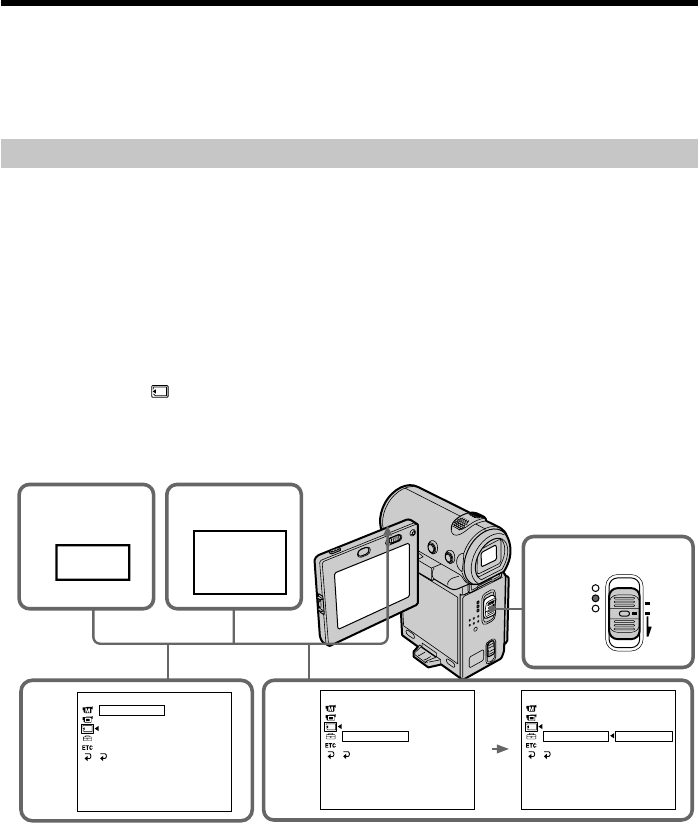
152
Deleting images
To return to the FN screen
Select EXIT, then press the center z on the control button after step 8.
To cancel deleting an image
Select CANCEL, then press the center z on the control button in step 8.
Deleting all the images
You can delete all the unprotected images in a “Memory Stick.”
Before operation
Insert the “Memory Stick” into your camcorder.
(1)Set the POWER switch to MEMORY.
(2)Select FN, then press the center z on the control button. The PAGE1 screen
appears.
(3)Select MENU, then press the center z on the control button. The menu
appears.
(4)Select , then press the center z or B on the control button.
(5)Select DELETE ALL, then press the center z or B on the control button.
STILL SET
MOVIE SET
SLIDE SHOW
DELETE ALL
FORMAT
RETURN
READY
MEMORY SET
STILL SET
MOVIE SET
SLIDE SHOW
DELETE ALL
FORMAT
RETURN
RETURN
OK
MEMORY SET
2
FN
31
MENU
45
MEMORY SET
STILL SET
MOVIE SET
SLIDE SHOW
DELETE ALL
FORMAT
RETURN
MEMORY/
NETWORK
VCR
CAMERA (CHG)
POWER
OFF
ON
MODE
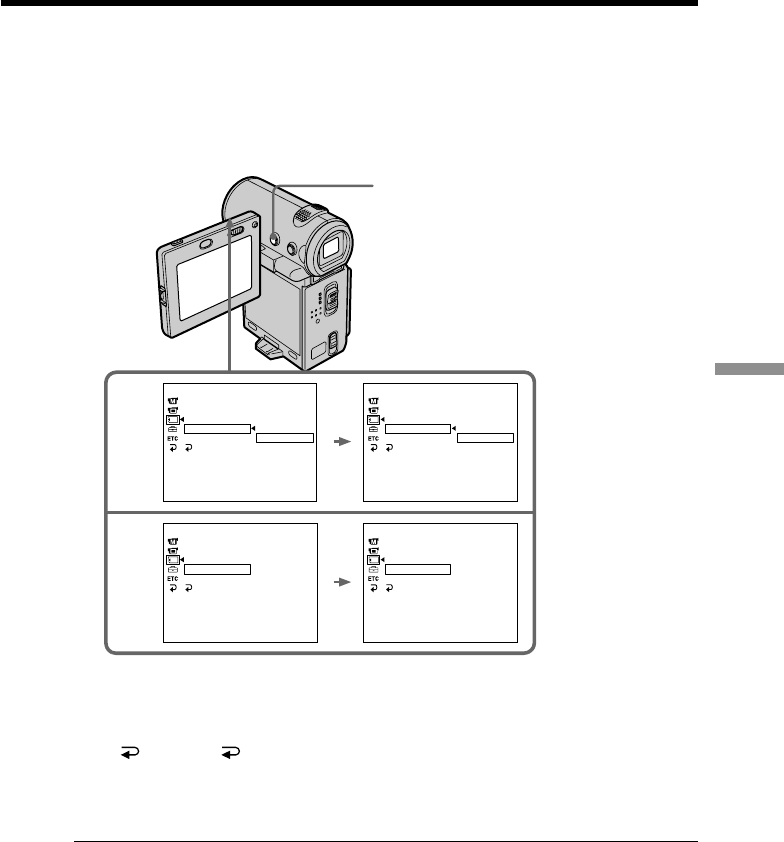
153
“Memory Stick” Operations
(6)Select OK, then press the center z on the control button. OK changes to
EXECUTE.
(7)Select EXECUTE, then press the center z on the control button.
“DELETING” appears on the screen. When all the unprotected images are
deleted, “COMPLETE” is displayed.
(8)Press DISPLAY to turn off the menu.
To return to the FN screen
Select RETURN, , then press the center z on the control button.
To cancel deleting all the images in the “Memory Stick”
Select RETURN in step 5 or 6, then press the center z on the control button.
While “DELETING” appears
Do not slide the POWER switch or press any buttons.
Deleting images
8
6
MEMORY SET
STILL SET
MOVIE SET
SLIDE SHOW
DELETE ALL
FORMAT
RETURN
RETURN
OK
MEMORY SET
STILL SET
MOVIE SET
SLIDE SHOW
DELETE ALL
FORMAT
RETURN
RETURN
EXECUTE
STILL SET
MOVIE SET
SLIDE SHOW
DELETE ALL
FORMAT
RETURN
DELETING
MEMORY SET STILL SET
MOVIE SET
SLIDE SHOW
DELETE ALL
FORMAT
RETURN
COMPLETE
MEMORY SET
7
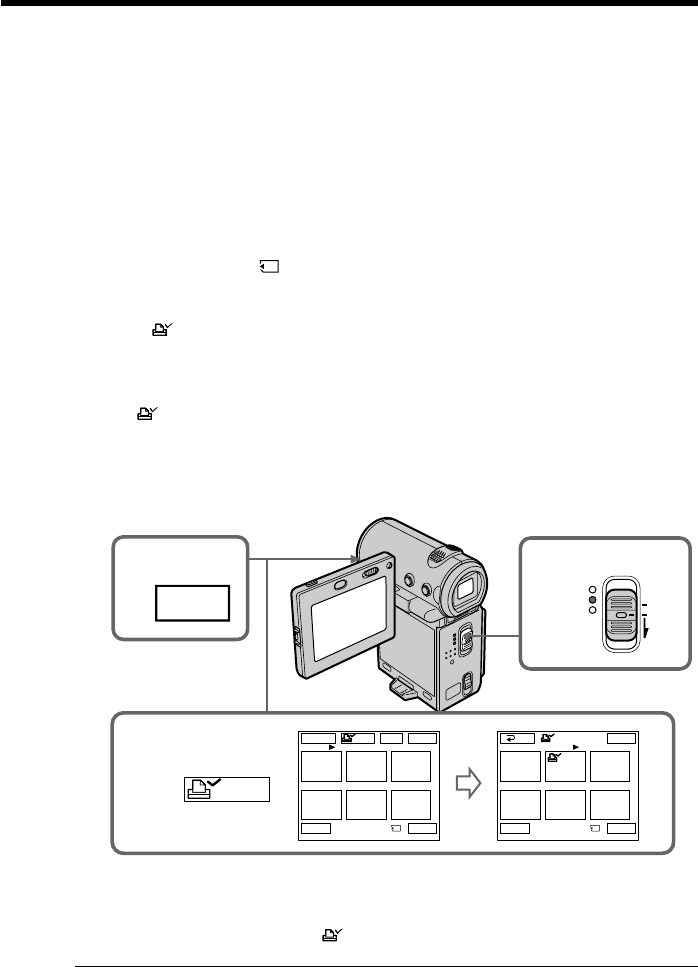
154
Writing a print mark – PRINT MARK
– DCR-IP7/IP7BT only
You can specify the recorded still image to print out by putting marks. This function is
useful for printing out still images later.
Your camcorder conforms with the DPOF (Digital Print Order Format) standard for
specifying the still images to print out.
Before operation
Insert the “Memory Stick” into your camcorder.
(1)Set the POWER switch to MEMORY or VCR.
(2)In MEMORY mode, go to step 3.
In VCR mode, select PB, then press the center z on the control button.
(3)Select INDEX, then press the center z on the control button.
The index screen appears.
(4)Select MARK, then press the center z on the control button. The screen for
writing a print mark appears.
(5)Move the B mark to the image you want to write a print mark, then press the
center z on the control button.
The mark appears on the selected image.
(6)Repeat step 5 to write print marks on other images.
(7)After writing all the print marks, select EXIT, then press the center z on the
control button. The FN screen appears.
To cancel writing print marks
Select the image you want to cancel the print mark, then press the center z on the
control button again in step 5. The mark disappears from the image.
If the write-protect switch on the “Memory Stick” is set to LOCK
You cannot write print marks on still images.
Moving pictures
You cannot write print marks on moving pictures.
1
3
INDEX
4–6123
456
EXIT
MARK
123
456
EXITDEL
MARK
-
MARK
MARK
1 / 40
Tt
2 / 40
Tt
RET.
MEMORY/
NETWORK
VCR
CAMERA (CHG)
POWER
OFF
ON
MODE
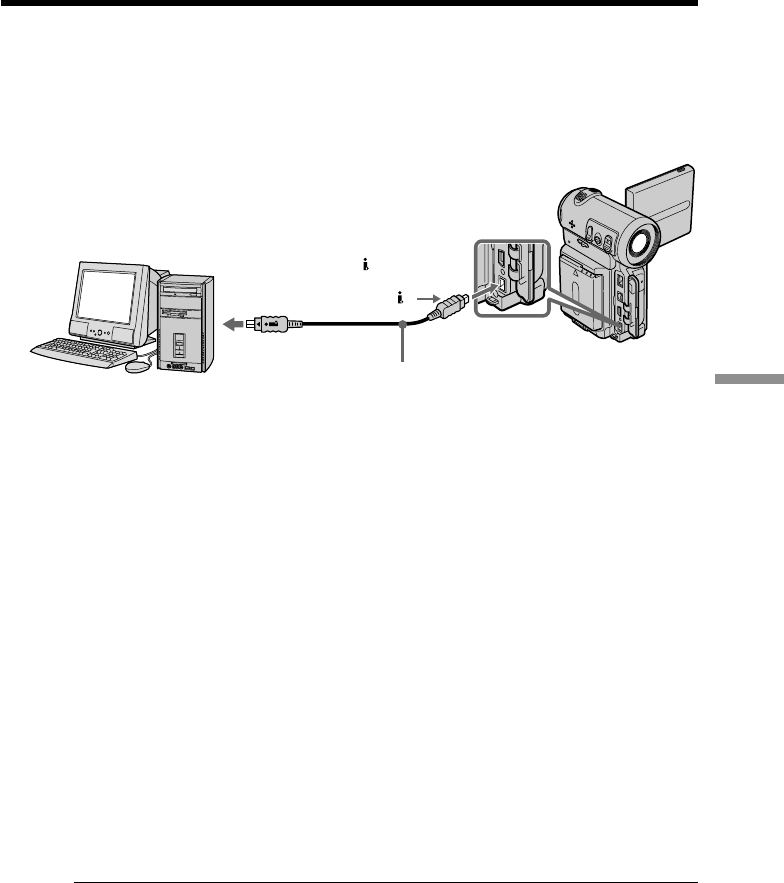
155
Connecting with a computer
— Connecting with a computer —
Viewing images recorded on a tape using
your computer
You can view or edit the images recorded on a tape using your computer. You can
record the images edited with the computer on the tape.
To view images on your computer, the optional application software MovieShaker
Ver.3.1 for MICROMV is required.
Note
To view images on your computer, you have to install the i.LINK driver and the
application software into your computer. They are included in the supplied application
software MovieShaker Ver.3.1 for MICROMV.
Before installing the i.LINK driver and the application software into your computer, be
sure not to connect the camcorder with the computer. For details on installing and
i.LINK connection, refer to the operating instructions supplied with MovieShaker
Ver.3.1 for MICROMV.
Recommended computer environment
Recommended Windows environment
OS: Microsoft Windows Me, Windows 2000 Professional, Windows XP
Home Edition (due to support) or Windows XP Professional (due to
support) standard installation is required.
However, operation is not assured if the above environment is an
upgraded OS
CPU: MMX Pentium III 600 MHz or faster
MMX Pentium III 800 MHz or faster
Main memory: 128 MB or larger
256 MB or larger
The i.LINK connector must be provided as standard.
Note
Operations are not guaranteed for all the recommended computer environments
mentioned above.
i.LINK connector
Computer i.LINK
cable
Push into the end
MICROMV

156
Viewing images recorded on a “Memory
Stick” using your computer
– DCR-IP7/IP7BT only
You can view data recorded on a “Memory Stick” using your computer.
Note
Data recorded on the “Memory Stick” is stored in the following formats. Make sure that
applications that support these file formats are installed on your computer.
–Still images: JPEG format
–Moving images/audio: MPEG format
Recommended computer environment
Recommended Windows environment
OS: Microsoft Windows 98, Windows 98SE, Windows Me or Windows 2000
Professional standard installation is required.
However, operation is not assured if the above environment is an upgraded OS
CPU:MMX Pentium 200 MHz or faster
•The USB connector must be provided as standard.
•An application such as Windows Media Player capable of playing back MPEG picture
must be installed (to play back moving pictures).
Recommended Macintosh environment
Macintosh computer with the Mac OS 8.5.1/8.6/9.0/9.1, Mac OS X standard installation
However, note that the update to Mac OS 9.0/9.1 should be used for the following
models.
•iMac with the Mac OS 8.6 standard installation and a slot loading type CD-ROM drive
•iBook or Power Mac G4 with the Mac OS 8.6 standard installation
•The USB connector must be provided as standard.
•QuickTime 3.0 or later must be installed (to play back moving pictures).
Notes
•Operations are not guaranteed for either the Windows or Macintosh environment if
you connect two or more USB devices to a single computer at the same time or when
using a hub.
•Depending on the type of USB equipment that is used simultaneously, some
equipment may not operate.
•Operations are not guaranteed for all the recommended computer environments
mentioned above.

157
Connecting with a computer
Installing the USB driver
Before connecting your camcorder to your computer, install the USB driver to the
computer. The USB driver is contained together with application software for viewing
images on a CD-ROM which is supplied with your camcorder.
Do not connect the USB cable to your computer before installation of the USB driver is
completed.
For Windows 98, Windows 98SE, Windows Me, Windows 2000
Professional users
(1)Turn on the power of your computer and allow Windows to load.
(2)Insert the supplied CD-ROM in the CD-ROM drive of your computer. The
application software screen appears.
(3)Set the cursor on “USB Driver Installation for Windows 98/98SE/Me and
Windows 2000” and click. USB driver installation starts.
(4)Follow the on-screen messages to install the USB driver.
(5)Connect the USB jack on your camcorder with the USB connector on your
computer using the supplied USB cable.
(6)Insert the “Memory Stick” into your camcorder, connect the AC power adaptor
and set the POWER switch to MEMORY.
USB MODE appears on the screen of your camcorder. Your computer
recognizes the camcorder, and the Windows Add Hardware Wizard starts.
(7)Follow the on-screen messages to have the Add Hard Ware Wizard recognize
the hardware. The Add Hardware Wizard starts twice because 2 different USB
drivers are installed. Be sure to allow the installation to complete without
interrupting it.
Notes
•You cannot install the USB driver if a “Memory Stick” is not in your camcorder.
Be sure to insert a “Memory Stick” into your camcorder before installing the USB
driver.
•The USB driver has been registered incorrectly as your computer was connected to
your camcorder before installation of the USB driver was completed. Re-install the
USB driver following the procedure on page 149.
USB connector
USB
Computer USB cable Push into the end
Viewing images recorded on a “Memory Stick” using your
computer

158
Image data cannot be transferred by the USB connection
The USB driver has been registered incorrectly as your computer was connected to your
camcorder before installation of the USB driver was completed. Perform the following
procedure to correctly install the USB driver.
Step 1 Uninstall the incorrect USB driver
1Turn on the power and allow Windows to load.
2Connect the USB jack on your computer to the USB jack on your camcorder
using the USB cable supplied with your camcorder.
3Insert a “Memory Stick” into your camcorder, connect the AC power adapter,
and set the POWER switch to MEMORY.
4Open your computer’s “Device Manager.”
Windows 2000 Professional:
Open “My Computer” t “Control Panel” t “Hardware” tab, and click the
“Device Manager” button.
Other OS:
Select “My Computer” t “Control Panel” t “System,”, and click “Device
Manager”.
5Select “Other devices”.
Select the device prefixed with the “?” mark and delete.
Ex: (?)Sony Handycam
6Turn the power OFF (CHARGE), and then disconnect the USB cable.
7Reboot your computer.
Step 2 Install the USB driver on the CD-ROM
Perform the entire procedure listed in “Installing the USB Driver” on the page 148.
For Mac OS 8.5.1/8.6/9.0 users
(1)Turn on the power of your computer and allow the Mac OS to load.
(2)Insert the supplied CD-ROM in the CD-ROM drive of your computer.
(3)Double-click the CD-ROM drive icon to open the window.
(4)Double-click the icon of the hard disk containing the OS to open the window.
(5)Move the following 2 files from the window opened in step 3 to the System
Folder icon in the window opened in step 4 (drag and drop).
•Sony Camcorder USB Driver
•Sony Camcorder USB Shim
(6)When “Put these items into the Extensions folder?” appears, click OK.
(7)Restart your computer.
For Mac OS 9.1, Mac OS X
The USB driver need not be installed. Your Mac is automatically recognized as a driver
just by connecting your Mac using the USB cable.
Viewing images recorded on a “Memory Stick” using your
computer
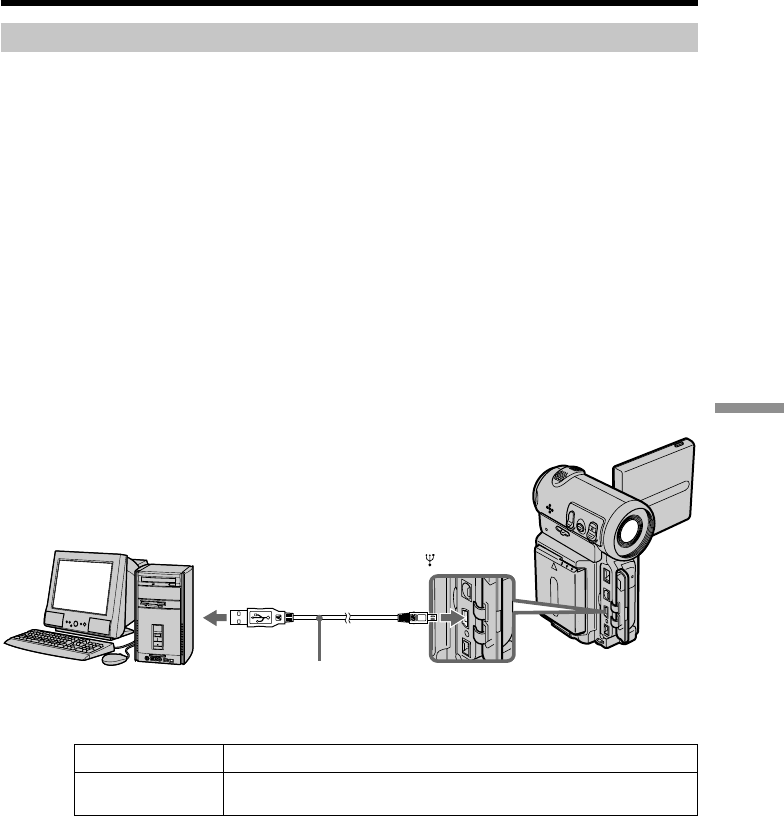
159
Connecting with a computer
Viewing images
For Windows users
(1)Turn on the power of your computer and allow Windows to load.
(2)Connect one end of the USB cable to the USB jack on the camcorder and the
other end to the USB connector on your computer.
(3)Insert a “Memory Stick” into your camcorder, and connect the AC power
adaptor to your camcorder and then to a wall outlet.
(4)Set the POWER switch to MEMORY.
USB MODE appears on the screen of the camcorder.
(5)Open “My Computer” on Windows and double click the newly recognized
drive. (Example: “Removable Disk (E:)”)
The folders inside the “Memory Stick” are displayed.
(6)Select and double-click the desired image file from the folder.
For the detailed folder and file name, see ”Image file storage destinations and
image files” (p. 152).
As for the stored files using the network function, refer to the network function
operating instructions (DCR-IP7/IP7BT only).
Desired file type Double-click in this order
Still image/ “Dcim” folder t“100msdcf” folder tImage file
Moving picture*
* Copying a file to the hard disk of your computer before viewing it is recommended. If
you play back the file directly from the “Memory Stick,” the image and sound may
break off.
USB connector
USB
Computer USB cable Push into the end
Viewing images recorded on a “Memory Stick” using your
computer

160
Unplug the USB cable/Eject the “Memory Stick”
For Windows 2000 Professional, Windows Me users
To unplug the USB cable or eject the “Memory Stick,” follow the procedure below.
(1)Move the cursor to the “Unplug or Eject Hardware” icon on the Task Tray and
click to cancel the applicable drive.
(2)A message to remove the device from the system appears, then unplug the
USB cable or eject the “Memory Stick.”
For Macintosh users
(1)Quit application programs opened.
Make sure that the access lamp of the hard disk is not lit.
(2)Drag and drop the “Memory Stick” icon to the Trash or select Eject under the
Special menu.
(3)Eject the “Memory Stick.”
Notes on using your computer
“Memory Stick”
•“Memory Stick” operations on your camcorder cannot be assured if a “Memory Stick”
formatted on your computer is used on your camcorder, or if the “Memory Stick” in
your camcorder was formatted from your computer when the USB cable was
connected.
•Do not optimize the “Memory Stick” on a Windows machine. This will shorten the
“Memory Stick” life.
•Do not compress the data on the “Memory Stick.” Compressed files cannot be played
back on your camcorder.
Software
•Depending on your application software, the file size may increase when you open a
still image file.
•When you load an image modified using a retouch software from your computer to
the camcorder or when you directly modify the image on the camcorder, the image
format will differ so a file error indicator may appear and you may be unable to open
the file.
Communications with your computer
Communications between your camcorder and your computer may not recover after
recovering from Suspend, Resume, or Sleep.
Viewing images recorded on a “Memory Stick” using your
computer
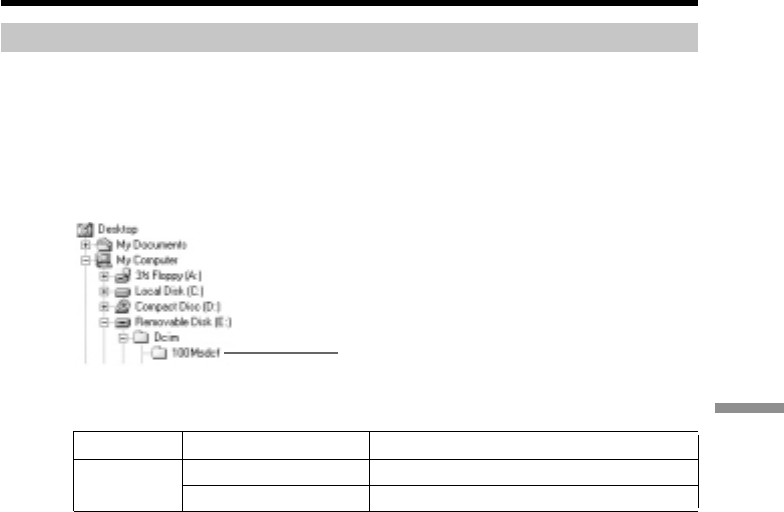
161
Connecting with a computer
Image file storage destinations and image files
Image files recorded with your camcorder are grouped in folders by recording mode.
The meanings of the file names are as follows. ssss stands for any number within
the range from 0001 to 9999.
For Windows Me users
(The drive recognizing the camera is [E:])
Folder File Meaning
100msdcf DSC0ssss.jpg Still image file
MOV1ssss.mpg Moving picture file
Folder containing still image and
moving picture data
Viewing images recorded on a “Memory Stick” using your
computer
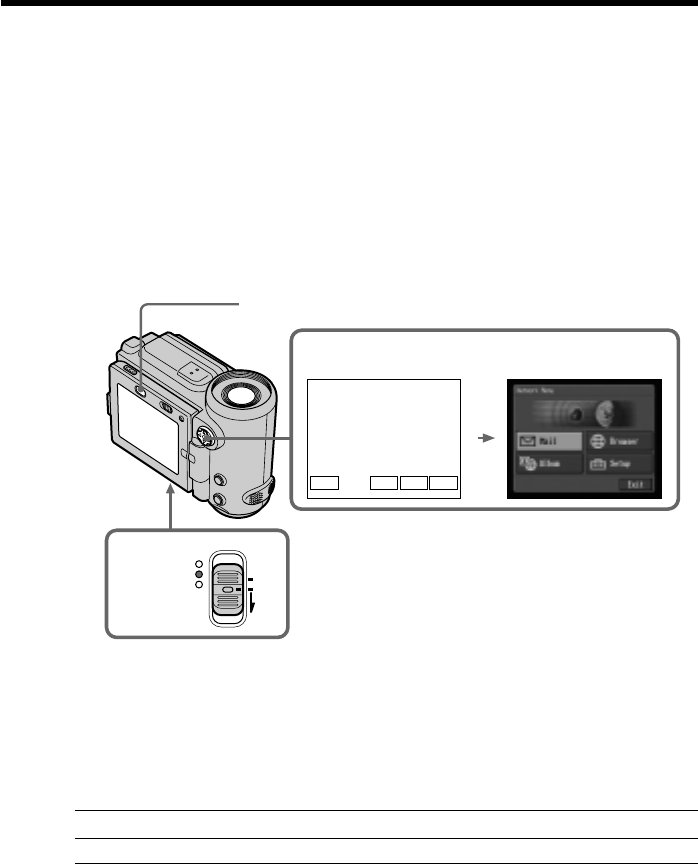
162
— Network operation —
Accessing to the network
1
2
FNINDEXPLAY
NETWORK
MEMORY/
NETWORK
VCR
CAMERA (CHG)
POWER
OFF
ON
MODE
– DCR-IP7/IP7BT only
You can access the Internet using a Bluetooth device that complies to the camcorder.
Once the access is made, you can make your album on the Web, view a Web page, or
send/receive your e-mail, etc. This section describes only how to open the Network
menu. For details on the network operations, refer to the network function operating
instructions supplied with the camcorder.
(1)Set the POWER switch to MEMORY.
(2)Select NETWORK, then press the center z on the control button. The Network
Menu appears and the Bluetooth lamp turns on.
When you send e-mail using the network function, you can attach an image recorded
on a “Memory Stick” to e-mail. Attachable file size is up to 3 MB per one e-mail
message. When attaching a moving image file, the available time of the attached image
depends on the image quality mode. For details, see the table below.
Image quality mode SUPER FINE FINE STANDARD LIGHTMODE
Available time/one e-mail 17 s 29 s 58 s 119 s
BROWSE
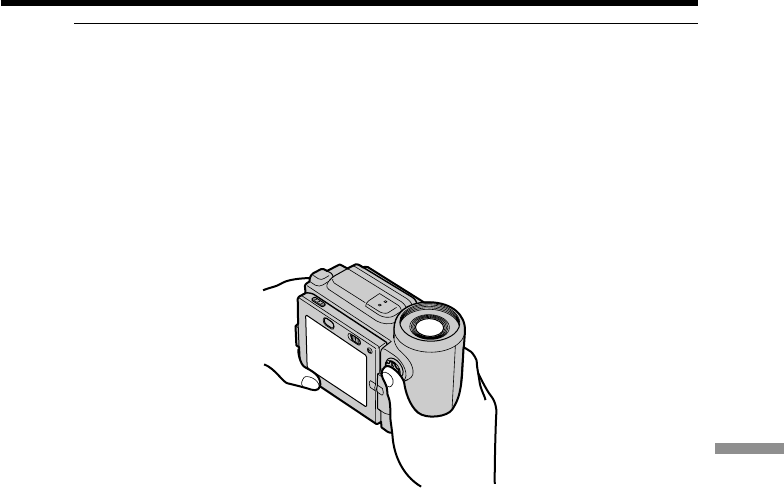
163
Network operation
Note on trademarks
•The BLUETOOTH trademarks are owned by their proprietor and used by Sony
Corporation under license.
•All other product names mentioned herein may be the trademarks or registered
trademarks of their respective companies. Furthermore, “™” and “®” are not
mentioned in each case in this manual.
When using the network function
Hold the camcorder with both hands as illustrated below.
Note
Be careful not to touch the V BATT lever while you are operating the camcorder. The
battery pack may be accidentally become detached from the camcorder.
Accessing to the network

164
If you run into any problem using your camcorder, use the following table to
troubleshoot the problem. If the problem persists, disconnect the power source and
contact your Sony dealer. If “C:ss:ss” appears on the screen, the self-diagnosis
display function has worked. See page 166.
In recording mode
Symptom Cause and/or Corrective Actions
•The POWER switch is not set to CAMERA.
cSet it to CAMERA (p. 22).
•The tape has run out.
cRewind the tape or insert a new one (p. 19, 38).
•The write-protect tab is set to expose the red mark.
cUse a new tape or slide the tab (p. 19).
•The tape is stuck to the drum (moisture condensation).
cRemove the cassette and leave your camcorder for at
least 1 hour to acclimatize (p. 175).
•While being operated in CAMERA mode, your camcorder
has been in standby mode for more than 5 minutes.
cSet the POWER switch to OFF (CHG) and turn on the
power (p. 22).
•The battery pack is dead or nearly dead.
cInstall a fully charged battery pack.
•The viewfinder is not extended to the end.
cPull out the viewfinder.
•The viewfinder lens is not adjusted.
cAdjust the viewfinder lens (p. 26).
•STEADYSHOT is set to OFF in the menu settings.
cSet it to ON (p. 105).
•The setting is the manual focus mode.
cSet to the auto focus mode. (p. 59)
•Shooting conditions are not suitable for autofocus.
cAdjust to focus manually (p. 59).
•The LCD panel is open.
cClose the LCD panel. (p. 24)
•The contrast between the subject and the background is
too high. This is not a malfunction.
•This is called the smear phenomenon. This is not a
malfunction.
•Slow shutter or low lux mode is activated. This is not a
malfunction.
•If 10 minutes elapse after you set the POWER switch to
CAMERA or DEMO MODE is set to ON in the menu
settings without a cassette inserted, your camcorder
automatically starts the demonstration.
cInsert a cassette. The demonstration stops. You can also
cancel DEMO MODE (p. 110).
— Troubleshooting —
Types of trouble and their solutions
START/STOP does not operate.
The power goes off.
The image on the viewfinder
screen is not clear.
The SteadyShot function does not
work.
The autofocusing function does
not work.
The picture does not appear in the
viewfinder.
A vertical band appears when you
shoot a subject such as lights or a
candle flame against a dark
background.
A vertical band appears when you
shoot a very bright subject.
Some tiny white spots appear on
the screen.
An unknown picture is displayed
on the screen.
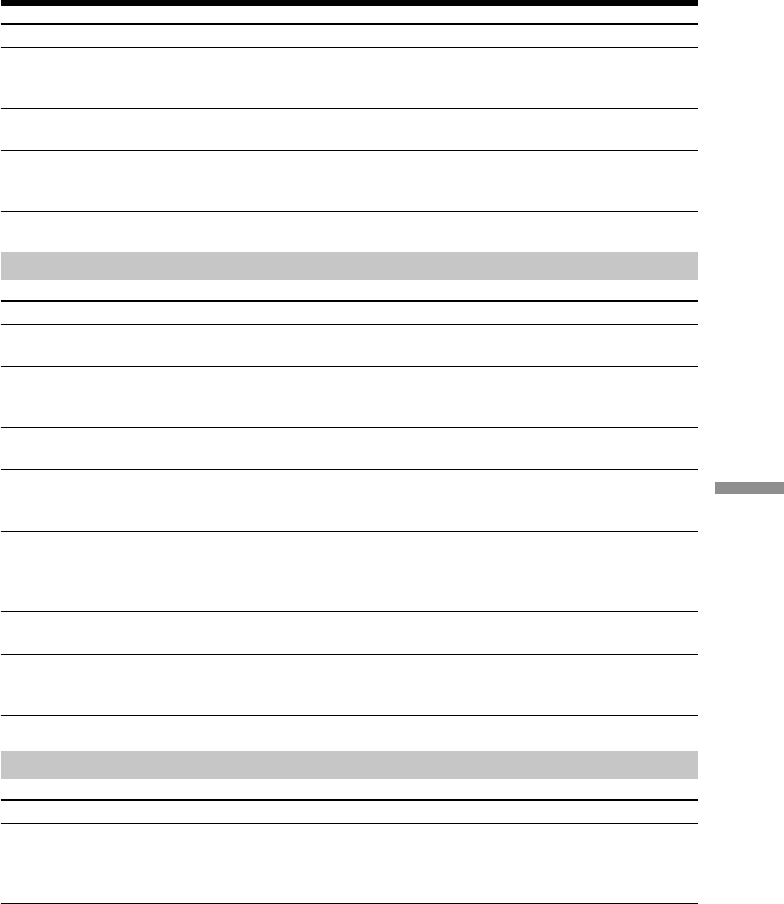
165
Troubleshooting
Types of trouble and their solutions
Symptom Cause and/or Corrective Actions
•The backlight function is active.
cSet it off (p. 29).
•BEEP is set to OFF in the menu settings.
cSet it to MELODY or NORMAL (p. 105).
•Set STEADYSHOT to OFF in the menu settings (p. 105).
In the playback mode
Symptom Cause and/or Corrective Actions
•The tape has run out.
cRewind the tape. (p. 38)
•The video head may be dirty.
cClean the heads using the cleaning cassette (p. 176).
•The volume is turned to minimum.
cTurn up the volume (p. 34).
•The tape has a blank portion in the recorded portion
(p. 169).
•TITLE DSPL is set to OFF in the menu settings.
cSet it to ON in the menu settings (p. 105).
•The screen indicators is displayed.
cTurn off the screen indicators (p. XX).
•The setup of VIDEOINPUT is wrong.
cSet it to the appropriate position (p. XX).
•When playing back a transition of recordings, the
playback picture freezes for about 1 second. This is not a
malfunction.
In the recording and playback modes
Symptom Cause and/or Corrective Actions
•The battery pack is not installed, or is dead or nearly dead.
cInstall a charged battery pack (p. 12, 13).
•The AC power adaptor is not connected to a wall outlet.
cConnect the AC power adaptor to a wall outlet (p. 16).
The picture appears too bright,
and the subject does not appear on
the screen.
The click of the shutter does not
sound.
A horizontal band appears when
shooting a TV screen or computer
screen.
Playback is not possible.
There are horizontal lines on the
picture or the playback picture is
not clear or does not appear.
No sound or only a low sound is
heard when playing back a tape.
The multi-picture search, title
search, date search, or photo
search function does not work.
The title is not displayed.
Dubbing cannot be made when
using the A/V connecting cable.
The playback picture freezes for
about 1 second.
The camcorder does not function
even if you slide the POWER
switch.
(continued on the following page)
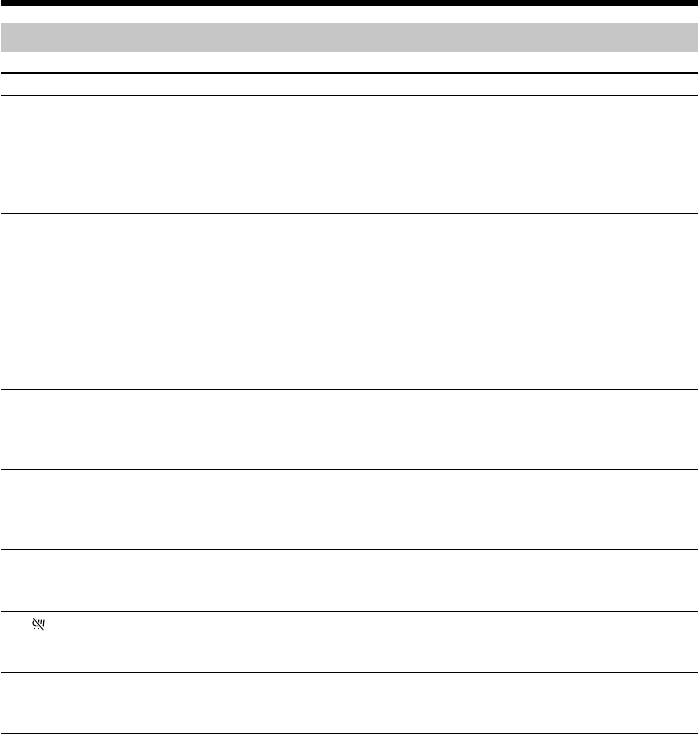
166
Types of trouble and their solutions
In the recording and playback modes
Symptom Cause and/or Corrective Actions
•The temperature of the environment is too low.
•The battery pack is not fully charged.
cCharge the battery pack fully again (p. 13).
•The battery pack is completely dead, and cannot be
recharged.
cReplace with a new battery pack (p. 12).
•You have used the battery pack in an extremely hot or
cold environment for a long time.
•The battery pack is completely dead, and cannot be
recharged.
cReplace with a new battery pack (p. 12).
•The battery is not fully charged.
cCharge the battery pack fully again (p. 13).
•A deviation has occurred in the remaining time.
cCharge the battery pack fully again (p. 13).
•A deviation has occurred in the remaining battery time.
cCharge the battery pack fully again so that the indication
on the battery remaining indicator is correct (p. 13).
•The power source is disconnected.
cConnect it firmly (p. 12, 16).
•The battery is not fully charged.
cUse a charged battery pack (p. 13).
•Moisture condensation has occurred.
cRemove the cassette and leave your camcorder for at
least 1 hour to acclimatize (p. 175).
•The camcorder cannot recognize the cassette memory of
the tape.
cInsert the cassette again (p. XXX).
•The q REMAIN is set to AUTO in the menu settings.
cSet it to ON to always display the remaining tape
indicator (p. 105).
The battery pack is quickly
discharged.
The battery remaining indicator
does not indicate the correct time.
The power goes off although the
battery remaining indicator
indicates that the battery pack has
enough power to operate.
The cassette cannot be removed
from the holder.
The % and Z indicators flash and
no functions except for cassette
ejection work.
The indicator is displayed.
The remaining tape indicator is not
displayed.

167
Troubleshooting
Types of trouble and their solutions
When operating using the “Memory Stick”
– DCR-IP7/IP7BT only
Symptom Cause and/or Corrective Actions
•The POWER switch is not set to MEMORY.
cSet it to MEMORY (p. 122).
•The “Memory Stick” is not inserted.
cInsert a “Memory Stick” (p. 114).
•The “Memory Stick” has already been recorded to its full
capacity.
cDelete unnecessary images and record again (p. 156).
•The “Memory Stick” formatted incorrectly is inserted.
cFormat the “Memory Stick” using your camcorder or
use another “Memory Stick” (p. 109).
•The write-protect switch on the “Memory Stick” is set to
LOCK.
cRelease the lock (p. 112).
•The image is protected.
cCancel image protection (p. 155).
•The write-protect switch on the “Memory Stick” is set to
LOCK.
cRelease the lock (p. 112).
•The write-protect switch on the “Memory Stick” is set to
LOCK.
cRelease the lock (p. 112).
•The write-protect switch on the “Memory Stick” is set to
LOCK.
cRelease the lock (p. 112).
•The write-protect switch on the “Memory Stick” is set to
LOCK.
cRelease the lock (p. 112).
•INDEX screen is not displayed.
cThe protect marks cannot be written to the single screen
(p. 155).
•The write-protect switch on the “Memory Stick” is set to
LOCK.
cRelease the lock (p. 112).
•The INDEX screen is not displayed.
cThe print marks cannot be written when the single
screen is displayed (p. 159).
•You are trying to write a print mark on a moving picture.
cPrint marks cannot be written to moving picture.
The “Memory Stick” does not
function.
Recording does not function.
The image cannot be deleted.
You cannot format the “Memory
Stick”.
Deleting all the images cannot be
carried out.
You cannot protect the image.
You cannot write a print mark on
the still image.
(continued on the following page)

168
Types of trouble and their solutions
When operating using the “Memory Stick”
– DCR-IP7/IP7BT only
Symptom Cause and/or Corrective Actions
•The write-protect switch on the “Memory Stick” is set to
LOCK.
cRelease the lock (p. 112).
•You may not be able to play back images in actual size
when you try to play back images recorded by other
equipment. This is not a malfunction.
•No audio was not recorded on the file.
Others
Symptom Cause and/or Corrective Actions
•The 20 numbers of the titles is already recorded.
cErase unnecessary titles (p. 100).
•The tape is set to prevent accidental erasure.
cSlide the write-protect tab so that red portion is not
visible (p. 19).
•COMMANDER is set to OFF in the menu settings.
cSet it to ON (p. 105).
•Something is blocking the infrared rays.
cRemove the obstacle.
•The batteries are inserted in the battery holder with the + –
polarities incorrectly matching the + – marks.
cInsert the batteries with the correct polarity (p. 188).
•The batteries are dead.
cInsert new ones (p. 188).
•DISPLAY is set to V-OUT/LCD in the menu settings.
cSet it to LCD (p. 105).
•The VIDEOINPUT setting in the menu settings is wrong.
cSet it to the appropriate position.
The title is not recorded.
The Remote Commander supplied
with your camcorder does not
work.
The picture from the TV or VCR
does not appear even when your
camcorder is connected to outputs
on the TV or VCR.
The photo save function does not
work.
You cannot play back images in
actual size.
No audio during playback.

169
Troubleshooting
Others
Symptom Cause and/or Corrective Actions
•Disconnect the AC power adaptor from a wall outlet or
remove the battery, then reconnect it in about 1 minute.
Turn the power on. If the functions still do not work, press
the reset button using a sharp-pointed object. (If you press
the reset button, all the settings (DCR-IP7/IP7BT: except
the NETWORK mode settings) including the date and
time return to the default) (p. 186).
•Charging is completed.
•The battery pack is not properly installed.
cInstall it properly (p. 12).
•The POWER switch is not set to OFF (CHG).
cSet it to OFF (CHG).
•The battery pack is not properly installed.
cInstall it properly (p. 12).
•Something is wrong with the battery pack.
cPlease contact your Sony dealer or local authorized Sony
service facility.
•Moisture condensation has occurred.
cRemove the cassette and leave your camcorder for at
least 1 hour to acclimatize (p. 175).
•Some troubles have occurred in your camcorder.
cRemove the cassette and insert it again, then operate
your camcorder.
•DISPLAY was pressed.
cPress the center z on the control button.
cPress DISPLAY on your camcorder or on the Remote
Commander (p. 36).
•The mirror mode is activated.
This is not a malfunction.
•The USB cable was connected before installation of the
USB driver was completed.
cUninstall the incorrect USB driver and re-install the USB
driver (p. 149).
•This is not a malfunction.
c–
•The camcorder cannot be connected with a DV product.
Types of trouble and their solutions
No function works though the
power is on.
While charging the battery pack,
the CHG lamp does not light up.
You cannot charge the battery
pack.
While charging the battery pack,
the CHG lamp flashes.
The melody or beep sounds for 5
seconds.
The buttons do not appear on the
screen.
The indicators appear mirror-
reversed in the viewfinder or on
the TV screen.
Image data cannot be transferred
by the USB connection.
Your camcorder gets warm.
Any image is not displayed on the
screen when connecting with other
equipment using the i.LINK cable.
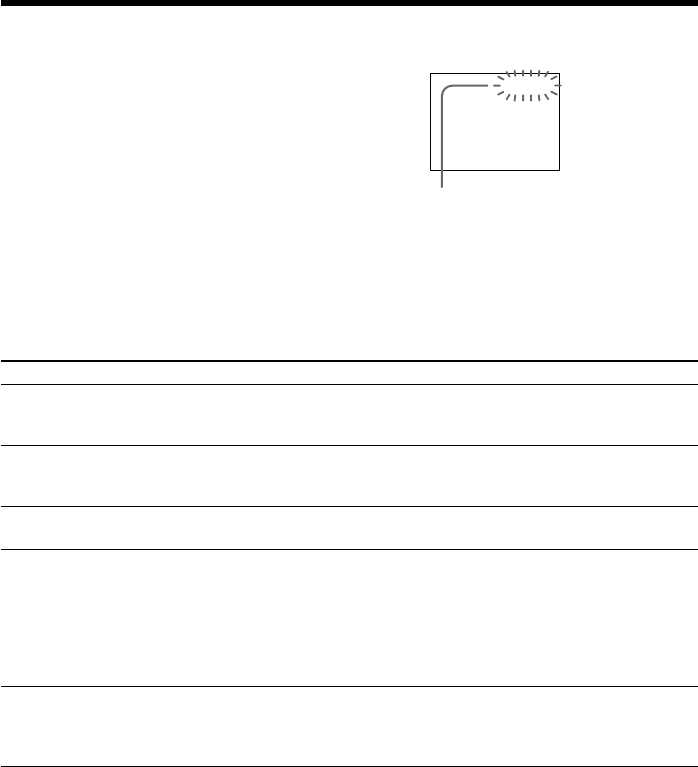
170
C:21:00
LCD screen or Viewfinder
Self-diagnosis display
•C:ss:ss
You can service your camcorder
yourself.
•E:ss:ss
Contact your Sony dealer or local
authorized Sony facility.
Self-diagnosis display
Your camcorder has a self-diagnosis
display function.
This function displays the current
condition of your camcorder as a 5-digit
code (a combination of a letter and
figures) on the screen. If a 5-digit code is
displayed, check the following code
chart. The last 2 digits (indicated by
ss) will differ depending on the state
of your camcorder.
Five-digit display Cause and/or Corrective Actions
•You are using a battery pack that is not an
“InfoLITHIUM” battery pack.
cUse an “InfoLITHIUM” battery pack.
•Moisture condensation has occurred.
cRemove the cassette and leave your camcorder for at
least 1 hour to acclimatize (p. 175).
•The video heads are dirty.
cClean the heads using the cleaning cassette (p. 176).
•A malfunction other than the above that you can service
has occurred.
cRemove the cassette and insert it again, then operate
your camcorder.
cDisconnect the power cord of the AC adaptor or remove
the battery pack. After reconnecting the power source,
operate your camcorder.
•A malfunction that you cannot service has occurred.
cContact your Sony dealer or local authorized Sony
service facility and inform them of the 5-digit code.
(example: E:61:10)
C:04:ss
C:21:ss
C:22:ss
C:31:ss
C:32:ss
E:61:ss
If you are unable to rectify the problem even if you try corrective actions a few times,
contact your Sony dealer or local authorized Sony service facility.

171
Troubleshooting
Warning indicators and messages
If indicators and messages appear on the screen, check the following:
See the page in parentheses “()” for more information.
Warning indicators
100-0001 Warning indicator as to file (DCR-
IP7/IP7BT only)
Slow flashing:
•The file is corrupted.
•The file is unreadable.
•You are trying to carry out the MEMORY
MIX function on a moving picture.
C:21:00 Self-diagnosis display (p. 166).
EThe battery is dead or nearly dead
Slow flashing:
•The battery is nearly dead.
Depending on the operating conditions,
environment and battery condition, the E
indicator may flash, even if there are
approximately 5 to 10 minutes remaining.
Fast flashing:
•The battery is dead (p. 13).
%Moisture condensation has occurred*
Fast flashing:
•Eject the cassette, turn off your camcorder,
and leave it for about 1 hour with the cassette
compartment open (p. 175).
Warning indicator as to “Memory Stick”
(DCR-IP7/IP7BT only)*
Slow flashing:
•No “Memory Stick” is inserted.
Fast flashing:
•The “Memory Stick” is not readable with
your camcorder (p. 112).
•The image cannot be recorded on “Memory
Stick” (p. 128, 134).
Warning indicator as to “Memory Stick”
formatting (DCR-IP7/IP7BT only)*
Fast flashing:
•The “Memory Stick” data is corrupted.
•The “Memory Stick” is not formatted
correctly (p. 109).
QWarning indicator as to tape
Slow flashing:
•The tape is near the end.
•No tape is inserted.*
•The write-protect tab on the cassette is out
(red) (p. 19).*
Fast flashing:
•The tape has run out.*
ZYou need to eject the cassette*
Slow flashing:
•The write-protect tab on the cassette is out
(red) (p. 19).
Fast flashing:
•Moisture condensation has occurred (p. 175).
•The tape has run out.
•The self-diagnosis display function is
activated (p. 166).
-The image is protected (DCR-IP7/IP7BT
only)*
Slow flashing:
•The image is protected (p. 155).
Warning indicator as to cassette
memory*
Slow flashing:
•Eject the cassette, and insert it again. Even
then the indicator flashes, the MICRO
cassette memory of the cassette may be
broken.
Fast flashing:
•The MICRO cassette memory of the
camcorder may be broken.
* You hear the melody or beep sound.
C:21:00100–0001

172
Warning indicators and messages
Warning messages
•CLOCK SET Set the date and time (p. 17).
•FOR “InfoLITHIUM”Use an “InfoLITHIUM” battery pack (p. 15).
BATTERY ONLY1)
• CLEANING CASSETTE1) The video heads are dirty (p. 176).
•COPY INHIBIT You tried to record a picture that has a copyright control signal
(p. 169).1)
• FULL The tape cassette memory is full (p. 99).2)
• FULL The “Memory Stick” is full (p. 124).2) 3)
• NO FILE No image is recorded on the “Memory Stick” (p. 142).2) 3)
• NO MEMORY STICK No “Memory Stick” is inserted.2) 3)
• AUDIO ERROR You are trying to record an image with sound that cannot be
recorded by your camcorder on “Memory Stick” (p. 107). 2) 3)
• MEMORY STICK ERROR The “Memory Stick” data is corrupted (p. 114).2) 3)
• FORMAT ERROR The “Memory Stick” is not recognized (p. 109).2) 3)
Check the format.
• - DIRECTORY ERROR There is more than two same directories (p. 142).2) 3)
•Q Z TAPE END The tape has reached the end of the tape.2)
•Q NO TAPE Insert a cassette tape.2)
•DELETING You press the PHOTO button on your camcorder while
deleting data in a “Memory Stick”.2) 3)
•FORMATTING You press the PHOTO button on your camcorder while
formatting a “Memory Stick”.2) 3)
•@ @ CLEANING END XXX
• TITLE FULL XXX
•INPUT ERROR XXX
•@ NOT REC XXX
•XXX
•CHANGE TO “CAM” or “VCR”XXX
1) The x indicator and “ CLEANING CASSETTE“ message appear one after another
on the screen.
2) You hear the melody or beep sound.
3) DCR-IP7/IP7BT only
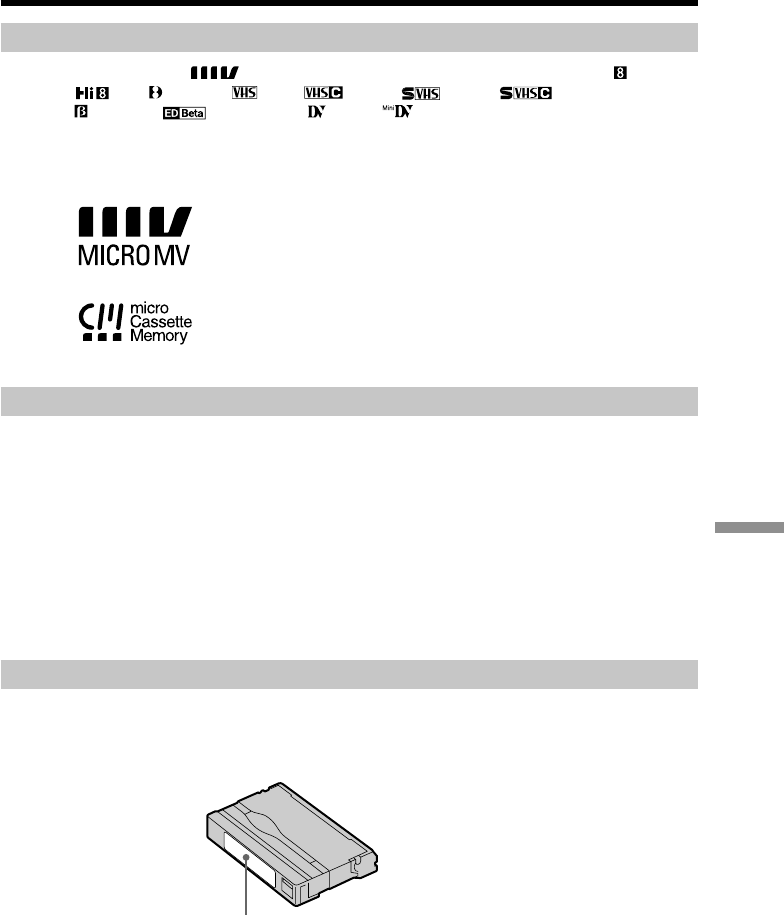
173
Additional Information
— Additional Information —
Usable cassettes
Selecting cassette types
You can use the MICROMV cassette only. You cannot use any other 8 mm,
Hi8, Digital8, VHS, VHSC, S-VHS, S-VHSC,
Betamax, ED Betamax, DV, or mini DV cassette.
All of the MICROMV cassettes has cassette memory.
This is the MICROMV mark.
This is the MICRO Cassette Memory mark.
These are trademarks.
Copyright signal
When you play back
Using any other video camera recorder, you cannot record on a tape that has recorded
copyright control signals for copyright protection of software which is played back on
your camcorder.
When you record
You cannot record software on your camcorder that contains copyright control signals
for copyright protection of software.
COPY INHIBIT appears on the LCD screen, in the viewfinder or on the TV screen if you
try to record such software. Your camcorder does not record copyright control signals
on the tape when it records.
Notes on the MICROMV cassette
When affixing a label on the MICROMV cassette
Be sure to affix a label only on the location as illustrated below [a] so as not to cause
malfunction of your camcorder.
After using the MICROMV cassette
Rewind the tape to the beginning, put the cassette in its case, and store it in an upright
position.
When the cassette memory function does not work
Reinsert a cassette.
[a]

174
About the “InfoLITHIUM” battery pack
What is the “InfoLITHIUM” battery pack?
The “InfoLITHIUM” battery pack is a lithium-ion battery pack that has functions for
communicating information related to operating conditions between your camcorder
and an optional AC adaptor/charger.
The “InfoLITHIUM” battery pack calculates the power consumption according to the
operating conditions of your camcorder, and displays the remaining battery time in
minutes.
Charging the battery pack
•Be sure to charge the battery pack before you start using your camcorder.
•We recommend charging the battery pack in an ambient temperature of between 10°C
to 30°C (50°F to 86°F) until the CHG lamp goes off, indicating that the battery pack is
fully charged. If you charge the battery outside of this temperature range, you may
not be able to efficiently charge the battery pack.
•After charging is completed, either disconnect the cable from the DC IN jack on your
camcorder or remove the battery pack.
Effective use of the battery pack
•Battery pack performance decreases in low-temperature surroundings. So, the time
that the battery pack can be used is shorter in cold place. We recommend the
following to use the battery pack longer:
–Put the battery pack in a pocket to warm it up, and insert it in your camcorder
immediately before you start taking shots.
–Use the large capacity battery pack (NP-FF70, optional).
•Frequently using the LCD screen or frequently operating playback, fast forward or
rewind wears out the battery pack faster. We recommend using the large capacity
battery pack (NP-FF70, optional).
•Be certain to slide the POWER switch to OFF (CHG) when not taking shots or playing
back on your camcorder. The battery pack is also consumed when your camcorder is
in standby or playback paused mode.
•Have spare battery packs handy for two or three times the expected recording time,
and make a trial recordings before taking the actual recording.
• Do not expose the battery pack to water. The battery pack is not water resistant.
Remaining battery time indicator
•If the power may go off although the remaining battery time indicator indicates that
the battery pack has enough power to operate, charge the battery pack fully again so
that the indication on the remaining battery time indicator is correct. Note, however,
that the correct battery indication sometimes will not be restored if it is used in high
temperatures for a long time or left in a fully charged state, or the battery pack is
frequently used. Regard the remaining battery time indication as the approximate
shooting time.
•The E mark indicating there is little remaining battery time sometimes flashes
depending on the operating conditions or ambient temperature and environment even
if the remaining battery time is about 5 to 10 minutes.

175
Additional Information
How to store the battery pack
•Even if the battery pack is not used for a long time, remove the battery pack from the
camcorder, store it in a dry, cool place after fully charging it once per year and then
using the battery pack up on your camcorder. This is to maintain the battery pack’s
functions.
•To use the battery pack up on your camcorder, turn on your camcorder and leave it as
it is without a cassette inserted.
Battery life
•The battery life is limited. Battery capacity drops little by little as you use it more and
more, and as time passes. When the available battery time is shortened considerably, a
probable cause is that the battery pack has reached the end of its life. Please buy a new
battery pack.
•The battery life varies according to how it is stored and operating conditions and
environment for each battery pack.
About the “InfoLITHIUM” battery pack

176
About i.LINK
The i.LINK (MICROMV) jack on this unit is an i.LINK-compliant MPEG2 jack. This
section describes the i.LINK standard and its features.
What is i.LINK?
i.LINK is a digital serial interface for handling digital video, digital audio and other
data in two directions between equipment having the i.LINK jack, and for controlling
other equipment.
i.LINK-compatible equipment can be connected by a single i.LINK cable. Possible
applications are operations and data transactions with various digital AV equipment.
When two or more i.LINK-compatible equipment are connected to this unit in a daisy
chain, operations and data transactions are possible with not only the equipment that
this unit is connected to but also with other devices via the directly connected
equipment.
Note, however, that the method of operation sometimes varies according to the
characteristics and specifications of the equipment to be connected, and that operations
and data transactions are sometimes not possible on some connected equipment.
Note
Normally, only one piece of equipment can be connected to this unit by the i.LINK
cable. When connecting this unit to MPEG2-compatible equipment having two or more
i.LINK jacks, refer to the instruction manual of the equipment to be connected.
About the Name “i.LINK”
i.LINK is a more familiar term for IEEE 1394 data transport bus proposed by SONY,
and is a trademark approved by many corporations.
IEEE 1394 is an international standard standardized by the Institute of Electrical and
Electronics Engineers.
i.LINK Baud rate
The maximum baud rate of the camcorder is “S400.”
i.LINK’s maximum baud rate varies according to the equipment. Three maximum baud
rates are defined:
S100 (approx. 100 Mbps*)
S200 (approx. 200 Mbps)
S400 (approx. 400 Mbps)
The baud rate is listed under “Specifications” in the instruction manual of each
equipment. It is also indicated near the i.LINK jack on some equipment.
The maximum baud rate of equipment except for this unit on which it is not indicated is
“S100.”
When units are connected to equipment having a different maximum baud rate, the
baud rate sometimes differs from the indicated baud rate.
*What is Mbps?
Mbps stands for megabits per second, or the amount of data that can be sent or received
in one second. For example, a baud rate of 100 Mbps means that 100 megabits of data
can be sent in one second.

177
Additional Information
About i.LINK
i.LINK functions on this unit
For details on how to dub when this unit is connected to other video equipment having
i.LINK (MICROMV) jacks, see page 76.
This unit can also be connected to other i.LINK compatible equipment made by SONY
(e.g. VAIO series personal computer) other than video equipment.
Before connecting this unit to your computer, make sure that application software
supported by this unit is already installed on your computer.
For details on precautions when connecting this unit, also refer to the instruction
manuals for the equipment to be connected.
Required i.LINK Cable
Use the Sony i.LINK 4-pin-to-4-pin cable (during MPEG2 dubbing).
i.LINK and are trademarks.
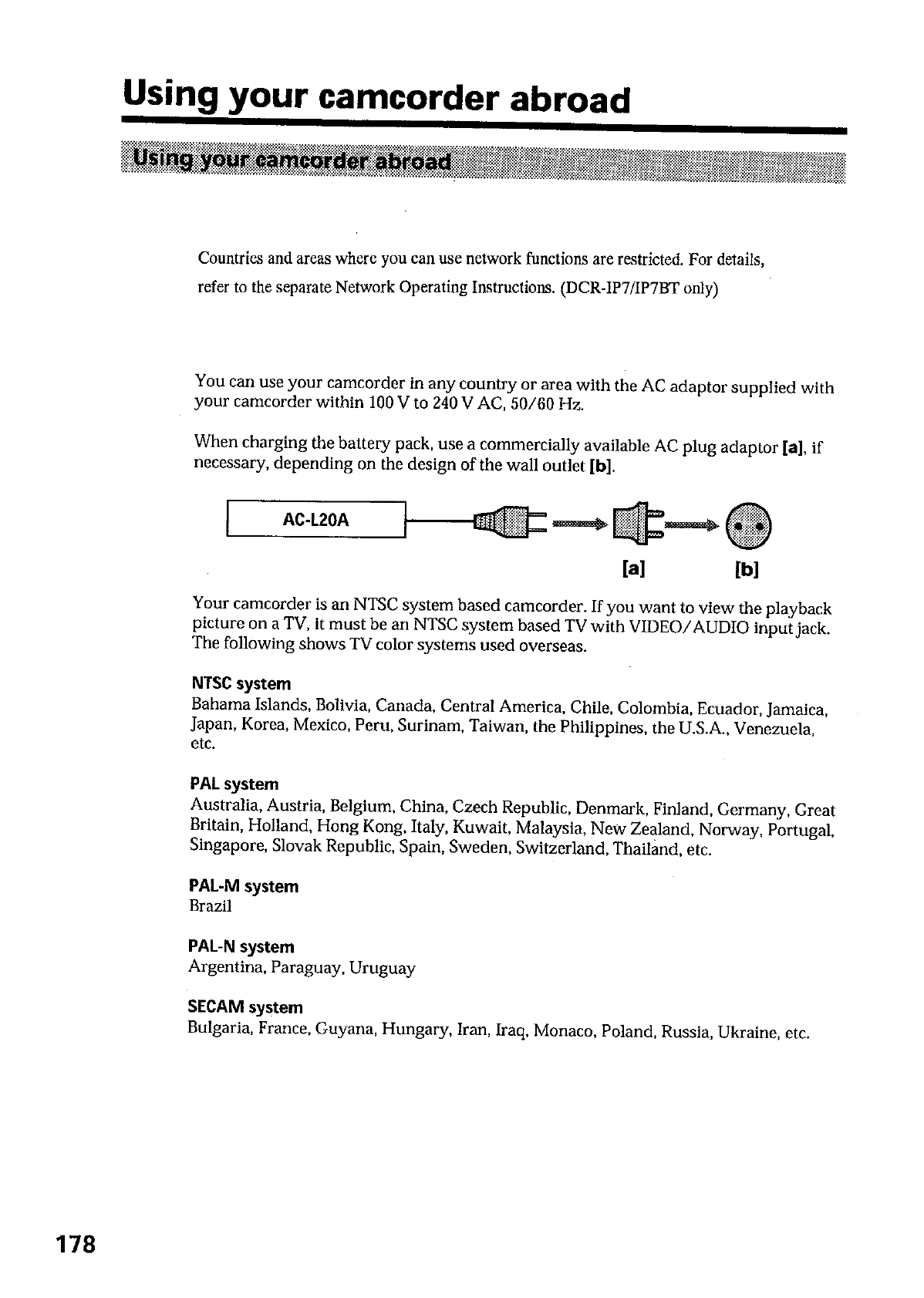
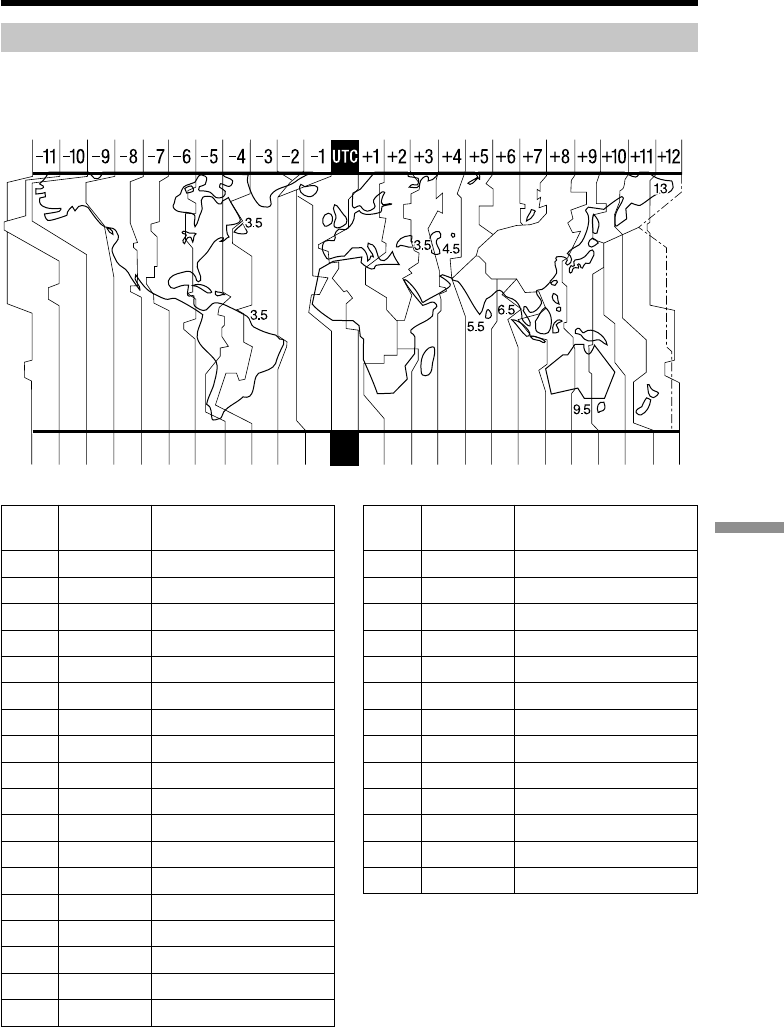
179
Additional Information
Simple setting of clock by time difference
You can easily set the clock to the local time by setting a time difference. Set up the
AREA and DLS items in the menu settings.
Using your camcorder abroad
19 20 21 22 23 24 25 26 27 29 30 31 12346810121314161718
Area Time-zone Area setting
code differences
1 GMT Lisbon, London
2 GMT+01:00 Berlin, Paris
3 GMT+02:00 Helsinki, Cairo
4 GMT+03:00 Moscow, Nairobi
5 GMT+03:30 Tehran
6 GMT+04:00 Abu Dhabi, Baku
7 GMT+04:30 Kabul
8 GMT+05:00 Karachi, Islamabad
9 GMT+05:30 Calcutta, New Delhi
10 GMT+06:00 Almaty, Dhaka
11 GMT+06:30 Rangoon
12 GMT+07:00 Bangkok, Jakarta
13 GMT+08:00 Hong Kong, Singapore
14 GMT+09:00 Seoul, Tokyo
15 GMT+09:30 Adelaide, Darwin
16 GMT+10:00 Melbourne, Sydney
17 GMT+11:00 ? New Caledon
18 GMT+12:00 Fiji, Wellington
Area Time-zone Area setting
code differences
19 GMT–12:00 Eniwetok, Kwajalein
20 GMT–11:00 Midway Is., Samoa
21 GMT–10:00 Hawaii
22 GMT–09:00 Alaska
23 GMT–08:00 Los Angels, Tijuana
24 GMT–07:00 Denver, Arizona
25 GMT–06:00 Chicago, Mexico City
26 GMT–05:00 New York, Bogota
27 GMT–04:00 Santiago
28 GMT–03:30 St. John’s
29 GMT–03:00 Brasilia, Montevideo
30 GMT-02:00 Fernando de Noronha
31 GMT–01:00 Azores, Cape Verde I
To set your local time
Select AREA from the menu, then press the
center z or B on the control button. Next,
select the country or area where you stay in,
following the table above, then press the center
z on the control button.

180
Maintenance information and
precautions
Moisture condensation
If your camcorder is brought directly from a cold place to a warm place, moisture may
condense inside your camcorder, on the surface of the tape, or on the lens. In this
condition, the tape may stick to the head drum and be damaged or your camcorder may
not operate correctly. If there is moisture inside your camcorder, the beep sounds and
the % indicator flashes. When the Z indicator flashes at the same time, the cassette is
inserted in your camcorder. If moisture condenses on the lens, the indicator will not
appear.
If moisture condensation occurred
None of the functions except cassette ejection will work. Eject the cassette, turn off your
camcorder, and leave it for about 1 hour with the cassette compartment open. Your
camcorder can be used again if the % indicator does not appear when the power is
turned on again.
Note on moisture condensation
Moisture may condense when you bring your camcorder from a cold place into a warm
place (or vice versa) or when you use your camcorder in a hot place as follows:
–You bring your camcorder from a ski slope into a place warmed up by a heating
device
–You bring your camcorder from an air-conditioned car or room into a hot place
outside
–You use your camcorder after a squall or a shower
–You use your camcorder in a high temperature and humidity place
How to prevent moisture condensation
When you bring your camcorder from a cold place into a warm place, put your
camcorder in a plastic bag and tightly seal it. Remove the bag when the air temperature
inside the plastic bag has reached the surrounding temperature (after about 1 hour).
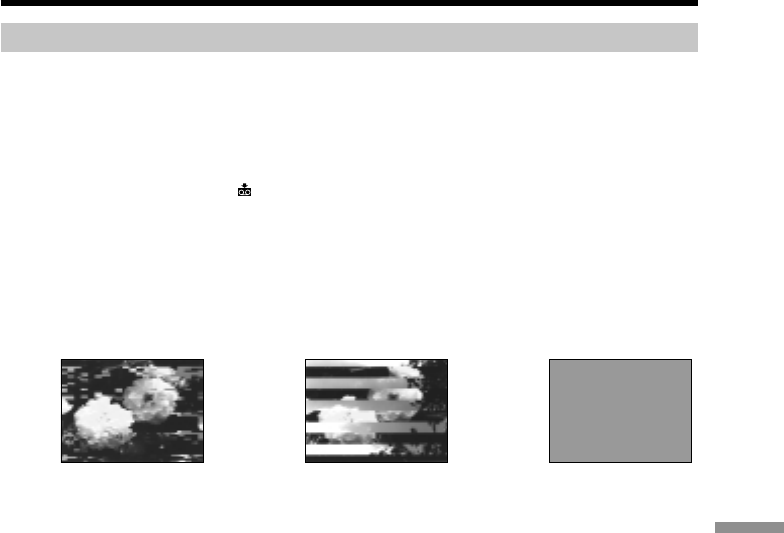
181
Additional Information
[a] [b] [c]
Maintenance information and precautions
Maintenance information
Cleaning the video head
To ensure normal recording and clear pictures, clean the video head. The video head
may be dirty when:
–mosaic-pattern noise appears on the playback picture.
–playback pictures do not move.
–playback pictures do not appear.
–the x indicator and “ CLEANING CASSETTE” message appear one after another or
the x indicator flashes on the screen during recording.
If the above problem, [a], [b] or [c] occurs, clean the video heads with the Sony
MGRCLD cleaning cassette. Check the picture and if the above problem persists, repeat
cleaning.
If the video heads gets dirtier, the entire screen becomes blue [c].
Playing back a cleaning cassette automatically
The camcorder is equipped with the cleaning cassette auto playback function. Follow
the procedure below.
(1)Set the POWER switch to CAMERA or VCR.
(2)Insert the cleaning cassette.
(3)Select XXX, then press the center z on the control button. The message “XXX”
appears.
After the cleaning is finished, the message “XXX” appears.
(4)Eject the cleaning cassette.
To cancel cleaning
Select CANCEL, then press the center z on the control button.
The video head
The video head wears out if you use the camcorder for a long time. When use of the
cleaning cassette does not make the picture clear, the video head may wear out. In such
cases, you must replace the video head. For details, consult your nearest Sony dealer.
Notes
•When cleaning the video head, do not use any equipment other than the cleaning
cassette.
•The cleaning cassette does not work in MEMORY mode (DCR-IP7/IP7BT only).
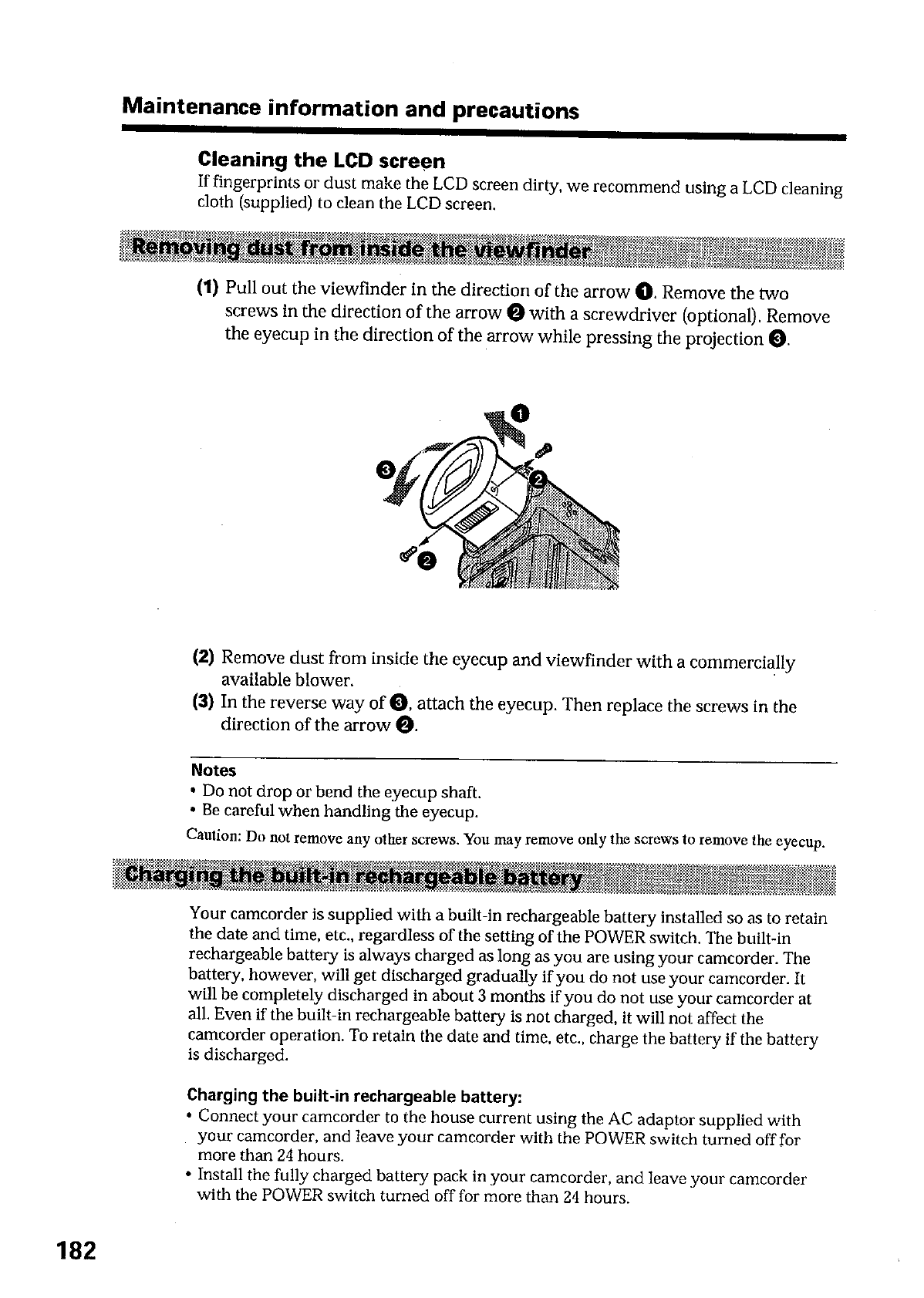

183
Additional Information
Maintenance information and precautions
Precautions
Camcorder operation
•Operate your camcorder on 7.2 V (battery pack) or 8.4 V (AC power adaptor).
•For DC or AC operation, use the accessories recommended in this operating
instructions.
•If any solid object or liquid get inside the casing, unplug your camcorder and have it
checked by a Sony dealer before operating it any further.
•Avoid rough handling or mechanical shock. Be particularly careful of the lens.
•Keep the POWER switch set to OFF (CHG) when you are not using your camcorder.
•Do not wrap your camcorder with a towel, for example, and operate it. Doing so
might cause heat to build up inside.
•Keep your camcorder away from strong magnetic fields or mechanical vibration.
•Do not touch the LCD screen with a sharp-pointed object.
•Do not strongly press the LCD screen.
•If your camcorder is used in a cold place, a residual image may appear on the LCD
screen. This is not a malfunction.
•While using your camcorder, the back of the LCD screen may heat up. This is not a
malfunction.
•Do not use the network function in a medical institution or in an aircraft (DCR-IP7/
IP7BT only).
On handling tapes
•Do not insert anything into the small holes on the rear of the cassette. These holes are
used to sense the type and thickness of the tape and if the recording tab is in or out.
•Do not open the tape protect cover or touch the tape.
•Avoid touching or damaging the terminals. To remove dust, clean the terminals with
a soft cloth.
Camcorder care
•Remove the tape, and periodically turn on the power, operate the CAMERA and VCR
sections and play back a tape for about 3 minutes when your camcorder is not to be
used for a long time.
•Clean the lens with a soft brush to remove dust. If there are fingerprints on the lens,
remove them with a soft cloth.
•Clean the camcorder body with a dry soft cloth, or a soft cloth lightly moistened with
a mild detergent solution. Do not use any type of solvent which may damage the
finish.
•Do not let sand get into your camcorder. When you use your camcorder on a sandy
beach or in a dusty place, protect it from the sand or dust. Sand or dust may cause
your camcorder to malfunction, and sometimes this malfunction cannot be repaired.

184
Maintenance information and precautions
AC power adaptor
•Unplug the unit from a wall outlet when you are not using the unit for a long time. To
disconnect the power cord, pull it out by the plug. Never pull the power cord itself.
•Do not operate the unit with a damaged cord or if the unit has been dropped or
damaged.
•Do not bend the power cord forcibly, or place a heavy object on it. This will damage
the cord and may cause fire or electrical shock.
•Prevent metallic objects from coming into contact with the metal parts of the
connecting section. If this happens, a short may occur and the unit may be damaged.
•Always keep metal contacts clean.
•Do not disassemble the unit.
•Do not apply mechanical shock or drop the unit.
•While the unit is in use, particularly during charging, keep it away from AM receivers
and video equipment. AM receivers and video equipment disturb AM reception and
video operation.
•The unit becomes warm during use. This is not a malfunction.
•Do not place the unit in locations that are:
– Extremely hot or cold
– Dusty or dirty
– Very humid
– Vibrating
About care and storage of the lens
•Wipe the surface of the lens clean with a soft cloth in the following instance:
– When there are fingerprints on the lens surface
– In hot or humid locations
– When the lens is used in environments such as the seaside
•Store the lens in a well-ventilated location subject to little dirt or dust.
To prevent mold from occurring, periodically perform the above.
We recommend turning on and operating the video camera recorder about once per
month to keep the video camera recorder in an optimum state for a long time.

185
Additional Information
Maintenance information and precautions
Battery pack
•Use only the specified charger or video equipment with the charging function.
•To prevent accident from a short circuit, do not allow metal objects to come into
contact with the battery terminals.
•Keep the battery pack away from fire.
•Never expose the battery pack to temperatures above 60°C (140°F), such as in a car
parked in the sun or under direct sunlight.
•Store the battery pack in a cool, dry place.
•Do not expose the battery pack to any mechanical shock.
•Do not disassemble nor modify the battery pack.
•Attach the battery pack to the video equipment securely.
•Charging while some capacity remains does not affect the original battery capacity.
Notes on dry batteries
To avoid possible damage from battery leakage or corrosion, observe the following:
•Be sure to insert the batteries with the + – polarities matched to the + – marks.
•Dry batteries are not rechargeable.
•Do not use a combination of new and old batteries.
•Do not use different types of batteries.
•Current flows from batteries when you are not using them for a long time.
•Do not use leaking batteries.
If batteries are leaking
•Wipe off the liquid in the battery compartment carefully before replacing the batteries.
•If you touch the liquid, wash it off with water.
•If the liquid get into your eyes, wash your eyes with a lot of water and then consult a
doctor.
If any problem occurs, unplug your camcorder and contact your nearest Sony dealer.

186
Specifications
Video camera
recorder
System
Video recording system
2 rotary heads
Helical scanning system
Audio recording system
Rotary heads, PCM system
Quantization: 12 bits
(Fs 48 kHz, stereo)
Video signal
NTSC color, EIA standards
Usable cassette
MICROMV cassette with the
mark printed
Tape speed
Approx. 5.66 mm/s
Recording/playback time
1 hour
Fastforward/rewind time
(using cassette MGR60)
Approx. 1 min and 30 s
Viewfinder
Electric viewfinder (color)
Image device
3.0 mm (1/6 type) CCD
(Charge Coupled Device)
Approx. 680 000 pixels
(Effective: 340 000 pixels)
Lens
Carl Zeiss
Combined power zoom lens
Filter diameter 30 mm. (1 3/16 in.)
10× (Optical), 120× (Digital)
Focal length
2.3 - 23 mm (3/32 - 29/32 in.)
When converted to a 35 mm still
camera 44 - 440 mm (1 3/4 -
17 3/8 in.)
Color temperature
Auto, HOLD (Hold), nIndoor
(3 200K), Outdoor (5 800K)
Minimum illumination
15 lx (lux) (F 1.7)
Input/Output connectors
Audio/Video input/output
10-pin connector
Input/output auto switch
Video signal: 1 Vp-p, 75 Ω (ohms),
unbalanced, sync negative
Luminance signal: 1 Vp-p, 75 Ω
(ohms), unbalanced
Chrominance signal: 0.286 Vp-p,
75 Ω (ohms), unbalanced
Audio signal: 327 mV, (at output
impedance more than 47 kΩ
(kilohms) )
Input impedance with more than
47 kΩ (kilohms)
Output impedance with less than
2.2 kΩ (kilohms)
USB jack
mini-B
i.LINK (MICROMV) input/output
4-pin connector S400
LCD screen
Picture
6.2 cm (2.5 type)
50 × 37 mm (2 × 1 1/2 in.)
Total dot number:
211 200 (960 × 220)
Wireless communication
Communication system
Bluetooth specification Ver. 1.1
Maximum communication
speed 1) 2)
Approx. 723 kbps
Maximum output
Bluetooth specification Power
Class2
Communication distance 2)
Approx. 10 m (32.8 feet) (Open
space, when using a Sony BTA-
NW1 Modem Adaptor with
Bluetooth Function)
Compatible Bluetooth profiles 3)
Generic Access Profile
Dial-up Networking Profile
Usable frequency band
2.4 GHz band
(2.400 – 2.4835 GHz)
1)The maximum rate defined by
Bluetooth specification Ver. 1.1
2)Depends on obstacles between
the Bluetooth devices, radio
wave conditions, etc.
3)Defined by Bluetooth
specification for intended use
between the Bluetooth devices
General
Power requirements
7.2 V (battery pack)
8.4 V (AC power adaptor)
Average power consumption
(when using the battery pack)
During camera recording using
viewfinder (brightness normal)
3.5 W
During camera recording using
LCD (Backlighting on) 4.2 W
During camera recording using
LCD (Backlighting off) 3.5 W
Operating temperature
0°C to 40°C (32°F to 104°F)
Storage temperature
–20°C to +60°C (–4°F to +140°F)
Dimensions (approx.)
47× 103 × 80 mm
(1 7/8 × 4 1/8 × 3 1/4 in.) (w/h/
d) (excluding protruding parts)
Mass (approx.)
310 g (11 oz)
Main unit only
370 g (13 oz)
including the battery pack,
NP-FF50, cassette MGR60, lens
cap, and list strap
Supplied accessories
See page 5.
AC power adaptor
AC-L20A
Power requirements
100 - 240 V AC, 50/60 Hz
Power consumption
XX W
Output voltage
DC OUT: 8.4 V, 1.5 A in the
operating mode
Battery charge terminal:
4.2 V, 1.5 A in charge mode
Operating temperature
0°C to 40°C (32°F to 104°F)
Storage temperature
–20°C to +60°C (–4°F to +140°F)
Dimensions (approx.)
XXX × XX × XX mm (X × X X/XX
×X X/X in.) (w/h/d) excluding
(projecting parts) power cord
Mass (approx.)
XXX g (X.X oz)
excluding the power cord

187
Additional Information
Specifications
Battery pack
NP-FF50
Maximum output voltage
DC 8.4 V
Output voltage
DC 7.2 V
Capacity
X.X Wh (XXX mAh)
Operating temperature
0°C to 40°C (32°F to 104°F)
Dimensions (approx.)
XX.X × XX.X × XX.X mm
(X X/XX × XX/XX × X X/X in.)
(w/h/d)
Mass (approx.)
XX g (X.X oz)
Type
Lithium ion
“Memory Stick”
(DCR-IP7/IP7BT
only)
Memory
Flash memory
4MB: MSA-4A
Operating voltage
2.7-3.6V
Power consumption
Approx. 45mA in the operating
mode
Approx. 130µA in the standby
mode
Dimensions (approx.)
50 × 2.8 × 21.5 mm
(2 × 1/8 × 7/8 in.) (w/h/d)
Mass (approx.)
4 g (0.14 oz)
Design and specifications are
subject to change without notice.
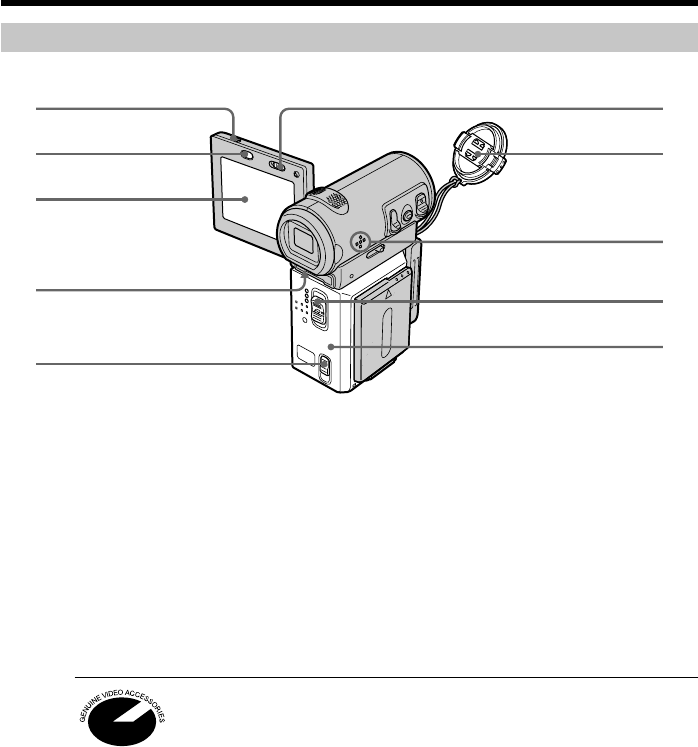
188
— Quick Reference —
Identifying the parts and controls
Camcorder
1OPEN button (p. 22)
2BROWSER MENU button (p. XX)
(DCR-IP7/IP7BT only)
3LCD screen (p. 20, 115)
4Viewfinder lens adjustment lever
(p. 26)
5OPEN/ZEJECT lever (p. 19)
6LCD BACKLIGHT switch (p. XX)
7Lens cap (p. 22)
8Speaker
9POWER switch (p. 22)
0Cassette lid (p. 19)
This mark indicates that this product is a genuine accessory for Sony
video products.
When purchasing Sony video products, Sony recommends that you
purchase accessories with this “GENUINE VIDEO ACCESSORIES”
mark.
1
2
3
4
5
6
7
8
9
0
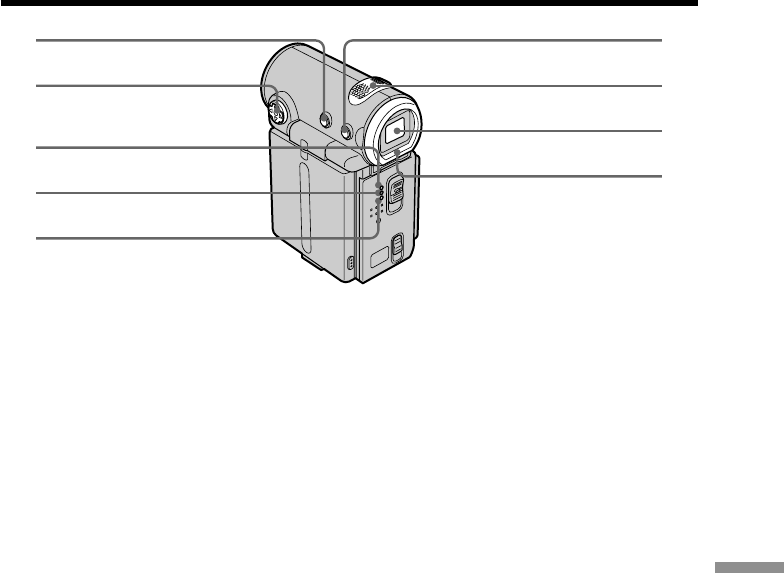
189
Quick Reference
Identifying the parts and controls
qa DISPLAY button (p. 36)
qs Control button (v/V/b/B/z) (p. XX)
qd CAMERA lamp
qf MEMORY/NETWORK lamp (p. XX)
(DCR-IP7/IP7BT only)
qg VCR lamp (p. XX)
qh BACK LIGHT button (p. 29)
qj Built-in Microphone (p. 22)
qk Viewfinder (p. 26)
ql Eyecup (p. 26)
qa
qs
qd
qf
qg
qh
qj
qk
ql
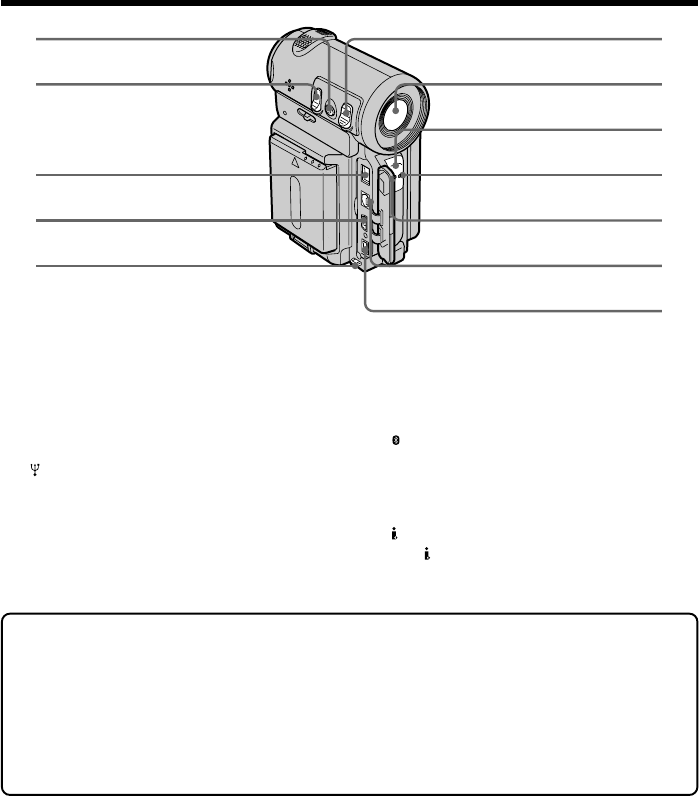
190
Identifying the parts and controls
w; ZOOM button (p. 27)
wa PHOTO button (p. 41, 122)
ws DC IN jack (p. 16)
wd USB jack (p. 148)
wf Hook for hand strap
wg START/STOP button (p. 22)
wh Lens
wj Camera recording lamp (p. 22)
wk (Bluetooth) lamp (p. 22)
wl Remote sensor
e; A/V (ID-2) jack
ea i.LINK (MICROMV) jack (p. 76)
The i.LINK (MICROMV) jack is i.LINK
compatible.
Note on the Carl Zeiss lens
Your camcorder is equipped with a Carl Zeiss lens which can reproduce a fine image.
The lens for your camcorder was developed jointly by Carl Zeiss, in Germany, and Sony
Corporation. It adopts the MTF* measurement system for video camera and offers a quality as
the Carl Zeiss lens.
* MTF is an abbreviation of Modulation Transfer Function.
The value number indicates the amount of light of a subject penetrating into the lens.
w;
wa
ws
wd
wf
wg
wh
wj
wk
wl
e;
ea
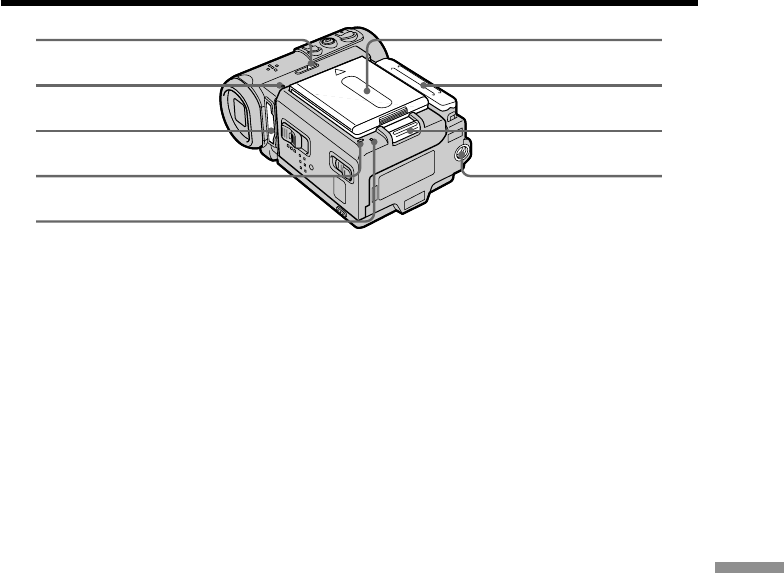
191
Quick Reference
Identifying the parts and controls
es MEMORY EJECT lever (p. 114)
(DCR-IP7/IP7BT only)
ed Access lamp (p. 114)
ef “Memory Stick” slot (p. 114)
(DCR-IP7/IP7BT only)
eg CHG lamp (p. 13)
eh Reset button (p. 165)
ej Battery/Battery terminal cover (p. 12)
ek Jack cover
el VBATT (battery) release lever (p. 12)
r; Tripod receptacle
Make sure that the length of the tripod
screw is less than 5.5 mm (7/32 inch).
Otherwise, you cannot attach the tripod
securely and the screw may damage
your camcorder.
es
ed
ef
eg
eh
ej
ek
el
r;
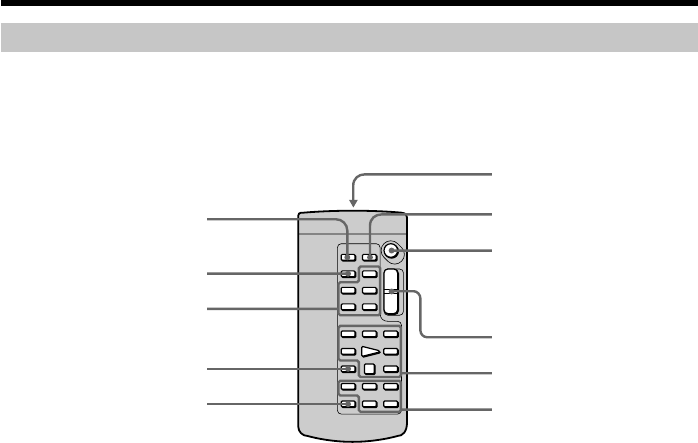
192
Identifying the parts and controls
Remote Commander
The buttons that have the same name on the Remote Commander as on your camcorder
function identically to the buttons on your camcorder.
1PHOTO button (p. 41, 122)
2DISPLAY button (p. 36)
3MEMORY control buttons (p. XX)
(DCR-IP7/IP7BT only)
4SEARCH MODE button (p. 69 to 74)
5MULTI SRCH button (p. XX)
6Transmitter
Point toward the remote sensor to
control your camcorder after turning on
your camcorder.
7DATA CODE button (p. 36)
8START/STOP button (p. 22)
9Power zoom button (p. 27)
0Video control buttons (p. 38)
qa X/x/C/c/DECISION buttons (p. XX)
These buttons function the same as the
control button on the camcorder.
1
2
3
4
5
6
7
8
9
0
qa
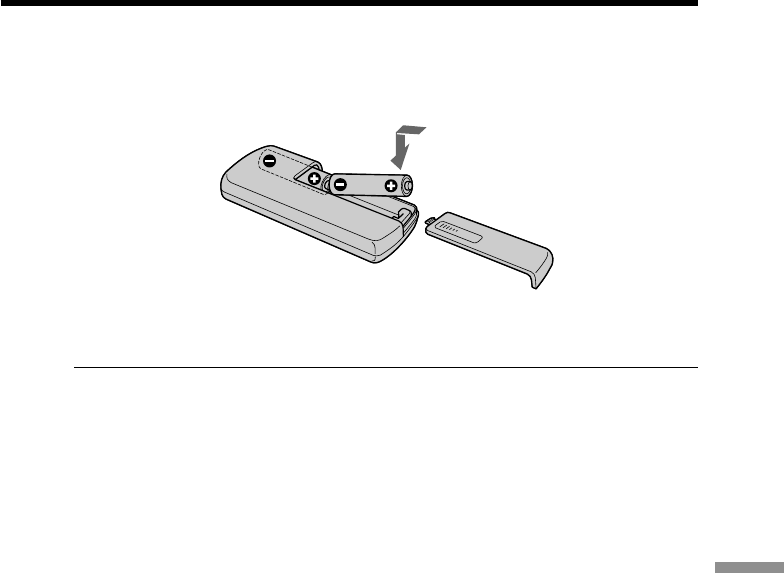
193
Quick Reference
To prepare the Remote Commander
Insert two size AA (R6) batteries by matching the + and – polarities on the batteries to
the + – marks inside the battery compartment.
Notes on the Remote Commander
•Point the remote sensor away from strong light sources such as direct sunlight or
overhead lighting. Otherwise, the Remote Commander may not function properly.
•Your camcorder works in the commander mode VTR 2. Commander modes 1, 2 and 3
are used to distinguish your camcorder from other Sony VCRs to avoid remote control
misoperation. If you use another Sony VCR in the Commander mode VTR 2, we
recommend changing the commander mode or covering the sensor of the VCR with
black paper.
Identifying the parts and controls
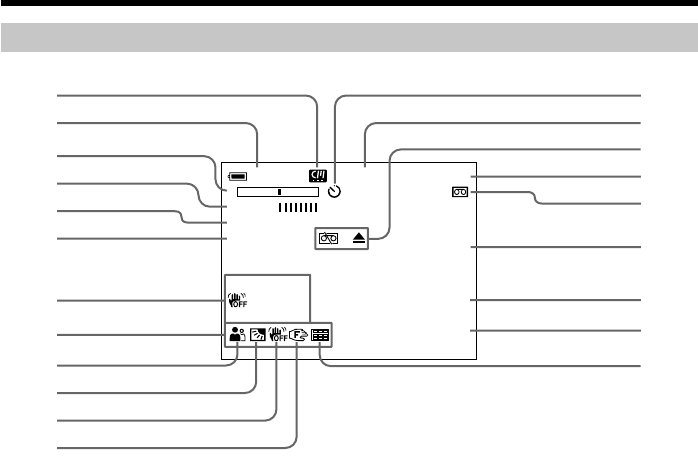
194
Identifying the parts and controls
LCD screen and viewfinder
Operation indicators
1MICRO cassette memory indicator
(p. 169)
2Remaining battery time indicator
(p. 28)
3Zoom indicator (p. 27)/Data file name
indicator (p. 112) (DCR-IP7/IP7BT
only)
4Digital effect indicator (p. 49)/
MEMORY MIX indicator (p. 135) (DCR-
IP7/IP7BT only)/FADER indicator (p.
45) (DCR-IP7/IP7BT only)
516:9WIDE indicator (p. 44)
6Picture effect indicator (p. 48)
7Data code indicator (p. 36)
8Date indicator
9PROGRAM AE indicator (p. 52)
0Backlight indicator (p. 29)
qa SteadyShot off indicator (p. 106)
qs Manual focus/Infinity indicator (p. 59)
qd Self-timer indicator (p. 31, 125)
qf STBY/REC indicator (p. 22)/Video
control mode indicator (p. 38)/Picture
size indicator (p. 119) (DCR-IP7/IP7BT
only)/Image quality mode indicator (p.
117) (DCR-IP7/IP7BT only)
qg Warning indicators (p. 167)
qh Tape counter indicator (p. 68)/Self-
diagnosis indicator (p. 166)/Photo
mode indicator (p. 41, 122)/Image
number indicator (p. 122) (DCR-IP7/
IP7BT only)
qj Remaining tape indicator (p. 28)/
Memory playback indicator (p. 142)
qk END SEARCH indicator (p. 32)
ql MPEG IN indicator (p. 90)
w; Data file name indicator (p. 135) (DCR-
IP7/IP7BT only)
This indicator appears when the
MEMORY MIX functions work. /Time
indicator
wa Multi screen mode indicator (p. 124)
120min STBY 0:12:34
–+12min
ST I LL
16:9WIDE
NEG . ART END
SEARCH
AUTO
6 0 AWB MPEG I N
F11 9db 100–0001
6
5
4
3
2
1
9
0
qa
qs
qj
qh
qg
ql
w;
qk
7
8
wa
qd
qf

195
Quick Reference
Index
A, B
AC power adaptor.................. 13
Adjusting viewfinder ............. 26
Audio dubbing........................ 94
AUDIO MIX .......................... 107
Audio mode........................... 110
AUTO SHTR.......................... 106
A/V connecting cable ...... 40, 75
BACK LIGHT .......................... 29
Battery pack ............................. 12
BEEP ....................................... 111
BOUNCE.................................. 45
C, D
CALIBRATION..................... 177
Camera chromakey .............. 135
Carl Zeiss lens ....................... 185
Cassette memory ............ 10, 169
Charging battery..................... 13
Charging manganese-lithium
battery ................................. 177
Clock set ................................... 17
Cut recording .......................... 62
Data code ................................. 36
Date search .............................. 70
DEMO MODE ....................... 110
DIGITAL EFFECT ............ 49, 66
Digital program editing......... 77
DISPLAY.................................. 36
DOT .......................................... 45
Dual sound track tape.......... 170
Dubbing a tape........................ 75
DV connecting cable............... 76
E
EDIT SEARCH ........................ 32
END SEARCH......................... 32
Exposure .................................. 57
F, G, H
Fade in/out.............................. 45
FLASH MOTION.................... 49
Flexible Spot Meter................. 58
FOCUS...................................... 59
Format .................................... 109
FRAME REC............................ 62
Full charge ............................... 13
Grip strap............................... 186
Heads...................................... 176
Headphone jack .................... 186
HiFi SOUND ......................... 107
Holding Grip ................... 22, 184
I, J, K, L
i.LINK ..................................... 172
Image protection ................... 155
Image quality mode ............. 117
Index screen........................... 144
“InfoLITHIUM” battery ...... 171
Infrared rays emitter .............. 29
Interval recording ................... 60
JPEG........................................ 112
Labelling a cassette............... 103
(LANC).................................. 184
LUMINANCEKEY ................. 49
M, N
Main sound............................ 170
Manual focus ........................... 59
Memory chromakey ............. 135
Memory luminancekey........ 135
MEMORY MIX...................... 135
Memory overlap ................... 135
“Memory Stick” .................... 112
Menu settings ........................ 105
Mirror mode ............................ 24
Moisture condensation ........ 175
MONOTONE .......................... 45
MOSC.FADER......................... 45
MPEG ..................................... 112
Multi screen mode ................ 124
NIGHTSHOT .......................... 29
NORM. FADER ...................... 45
NTSC system ......................... 174
O, P, Q
OLD MOVIE............................ 49
Operation indicators ............ 189
OVERLAP ................................ 45
PB ZOOM ........................ 67, 153
Photo save.............................. 140
Photo scan................................ 74
Photo search ............................ 72
PICTURE EFFECT ............ 48, 65
Picture search .......................... 38
Playback pause........................ 38
Power zoom............................. 27
Print mark .............................. 159
PROGRAM AE....................... 52
R
Recording time........................ 14
Rec Review .............................. 33
Remaining battery time
indicator ................................ 28
Remaining tape indicator ...... 28
Remote commander ............. 188
Remote sensor ....................... 185
RESET ..................................... 165
S
Self-diagnosis display .......... 166
Self-timer recording ....... 31, 125
Signal convert function.......... 88
Skip scan .................................. 38
Slide show.............................. 154
Slow playback ......................... 38
SLOW SHUTTER.................... 49
STEADYSHOT ...................... 106
Stereo tape ............................. 170
STILL ........................................ 49
Sub sound .............................. 170
SUPER NIGHTSHOT............. 29
S VIDEO jack ............... 40, 75, 89
T, U, V
Tape counter............................ 28
Tape Photo recording............. 41
Telephoto ................................. 27
Time code................................. 28
Title ................................... 98, 101
Title search............................... 69
TRAIL ....................................... 49
Transition................................. 23
TV color systems................... 174
USB ......................................... 148
W, X, Y, Z
Warning indicators............... 167
White balance .......................... 55
Wide-angle .............................. 27
Wide mode .............................. 44
WIPE......................................... 45
WORLD TIME....................... 111
Write-protect tab............. 19, 112
Zero set memory..................... 68
Zoom ........................................ 27

Sony Corporation Printed in Japan
306993311